India’s statistical system is robust, adhering to the International Monetary Fund’s Special Data Dissemination Standards. The Ministry of Statistics and Programme Implementation (MoSPI) plays a vital role in preparing national accounts, including GDP estimates, and compiles the Index of Industrial Production (IIP) and Consumer Price Index (CPI). It has also introduced several improvements to its website, including data visualizations and user feedback mechanisms. The ministry is actively engaged in monitoring Sustainable Development Goals and is collaborating with various organizations, including the UN, to improve data quality and statistical methodologies. Key initiatives include revisions to the base year for CPI, establishing a Data Innovation Lab, and promoting the use of official languages.
SOURCE PDF LINK :
Click to access Annual_Report_2024-25_R.pdf
Click to view full document content
Annual Report
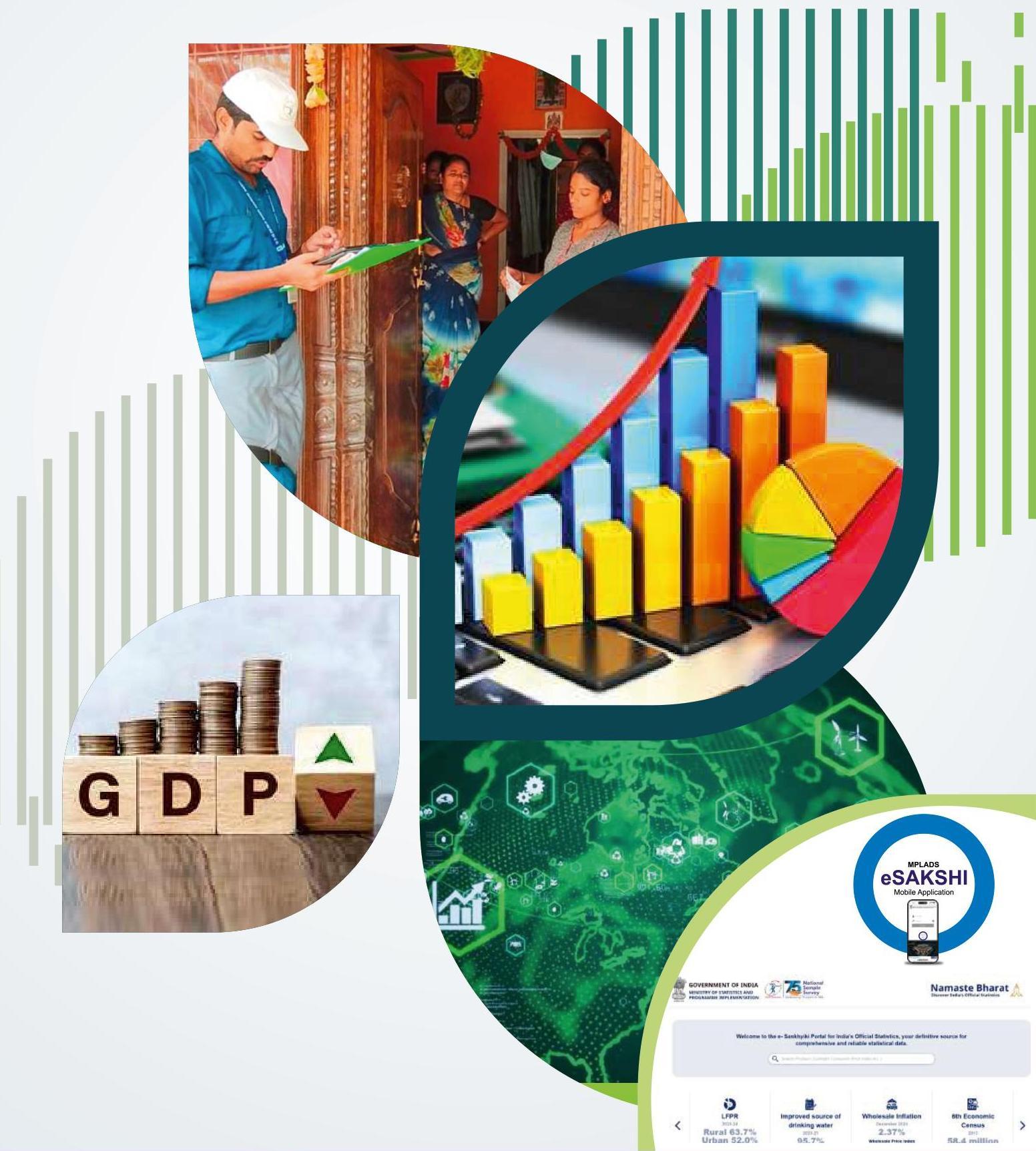
ANNUAL REPORT 2024-25
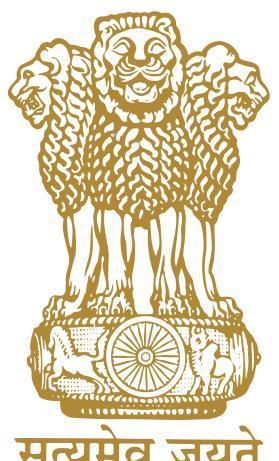
Government of India
Ministry of Statistics and Programme Implementation Khurshid Lal Bhawan, Janpath,
New Delhi-110001
https://www.mospi.gov.in
TABLE OF CONTENTS
| Sl. No. |
CHAPTERS | Page No. |
|---|---|---|
| 1 | Introduction | $1-7$ |
| 2 | National Statistics Office | $8-34$ |
| 3 | National Sample Survey (NSS) | $35-51$ |
| 4 | Training and Capacity Building | $52-61$ |
| 5 | Data Informatics \& Innovation | $62-71$ |
| 6 | Administrative Statistics | $72-73$ |
| 7 | India in United Nations | $74-75$ |
| 8 | Research and Analysis | $76-77$ |
| 9 | Support for Statistical Strengthening | $78-80$ |
| 10 | Media and Publicity | $81-82$ |
| 11 | Members of Parliament Local Area Development Scheme (MPLADS) | $83-89$ |
| 12 | Infrastructure and Project Monitoring | $90-93$ |
| 13 | National Statistical Commission (NSC) | $94-96$ |
| 14 | Indian Statistical Institute | $97-107$ |
| 15 | Statistical Services | $108-110$ |
| 16 | Progressive Use of Official Language (Rajbhasha) | $111-112$ |
| 17 | Other Activities | $113-121$ |
| ANNEXURES | ||
| I | Allocation of Business to the Ministry of Statistics \& Programme Implementation | $122-123$ |
| IIA | Organisation Chart of Ministry of Statistics \& Programme Implementation | 124 |
| IIB | Organisation Chart of National Statistical Commission | 125 |
| IIC | Abbreviations used | $126-127$ |
| III A | Statement of Budget Estimate (SBE) – Annual Plan 2024-25 | 128 |
| III B | Total Plan Gross Budgetary Support (GBS) for 2023-24 (BE and RE) for | 129 |
| North-Eastern Region | ||
| III C | Total Plan Gross Budgetary Support (GBS) for 2024-25 (BE and RE) for North- | 130 |
| Eastern Region | ||
| IV | List of publications being brought out by various Divisions of Ministry | $131-134$ |
| V | Position of Action Taken Note (ATN) For the Year 2021-22 | 135 |
| VI(A) | Representation of SCs, STs And OBCs and number of Appointments made during | 136 |
| the Calendar Year 2023 | ||
| VI(B) | Representation of Persons with Disabilities in Services | 137 |
Chapter 1
Introduction
1.1 The Ministry of Statistics and Programme Implementation (MoSPI) came into existence as an independent Ministry on 15th October, 1999 after the merger of the Department of Statistics and the Department of Programme Implementation. The Ministry is the nodal agency for planning integrated development of the statistical system in the country and coordination of statistical activities among different stakeholders in Government of India, State Governments, Union Territories as well as meeting requirements of the International Agencies. The Allocation of Business to the Ministry of Statistics and Programme Implementation is placed at Annexure I.
1.2 The Ministry has two wings viz. the Statistics Wing and the Programme Implementation (PI) Wing. There is one Autonomous Body known as the Indian Statistical Institute (ISI), which is an institute of national importance by an Act of Parliament, viz. The Indian Statistical Institute Act 1959, which is a renowned and premier institute in the field of Statistics in the country. In addition, there is a National Statistical Commission (NSC), which was created through a Resolution of Government of India with effect from 12th July, 2006 with a mandate to evolve policies, priorities and standards in statistical matters. The organisation chart of the Ministry is at Annexure IIA and IIB.
1.3 MoSPI, being the nodal Ministry of the Government of India for all statistical matters, attaches considerable importance to coverage and quality aspects of statistics released in the country. The statistics released by the Ministry are based on administrative sources, surveys and censuses conducted by the Central and State Governments, etc. The surveys conducted by the Ministry are based on scientific sampling methods. Data is collected through dedicated field staff who are regularly trained in the concepts and definitions of the items and the scope of the survey. In line with the emphasis on the quality of statistics released by the Ministry, the methodological issues of the statistical products of this Ministry are overseen by various committees viz, Advisory Committee on National Accounts, Technical Advisory Committee on Statistics of Price and Cost of Living (TAC on SPCL), Steering Committee for National Sample Surveys (NSS), etc. The Ministry compiles data-sets based on current data, after applying standard statistical techniques and extensive scrutiny and supervision.
1.4 The Statistics Wing, called National Statistics Office (NSO) coordinates the statistical activities in the country and is responsible for evolving and laying down statistical standards. India is a subscriber to the International Monetary Fund’s (IMF) Special Data Dissemination Standards (SDDS) and is currently fulfilling the Standards. The Ministry maintains an ‘Advance Release Calendar’ for all the products including its data categories covered under the SDDS, which is disseminated on the Ministry’s website as well as on the Dissemination Standards Bulletin Board (DSBB) of the IMF. The Ministry releases the datasets covered under the Real Sector of SDDS through press notes and its website simultaneously. India has a strong system of official statistics and is among the leading countries in the area of official statistics. The Ministry’s officials have been associated with international agencies on the development of methodologies, particularly in the areas of national accounts, informal sector statistics, large-scale sample surveys, conduct of censuses, service sector statistics, non-observed economy, social sector statistics, environmental statistics and classifications, statistical compilations and international practices. The contribution of the Ministry’s officials in international meetings on these subjects has been highly appreciated.
1.5 The NSO, MoSPI is responsible for preparation of national accounts, which include the estimates of Gross Domestic Product (GDP), National Income, Government/Private Final Consumption Expenditure, Capital Formation and Saving along with details of transactions of institutional sectors. The Ministry annually brings out a publication titled “National Accounts Statistics”, containing these statistics. The Ministry releases annual and quarterly estimates of Gross Domestic Product (GDP) from time to time as per pre-specified schedule given in Advance Release Calendar. As per the First Advance Estimates of GDP for FY 2024-25 released on 7th January, 2025, the growth in real Gross Domestic Product (GDP) during 202425 is estimated at 6.4 per cent as compared to the growth rate of 8.2 per cent in 2023-24. Real Gross Value Added (GVA) at Basic Prices is estimated at ₹ 168.91 lakh crore in 2024-25, as against ₹ 158.74 lakh crore in 2023-24, showing the growth of 6.4 per cent.
1.6 The Consumer Price Index (CPI) is designed to measure the changes over time in general level of retail prices of selected goods and services that household purchase for the purpose of consumption. CPI numbers are widely used as macroeconomic indicator of inflation, and also as a tool by government and Reserve Bank of India (RBI) for targeting inflation and monitoring price stability. CPI is also used as deflator in the National Accounts. The Reserve Bank of India (RBI) uses CPI, released by MoSPI, as measure of inflation for its bimonthly monetary policy announcement. The NSO, MoSPI released Consumer Price Index (CPI) on Base 2012=100 for All India Rural, Urban and Combined for the month of December, 2024 (Provisional) which were 198.4, 192.0 and 195.4, showing an annual inflation rate of $5.76 \%, 4.58 \%$ and $5.22 \%$ respectively. All-India Consumer Food Price Index (CFPI) for the month of December, 2024 (Provisional) for Rural, Urban and Combined were 204.7, 210.3 and 206.7 respectively. All India year-on-year inflation rates for CFPI for the month of December, 2024 (Provisional) for Rural, Urban and Combined sector were $8.65 \%, 7.90 \%$ and $8.39 \%$ respectively.
1.7 The Ministry previously released data on Inflation and CPI on the 12th of each month at 5:30 PM (or on the next working day, in case of 12 th being a holiday). The time lag in release of this data is only 12 days. From November 2024 onwards, the CPI data has now scheduled to be released at 4:00 PM instead of 5:30 PM. The objective of the change in time is mainly to provide more time for analysis to data users on the same day. It is aligned with the closing hours of major financial markets in India, ensuring that CPI release does not interfere with the active trading. This adjustment also adheres to MoSPI’s commitment to transparency and accessibility in data dissemination. The release contains State-wise comprehensive inflation figures for the usage of various stakeholders.
1.8 International Comparison Programme (ICP) is the largest statistical initiative in the world under the aegis of United Nations Statistics Division (UNSD). The World Bank is implementing this programme at global level and Asian Development Bank is the nodal implementing agency at Asia and the Pacific Region. The main objectives of ICP are to produce Purchasing Power Parities (PPPs) and Price Level Indices and to convert volume and per capita measures of GDP into common currencies using PPPs. India has been participating in ICP since 1970 and MoSPI is the nodal implementing agency to represent India in this programme. The NSO, MoSPI is responsible for providing data to ADB for inter-country validations and compilation of PPP etc. The data for ICP is collected from different sources including Field Operations Division (FOD) of MoSPI, Administrative Data, Surveys and Other Sources available with various ministries. The ICP 2024 cycle has been started in India. The Field Operation Division (FOD) of the Ministry is collecting price data under the four schedules of ICP. A virtual workshop in this regard was also conducted on 4th November, 2024, to share instructions and schedules with field officials across the country.
1.9 The Index of Industrial Production (IIP) with base year 2011-12 is compiled and published by the NSO, MoSPI on 12th of every month (or the previous working day if 12th is a holiday) with a time lag of six weeks from the reference month. The IIP covers three sectors namely Mining, Manufacturing and Electricity. The IIP for November 2024 stood at 148.4 registering a growth of 5.2 percent as compared to November, 2023. The base year revision exercise of IIP is in progress and a Technical Advisory Committee (TAC) for the base year revision of IIP has been constituted on 27th September, 2024 for the same.
1.10 The Ministry is entrusted with the development of indicator framework for Sustainable Development Goals (SDGs) in India to facilitate monitoring of SDGs. The NSO, MoSPI developed a National Indicator Framework (NIF) for SDGs with identified data sources and periodicity for facilitating the monitoring of the SDGs at national level. The framework is dynamic in nature and is reviewed and refined every year. Presently, in SDG NIF 2024, there are 290 national indicators with identified data sources and periodicity. Presently, in SDG NIF 2024, there are 290 national indicators with identified data sources and periodicity. The Ministry also compiles Environment Accounts using United Nations System of Environmental Economic Accounting Framework (UN SEEA Framework). The set of accounts released in 2024 included new areas such as Ocean Accounts and provided updates for several accounts such as Soil Nutrient Index, Biodiversity and Energy Accounts. The publications brought out by the Ministry during 2024-25 include Sustainable Development Goals National Indicator Framework Progress Report 2024, Data Snapshot on Sustainable Development Goals National Indicator Framework Progress Report 2024, Sustainable Development Goals – National Indicator Framework 2024, EnviStats India 2024: Environment Statistics, EnviStats India 2024: Environment Accounts and Women and Men in India, 2023.
1.11 The NSO, MoSPI is responsible for conducting large scale sample surveys in diverse fields on all India basis. Primary data is collected regularly through nation-wide household/enterprise surveys on various socio-economic subjects. Besides these surveys, the Ministry collects data on rural and urban prices and also plays a significant role in the improvement of crop statistics through supervision of the area enumeration and crop estimation surveys of the State agencies. It also maintains a frame of urban area units for drawing samples in urban areas.
1.12 The MoSPI website (https://www.mospi.gov.in ) serves as an integrated digital platform for statistical publications, reports, and visualization dashboards. It aims to provide seamless access to vital data resources for stakeholders.
1.13 The Ministry has introduced a number of novelties in the website this fiscal.
- In order to address the need for providing greater insights from data to various stakeholders, a pool of more than 1700 data visualizations pertaining to key products of the Ministry e.g. National Account Statistics, Consumer Price Index, Index of Industrial Production and NSS surveys have been created and made available to users through its website.
- A separate category on User Suggested Visualizations has also been incorporated in the DataViz section in an attempt to strengthen the statistical system through an institutionalized feedback mechanism. These visualizations can be downloaded along with data adding value to the datasets of the ministry by way of facilitating its reuse.
- In its endeavour to enhance the user experience and responsiveness, various new sections like User Feedback, Blogs, etc. have been developed.
The revamp of the website has also been initiated.
A system of on-line registration has also been introduced for downloading/viewing the reports.
1.14 In order to further streamline the functioning of the Ministry, some of the Divisions of MoSPI have been re-structured as follows:
(i) In order to functionally re-organise National Sample Survey (NSS) from process-based ecosystem to product-based ecosystem with the objective to ensure that survey methodologies are strengthened and NSS is able to release qualitative results/reports in shortest possible time, survey wise verticals/divisions, namely Household Survey Division (HSD) and Enterprise Survey Division (EnSD), have been created in NSS to provide turnkey services with respect to a particular product/survey.
National Sample Survey (NSS) and its constituents viz. Coordination and Quality Control Division (C\&QCD), Household Survey Division (HSD), Enterprise Survey Division (EnSD) and Field Operations Division (FOD) function as Subordinate Offices of the Ministry.
Data Processing Centre (DPC), Kolkata has been subsumed into ‘Household Survey Division (HSD)’ and ‘Enterprise Survey Division (EnSD)’. DPC, Nagpur and DPC, Bengaluru are functioning under the administrative control of HSD (HQ), Kolkata and designated as HS Unit, Nagpur and HS Unit, Bengaluru respectively. DPC, Delhi, DPC, Giridih and DPC, Ahmedabad are functioning under the administrative control of EnSD (HQ), Kolkata and designated as ES Unit, Delhi, ES Unit, Giridih and ES Unit, Ahmedabad respectively.
The administrative control of all Zonal Offices has been transferred from FOD to C\&QCD to enhance the quality assurance and capacity building of the NSS and for proper monitoring and maintaining the quality of the surveys at all India level.
(ii) The designations of DG (Coordination \& Administration) and DG (Statistics) have been renamed as DG (Data Governance) and DG (Central Statistics) respectively. Training Division and Policy Implementation and Monitoring Division (PIMD) of the Ministry have been renamed as Capacity Development Division (CDD) and Administrative Statistics and Policy Division (ASPD) respectively. The terms such as NSSO / CSO have been replaced with NSO for use among stakeholders and linking it with the MoSPI.
(iii) The Computer Centre has been renamed as Data Informatics and Innovation Division (DIID) and designated as nodal division on IT related matters of the MoSPI.
(iv) The Intra, Inter and International Coordination Unit (IIICU) has been restructured into three Units (namely Coordination Unit, State Unit and International Cooperation Unit) and renamed as Coordination and International Cooperation Division (CICD). The works of ISI has been carved out from IIICU and a new ISI Unit has been created.
1.15 The Programme Implementation (PI) Wing has two Divisions, namely (i) Members of Parliament Local Area Development Scheme and (ii) Infrastructure and Project Monitoring (IPMD). The MPLAD Scheme is a Central Sector Scheme, fully funded by the Government of India, which was announced on
23rd December, 1993 by the then Prime Minister of India in the Parliament. Hon’ble Members of Parliament are allocated annual authorization of ₹ 5 crore at the beginning of each financial year subject to certain conditions. The main objective of the Scheme is to enable each Member of Parliament to recommend works of developmental nature with emphasis on the creation of durable community assets based on the locally felt needs of the people. The PI Wing of MoSPI also facilitates the Project Appraisal and undertakes the monitoring of projects above ₹ 150 crore and performance monitoring of sectors.
1.16 MoSPI acts as the Nodal Ministry for the Indian Statistical Institute (ISI) and ensures its functioning in accordance with the provisions of the Indian Statistical Institute Act, 1959. It also administers the Collection of Statistics Act, 2008².
1.17 The total budget allocation of the Ministry at B.E. stage for the financial year 2024-25 is ₹5483.83 crore (Scheme and Non-Scheme), ₹4498.87 crore is for Scheme and ₹954.96 crore is for Non-Scheme. The requirements and priorities of its attached and subordinate offices were kept in view while making budgetary allocations to them by this Ministry (Annexure IIIA).
1.18 Some of the key activities/initiatives of MoSPI during 2024 are as follows:
I. Fast-tracking release of Reports: Advance Release Calendar 2024-25 for MoSPI products was made available on MoSPI’s website. A list of reports released during the year is at Annexure IV.
ii. Base Year Revision exercise of Key Macro-economic Aggregates/ Indicators (National Accounts Aggregates, CPI \& IIP) has been initiated in order to capture changes across sectors of economy and pattern of consumer behavior.
iii. Research, Analytics and Innovation related Initiatives:
a. MoSPI setup a Research and Analysis Unit (RAU) on 7th February, 2024 to analyse publicly available datasets and share the findings of the analysis with government stakeholders as research and policy inputs.
b. The Ministry established Data Innovation Lab (DI-Lab) with the objective to promote innovation, adoption of Information Technology, improvement in methodology, etc. in the field of Official Statistics. Problem Statements have been sought from various Ministries and Departments. MoUs have also been signed with reputed Institutes viz. IITs, IIM \& IIITs.
c. MoSPI has signed a MoU with IIT Kanpur to develop a software for implementing seasonal adjustments for important economic indices like CPI.
iv. e-Sankhyiki Portal was launched on Statistics Day, 2024 i.e. 29th June, 2024 to enhance user experience and data accessibility through cutting-edge technology. This portal has time series data of important macro indicators and a catalogue of major data assets of the Ministry.
v. Engagement with Stakeholders:
a. Formalization of the Roles and Responsibilities of Statistical Advisers (Sas): To strengthen institutional mechanism of statistical coordination of Ministries with MoSPI, the Ministry has
defined the roles and responsibilities of Statistical Advisers in all central Ministries on 16th August, 2024.
Two workshops were organized with Statistical Advisers/ Senior ISS officers posted in various Ministries/ Department on 29th August, 2024 and 23rd December, 2024 for their sensitization and feedback.
b. 28th Conference of Central and State Statistical Organizations (CoCSSO): MoSPI organised 28th CoCSSO on the theme “Use of Data for Decision Making: Strengthening State Statistical Systems” to discuss wide range of subjects of common interest between Central Government and State/UT Governments such as Agriculture and Livestock, Sustainable Development Goals, Sample Surveys, National \& Regional Accounts, Support for Statistical Strengthening of States and its proposed revamp, Internal Quality Assessment Framework, Consumer Price Index, Index of Industrial Production, Social Statistics, Capacity Building, Economic Census \& Enterprise Surveys, Environment Statistics, Quality IT initiatives, Data \& Meta Data Standards, Members of Parliament Local Area Development Scheme, New initiatives in Infrastructure \& Project Monitoring, data dissemination, etc.
c. Meeting with State Secretaries: MoSPI organized a meeting of State Secretaries (Planning \& Statistics) on 14th November, 2024. The meeting was attended by the State Secretaries (Planning \& Statistics) of States, Officers from MoSPI including senior officers from State Capital Regional Offices of NSO, NITI Aayog, other representatives from State / UT Governments and representative from the World Bank, etc.
d. India has joined the UN Committee of Experts on Big Data and Data Science for Official Statistics. The UN Committee of Experts on Big Data and Data Science for Official Statistics (UN-CEBD) was created to further investigate the benefits and challenges of Big Data, including the potential for monitoring and reporting on the sustainable development goals.
e. A series of Data User Conferences were organized with data users and stakeholders to take feedback from them and improve the statistical processes and products and promote effective utilization of official statistics and data for policymaking. MoSPI also organised a number of workshops/conferences/brainstorming sessions with stakeholders.
vi. Surveys initiatives by MoSPI:
a. MoSPI has initiated preliminary activities for undertaking following surveys:
(i) Domestic Tourism Expenditure Survey
(ii) National Household Travel Survey
(iii) Health Survey: Household Social Consumption
b. MoSPI also initiated data collection exercise for Forward looking Survey on private corporate sector CAPEX to measure capital investment intentions of private corporate sector covering non-financial and financial corporation through collection of information from major resident enterprises.
vii. Amendments o the Collection of Statistics (CoS) Act, 2008: tThe CoS Act, 2008 has been decriminalized through the Jan Vishwas (Amendment of Provisions) Act, 2023 and amended provisions of the CoS Act, 2008 has come into force on 10th December, 2024. Following this, on 11th December, 2024, MoSPI notified the Collection of Statistics Rules, 2024, to facilitate the implementation of the amended CoS Act, 2008.
viii. Participation in UNSIAP Governing Council meeting: Dr. Saurabh Garg, Secretary of MoSPI, chaired the 20th session of the Governing Council of the United Nations Statistical Institute for Asia and the Pacific (UN-SIAP), during 09-10th December, 2024 in Bangkok. UN-SIAP is a regional training arm of the Economic and Social Commission for Asia and Pacific.
ix. e-SAKSHI – Dashboard for MPLADS: Dashboard for MPs for Members of Parliament Local Area Development Scheme (MPLADS) e-SAKSHI app was launched on 16th January, 2024. Further, eSakshi mobile app for States/UTs Authorities, District Authorities and Implementing Agencies was launched on 2nd August, 2024 to facilitate the stakeholders of MPLADS.
x. Statistics Day, 2024: In recognition of the notable contributions made by (Late) Professor Prasanta Chandra Mahalanobis in the field of economic planning and statistical development, the Government of India designated 29th June every year, coinciding with his birth anniversary, as the Statistics Day in the category of Special Days to be celebrated at the national level. Statistics Day, 2024 was celebrated on 29th June, 2024 with the theme “Use of Data for Decision Making.” The celebration aimed to raise public awareness, especially among the younger generation, about the vital role of statistics in socio-economic planning and policy formulation for national development.
xi. Delegation of Financial Powers to Heads of Department (HODs) in the Divisions / Units including Field Offices of MoSPI: As a major reform, MoSPI has reviewed all its existing orders and issued fresh delegation of financial powers to HODs and Heads of Office (HOOs) in MoSPI (Proper) and its Attached and Sub-ordinate offices, which is in accordance with the Delegation of Financial Power Rules (DFPRs), 2024 issued by the Department of Expenditure, Ministry of Finance. Accordingly, a total of 72 HODs as against 07 HODs, have been designated as HODs in the Divisions / Offices including Zonal Offices \& Regional Offices of FOD. The administrative powers have been delegated to the concerned DGs / AS / JS in respect of item of works involving expenditure over and above the powers delegated to HODs. The above delegations have been made to ensure financial prudence and timely disposal of financial matters keeping in view the locations of offices spread across the length and breadth of the country.
The above activities/initiatives are further elaborated upon in the following chapters.
Chapter 2
National Statistics Office
2.1 National Statistics Office (NSO) coordinates the statistical activities in the country and is responsible for evolving and laying down statistical standards. Its activities inter alia include compilation of National Accounts, Index of Industrial Production, Consumer Price Indices for Urban/Rural/ Combined, Human Development Statistics including Gender Statistics and Economic Census and imparting training in Official Statistics and conduct of National Sample Survey. NSO also assists in development of statistics in the States and Union Territories and disseminates Energy Statistics, Social and Environmental Statistics and prepares the National Industrial Classification.
2.2 NSO has an important role in the context of multi-domain statistics like gender, education, health, food security, etc. and plays the critical role of setting up collaborations across the different agencies of the government, so that the efforts of each of these agencies could be accumulated to efficiently produce timely statistics that reflect the different aspects of these economically and socially relevant phenomena in the country. One of the roles that the NSO assumes is that of an aggregator of information of these multi-domain statistics, so that the policy makers and users have all the necessary information in one place. The function of this consolidated dataset is to provide basic information for decision making, evaluations and assessments at all levels. In this regard, the Social Statistics Division, on behalf of NSO, produces certain annual publications as also subject-specific ad-hoc publications, which are usually the outcome of certain user demands.
2.3 The Divisions of NSO represent the Ministry in several expert/technical groups and committees formed in the various Ministries and Departments both at the Centre and State levels and play key role in not just ensuring coordination among the different statistical agencies within the country, but also in emphasizing the use of standardized concepts, classifications and methods to promote the consistency and efficiency of statistical systems at all levels. Various divisions in NSO play the crucial role of developing capacities across the different agencies so as to improve the robustness and coverage of the existing indicator-set in respect of multi-domain statistics.
National Accounts
2.4 The NSO, MoSPI is responsible for preparation of national accounts, which include the estimates of Gross Domestic Product (GDP), National Income, Government/Private Final Consumption Expenditure, Capital Formation and Saving along with details of transactions of institutional sectors. The Ministry annually brings out a publication titled “National Accounts Statistics”, containing these statistics. The Ministry is also responsible for preparation and release of Supply-Use Tables (SUT) and Input-Output Transaction Tables (IOTT) from time to time. The Ministry maintains liaison with international organizations on matters related to estimation of national income.
2.5 The Ministry provides technical guidance and support to the State/ UT Directorates of Economics \& Statistics (DESs) on compilation of estimates of State Income and related aggregates, including estimates of State Domestic Product. State level estimates of Gross Value Added (GVA) and Gross Fixed Capital Formation (GFCF) in respect of supra-regional sectors, namely, Railways, Communication, Services related to broadcasting, Financial Services and Central Government Administration are furnished by the Ministry for the purpose.
2.6 In order to ensure comparability between the National and State level estimates, the Ministry compiles comparable estimates of Gross and Net State Domestic Product (GSDP/NSDP) by economic activity and Per Capita Income estimates, in consultation with the DESs.
2.7 In compliance with the Special Data Dissemination Standards of the International Monetary Fund (IMF) and as per its own policy, the Ministry releases annual and quarterly estimates of GDP from time to time as per pre-specified schedule given in Advance Release Calendar. Schedule of release of various estimates by Ministry in year 2025 is given below:
- Calendar for Quarterly estimates of GDP
- (1) Q3 of 2024-25
- 28th February, 2025
(2) Q4 of 2024-25 - 30th May, 2025
(3) Q1 of 2025-26 - 29th August, 2025
(4) Q2 of 2025-26 - 28th November, 2025
- Q1: April-June, Q2: July-September, Q3: October-December, Q4: January-March
- Calendar for Annual estimates of GDP
- (1) First Advance Estimates for 2024-25
- 7th January, 2025
(2) First Revised Estimates for 2023-24 - 28th February, 2025
(3) Second Advance Estimates for 2024-25 - 28th February, 2025
(4) Provisional Estimates for 2024-25 - 30th May, 2025
2.8 The Ministry is in the process of base year revision exercise of National Accounts. Towards this, the Ministry has constituted the Advisory Committee on National Accounts Statistics (ACNAS) under the chairmanship of Prof. Biswanath Goldar vide Gazette Notification dated 27th June, 2024. Consequent to the decision taken in first meeting of ACNAS held on 20th August, 2024, Financial Year 2022-23 has been approved as the base year for the next series of National Accounts. Following five Sub-committees have also been constituted under ACNAS to deliberate upon specific subjects of base year revision exercise:
i. Sub-committee for Incorporation of New Data Sources, Rates and Ratios
ii. Sub-committee for Methodological Improvement
iii. Sub-committee for Constant Price Estimates
iv. Sub Committee on Regional Accounts
v. Sub-Committee for SNA 2025 Update
Till December 2024, total 8 meetings of ACNAS and its Sub-committees have been held.
2.9 Industry wise estimates of GVA at both Current and Constant Prices along with expenditure side estimates as per Provisional Estimates (PE) of GDP for FY 2023-24 released on 31st May, 2024 and First Advance Estimates of GDP for FY 2024-25 released on 7th January, 2025 are given in the following statements and graphs:
Statement 1: First Advance Estimates of Annual GDP for FY 2024-25 and its Expenditure Components (at 2011- 12 Prices)
( $\operatorname{Crore})$
| Sl. No. |
Item | 2022-23 (FRE) |
2023-24 (PE) |
2024-25 (FAE) |
Percentage Change Over Previous Year |
|
|---|---|---|---|---|---|---|
| 2023-24 | 2024-25 | |||||
| Domestic Product | ||||||
| 1 | GVA at Basic Prices | 14,804,901 | 15,873,751 | 16,891,195 | 7.2 | 6.4 |
| 2 | Net Taxes on Products | 1,266,52 | 81,507,971 | 1,597,186 | 19.1 | 5.9 |
| 3 | Gross Domestic Product (GDP) @ | 16,071,429 | 17,381,722 | 18,488,381 | 8.2 | 6.4 |
| 4 | Net Domestic Product (NDP) | 13,986,798 | 15,146,589 | 16,109,985 | 8.3 | 6.4 |
| Expenditure Components # | ||||||
| 5 | Private Final Consumption Expenditure (PFCE) | 9,323,82 | 9,699,214 | 10,405,038 | 4.0 | 7.3 |
| 6 | Government Final Consumption Expenditure (GFCE) | 1,613,726 | 1,653,333 | 1,721,192 | 2.5 | 4.1 |
| 7 | Gross Fixed Capital Formation (GFCF) | 5,346,423 | 5,826,880 | 6,201,183 | 9.0 | 6.4 |
| 8 | Changes in Stocks (CIS) | 183,464 | 194,349 | 203,101 | 5.9 | 4.5 |
| 9 | Valuables | 229,167 | 277,857 | 280,787 | 21.2 | 1.1 |
| 10 | Exports | 3,847,742 | 3,948,947 | 4,182,169 | 2.6 | 5.9 |
| 11 | Imports | 3,919,021 | 4,347,870 | 4,290,924 | 10.9 | $-1.3$ |
| 12 | Discrepancies | $-553,897$ | 129,012 | $-214,164$ | 0.7 | $-1.2$ |
| 13 | GDP | 16,071,429 | 17,381,72 | 218,488,381 | 8.2 | 6.4 |
| Share in GDP(\%) | ||||||
| 14 | Private Final Consumption Expenditure (PFCE) | 58.0 | 55.8 | 56.3 | ||
| 15 | Government Final Consumption Expenditure (GFCE) | 10.0 | 9.5 | 9.3 | ||
| 16 | Gross Fixed Capital Formation (GFCF) | 33.3 | 33.5 | 33.5 | ||
| 17 | Changes in Stocks (CIS) | 1.1 | 1.1 | 1.1 | ||
| 18 | Valuables | 1.4 | 1.6 | 1.5 | ||
| 19 | Exports | 23.9 | 22.7 | 22.6 | ||
| 20 | Imports | 24.4 | 25.0 | 23.2 | ||
| 21 | Discrepancies | $-3.4$ | 0.7 | $-1.2$ | ||
| 22 | GDP | 100.0 | 100.0 | 100.0 | ||
| National Product | ||||||
| 23 | Gross National Income (GNI) | 15,831,133 | 17,125,892 | 18,198,409 | 8.2 | 6.3 |
| 24 | Net National Income (NNI) | 13,746,502 | 14,890,760 | 15,820,014 | 8.3 | 6.2 |
| Per Capita Income, National Product and Final Consumption | ||||||
| 25 | Population* (in million) | 1383 | 1395 | 1408 | ||
| 26 | Per Capita GDP (₹) | 116,216 | 124,600 | 131,310 | 7.2 | 5.4 |
| 27 | Per Capita GNI (₹) | 114,478 | 122,766 | 129,250 | 7.2 | 5.3 |
| 28 | Per Capita NNI (₹) | 99,404 | 106,744 | 112,358 | 7.4 | 5.3 |
| 29 | Per Capita PFCE (₹) | 67,423 | 69,528 | 73,899 | 3.1 | 6.3 |
FRE: First Revised Estimates; PE: Provisional Estimates; FAE: First Advance Estimates
@GDP (Production/Income Approach) $=$ GVA at Basic Price + Net Taxes on Products
#Following Expenditure Approach, GDP $=$ PFCE + GFCE + GFCF + CIS + Valuable + Export – Import. Discrepancy refers to gap between GDP (Production/Income Approach) and GDP (Expenditure Approach). In case of Discrepancy percentage share in GDP is given instead of percentage changes over previous year.
*Relates to mid-financial year
Statement 2: First Advance Estimates of Annual GDP for FY 2024-25 and its Expenditure Components (at Current Prices)
( $\boldsymbol{\sim}$ Crore)
| Sl. No. |
Item | 2022-23 (FRE) |
2023-24 (PE) |
2024-25 (FAE) |
Percentage Change Over Previous Year |
|
|---|---|---|---|---|---|---|
| 2023-24 | 2024-25 | |||||
| Domestic Product | ||||||
| 1 | GVA at Basic Prices | 24,659,041 | 26,762,147 | 29,263,609 | 8.5 | 9.3 |
| 2 | Net Taxes on Products | 2,290,605 | 2,773,520 | 3,147,797 | 21.1 | 13.5 |
| 3 | Gross Domestic Product (GDP) @ | 26,949,646 | 29,535,667 | 32,411,406 | 9.6 | 9.7 |
| 4 | Net Domestic Product (NDP) | 23,809,748 | 26,127,976 | 28,685,197 | 9.7 | 9.8 |
| Expenditure Components # | ||||||
| 5 | Private Final Consumption Expenditure (PFCE) | 16,422,535 | 17,822,526 | 20,029,580 | 8.5 | 12.4 |
| 6 | Government Final Consumption Expenditure (GFCE) | 2,883,649 | 3,068,970 | 3,330,598 | 6.4 | 8.5 |
| 7 | Gross Fixed Capital Formation (GFCF) | 8,286,979 | 9,107,021 | 9,763,363 | 9.9 | 7.2 |
| 8 | Changes in Stocks (CIS) | 277,120 | 295,198 | 319,249 | 6.5 | 8.1 |
| 9 | Valuables | 335,730 | 439,024 | 513,009 | 30.8 | 16.9 |
| 10 | Exports | 6,252,449 | 6,453,015 | 6,966,331 | 3.2 | 8.0 |
| 11 | Imports | 7,213,027 | 7,110,310 | 7,815,050 | $-1.4$ | 9.9 |
| 12 | Discrepancies | $-295,789$ | $-539,778$ | $-695,674$ | $-1.8$ | $-2.1$ |
| 13 | GDP | 26,949,646 | 29,535,667 | 32,411,406 | 9.6 | 9.7 |
| Share in GDP(\%) | ||||||
| 14 | Private Final Consumption Expenditure (PFCE) | 60.9 | 60.3 | 61.8 | ||
| 15 | Government Final Consumption Expenditure (GFCE) | 10.7 | 10.4 | 10.3 | ||
| 16 | Gross Fixed Capital Formation (GFCF) | 30.7 | 30.8 | 30.1 | ||
| 17 | Changes in Stocks (CIS) | 1.0 | 1.0 | 1.0 | ||
| 18 | Valuables | 1.2 | 1.5 | 1.6 | ||
| 19 | Exports | 23.2 | 21.8 | 21.5 | ||
| 20 | Imports | 26.8 | 24.1 | 24.1 | ||
| 21 | Discrepancies | $-1.1$ | $-1.8$ | $-2.1$ | ||
| 22 | GDP | 100.0 | 100.0 | 100.0 | ||
| National Product | ||||||
| 23 | Gross National Income (GNI) | 26,579,339 | 29,104,354 | 31,909,037 | 9.5 | 9.6 |
| 24 | Net National Income (NNI) | 23,439,442 | 25,696,663 | 28,182,828 | 9.6 | 9.7 |
| 25 | Gross National Disposable Income (GNDI) | 27,398,551 | 29,985,708 | 32,865,546 | 9.4 | 9.6 |
| 26 | Net National Disposable Income (NNDI) | 24,258,653 | 26,578,017 | 29,139,338 | 9.6 | 9.6 |
| Per Capita Income, National Product and Final Consumption | ||||||
| 25 | Per Capita GDP (₹) | 194,879 | 211,725 | 230,195 | 8.6 | 8.7 |
| 26 | Per Capita GNI (₹) | 192,201 | 208,633 | 226,627 | 8.5 | 8.6 |
| 27 | Per Capita NNI (₹) | 169,496 | 184,205 | 200,162 | 8.7 | 8.7 |
| 28 | Per Capita GNDI (₹) | 198,125 | 214,951 | 233,420 | 8.5 | 8.6 |
| 29 | Per Capita PFCE (₹) | 118,755 | 127,760 | 142,256 | 7.6 | 11.3 |
FRE: First Revised Estimates; PE: Provisional Estimates; FAE: First Advance Estimates
@GDP (Production/Income Approach) $=$ GVA at Basic Price + Net Taxes on Products
#Following Expenditure Approach, GDP $=$ PFCE + GFCE + GFCF + CIS + Valuable + Export – Import. Discrepancy refers to gap between GDP (Production/Income Approach) and GDP (Expenditure Approach). In case of Discrepancy percentage share in GDP is given instead of percentage changes over previous year.
Statement 3: First Advance Estimates of GVA at Basic Prices by Economic Activity (at 2011- 12 Prices)
( $\boldsymbol{\sim}$ Crore)
| Industry | $\begin{gathered} 2022-23 \ \text { (FRE) } \end{gathered}$ | $\begin{gathered} 2023-24 \ \text { (PE) } \end{gathered}$ | $\begin{gathered} 2024-25 \ \text { (FAE) } \end{gathered}$ | Percentage Change Over Previous Year | |
|---|---|---|---|---|---|
| 2023-24 | 2024-25 | ||||
| 1. Primary Sector | 2,587,507 | 2,642,605 | 2,739,036 | 2.1 | 3.6 |
| 1.1 Agriculture, Livestock, Forestry \& Fishing | 2,272,250 | 2,304,982 | 2,391,764 | 1.4 | 3.8 |
| 1.2. Mining \& Quarrying | 315,256 | 337,623 | 347,271 | 7.1 | 2.9 |
| 2. Secondary Sector | $4,158,893$ | $4,561,936$ | $4,857,103$ | 9.7 | 6.5 |
| 2.1. Manufacturing | 2,504,663 | 2,751,680 | 2,898,162 | 9.9 | 5.3 |
| 2.2. Electricity, Gas, Water Supply \& Other Utility Services | 347,973 | 374,174 | 399,781 | 7.5 | 6.8 |
| 2.3. Construction | 1,306,256 | 1,436,081 | 1,559,160 | 9.9 | 8.6 |
| 3. Tertiary Sector | 8,058,501 | 8,669,210 | 9,295,056 | 7.6 | 7.2 |
| 3.1 Trade, Hotels, Transport, Communication \& Services related to Broadcasting | 2,777,723 | 2,955,767 | 3,128,534 | 6.4 | 5.8 |
| 3.2 Financial, Real Estate \& Professional Services | 3,405,474 | 3,691,645 | 3,960,232 | 8.4 | 7.3 |
| 3.3 Public Administration, Defence \& Other Services* | $1,875,304$ | 2,021,798 | 2,206,290 | 7.8 | 9.1 |
| GVA at Basic Prices | $14,804,901$ | $15,873,751$ | 16,891,195 | 7.2 | 6.4 |
Statement 4: First Advance Estimates of GVA at Basic Prices by Economic Activity (at Current Prices)
( $\boldsymbol{\sim}$ Crore)
| Industry | $\begin{gathered} 2022-23 \ \text { (FRE) } \end{gathered}$ | $\begin{gathered} 2023-24 \ \text { (PE) } \end{gathered}$ | $\begin{gathered} 2024-25 \ \text { (FAE) } \end{gathered}$ | Percentage Change Over Previous Year | |
|---|---|---|---|---|---|
| 2023-24 | 2024-25 | ||||
| 1. Primary Sector | $4,978,870$ | $5,251,104$ | $5,739,114$ | 5.5 | 9.3 |
| 1.1 Agriculture, Livestock, Forestry \& Fishing | $4,484,268$ | $4,725,223$ | $5,199,547$ | 5.4 | 10.0 |
| 1.2. Mining \& Quarrying | 494,602 | 525,881 | 539,567 | 6.3 | 2.6 |
| 2. Secondary Sector | $6,319,363$ | $6,867,083$ | $7,341,375$ | 8.7 | 6.9 |
| 2.1. Manufacturing | $3,536,461$ | $3,819,749$ | $4,070,762$ | 8.0 | 6.6 |
| 2.2. Electricity, Gas, Water Supply \& Other Utility Services | 604,209 | 663,458 | 682,356 | 9.8 | 2.8 |
| 2.3. Construction | $2,178,693$ | $2,383,877$ | $2,588,257$ | 9.4 | 8.6 |
| 3. Tertiary Sector | $13,360,808$ | $14,643,960$ | $16,183,120$ | 9.6 | 10.5 |
| 3.1 Trade, Hotels, Transport, Communication \& Services related to Broadcasting | $4,410,148$ | $4,684,542$ | $5,057,475$ | 6.2 | 8.0 |
| 3.2 Financial, Real Estate \& Professional Services | $5,520,163$ | $6,064,251$ | $6,686,882$ | 9.9 | 10.3 |
| 3.3 Public Administration, Defence \& Other Services* | $3,430,497$ | $3,895,167$ | $4,438,763$ | 13.5 | 14.0 |
| GVA at Basic Prices | $24,659,041$ | 26,762,147 | 29,263,609 | 8.5 | 9.3 |
Fig. 1: Annual GDP and GVA Estimates along with Y-o-Y Growth Rates at Constant Prices
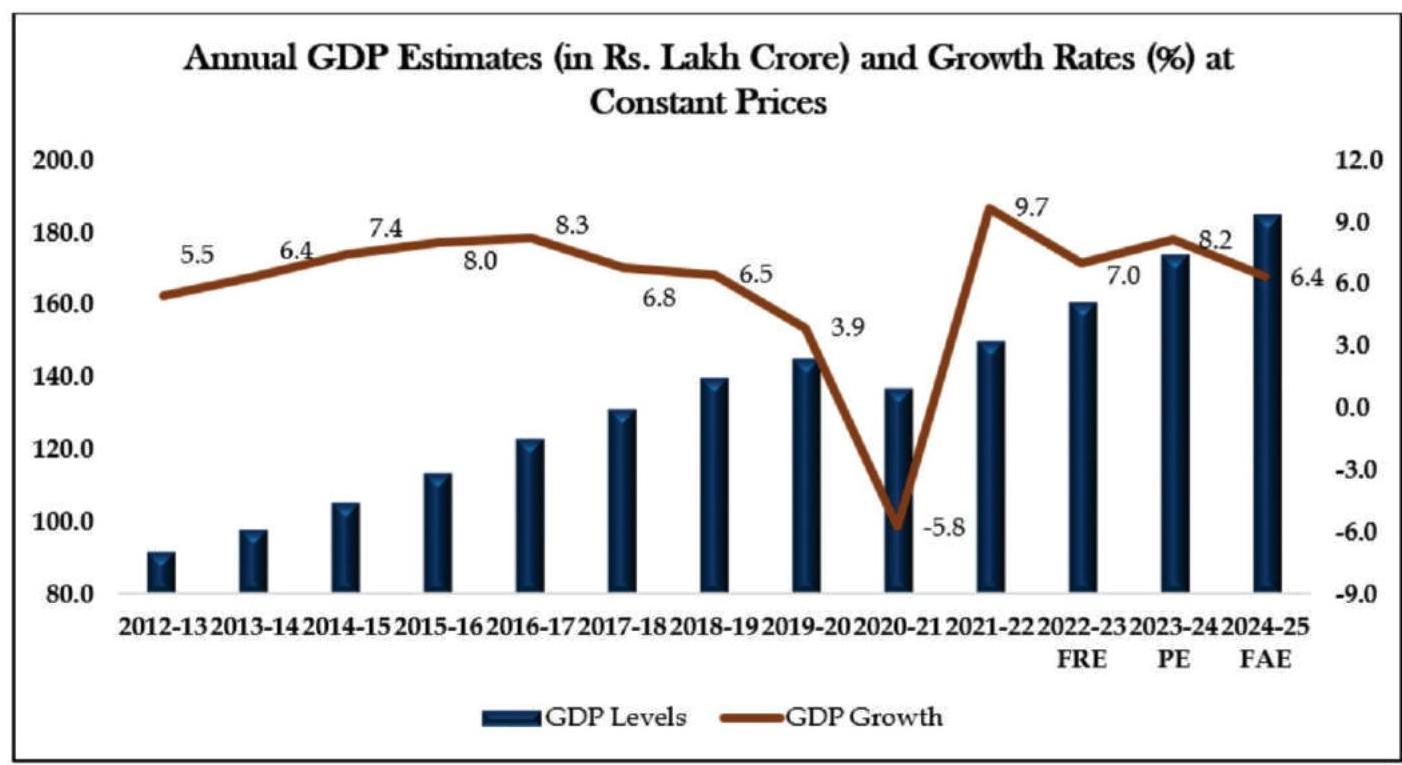
Annual GVA Estimates (in Rs. Lakh Crore) and Growth Rates (\%) at Constant Prices
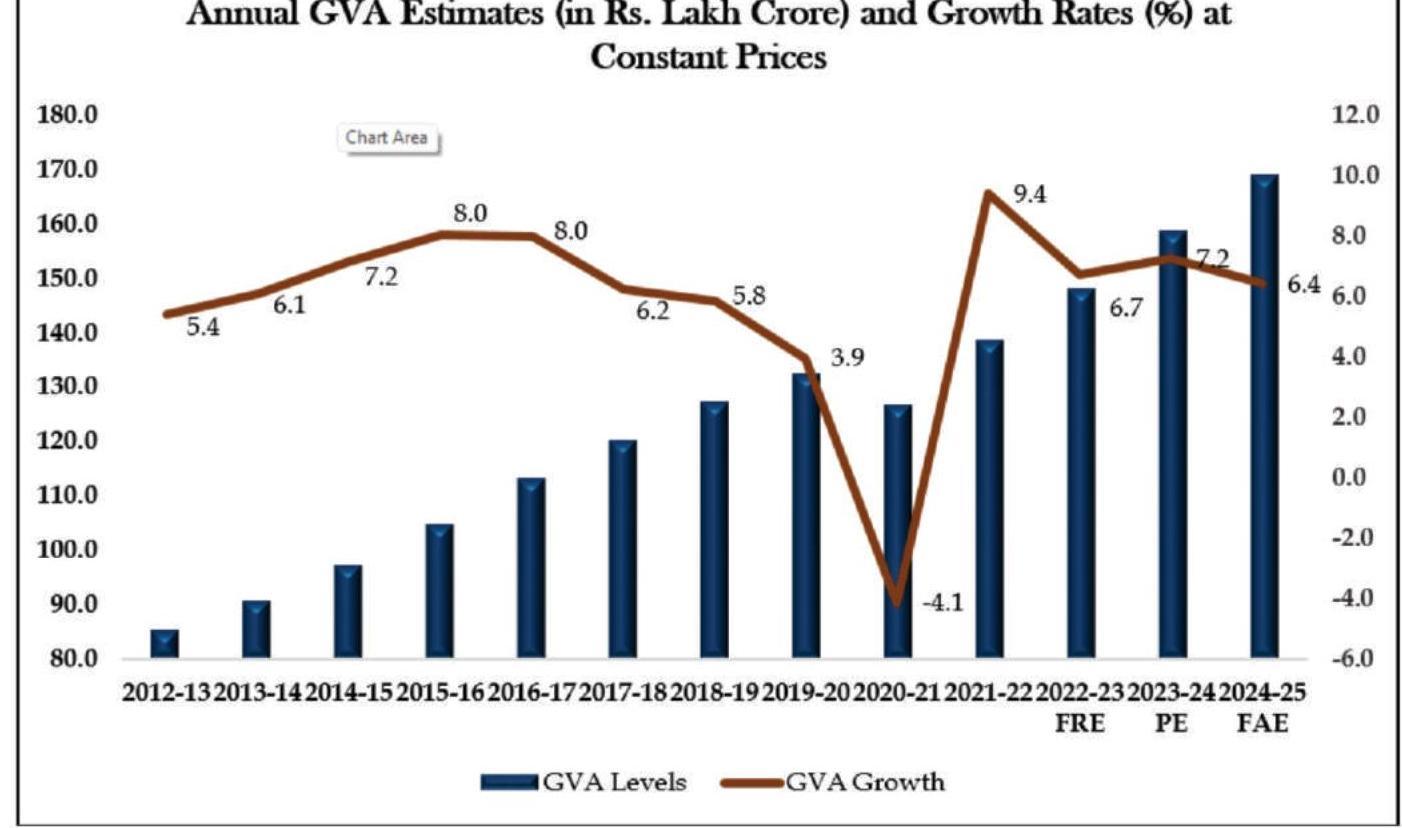
Fig. 2: Sectoral Composition and Growth Rates of Annual GVA
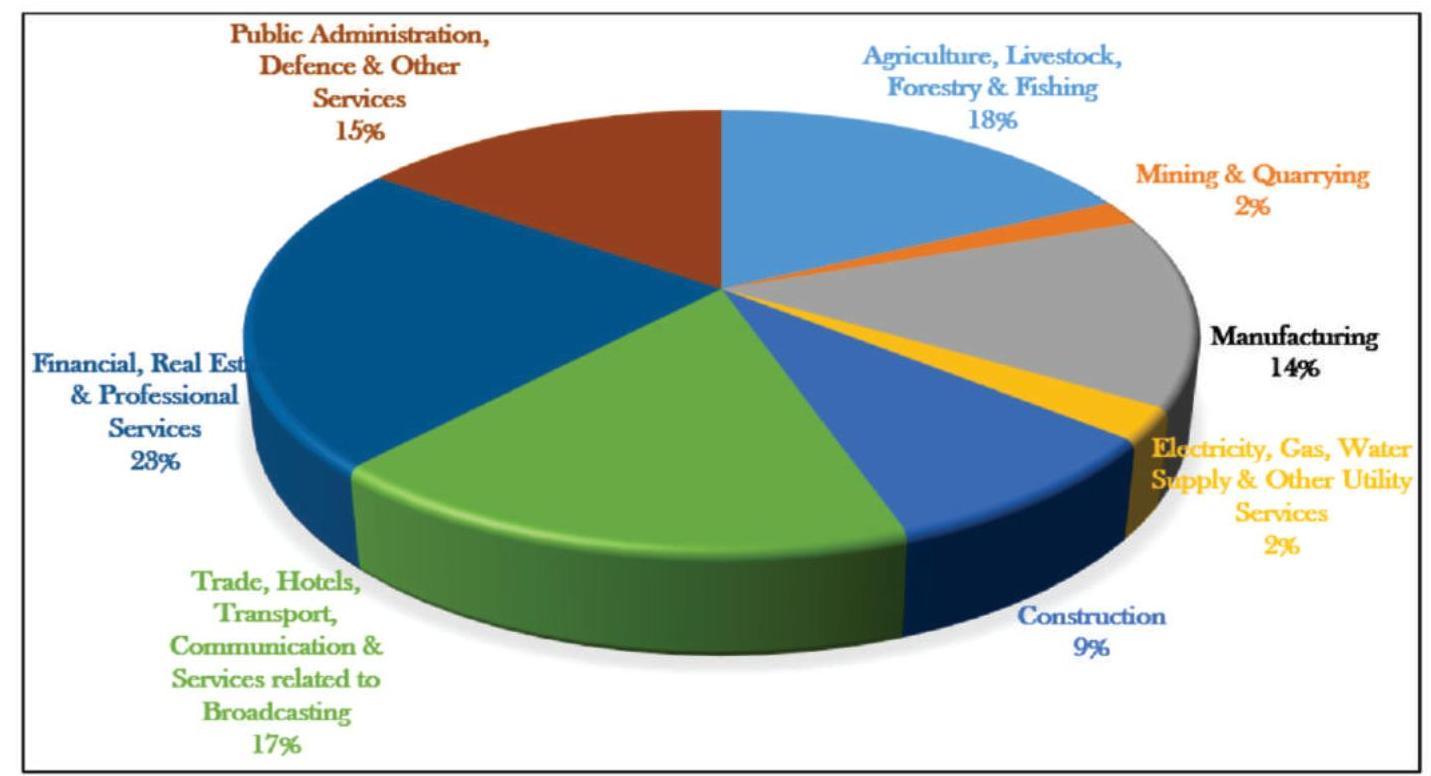
Sector-wise Growth Rates (\%) of Real GVA in FY 2023-24 and 2024-25
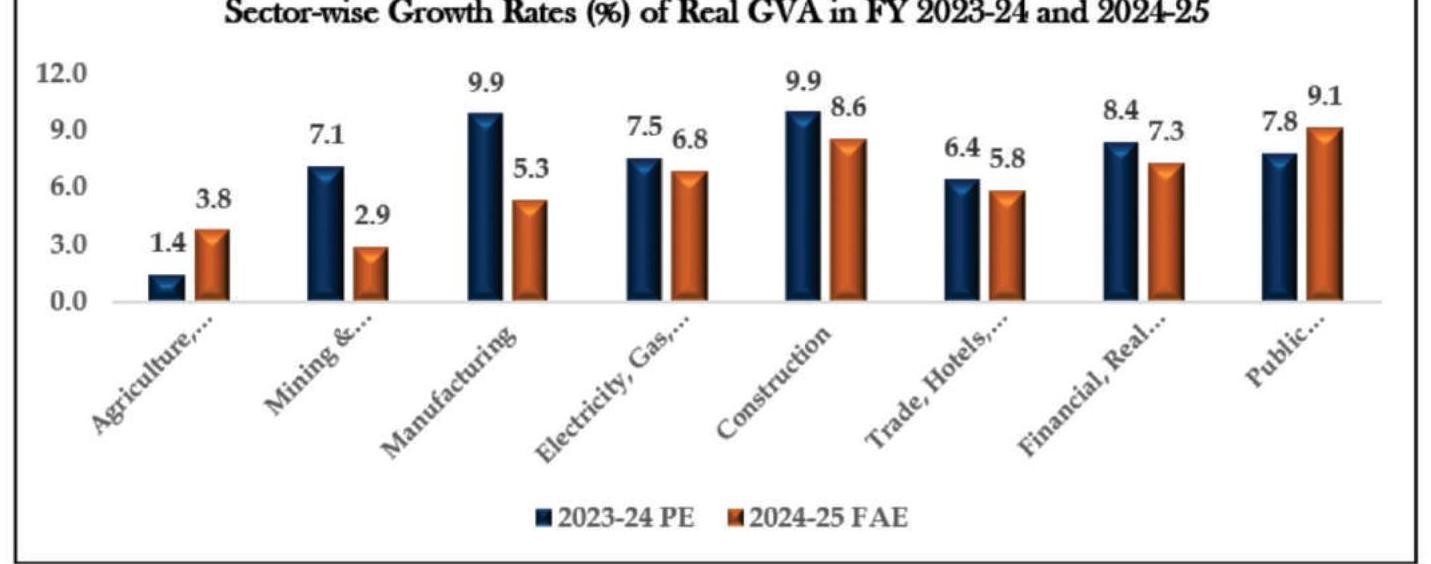
Fig. 3: Composition and Growth Rates of Annual GVA in Broad Sectors
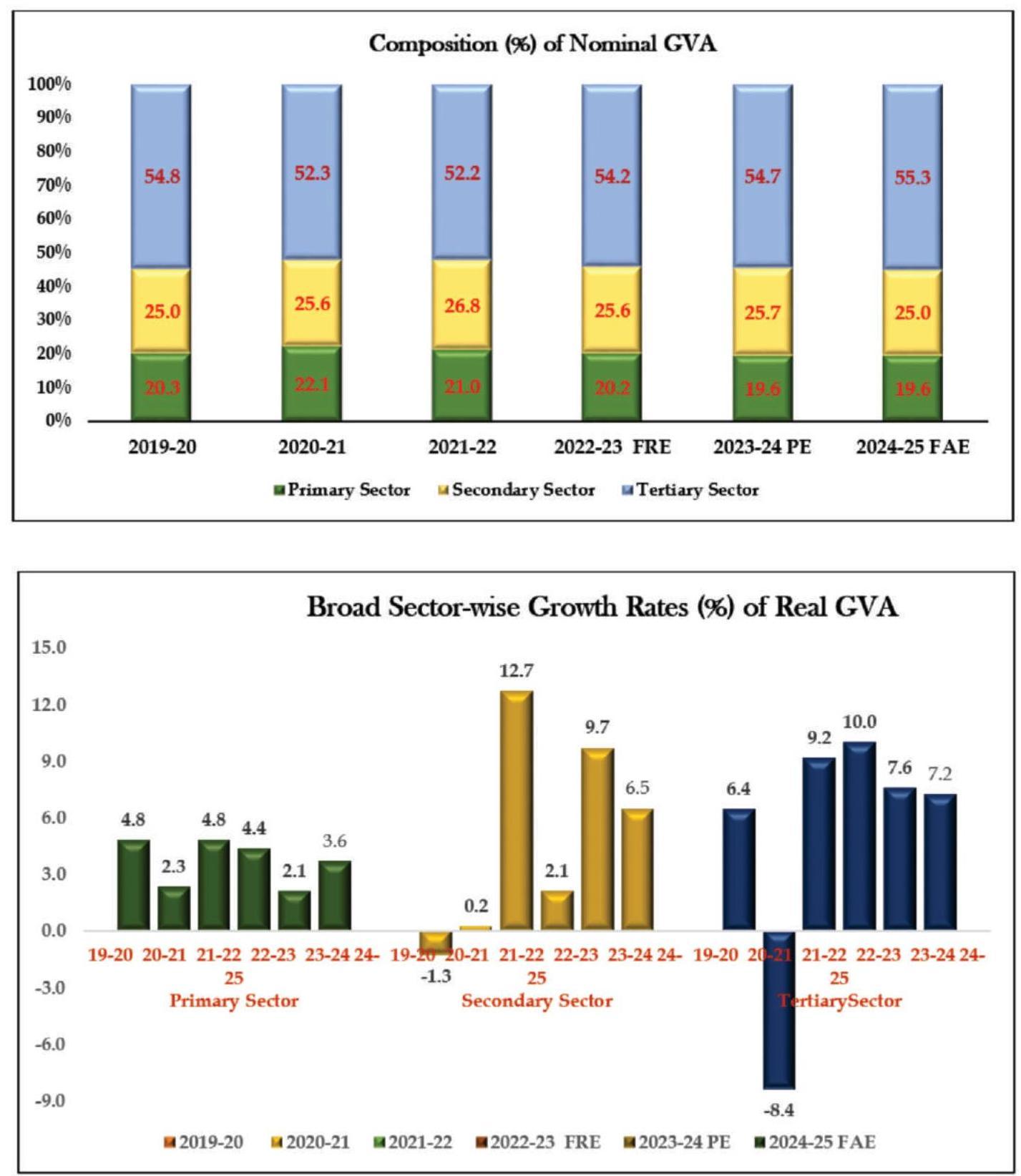
[Primary Sector: Agriculture, Livestock, Forestry \& Fishing and Mining \& Quarrying
Secondary Sector: Manufacturing, Electricity, Gas, Water supply \& Other Utility Services and Construction
Tertiary Sector: Trade, Hotels, Transport, Communication and Services related to Broadcasting, Financial, Real Estate \& Professional Services and Public Administration, Defence \& Other Services]
2.10 The Ministry’s publications, data releases and reports related to National Accounts, for the period from $1^{\text {st }}$ January, 2024 to 31st December, 2024 which are also available on the official website, are given below:
| S. No. |
Description of the publication/ data release/ report | Date of release | Manner of release |
|---|---|---|---|
| 1. | First Advance Estimates (FAE) of National Income for the financial year 2023-24 |
5th January, 2024 | Press Note |
| 2. | Payroll Reporting in India: An Employment Perspective | 25th January, 2024 | Press Note |
| 3. | Payroll Reporting in India: An Employment Perspective December, 2023 |
23rd February, 2024 | Press Note |
| 4. | Second Advance Estimates (SAE) of National Income, 2023-24; Quarterly Estimates of Gross Domestic Product (GDP) for October-December quarter (Q3) of 2023-24 along with its expenditure components and First Revised Estimates of National Income, Consumption Expenditure, Saving and Capital Formation, 2022-23 |
29th February, 2024 | Press Note |
| 5. | National Accounts Statistics – 2024 | May, 2024 | e-Publication |
| 6. | Provisional Estimates of Annual National Income 2023-24 and Quarterly Estimates of Gross Domestic Product (GDP) for the Fourth Quarter (Q4) of 2023-24 |
31st May 2024 | Press Note |
| 7. | State-wise and Item-wise Value of Output from Agriculture, Forestry and Fishing (2011-12 to 2022-23) |
June, 2024 | e-Publication |
| 8. | Payroll Reporting in India: An Employment Perspective January to April, 2024 |
25th June, 2024 | Press Note |
| 9. | Payroll Reporting in India: An Employment Perspective May, 2024 |
25th July, 2024 | Press Note |
| 10. | Payroll Reporting in India: An Employment Perspective June, 2024 |
23rd August, 2024 | Press Note |
| 11. | Estimates of Gross Domestic Product for the First Quarter (April-June) of 2024-25 |
30th August, 2024 | Press Note |
| 12. | Payroll Reporting in India: An Employment Perspective July, 2024 |
25th September, 2024 | Press Note |
| 13. | Payroll Reporting in India: An Employment Perspective August, 2024 |
25th October, 2024 | Press Note |
| 14. | Payroll Reporting in India: An Employment Perspective September, 2024 |
25th November, 2024 | Press Note |
| 15. | Estimates of Gross Domestic Product for the Second Quarter (July-September) of 2024-25 |
29th November 2024 | Press Note |
| 16. | Payroll Reporting in India: An Employment Perspective October, 2024 |
26th December, 2024 | Press Note |
2.11 Details of meetings/ conferences/ workshops held during the period from 1st January, 2024 to 31st December, 2024 are given below:
I. Annual discussions between States DESs and MoSPI’s officers/officials on comparable estimates of SDP for the years 2021-22 and 2022-23, base year 2011-12, were held during March 11 – April 10, 2024.
ii. Meetings with GDP forecasters to understand the data inputs and methodologies used by various forecasters, while also providing forecasters with an understanding of the compilation process and data sources used by the Ministry were held on 5-6th June, 2024 at MoSPI, Khurshid Lal Bhawan, New Delhi.
iii. First Regional Training Workshops on compilation of State Domestic Product and other related aggregates for statistical personnel from States/UTs were organized in Dehradun, Uttarakhand during 5-9th August, 2024 covering 9 states/UTs namely Tamil Nadu, Jharkhand, Ladakh, Assam, Punjab, Haryana, Madhya Pradesh,
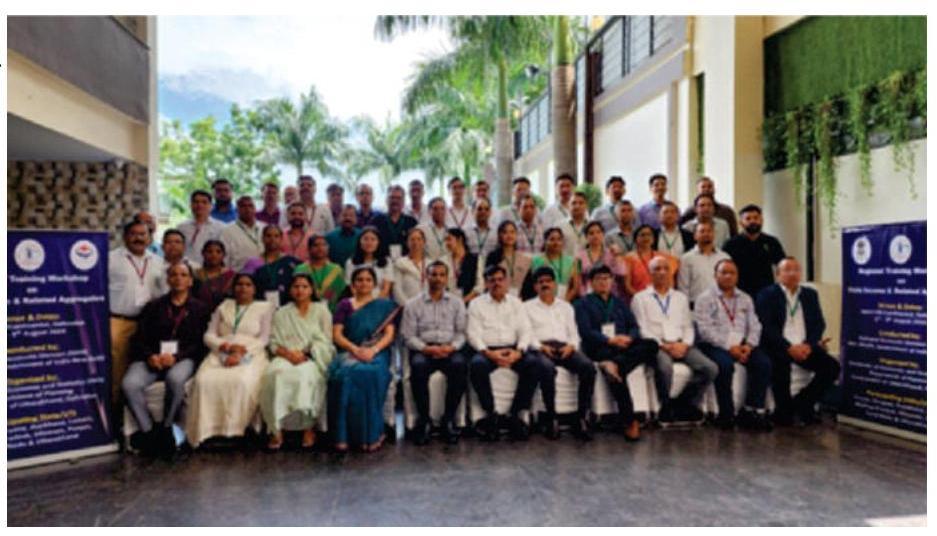
Uttarakhand and Mizoram.
iv. Second Regional Training Workshops on compilation of State Domestic Product and other related aggregates for statistical personnel from States/UTs were organized in Ahmedabad, Gujarat during 2nd-6th September, 2024 covering 10 States/UTs namely Bihar, Chhattisgarh, Himachal Pradesh, Kerala, Jammu \& Kashmir, Dadar \& Nagar Haveli and Daman \& Diu, Puducherry, Telangana, Maharashtra and Gujrat.
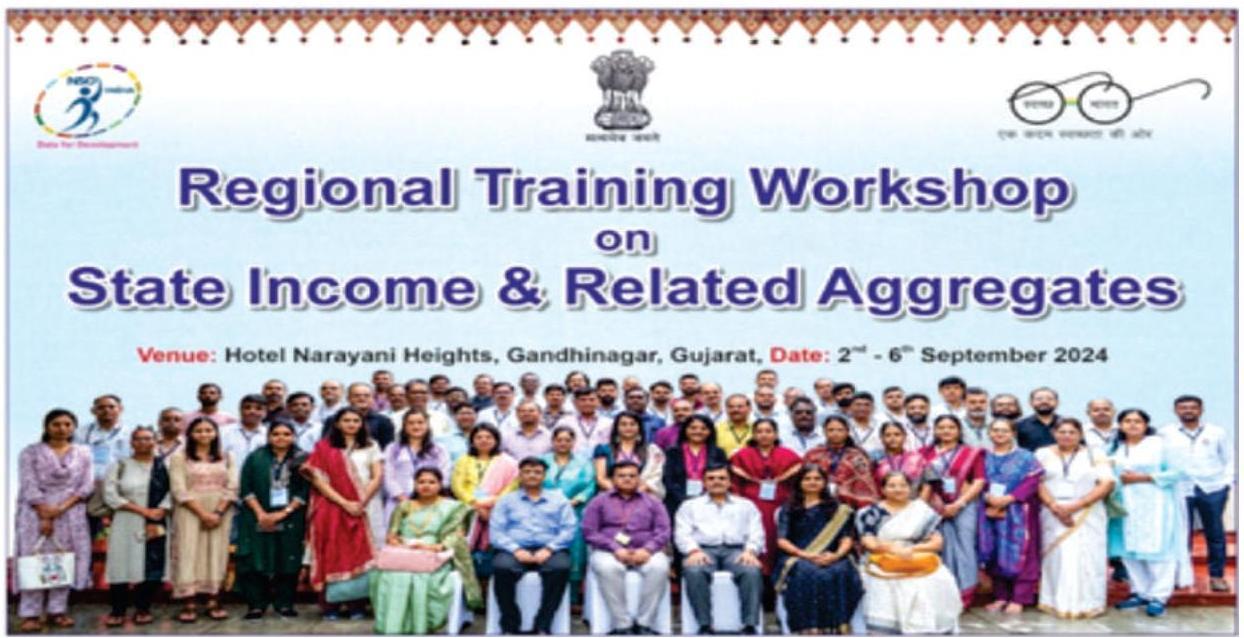
v. Third Regional Training workshop on compilation of State Domestic Product and other related aggregates for statistical personnel from States/UTs were organized in Agartala, Tripura during 23rd-27th September, 2024 covering 13 states/UTs namely Karnataka, Meghalaya, Rajasthan, A\&N Island, Nagaland, Manipur, Delhi, Odisha, Sikkim, Arunachal Pradesh, West
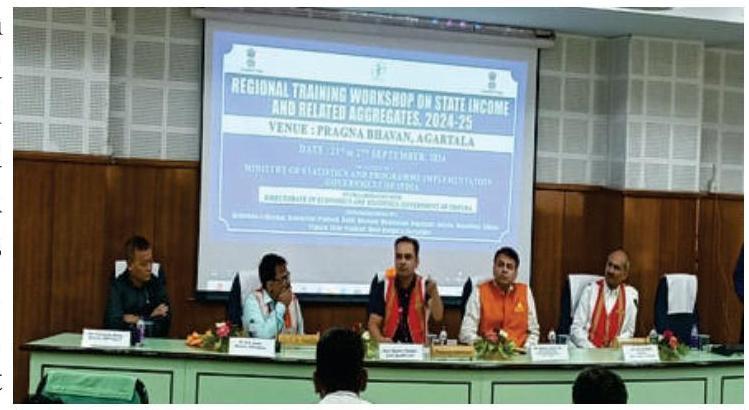
Bengal, Uttar Pradesh and Tripura.
vi. First Meeting of the Advisory Committee on National Accounts Statistics (ACNAS) was held on 20th August, 2024.
vii. Two Meetings of the Sub-Committee I of ACNAS: ‘Sub-committee for Incorporation of New Data Sources, Rates and Ratios on Data Sources’ were held on 14th October, 2024 and 4th December, 2024 to guide on the use of existing and new data sources in compilation of GDP in rebased series.
viii. Two Meetings of the Sub-Committee II of ACNAS: ‘Sub-committee for Methodological Improvement’ were held on 25th October, 2024 and 6th December, 2024 to guide on the improvement in methodological aspects in compilation of GDP in rebased series.
ix. First Meeting of the Sub-Committee III of ACNAS: ‘Sub-committee for Constant Price Estimates’ was held on 24th December, 2024.
x. Two Meetings of the Sub-Committee IV of Advisory Committee on National Accounts (ACNAS): ‘Sub Committee on Regional Accounts’ were held on 14th November, 2024 and 18th December, 2024 to advise and suggest improvement in sub-national accounts.
xi. A data user conference on GDP and CPI to seek feedback and suggestions of the Forecasters and Economists who are actively using GDP and CPI data, was held on 24th September, 2024 in Mumbai, for making these indices more robust and effective.
xii. A Technical Assistance (TA) mission with IMF SARTTAC was conducted during 11-15th Nov., 2024 to assist the Ministry in improving the institutional sector accounts and balance sheets.
Price Statistics
2.12 NSO, MoSPI started compiling Consumer Price Index (CPI) separately for rural, urban, and combined sectors on monthly basis with Base Year $(2010=100)$ for all India and States/UTs with effect from January 2011. It revised the Base Year of the CPI from $2010=100$ to $2012=100$, incorporating methodological improvements in consonance with the international practices. The basket of items and weighing diagrams for the revised series was prepared using the Modified Mixed Reference Period (MMRP) data of the Consumer Expenditure Survey (CES), 2011-12 of the 68th Round of National Sample Survey (NSS). In addition, Consumer Food Price Index (CFPI) is also being released as weighted average of the indices of ten subgroups: ‘Cereals and products’; ‘Meat and fish’; ‘Egg’; ‘Milk and products’; ‘Oils and fats’; ‘Fruits’; ‘Vegetables’; ‘Pulses and products’; ‘Sugar and confectionery’; and ‘Spices’. CFPI does not include ‘Non-alcoholic beverages’ and ‘Prepared meals, snacks, sweets etc.’
2.13 Base Revision of CPI: Based on the Household Consumption Expenditure Survey 2022-23 data, base revision exercise of CPI has been initiated by MoSPI since 2023. The process mainly comprises revision in the item basket along-with their weights in CPI calculations. MoSPI is also planning to introduce methodological improvements and enhancement in coverage of CPI to make it more robust and resilient. The base price data collection for the new CPI series is in progress.
Trend in CPI based inflation
2.14 All India year-on-year inflation rate (percentage change of CPI of current month over corresponding month of last year), based on CPI for combined sector, was above 3 per cent during January 2024 to December 2024. The said rate was highest in October 2024 at 6.21 per cent. The minimum rate was registered at 3.60 per cent in July 2024 during the aforementioned period.
2.15 All India year-on-year inflation rates (\%) based on CFPI for the combined sector shows that average inflation rate of food items during January 2024 to December 2024 was 8.40. CFPI inflation touched its highest level at 10.87 per cent in October 2024 and lowest 5.42 per cent in July 2024.
| Month\& Year | All India Year-on-Year inflation rates (\%) based on CPI |
All India Year-on-Year inflation rates (\%) based on CFPI |
|---|---|---|
| Jan-24 | 5.10 | 8.30 |
| Feb-24 | 5.09 | 8.66 |
| Mar-24 | 4.85 | 8.52 |
| Apr-24 | 4.83 | 8.70 |
| May-24 | 4.80 | 8.69 |
| Jun-24 | 5.08 | 9.36 |
| Jul-24 | 3.60 | 5.42 |
| Aug-24 | 3.65 | 5.66 |
| Sep-24 | 5.49 | 9.24 |
| Oct-24 | 6.21 | 10.87 |
| Nov-24 | 5.48 | 9.04 |
| Dec-24* | 5.22 | 8.39 |
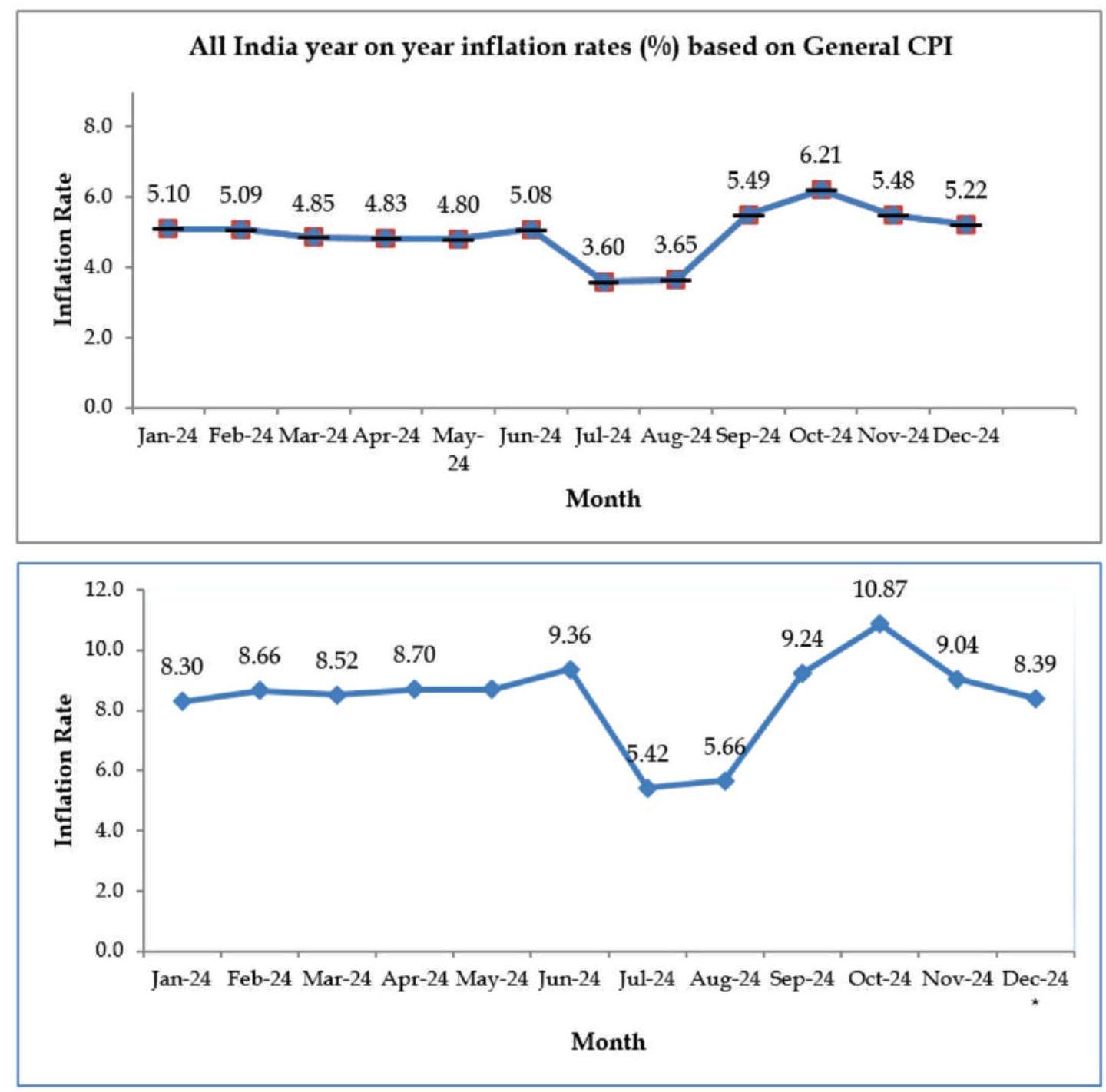
*Provisional
2.16 The NSO, MoSPI releases Consumer Price Indices for Rural, Urban and Combined sectors also at group and sub-group levels. It is to be stated that ‘Food and beverages’ as a whole has 45.86 per cent share, which includes 39.05 per cent share of CFPI in CPI basket of combined sector. Therefore, food items are generally the major drivers of overall inflation rate based on CPI. Sub-group/Group wise inflation rates and their respective shares (in terms of weight) have been combined together to know their contribution to overall inflation rate during each month from January 2024 to December 2024. These contributions are given in the table below:
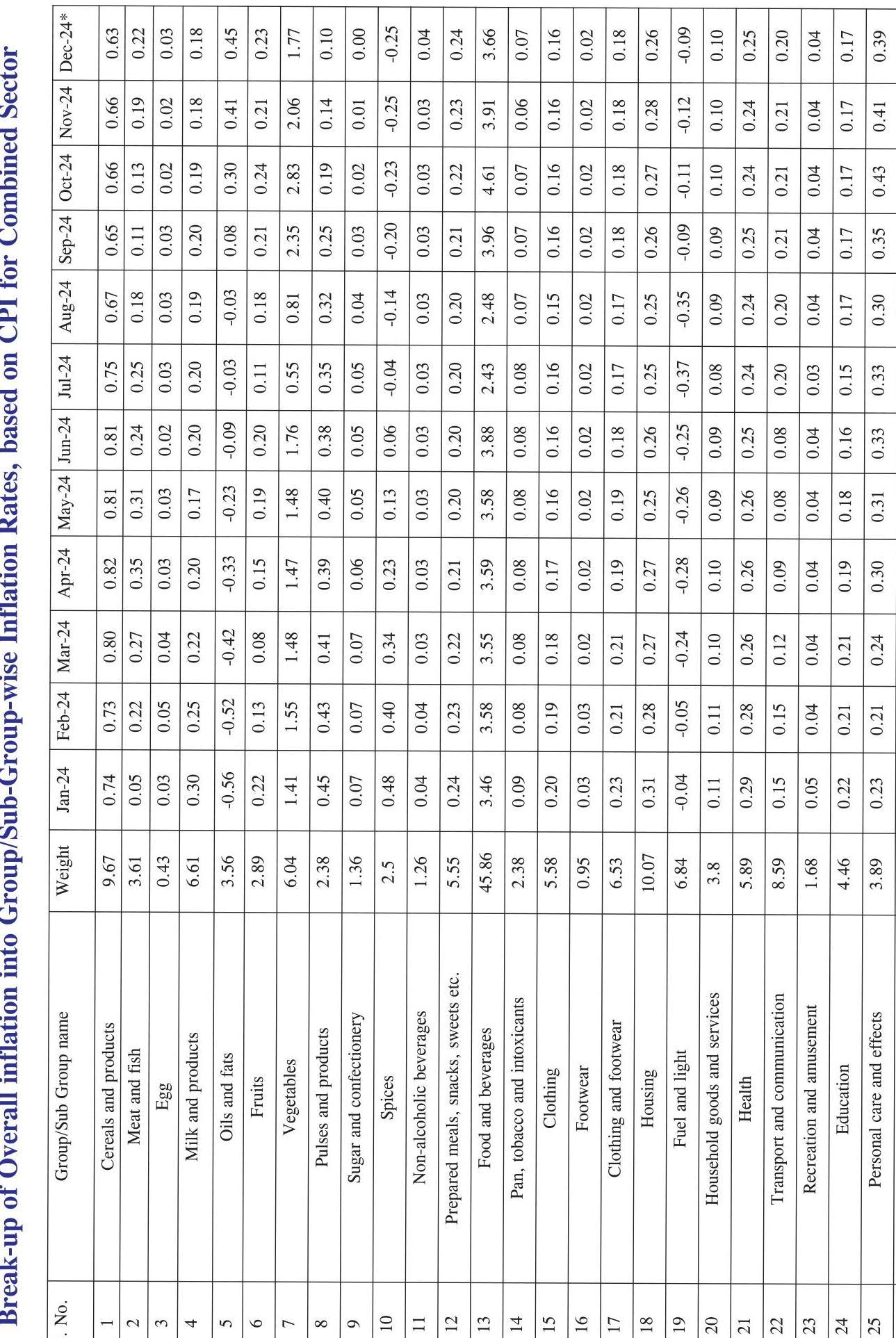
Economic Statistics
Index of Industrial Production (IIP)
2.17 All India Index of Industrial Production (IIP) is a short-term composite indicator which measures changes in volume of production of a basket of industrial products with respect to a base period. The NSO, MoSPI compiles IIP using secondary data received from 14 source agencies in various Ministries/ Departments or their attached/subordinate offices. Department for Promotion of Industry and Internal Trade (DPIIT) is the major source agency.
2.18 IIP is released every month in the form of Quick Estimates with a time-lag of 6 weeks as per the Special Data Dissemination Standard (SDDS) norms of IMF. Apart from breakup of the index for mining, manufacturing and electricity sectors, the estimates are also simultaneously being released as per NIC 2digit categories and Use-based classification (UBC) viz., Primary Goods, Capital Goods, Intermediate Goods, Infrastructure/Construction goods, Consumer durables and Consumer non- durables. The press releases, indices and growth rates at sectoral, NIC 2-digit level and UBC categories, indices and production at item group level, metadata and details of methodology of all India IIP with base year 2011-12 are made available in the website (http://www.mospi.gov.in/iip – 2011-12-series) for public access.
2.19 The sector-wise annual indices of industrial production and its growth rates from 2012-13 to 202324, monthly indices \& growth rates from January 2024 to November 2024 and the cumulative indices \& growth rates from 2012-13 to 2024-25 (till November, 2024) are depicted in the charts given below:
Index of Industrial Production (Annual): 2012-13 to 2023-24: Sector-wise
Figure 1
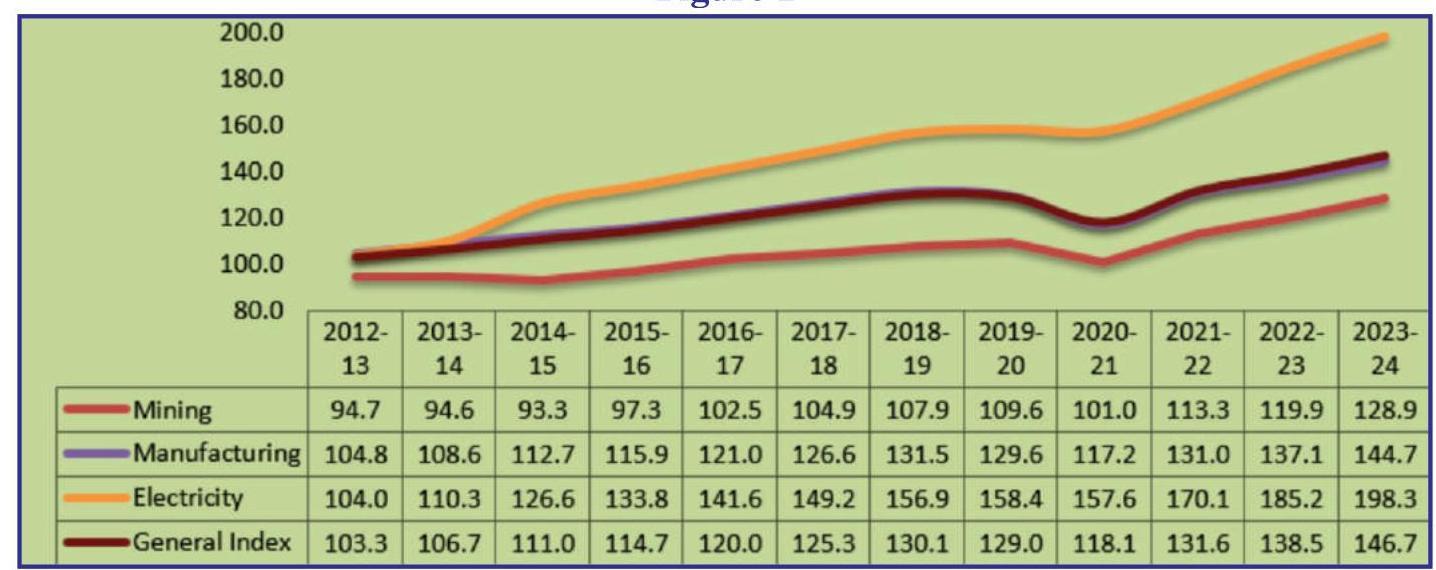
Comparison of Sector-wise Annual Growth Rates (w.r.t. previous year) of IIP: 2012-13 to 2023-24
Figure 2
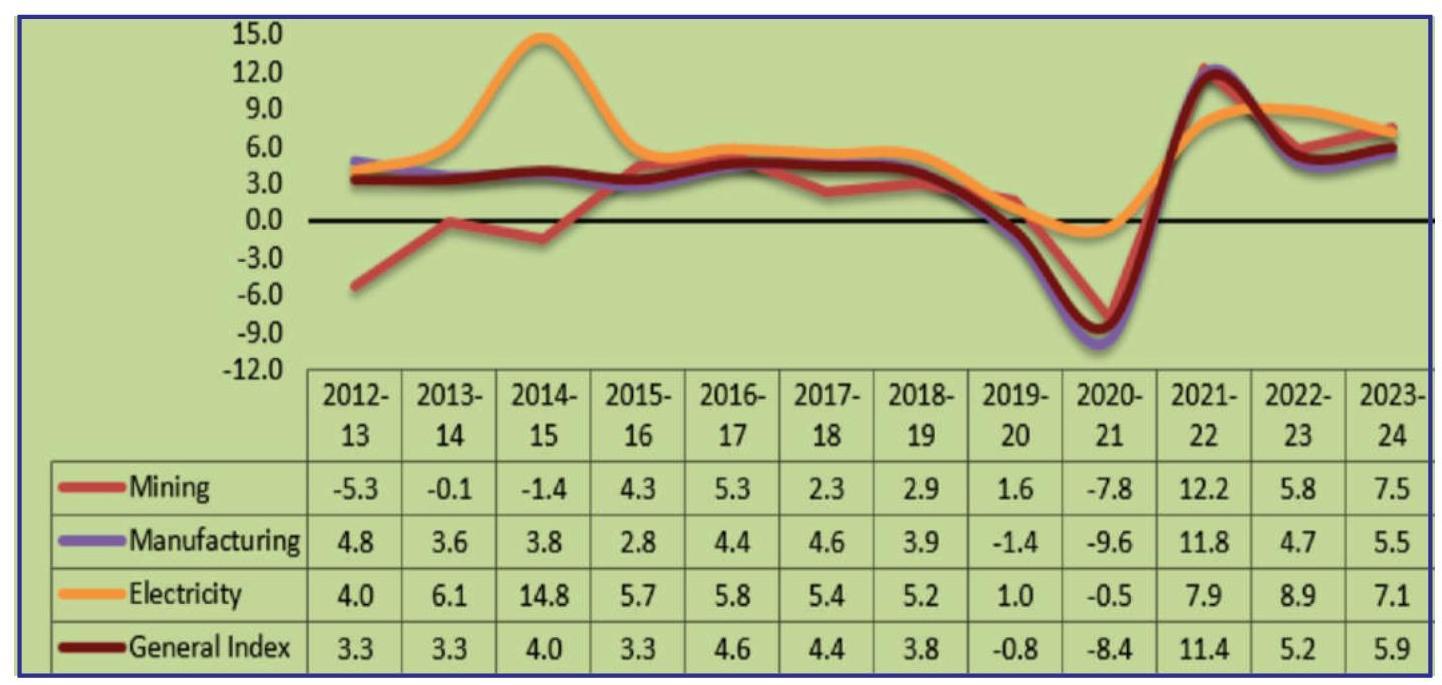
*Provisional
Index of Industrial Production (Monthly): January 2024 to November 2024 –
Sectoral Indices
Figure 3
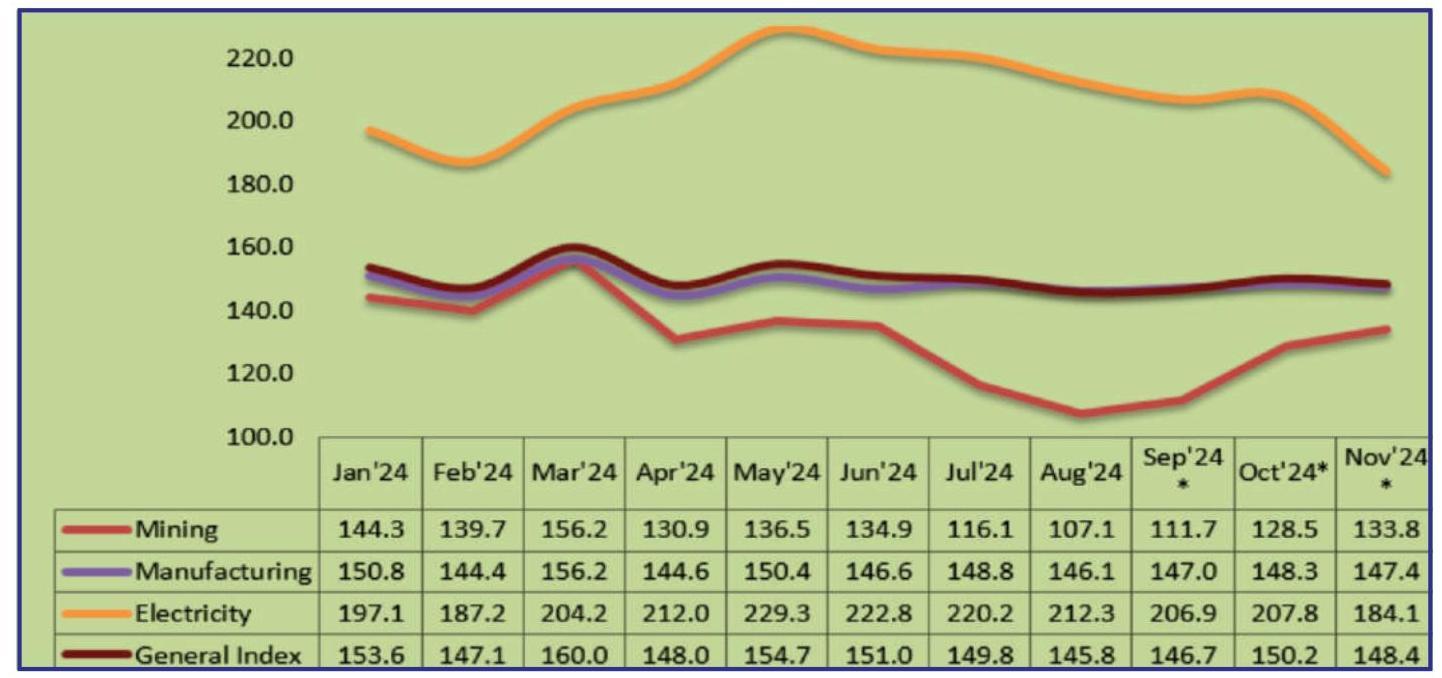
*Provisional
Sector-wise IIP Growth Rates (w.r.t previous year):
January 2024 to November 2024
Figure 4
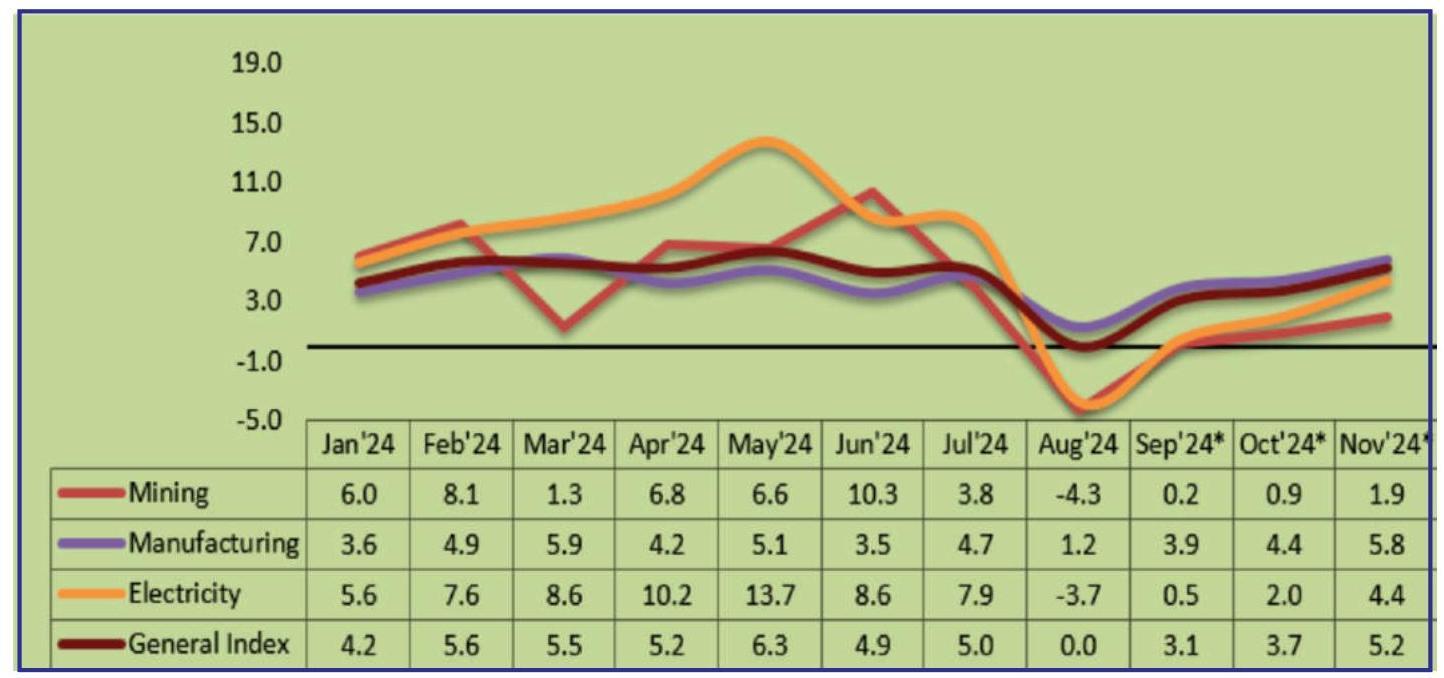
*Provisional
Index of Industrial Production (Cumulative for January to November):
2012-13 to 2024-25 – Sector-wise
Figure 5

*Provisional
Comparison of Sector-wise IIP Growth Rates (w.r.t. previous year) for the period January to November during 2012-13 to 2024-25
Figure 6
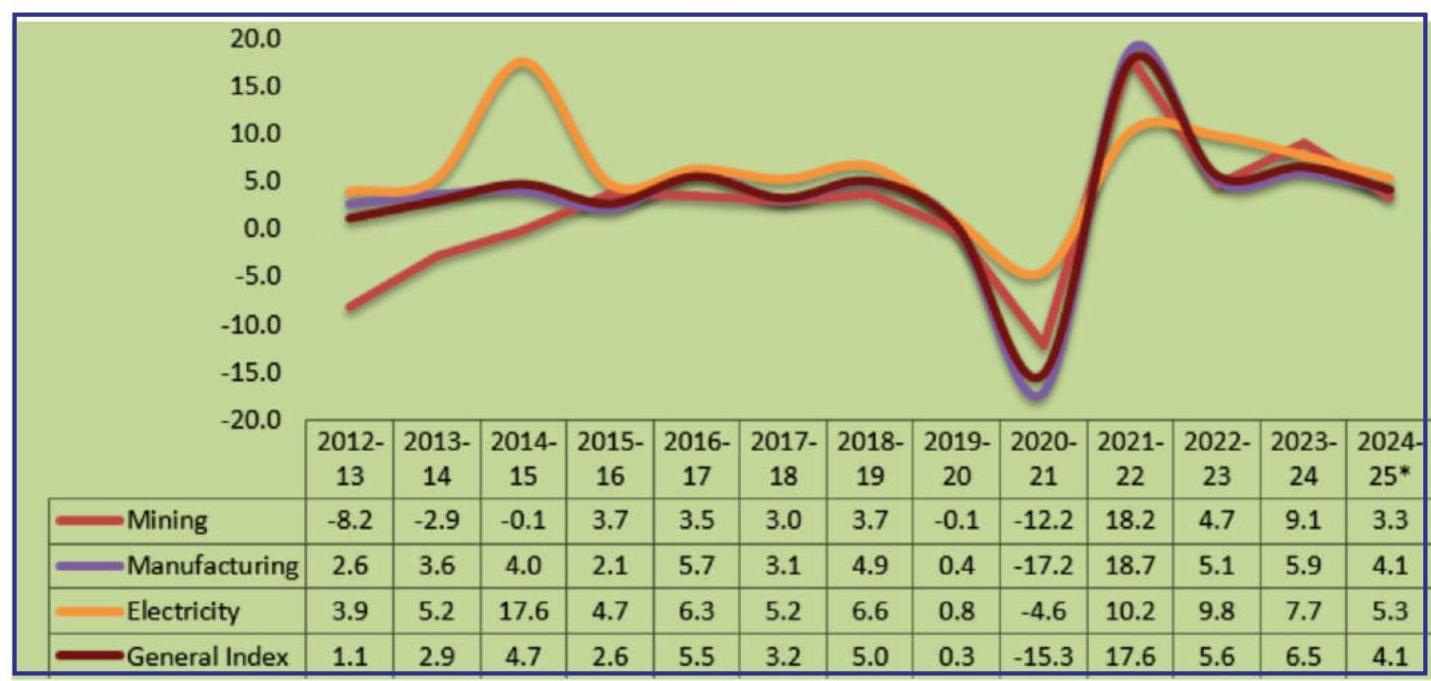
Energy Statistics
2.20 The publication titled Energy Statistics India is annually brought out by the Ministry. The “Energy Statistics India 2024” (31st Edition) is the latest one in the series and is an integrated dataset containing diverse key information about reserve, capacity, production, consumption, and import/export of all the energy commodities (like Coal, Lignite, Petroleum, Natural Gas, Renewable Energy, etc.) of India during FY 2022-23. Energy Statistics India 2025 will be released in March 2025.
2.21 The publication caters to the needs of the planners, policy makers, and researchers by making available the energy data in a single place. The publication also contains different tables (like Energy Balance), graphs (like Sankey Diagram), and Sustainable Energy Indicators as per International Standards which are being widely used by different users.
2.22 Shrugging off the impact of COVID-19, the Indian Economy continued to shine bright during FY 202223, as the Total Primary Energy Supply (TPES) in the economy increased by over 14 per cent than the previous year.
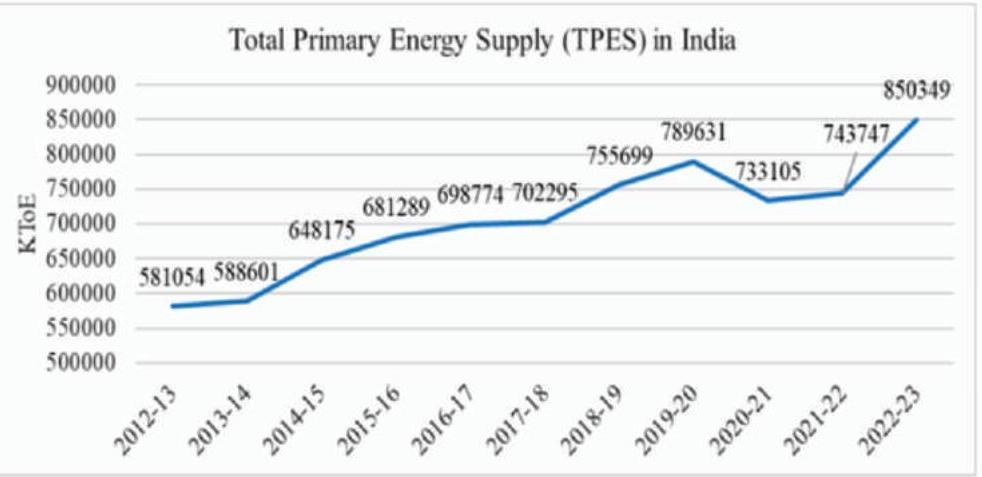
2.23 The Final Energy Consumption per Capita in India has also shown a significant increase during FY 2022-23, which stood at 16,999 Mega Joule/person, a growth of over 6 per cent over the previous year.
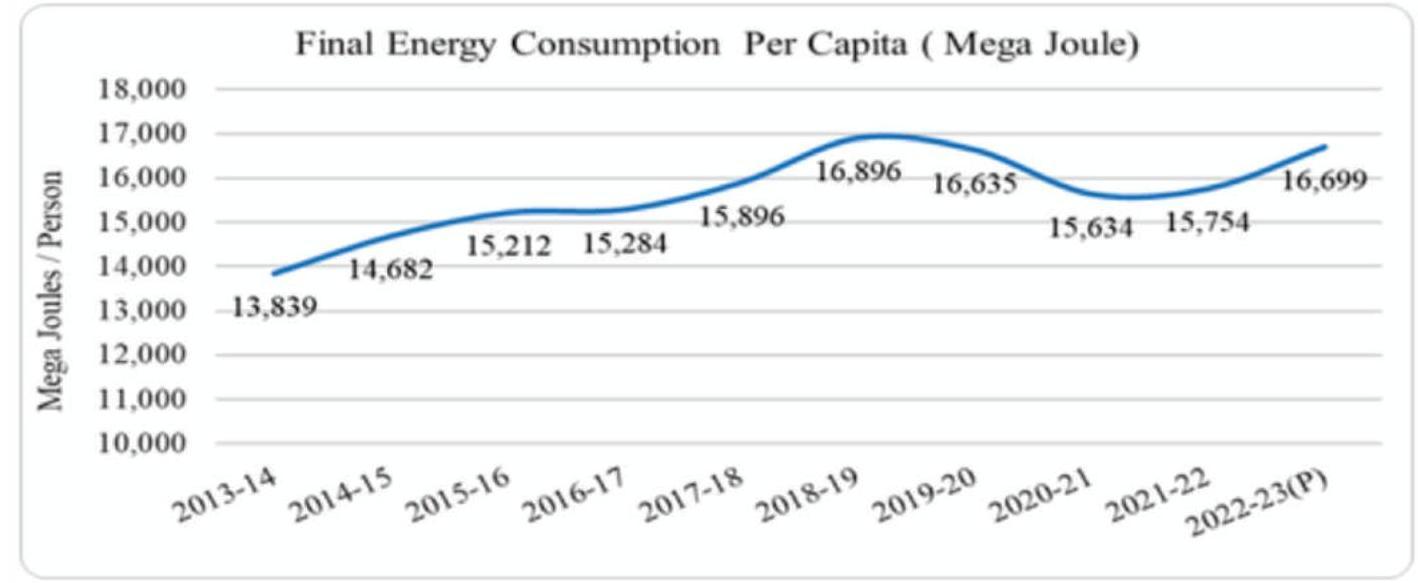
Social Statistics
2.24 The NSO, MoSPI is responsible for coordinating development of social, environment and multidomain statistics. The ambit of social statistics includes population, human development, employment and social justice, while that of multi-domain statistics includes gender, persons with disabilities and indicators related to Sustainable Development Goals (SDGs).
2.25 The Ministry releases annual and ad-hoc publications on diverse spread of topics on social, environment and the multi-domain statistics as mentioned above. The Ministry collates and compiles information sourced from national surveys, censuses, administrative data, economic statistics, remote sensing agencies and environmental monitoring systems. These datasets are then combined in standard frameworks prescribed for these statistics, thus providing data, comparable across time and space.
2.26 The Ministry is also responsible for statistical coordination for India in respect of the BRICS related statistical activities and helps disseminate several social and economic statistics about the BRICS member countries.
2.27 The specific activities undertaken by the Ministry during 2024-25 are outlined in the following paragraphs.
Facilitating and monitoring the progress towards Sustainable Development Goals (SDGs)
2.28 United Nations, in September 2015 adopted 17 Sustainable Development Goals (SDGs) and 169 associated targets highlighting the focus areas necessary to achieve sustainable development by 2030. At the heart of the SDGs, there are five critical dimensions – people, prosperity, planet, partnership and peace, each of which are addressed in the 2030 Agenda by using the universally applicable SDGs and targets covering the three aspects of sustainable development viz., Economic, Social and Environmental. To monitor the progress of SDGs at global level, a Global Indicator Framework (GIF) presently consisting of 248 indicators ( 231 unique indicators) was adopted by the UN in 2017.
2.29 Government of India is committed to ensuring ‘Sabka Saath, Sabka Vikas, Sabka Vishwas, Sabka Prayas’ which is in the spirit of the SDG motto of ‘Leaving No One Behind’. In this endeavour, MoSPI has been entrusted with the responsibility of development of National Indicator Framework (NIF) for SDGs, in sync with GIF, which can be used to monitor the progress of SDGs in the country.
2.30 MoSPI has initially developed a NIF for SDGs, consisting of 306 indicators along with data sources and periodicity, keeping in view the national priorities and needs. The NIF was developed following national consultation process involving Ministries/Departments of the Government, State Governments, UN agencies and other stakeholders. In compliance to the Cabinet approval, a High Level Steering Committee (HLSC) on SDGs was constituted by MoSPI under the Chairmanship of Chief Statistician of India (CSI) and Secretary, MoSPI with members from NITI Aayog, Ministry of Home Affairs, Ministry of Health and Family Welfare, Ministry of Environment, Forest and Climate Change, Ministry of Finance and Ministry of Statistics and Programme Implementation to periodically review and refine the NIF. Under the ambit of HLSC, a Technical Advisory Committee (TAC) on SDGs has been constituted by the MoSPI in March 2020 under the Chairpersonship of DG (Statistics), MoSPI to provide technical support to HLSC. Any amendment(s) proposed in the NIF or any new proposal relating to SDGs is examined in the TAC and the recommendations of TAC are placed before HLSC for consideration. HLSC has been periodically refining the NIF. Presently in SDG-NIF 2024, there are 290 national indicators with identified data sources and periodicity (as on 29th June, 2024) to monitor the progress of SDGs.
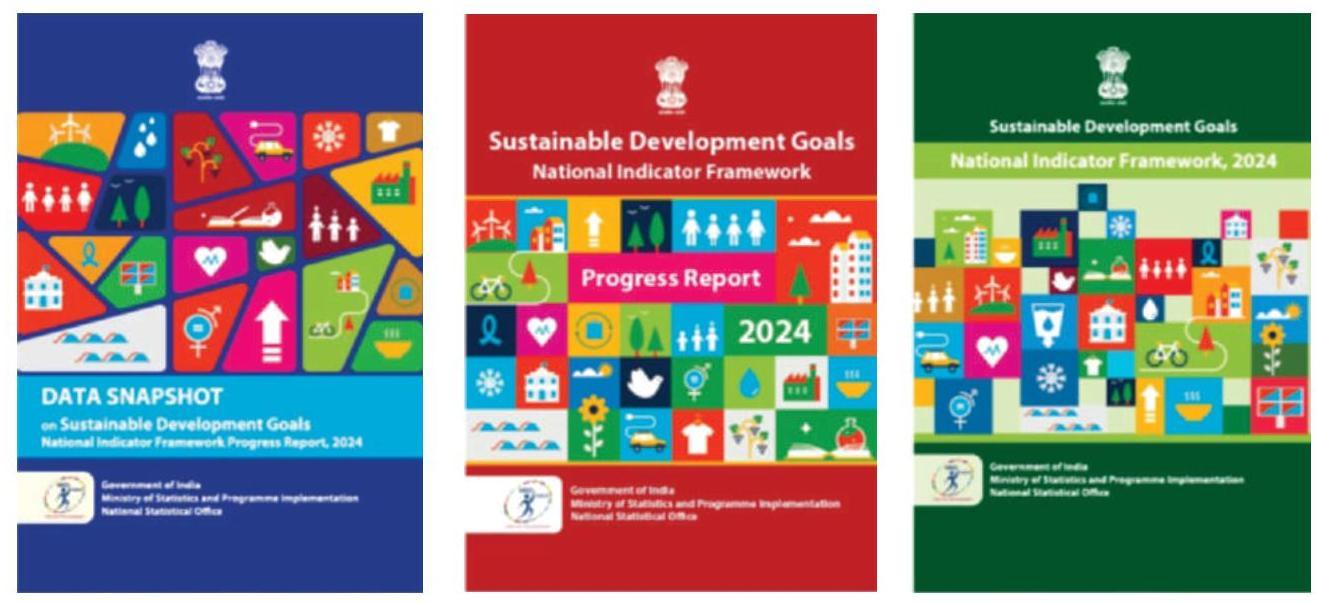
2.31 Based on latest Sustainable Development Goals – National Indicator Framework, the following reports were released on the occasion of Statistics Day, 2024 (celebrated on 29th June, 2024).
i. Sustainable Development Goals National Indicator Framework Progress Report, 2024.
ii. Data Snapshot on Sustainable Development Goals National Indicator Framework Progress Report, 2024.
iii. Sustainable Development Goals National Indicator Framework, 2024.
2.32 Active collaboration with all the stakeholders including custodian agencies, nodal ministries at the centre, research institutions, State Governments and the public, is pivotal to the statistical monitoring of the progress made by the country in respect of the goals and targets specified under
SDGs. The Ministry has taken steps to fulfil the same and organized various workshop/meeting as follows:
i. Several Inter-Ministerial Consultations/ Meetings were organised during the year 2024 to review the SDG indicators, data compilation and possible data disaggregation. The Ministry is also actively participating in various National and International Committees and Technical Groups.
ii. The Ministry provides technical support to the States, in development of a comprehensive and inclusive SDG Monitoring Framework. In this context, the Ministry has developed and circulated Guidelines for development of State Indicator Framework (SIF) to facilitate and assist States/UTs for development of a State Level Monitoring Framework in respective State/UTs in July 2019, which were further updated in March 2022. Various workshops with States/ UTs were organized on this issue.
iii. 28th Conference of Central and State Statistical Organizations (CoCSSO) was held during 12-13th August, 2024 on “Use of Data for Decision Making: Strengthening State Statistical Systems,” at Dr. Ambedkar International Centre, Janpath, New Delhi wherein a side event related to ‘Best Practices on SDG Monitoring’ was organised on 12th August, 2024.
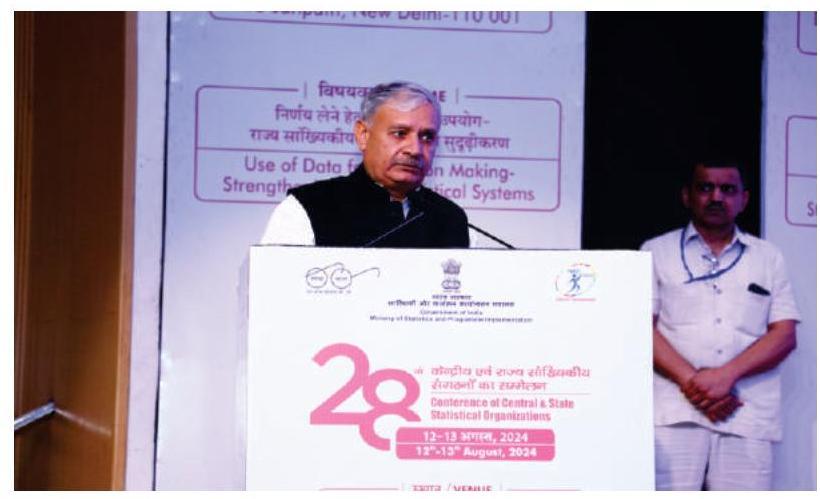
iv. Considering the importance of data in monitoring the progress of SDGs at all levels, several steps have been taken to bridge the data gaps on SDGs. A few existing surveys of MoSPI are being aligned as per SDG data requirements.
v. The Minsitry organised a ‘One-day consultation on Review of Milestone setting for SDGs National Indicators’ on 16th August, 2024 in New Delhi, which was attended by the officers from concerned data source agencies/line Ministries, NITI Aayog and MoSPI.
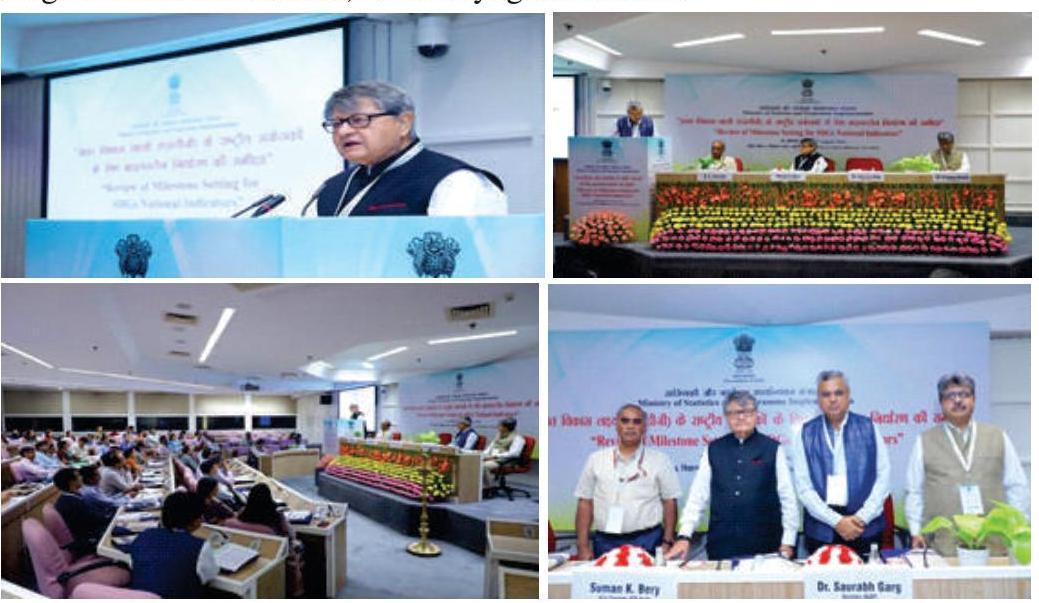
vi. MoSPI entered into a tripartite Memorandum of Understanding (MoU) with UN Resident Coordinator’s Office (UNRCO) and NITI Aayog on ‘Support for Data, Indicators and Statistics for Monitoring Sustainable Development Goals in India’ with effect from 3rd February, 2023 for a period of five years. Under the ambit of the MoU the fourth Meeting of ‘Data for Development Coordination Forum on SDGs’ under the Co-chairpersonship of Director General (Statistics), MoSPI and UNRCO was held on 26th November, 2024 at New Delhi.
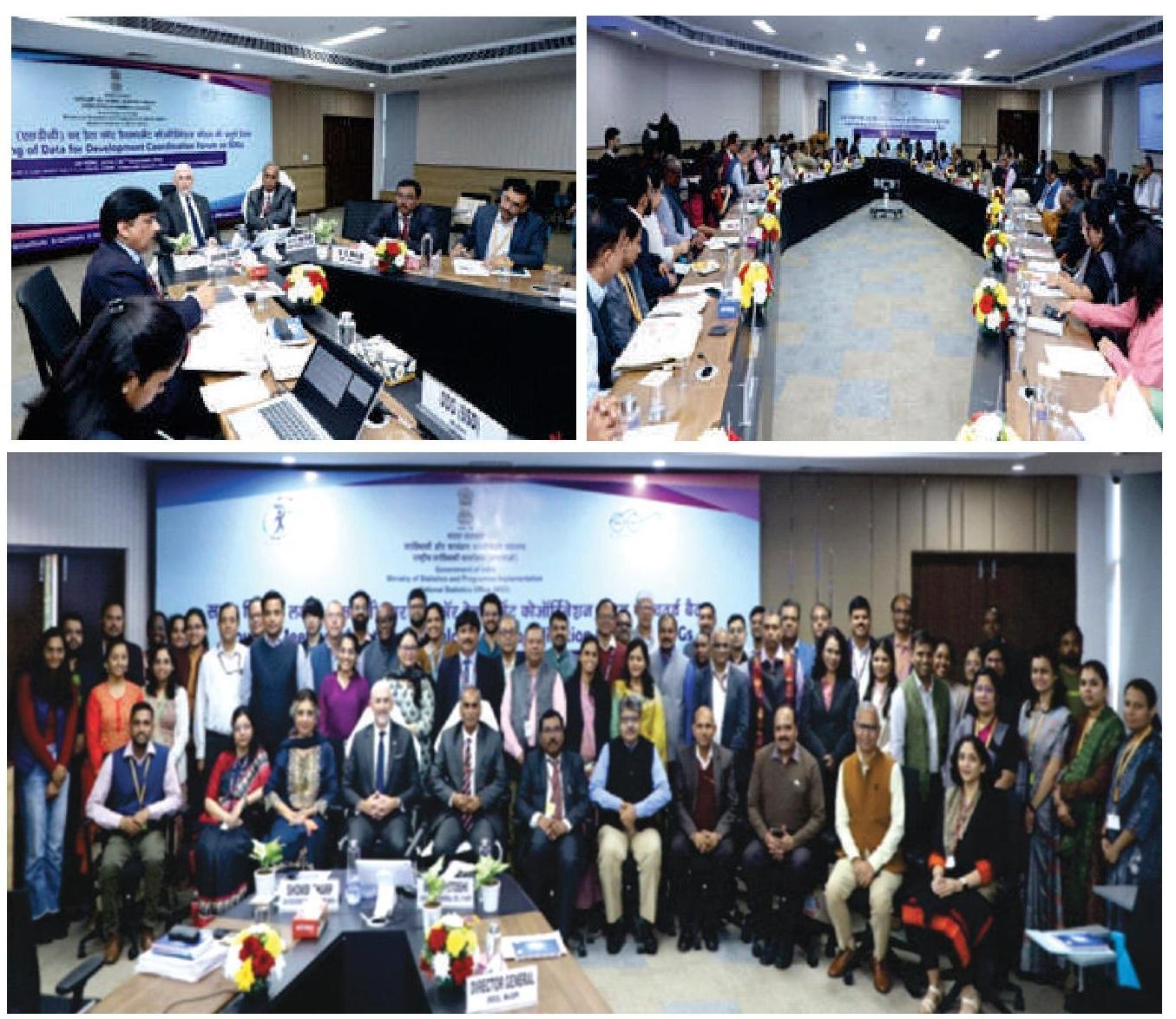
vii. India (through MoSPI) is representing South Asia in the Inter-agency and Expert Group on SDG Indicators (IAEG-SDGs) for the term 2023-2025. The IAEG-SDGs is composed of Member States and including regional and international agencies as observers. The IAEG-SDGs has been tasked to develop and implement the global indicator framework for the Goals and targets of the 2030 Agenda.
2.33 Hon’ble Minister of State (Independent Charge) for the Ministry of Statistics and Programme Implementation (MoSPI), Rao Inderjit Singh released the 25th issue of publication titled “Women and Men in India 2023” on 12th August, 2024 during 28th Conference of Central and State Statistical Organisations (CoCSSO) held during 12-13th August, 2024 at New Delhi.

The annual publication “Women and Men in India 2023” provides gender disaggregated data on various socio-economic aspects including health, education, participation in economy, decision making and impediments in empowerment. The publication also includes chapters on SDGs \& gender, mapping of minimum set of gender indicators as prescribed by IAEG-GS and select success stories of Ministries/Departments of Government of India which improved the lives of women.
Monitoring the Environment
2.34 The activities Ministry in respect of official statistics on environment in India can be classified into two major domains – Environment Statistics \& Environment Accounts. Some of the activities pertaining to the Environment Statistics and Accounts taken up by the Ministry during 2024-25 are highlighted in the following paragraphs.
Environment Statistics
2.35 Continuing its effort to collate and release statistical information on all the aspects of environment, the Ministry released ‘EnviStats India 2024: Environment Statistics’ on 5th June, 2024. The publication is based on Framework on Development of Environment Statistics (FDES 2013) prescribed by UNSD for compilation of environment statistics and provides information on the six fundamental components namely (i) Environmental Conditions and Quality; (ii) Environmental Resources and their use; (iii) Residuals (iv) Extreme Events and Disasters; (v) Human Settlements and Environmental Health; and (vi) Environment Protection, Management and Engagement. This publication is the
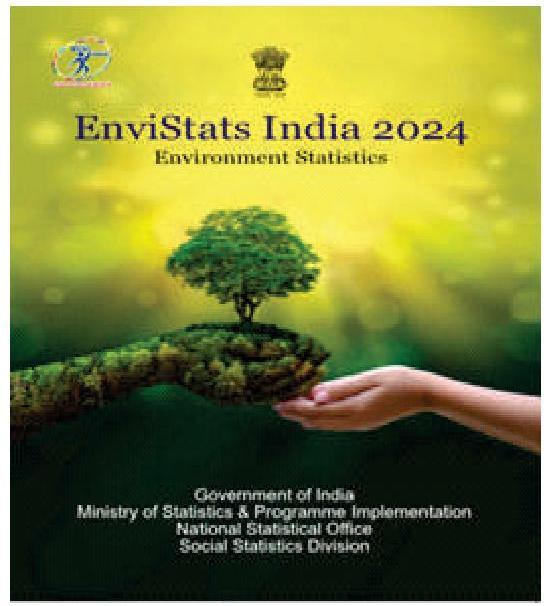
seventh in the series.
Environment Accounts
2.36 In compliance to its mandate and in order to understand the linkages between the environment and the economy, the Ministry has released the 7th consecutive issue of the annual publication on Environment Accounts titled “EnviStats India 2024: Environment Accounts” in September 2024 following the System of EnvironmentalEconomic Accounting Framework (SEEA). The current publication covers new area viz. Ocean Accounts which provides the framework for the compilation of the Ocean Accounts along with data for some of the extent and the condition parameters related to the oceans. The report also provides updated Energy Accounts, Soil Nutrient Index and several other information on Biodiversity such as taxonomic diversity, protected areas and species richness of IUCN Red List of Threatened Species.
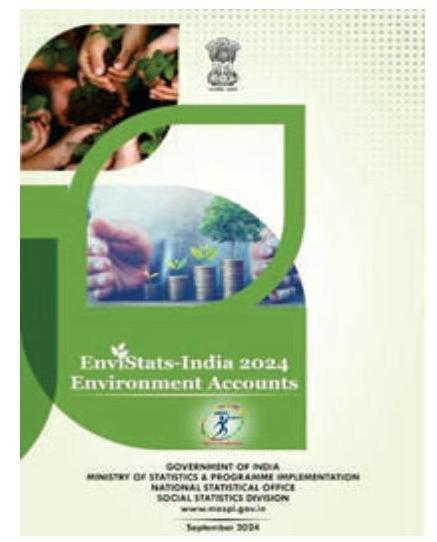
BRICS Activities
2.37 16th Meeting of Heads of BRICS National Statistical Offices (NSO) was held from 28-29th October, 2024 at Kazan, Russia. Dr. Saurabh Garg, Secretary, MoSPI, headed the delegation of NSO, India. Shri N.K. Santoshi, Director General also participated. The meeting focused on enhancing statistical collaboration amongst BRICS nations, paving the way for better data sharing and development strategies.
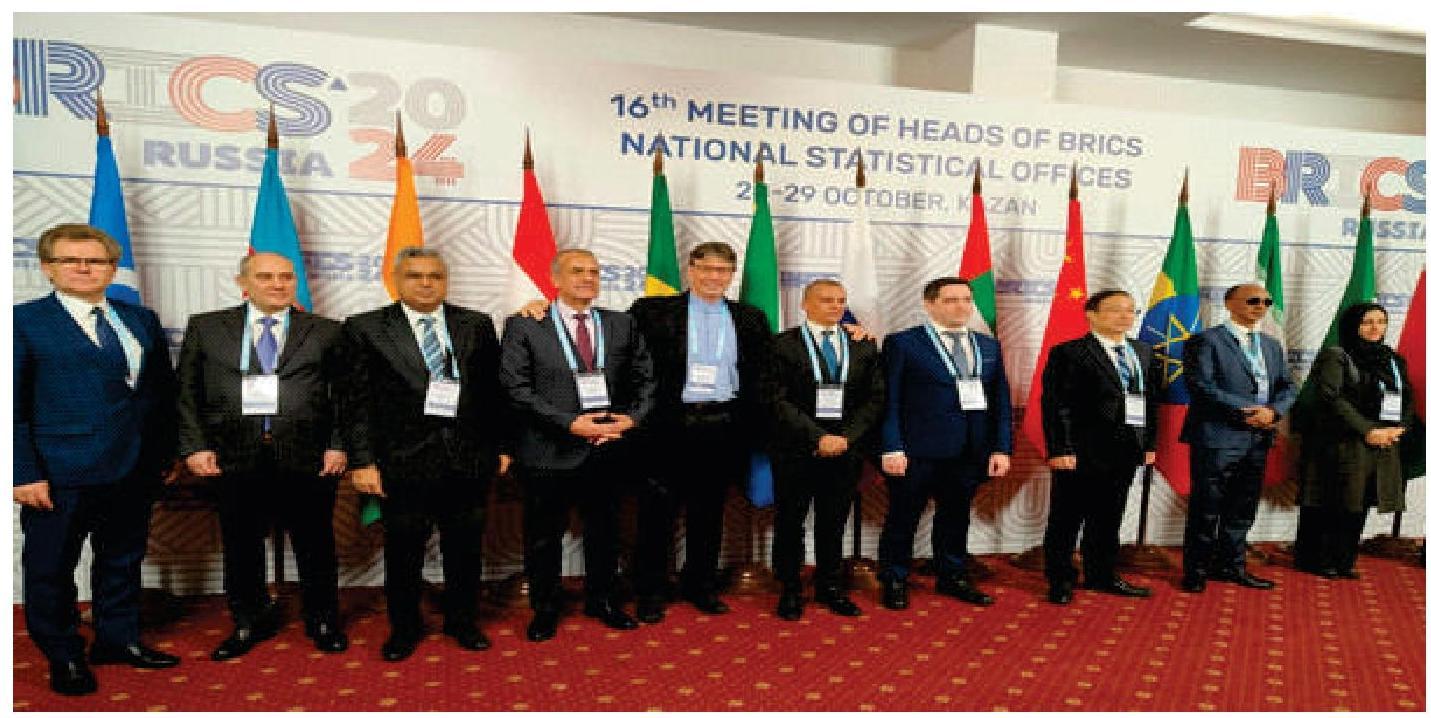
2.38 During the meeting of Heads of BRICS NSOs, each year Joint Statistical publication (JSP) is released by the host country. For providing information in respect of India for BRICS JSP, MoSPI is the nodal Ministry. Accordingly, for bringing out BRICS JSP 2024, MoSPI contributed for providing the data for the publication. To compile the data, MoSPI has coordinated with different ministries/departments. This publication was released in the heads of Meeting of NSO held during the 28-29th October, 2024 at Kazan, Russia.
2.39 During the sideline events of 16th Meeting of Heads of BRICS National Statistical Offices (NSOs) at Kazan, Russia, bilateral meetings took place with Brazil, Russia, South Africa and UAE. As a head of delegation from India, Dr. Saurabh Garg, Secretary, MoSPI along with Shri. N. K Santoshi, Director General (Central Statistics), engaged in productive talks with Heads of NSOs of Brazil, Russia, South Africa and UAE.
Assessing the status of multi-domain statistics
2.40 India is a member of the Inter-Agency and Expert Group on Gender Statistics (IAEG-GS). MoSPI participates in the meetings of the IAEG-GS and other Conferences/Forums on Gender Statistics to understand its development in international scenario and to put forth the India’s viewpoint.
2.41 India is also a member of Washington Group on Disability Statistics which promotes and coordinates international cooperation in the area of health statistics focusing on the development of disability measures suitable for census and national surveys. The major objective of the WG is to provide information on disability that is comparable throughout the world. India has been participating actively in all the activities of the Group.
2.42 MoSPI, in partnership with the host Government of Madhya Pradesh and technical partners UNDP, organized a two-day national workshop in Bhopal on 23rd – 24th January, 2025. This workshop intended to serve as a catalyst for strengthening statistical systems across all administrative levels. It aimed to build capacity at sub-national level on Monitoring Frameworks of Sustainable Development Goals, Compilation of Environment Accounts, and Gender Statistics. The consultation brought together key participants from Central Ministries/Departments and States/ UTs to address crucial aspects of statistical system enhancement and overall SDG monitoring.
Coordination and International Cooperation
2.43 Apart from regular co-ordination activities, major activities undertaken by the Ministry during 2024 are indicated in the succeeding paragraphs.
Statistics Day, 2024
2.44 Statistics Day 2024 was celebrated on 29th June, 2024 with the theme “Use of Data for Decision Making.” The celebration aimed to raise public awareness, especially among the younger generation, about the vital role of statistics in socio-economic planning and policy formulation for national development.
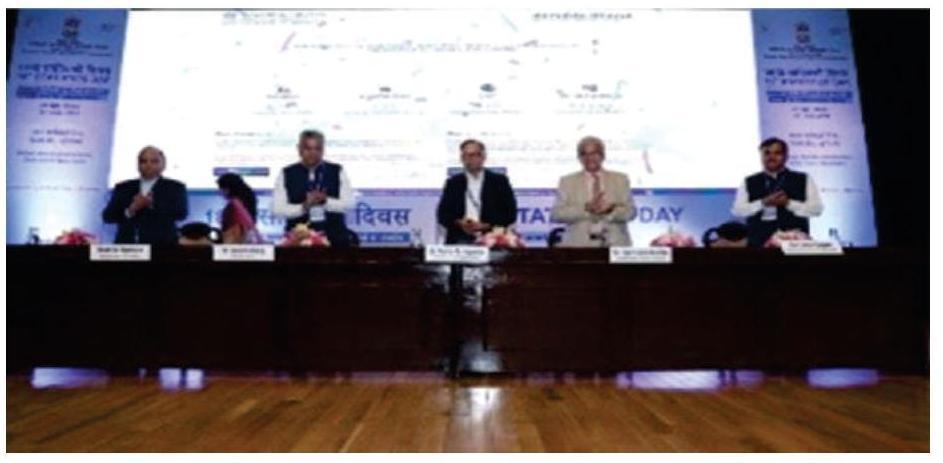
28th Conference of Central and State Statistical Organizations (CoCSSO)
2.45 MoSPI organized the 28th Conference of Central and State Statistical Organizations (CoCSSO) on 12-13th August 2024. The theme of the conference was “Use of Data for Decision Making: Strengthening State Statistical Systems.” This event provided an institutional platform for discussions and improved coordination between Central and State statistical organizations, aiming to enhance the efficiency of the Indian Statistical System through a collaborative approach. The conference was attended by representatives from over 30 Central Ministries/ Departments, 29 State/UT Governments, and esteemed organizations such as the Reserve Bank of India (RBI), Indian Statistical Institute (ISI), Council of Scientific and Industrial Research (CSIR), Indian Agricultural Statistics Research Institute (IASRI), and Indian Council of Agricultural Research (ICAR). International organizations, including the World Bank and UN agencies, as well as stakeholders such as the PHD Chamber of Commerce and Industry (PHDCCI), also participated.

Formalization of the Roles and Responsibilities of Statistical Advisers (Sas)
2.46 To strengthen the institutional mechanism of statistical coordination with various Ministries/Departments, MoSPI delineated the roles and responsibilities of Statistical Advisers in all Central Ministries on 16th August, 2024. This initiative aims to improve statistical coordination between MoSPI and other Ministries/Departments, thereby enhancing the National Statistical System. Two workshops were organized to sensitize Statistical Advisers and Senior Indian Statistical Service (ISS) officers on 29th August, 2024 and 23rd December, 2024, respectively. These workshops served as platforms for feedback and capacity-building discussions.
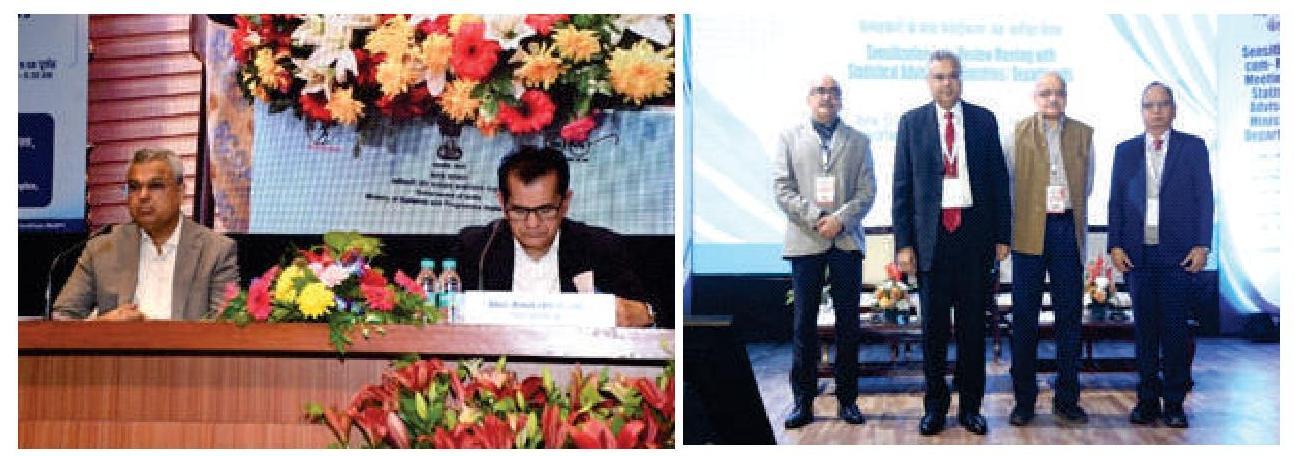
Amendments to the Collection of Statistics (CoS) Act, 2008
2.47 The Collection of Statistics (CoS) Act, 2008 has been decriminalized through the Jan Vishwas (Amendment of Provisions) Act, 2023 and same has come into force on 10th December, 2024. Following this, on 11th December, 2024, MoSPI notified the Collection of Statistics Rules, 2024, to facilitate the implementation of the amended CoS Act, 2008.
Participation in UNSIAP Governing Council meeting
2.48 Dr. Saurabh Garg, Secretary of MoSPI, chaired the 20th session of the Governing Council of the United Nations Statistical Institute for Asia and the Pacific (UN-SIAP), during 910th December, 2024 in Bangkok. UN-SIAP is a regional training arm of the Economic and Social Commission for Asia and Pacific.
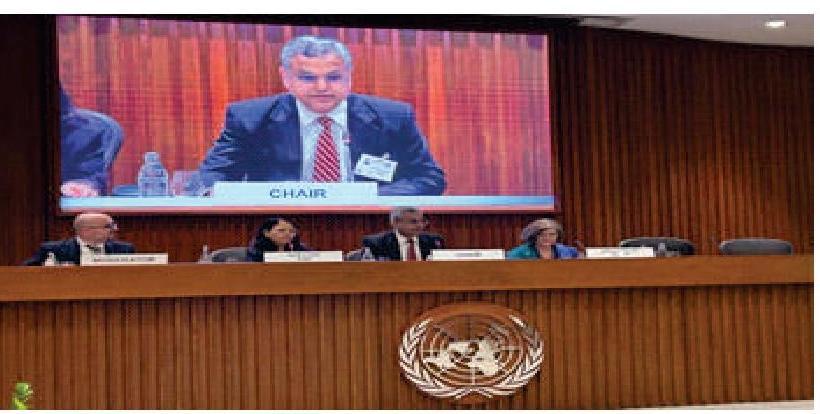
Chapter 3
National Sample Surveys
3.1 The National Sample Survey (NSS) of MoSPI is responsible for conducting large scale sample surveys in diverse fields on all India basis. NSS functions with requisite autonomy in matters relating to data collection, processing and publication/dissemination of results/data based on its surveys. Director General (NSS) is responsible for overall coordination and supervision of all activities of, NSS, who is assisted by four Additional Director Generals, each one
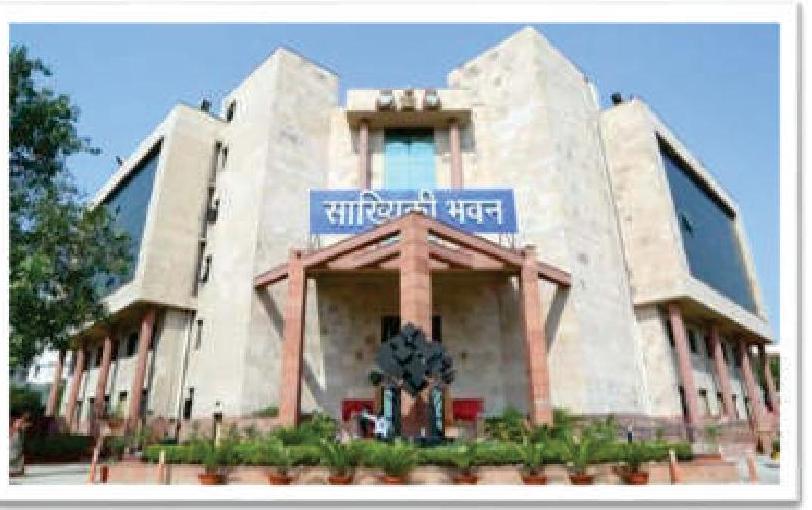
being in-charge of a separate Division responsible for distinct aspects of large-scale surveys viz. household surveys, enterprise surveys, fieldwork/data collection and coordination between different Divisions of NSO along with quality control.
Divisions of NSS
3.2 Coordination and Quality Control Division (C\&QCD) [erstwhile Survey Coordination Division (SCD)]: This Division headed by an ADG level officer and located at New Delhi, with a network of 6 Zonal Offices, is responsible for proper monitoring \& maintaining the quality of the National Sample Surveys and also coordinates the technical as well as administrative activities of different Divisions of NSS viz., HSD, EnSD and FOD and also functions as Secretariat to DG(NSS). It also brings out the bi-annual journal of NSS, titled “Sarvekshana”, and organizes National Seminars on the results of various socioeconomic surveys undertaken by NSS. Besides, C\&QCD acts as a nodal point for all Inter Ministerial consultations, Cabinet Notes, Legislation and Bills, etc. with respect to NSS. It is also responsible for overall coordination of Court Cases of NSS and the Parliament Matters/Parliament Questions related to surveys of NSS. C\&QCD conducts Data User Conferences after release of results of NSS surveys with an aim to engage stakeholders and enhance understanding of the survey’s findings, focusing on data access, interpretation, user concerns and survey methodology.
3.3 Household Survey Division (HSD) [erstwhile Survey Design and Research Division (SDRD)]:
This Division, located at Kolkata, is headed by ADG level officer and is responsible for conceptualizing, designing, processing, analysing and ultimately publishing survey results of household surveys. HSD has two Household Survey Units (HSUs) located outside Kolkata at Bengaluru and Nagpur. HSD also assists the States through training/workshops or other interactive methods as per requirements. Following surveys are covered under HSD:
a. Household Consumption Expenditure Survey (HCES)
b. Land Holding Survey (LHS)
c. Situation Assessment Survey (SAS)
d. Surveys on Health
e. Periodic Labour Force Survey (PLFS)
f. Time Use Survey (TUS)
g. Survey on Migration
h. NSS Rounds
i. Rural Price Collection (RPC)
3.4 Field Operations Division (FOD): The Division headed by an ADG level officer, with its headquarters at Delhi and a network of 52 Regional Offices and 117 Sub-Regional Offices spread throughout the country, is responsible for the collection of primary data for the surveys undertaken by MoSPI. The Agricultural Statistics Wing of FOD, headquartered at Faridabad, is entrusted with the responsibility of providing technical guidance and assistance to the States in developing suitable survey techniques for obtaining timely and reliable estimates of crop area and yield, and imparting training to State field personnel.
3.5 Enterprise Survey Division (EnSD): The Division is formed merging the erstwhile Data Processing Division (DPD) and Industrial Statistics (IS) Wing of CSO. This Division, located at Kolkata, is headed by ADG level officer and is responsible for technical planning of enterprise surveys, formulation of sample design, sample selection, designing of enquiry schedules, formulation of concepts and definitions, development of digital platform including CAPI, software development and data processing, ensuring survey data quality \& tabulation of the data, analysis and presentation of results and preparation of survey reports, collected through enterprise surveys. It also assists the States in providing IT solutions for their data processing related activities for the enterprise surveys, as also through periodic training/workshop and other interactive methods. It has three Enterprise Survey Units (EnSU) at Ahmedabad, Delhi and Giridih. Following surveys are covered under EnSD:
i. Annual Survey of Unincorporated Sector Enterprises (ASUSE)
ii. Annual Survey of Industries (ASI)
iii. Annual Survey of Services Sector Enterprises (ASSSE),
iv. Forward Looking Survey on Private Corporate Sector CAPEX Investment Intentions
v. Ad-hoc Surveys/ Short term surveys
Technical Advisory Group (TAG)
3.6 TAG for household surveys: The Technical Advisory Group (TAG) for household surveys has been constituted on 30th August, 2024 for advising on technical issues pertaining to household surveys. The present TAG is constituted under the chairpersonship of Prof. Bimal Kumar Roy, Former Professor, ISI, Kolkata. The Advisory Group has held several meetings to discuss various aspects of household surveys.
3.7 TAG for enterprise surveys: The Technical Advisory Group (TAG) for enterprise surveys has been constituted on 30th August, 2024 for advising on technical issues pertaining to enterprise surveys. The present TAG is constituted under the chairpersonship of Dr. Biswanath Goldar, Retd. Professor, IEG, Delhi. The Advisory Group has held several meetings to discuss various aspects of enterprise surveys.
Steering Committee for National Sample Surveys
3.8 For the purpose of reviewing the framework and to address the issues raised from time to time on the subject, results, methodology, questionnaire, etc. of all National Sample Surveys conducted by MoSPI, it has constituted the Steering Committee for National Sample Surveys (NSS) on 3rd April, 2024 under the
Chairpersonship of Prof. Rajeeva Laxman Karandikar, Chairman, NSC. The Steering Committee makes recommendations to NSC by reviewing the survey methodology including questionnaire, sampling frame, sampling design, concepts and definitions, survey instruments of national sample surveys. The committee is also mandated to examine the issues or any other matter raised from time to time on the survey methodology related to all surveys conducted by NSS of MoSPI or external entities as brought before the Steering Committee. The committee can suggest conduct of pilot surveys/pre-testing of survey instruments as and when required.
Surveys conducted by NSS, MoSPI
Socio-Economic Survey
3.9 NSS 79th round: The 79th Round of NSS (July, 2022 – June, 2023) was devoted to the following subjects:
(i) Comprehensive Annual Modular Survey (CAMS): The objective of CAMS was to collect information required for the purpose of generating some selected indicators and sub-indicators of the SDG Global Indicator Framework.
(ii) Survey on AYUSH: The first exclusive all-India survey on ‘AYUSH’ was conducted by the NSO as part of the 79th round of NSS. The primary objectives of the survey were to collect information on the awareness of the households and/or individuals and the usage of the AYUSH system of medicine by them.
3.10 Data for the central sample of the NSS 79th round was collected using the Computer Assisted Personal Interview (CAPI) method on the eSIGMA platform. The Factsheet on AYUSH, 2022-23 was released in June, 2024 and the report of Comprehensive Annual Modular Survey, 2022-23 was released in October, 2024.
3.11 NSS 80th round: The NSS 80th round survey covering subjects of Household Social Consumption: Health and Comprehensive Modular Survey (CMS)- Telecom is scheduled to commence from 1st January, 2025. An All India Workshop of Trainers for NSS 80th round was held on 10-11th December, 2024 at Delhi having participants from NSO Divisions, participating Ministries and States.

Glimpses of All India Workshop of Trainers for NSS 80th round
State Assistance for Socio-Economic Surveys
3.12 States also participate in NSS surveys. EnSD has always leveraged its expertise to facilitate States in knowledge sharing and technical assistance towards its endeavor. EnSD provides technical guidance to the States by supplying data processing instruments (including sample list, software for data entry, validation and tabulation), thereby providing help in processing the state sample data and also in pooling of central and state sample data through organizing Tabulation and Pooling Workshops.
3.13 A Tabulation Workshop on central and State sample data of NSS 78th round for the officials from 27 Directorate of Economics and Statistics was organised by EnSD (erstwhile DPD) during 19th – 21st March, 2024. In the workshops, theoretical and hands on training was imparted. Specialized need-based training for states is also arranged by EnSD as and when requested by the State DES.
3.14 A Data processing workshop on Household Consumption Expenditure Survey (HCES), 2023-24 was organised during 21st-22nd February, 2024 at Data Processing (DPD) Headquarters, Kolkata. Data Processing Centre (DPC), Nagpur and DPC, Delhi involved in processing of the HCES data, participated in the Workshop. Similar workshop was organized for ASUSE survey.
Household Consumption Expenditure Survey (HCES)
3.15 Two consecutive Household Consumption Expenditure Surveys (HCES) were conducted for the periods August, 2022 – July, 2023 and August, 2023 – July, 2024. The primary objective of these surveys was to generate estimates of Monthly Per Capita Consumption Expenditure (MPCE) and its distribution, separately for rural and urban sectors across the country. The factsheet for HCES 2022-23 was published in February, 2024, followed by the release of a detailed report in June, 2024. The factsheet for HCES 2023-24 was published on 27th December, 2024.
Time Use Survey (TUS)
3.16 Time Use Survey (TUS) is designed to measure time dispositions by the population on different activities. The survey is an important source of information on the time spent in unpaid caregiving activities, unpaid volunteer work, unpaid domestic service-producing activities of the household members. In India, the first ‘Time Use Survey’ was conducted by NSO during January – December, 2019. The fieldwork of the second ‘Time Use Survey’ (January – December, 2024) commenced on 1st January, 2024. Data collection is being carried out digitally using the Computer Assisted Personal Interview (CAPI) on hand-held devices.
Periodic Labour Force Survey (PLFS)
3.17 The nationwide Periodic Labour Force Survey (PLFS) was launched from April, 2017. The objective of PLFS is primarily two-fold viz. (i) to measure the labour force indicators in the short time interval of three months for the urban areas only in the Current Weekly Status (CWS) and (ii) to generate estimates of all important labour force parameters in both usual status (principal status as well as subsidiary status) and CWS annually for both rural and urban areas and quarterly for urban areas.
3.18 The Annual Report of PLFS, 2023-24 was released in September, 2024. The time lag to release the Quarterly Bulletins has been reduced significantly to less than two months from the completion of
fieldwork. In addition to the Annual Report, three Quarterly Bulletins upto July-September 2024 have also been released during 2023-24.
3.19 The next panel of PLFS (i.e. PLFS 2025-26) will commence from January, 2025 in which it is proposed to generate: a) monthly estimates at all India level, b) quarterly estimates for all India and at State/UT level, and c) annual estimates at all India, State/UTs and districts, of employment-unemployment indicators [Labour Force Participation Rate (LFPR), Worker Population Ratio (WPR), Unemployment Rate (UR)] separately for rural and urban sectors. The updated panel will remain unaltered till December, 2026.
Annual Survey of Unincorporated Sector Enterprises (ASUSE)
3.20 The ASUSE 2023-24 has been launched from October, 2023 using CAPI method on e -SIGMA platform covering establishments of unincorporated non-agricultural sector belonging to manufacturing, trade and other services in rural and urban areas of India. The major objective of this survey is to estimate the key operational and economic characteristic pertaining to unincorporated non-agricultural sector ASUSE 2023-24 is completed in September, 2024. Factsheets of Annual Survey of Unincorporated Sector Enterprises (ASUSE) 2021-22 and 2022-23 were released on 14th June, 2024. ASUSE reports namely, Operational and Economic Characteristics; along with microdata for the years 2021-22 and 2022-23 were released on 5th July, 2024. Field work for ASUSE 2025 will be commenced from January, 2025.
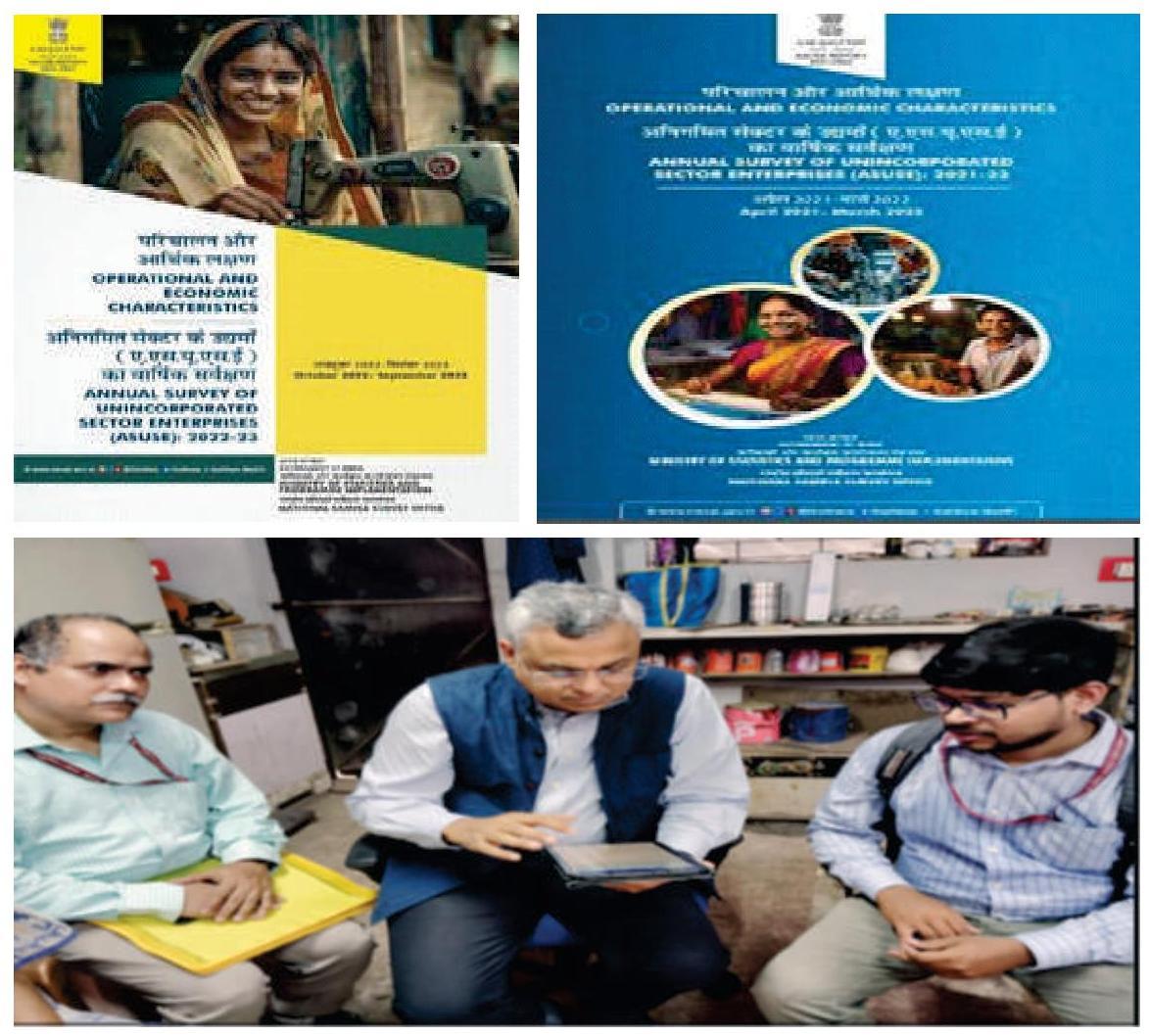
Inspection of ASUSE Fieldwork in RO Kolkata by Secretary, MoSPI
Annual Survey of Service Sector Enterprises (ASSSE)
3.21 Annual Survey of Service Sector Enterprises (ASSSE) has been conceived to estimate key characteristics, such as, Gross Value Added (GVA), Fixed capital, Capital formation, number of persons engaged, etc. pertaining to the all-important corporate services sector of the country. The survey also aims to bridge the data-gap of non-availability of comprehensive database of the services sector of Indian economy. The GSTN database has been used as sampling frame for this survey. A pilot study on ASSSE, comprising of around 10,000 enterprises, randomly selected from GSTN frame is currently underway.
Annual Survey of Industries (ASI)
3.22 The Annual Survey of Industries (ASI) is the principal source of industrial statistics in India. It provides statistical information to assess and evaluate, objectively and realistically, the changes in the growth, composition and structure of the organized manufacturing sector comprising activities related to manufacturing processes, repair services, generation, transmission, etc. of electricity, gas, water supply and cold storage. The survey is statutory in nature under the Collection of Statistics Act, 2008 and the rules framed there under.
3.23 The ASI extends to the entire country. The survey covers all factories registered under sections 2 m (i) and 2 m (ii) of the Factories Act, 1948. The survey also covers bidi and cigar manufacturing establishments registered under the Bidi \& Cigar Workers (Conditions of Employment) Act, 1966. All the electricity undertakings engaged in the generation, transmission and distribution of electricity registered with the Central Electricity Authority (CEA) were covered under ASI up to 1997-98 irrespective of their employment size. Certain services and activities like cold storage, water supply, repair of motor vehicles and other consumer durables like watches, etc. are also covered under the survey. Defense establishments, oil storage and distribution depots, restaurants, hotels, cafe, computer services and the technical training institutes are excluded from the purview of this survey. The electricity undertakings registered with the CEA are not being covered under ASI w.e.f. 1998-99. However, electricity undertakings not registered with the Central Electricity Authority (CEA) continue to be covered under ASI.
3.24 In addition to the above, the coverage of ASI has now been extended beyond the purview of the section 2 m (i) and 2 m (ii) of the Factories Act, 1948 and the Bidi \& Cigar Workers (Conditions of Employment) Act, 1966 as recommended by the Sub-Group on Sampling Design of ASI. For this purpose, Business Register of Enterprises (BRE) prepared by the respective states and Directory of Establishments based on Sixth Economic Census would be used by EnSD.
3.25 To start with the implementation of the augmented frame, units with 100 or more employees not registered under Sections 2m (i) and 2m (ii) of the Factories Act, 1948, but included in the BRE of the respective states would be included in ASI frame. For this, BRE of Andhra Pradesh was included in the frame of Andhra Pradesh for ASI 2014-15, BRE of Manipur, Chhattisgarh, Himachal Pradesh, Punjab, Uttar Pradesh, Tamil Nadu and Rajasthan were included in the frame of respective states for ASI 2015-16 and BRE of Gujarat, Karnataka, Kerala, Rajasthan, Telangana, and Uttar Pradesh were included in the frame of respective states for ASI 2017-18 after verification of such units by FOD. This is a significant departure from past practices and it is an improvement in coverage of registered manufacturing sector.
3.26 The data collected through ASI relates to capital, employment and emoluments, consumption of fuel and lubricants, raw materials and other input/output, value added, labour turnover and other characteristics of factories/industrial establishments. Fieldwork for central sample is carried out by the FOD. The EnSD (erstwhile IS Wing) processes the data and publishes the results. The field work of ASI 2023-24 has commenced from September, 2024.
3.27 Final results of ASI 2022-23 (Volume I and Summary Results for Factory Sector) have been released on website of the Ministry in October, 2024. ASI publications (Volume I and Summary Results for Factory Sector) \& unit level data are available on the website of the Ministry viz. www.mospi.gov.in. These publications are freely available to users in electronic media and can be downloaded from the Ministry’s website.
State Participation in ASI
3.28 The State Directorates of Economics and Statistics (DESs) have been given necessary technical assistance and training for the purposes of participation in ASI. The participating States along with other desiring States have been provided with State sample list to take part in ASI survey work. EnSD has provided all the survey and data processing instruments [sample list, schedule, instruction manual, data entry package (e-schedule), validation rules, validation software, pooling methodology, etc.] to the States. Central sample unit level data for respective states were also shared with the State DESs along with Tabulation Software so as to enable them to generate district/micro level estimates, if necessary, by augmenting samples.
3.29 In the recent past many changes have been made for improvements in the collection, processing and dissemination of ASI data. Over the last few decades, there has been a spurt in the growth of the number of registered factories and consequently in the number of units from which data are to be collected and analyzed annually. In ASI 2023-24, 83620 units comprising 63981 census units and 19639 sample units have been selected for the survey. Starting from ASI 2012-13, the survey is being conducted through ASI web-portal.
Glimpses of ASI Results
3.30 The final results of ASI 2022-23 (Volume I, Volume II and Summary Results for Factory Sector) were released in October, 2024. ASI 2022-23 covered the entire country. The field work for ASI 2022-23 was carried out during the period from November, 2023 to June, 2024 throughout the country with reference period coinciding with the fiscal year 2022-23. Some of the highlights of the results of ASI 202223 are given below:
i. During 2022-23, the estimated number of factories was 2,53,334
ii. More than 184 lakh persons were engaged by these factories.
iii. All the factories together had invested capital worth $061,39,213$ crore.
iv. Total net value added by the factories was $018,80,411$ crore
The comparative statements regarding the Principal Characteristics of Industries as covered under ASI, are given below:
| Characteristics | Unit | 2018-19 | 2019-20 | 2020-21 | 2021-22 | 2022-23 |
|---|---|---|---|---|---|---|
| Factories | Number | 242395 | 246504 | 250454 | 249987 | 253334 |
| Fixed Capital | $\square$ Lakh | 346606975 | 364135165 | 369438562 | 372635444 | 412179458 |
| Productive Capital | $\square$ Lakh | 427473434 | 452465244 | 480347637 | 507944093 | 571738389 |
| Invested Capital | $\square$ Lakh | 477726474 | 497362352 | 51911431055 | 4493175 | 613921255 |
| Workers | Number | 12798588 | 13058156 | 12594563 | 13609931 | 14616971 |
| Employees | Number | 16212214 | 16568527 | 16025118 | 17151172 | 18433126 |
| Wages to Workers | $\square$ Lakh | 21576035 | 22890520 | 22261548 | 26455930 | 29990380 |
| Emoluments | $\square$ Lakh | 46207983 | 49172897 | 48389031 | 56082801 | 64049070 |
| Total input | $\square$ Lakh | 774377980 | 749755617 | 719206541 | 987917996 | 228954623 |
| Output | $\square$ Lakh | 928179908 | 898330129 | 88092138711 | 92715147 | 1448660228 |
| Depreciation | $\square$ Lakh | 26155291 | 27309742 | 28135986 | 29964685 | 31664493 |
| Net value added | $\square$ Lakh | 127646637 | 121264771 | 13357886017 | 4832466 | 188041113 |
| NFCF | $\square$ Lakh | 8310576 | 14361795 | 3225819 | 3042540 | 26822800 |
| Net Income | $\square$ Lakh | 107790378 | 102243476 | 11574771415 | 7994016 | 169282621 |
| Rent paid | $\square$ Lakh | 512545 | 471423 | 481328 | 506211 | 565777 |
| Interest paid | $\square$ Lakh | 19343714 | 18549872 | 17349819 | 16332239 | 18192715 |
| Profit | $\square$ Lakh | 55652258 | 46947269 | 61405752 | 95071368 | 97634628 |
ASI Web-Portal
3.31 Annual Survey of Industries Web-Portal was developed by Industrial Statistical Wing, Kolkata with the support of NIC for collection and compilation of ASI schedules. The main objective of the portal is collection of ASI data at the source with in-built validation which leads to data accuracy and time saving. The $24 \times 7$ availability in a secured environment is an added
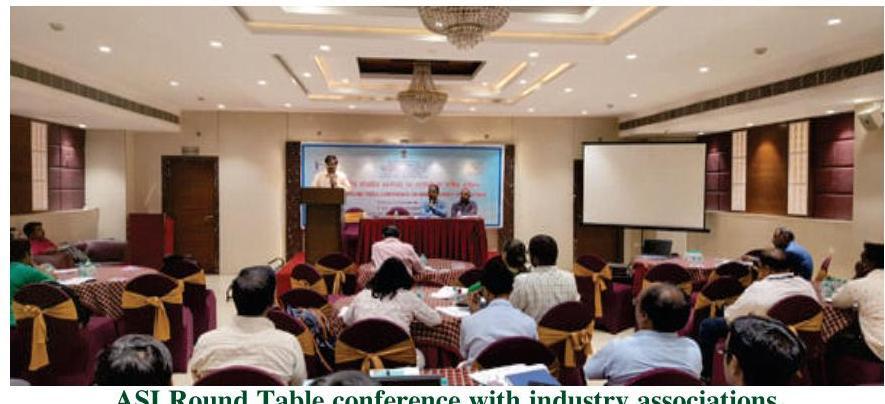
ASI Round Table conference with industry associations, conducted by RO Vijayawada
advantage. The vision is to deliver ASI data in a timely, transparent and reliable manner in a secured environment without any physical movement of the schedules. The ASI web-portal was successfully launched for frame updation, sample selection and e-compilation of ASI schedule from ASI 2012-13 to ASI 2018-19. From ASI 2019-20, ASI web-portal was developed as part of e-SIGMA project of NSS and the same is being utilised since then.
Forward-Looking Survey on Private Corporate Sector Capex Investment Intentions
3.32 The primary objective of Forward-Looking Survey on Private Corporate Sector Capex Investment Intentions is to measure capital investment intentions of private corporate sector covering non-financial and financial corporation through collection of information from major resident enterprises on:
i. Capital Expenditure incurred during last three financial years,
ii. Capital Expenditure incurred or to be incurred during the current and forthcoming financial years on different asset groups and industries
Data collected in this survey will help to assess the expected investment to be made by the enterprises for two consecutive financial years (namely, 2024-25 and 2025-26). Also, it will provide an indication of preferred industries / sectors where major investment is likely to be made in the coming years.
Agricultural Statistics
3.33 The Agricultural Statistics (AS) Wing of FOD implements ‘Improvement of Crop Statistics Scheme (ICS)’ and assists State governments in identifying deficiencies in their system of collection of area data and yield rate estimates of various crops. Under ICS Scheme, sample check on the area enumeration work done by State primary workers and sample supervision of crop cutting experiments conducted by primary workers for estimating yield rate is conducted with a view to identifying the deficiencies in the system. The status report on ICS Scheme is presented to the State governments.
3.34 Under the scheme, sample check on the primary field work relating to area enumeration in 13967 (6209 for Kharif Season and 7758 for Rabi/Summer Season) sample villages in an agriculture year and supervision of 31324 (15662 for Central and State sample each) crop cutting experiments in each agricultural year are undertaken. The State Agricultural Statistics Authority (SASAs) of State governments also carry out sample check on area aggregation of 5349 villages of state sample to bolster data on area statistics in Sch. AS 1.1. The data collected through the supervision of crop cutting experiments at harvest stage are also utilised to compute 223 estimates (Central and State sample each) of yield rate of specified crops under the ICS scheme. The estimates are also tapped, among other sources, by DES, M/o Agriculture \& Farmers Welfare in preparation of the advance estimates.
3.35 AS Wing of NSO (FOD) provides feedback and advice on methodology and procedural issues related to Crop Cutting Experiments (CCEs) under the flagship programme of Pradhan Mantri Fasal Bima Yojana (PMFBY). PMFBY provides comprehensive insurance cover against failure of the crop thus helping in stabilising the income of the farmers. AS Wing of NSO (FOD) also provides expert advice to Mahalanobis National Crop Forecasting Centre (MNCFC) in its pilot and roll-out study of Smart sampling techniques spearheaded by MNCFC for direct yield estimation with the help of remote sensing, weather indices, agro-meteorological parameters and Ground Truthing.
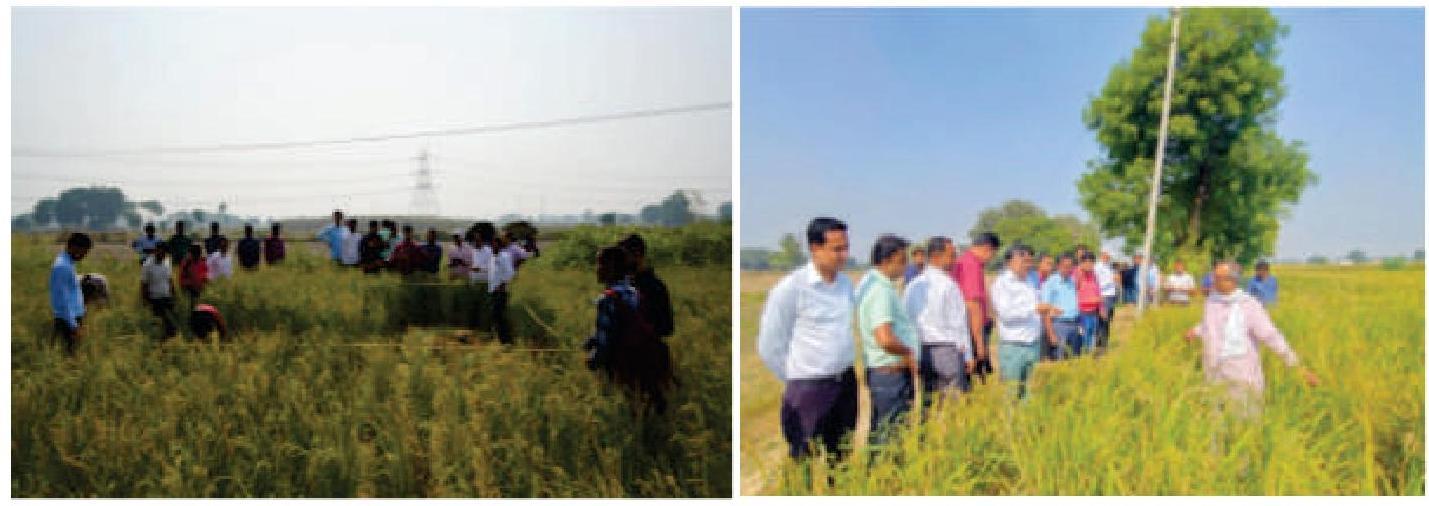
Demonstration of supervision of crop cutting experiments (AS 2.0) to the third batch of trainees in Agricultural Statistics for South Zone, held at AS Wing, Faridabad in October, 2024
Urban Frame Survey (UFS)
3.36 Urban Frame Survey (UFS) is conducted in a phase of 5 years by Field Operations Division (FOD) of NSO, MoSPI for formation and updation of UFS blocks in towns for providing frame for selection of first stage sampling units in urban sector for use in various socio-economic surveys of NSS. Currently, the survey work of phase 2022-27 (July 2022-June 2027) is going on in digital mode using software support from National Remote Sensing Centre (NRSC). The latest UFS metadata with UFS Frame for updation on the MoSPI website has been provided by Household Survey Division (HSD).
Price Data
Consumer Price Index for Agricultural Labour \& Rural Labour [CPI (AL/RL)]:
3.37 FOD collects monthly rural retail price data for the compilation of Consumer Price Index (CPI) for Agricultural and Rural Labourers (AL/RL). Along with the price data for about 260 items, the daily wage rates of 12 major agricultural and 13 major non-agricultural occupations are also being collected in the Schedule-3.01 (R). The Labour Bureau, Chandigarh under the Ministry of Labour and Employment compiles and publishes the index figures of CPI (AL/RL), which is released every month (20th or preceding working day of the following month) for each of the states as well as at all India level. The current base year for CPI (AL/RL) is $1986-87=100$. Data for RPC is collected from 603 villages every month spread across 36 States/UTs and transmitted to the Labour Bureau, Chandigarh. In addition, price collection from 782 rural samples for new series is also being done by the field offices on a monthly basis.
Consumer Price Index (Urban):
3.38 Consumer Price Index (CPI) for Urban Areas measures the changes over time in the general level of retail prices of goods and services for the purpose of consumption relevant to the entire urban population in the country that households acquire. The price collection under CPI (U) started from May, 2008 by FOD of NSO on behalf of Price Statistics Division (PSD), NSO. The current base year for CPI (U) is $2012=100$. Price data collection is done for 1078 quotations per month from 310 towns across the country. Additionally, fieldwork has been conducted in 36 urban markets by DES. Collection/transmission of monthly retail prices in the urban prices portal of CPI (U) is being done regularly by FOD.
Consumer Price Index (Rural):
3.39 FOD is entrusted with the work of CPI (Rural) from September, 2018 after the handover of task from the Department of Posts (DoP). The base year of CPI (Rural) is same as that of CPI (Urban), i.e., $2012=100$. Price data collection is being carried out from the markets located in 1176 villages across the country. Additionally, fieldwork in 5 rural markets is conducted by DES. Collection/ transmission of monthly retail prices in the rural prices portal of CPI (R) is being done regularly by the field offices of FOD.
Base Revision of CPI (U/R):
3.40 Presently, base year for CPI (U) and CPI (R) is 2012 and NSO, MoSPI is in the process of revising the base year of both series from 2012 to 2024. For this, the market survey exercise for fixing shops and item specifications was carried out during September, 2023- December 2023 and the base price collection has been started from 15th January, 2024. The final sample size for the revised series is 1389 urban markets across 435 towns and 1461 rural markets. Additionally, fieldwork in 6 Urban markets and 4 rural markets is being conducted by DES.
Wholesale Price Index (WPI) (Base Year 2011-12):
3.41 The Office of the Economic Adviser is responsible for compiling and releasing monthly WPI data. Data collection/transmission activities for 6765 quotations on monthly basis covering 5905 manufacturing units/factories from organised sector is being facilitated by FOD) on behalf of the Office of the Economic Advisor in the Department for Promotion of Industry and Internal Trade (DPIIT), Ministry of Commerce \& Industry for WPI.
Base Year Revision of WPI:
3.42 Backlog price collection for 5507 quotations per month is being collected from April, 2017 onwards in addition to the current WPI series for base revision of WPI (Base Year 2017-18).
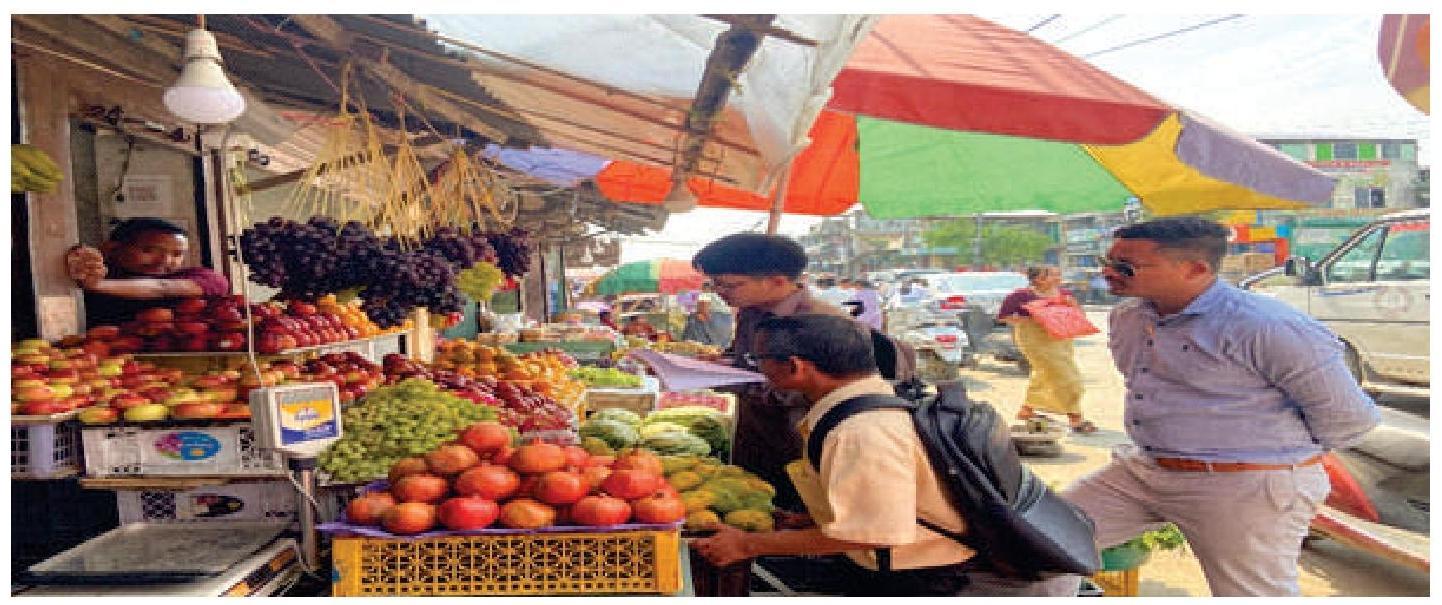
Collection of CPI data at RO Imphal
Forthcoming surveys of NSS, MoSPI:
3.43 Along with the ongoing surveys such as PLFS, ASI, HCES, TUS, CAPEX, ASUSE in year 2024, the following surveys have been planned to be undertaken by NSS, MoSPI in the upcoming year 2025:
i. NSS 80th Round:
- Survey on Social Consumption- Health (Jan. to Dec., 2025)
- Comprehensive Modular Survey-Telecom and ICT skill (Jan. to Mar., 2025)
- Comprehensive Modular Survey-Education (April to June, 2025);
ii. Periodic Labour Force Survey (PLFS) (Jan. – Dec., 2025)
iii. Annual Survey on Unincorporated Sector Enterprises (ASUSE) (Jan. – Dec., 2025)
Upgradation/augmentation of infrastructure in field offices
3.44 The infrastructure in the field offices of the FOD is being regularly developed and strengthened. During FY 2023-24, various works have been undertaken including repairing and upgradation work of NSO (FOD) Hostel, Guwahati, renovation of office building of Regional Office Hyderabad \& SubRegional Office (SRO) Faridabad, installation of lift at RO Hubli, construction of boundary wall around the plot of SRO Udhampur and Kakinada, etc.
3.45 During FY 2024-25, one acre land at a cost of $\mathbb{I} 1 /-$ has been purchased for construction of office building of SRO Visakhapatnam. Additionally, various works have been started including construction of office building of SRO Kakinada on 0.3 acre land purchased from State government, construction of 3rd floor of the existing NSO(FOD) building at RO Ahmedabad, construction of office building of SRO Tirunelveli, upgradation of Agricultural Statistics Wing, Faridabad, renovation of hostel
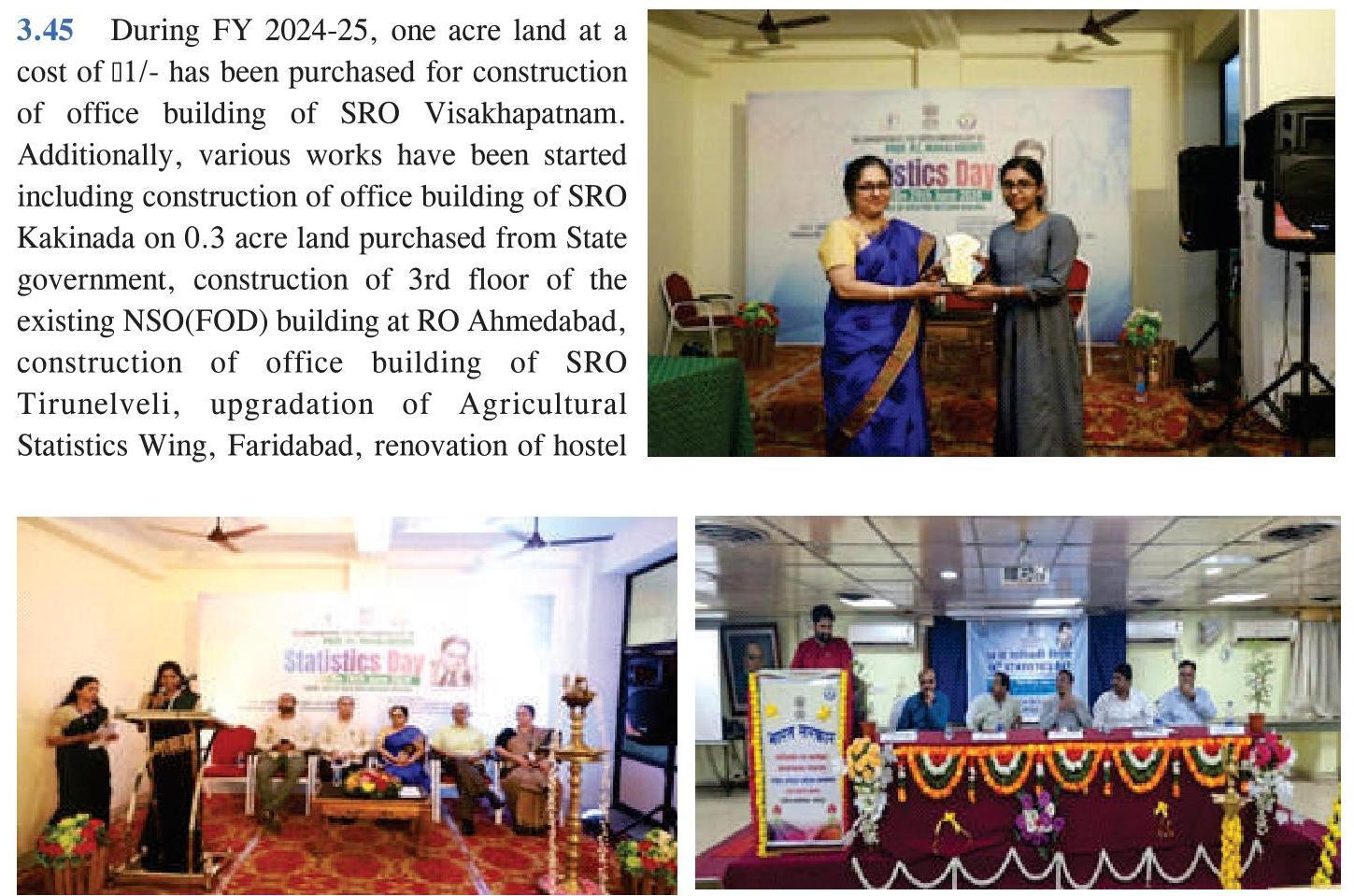
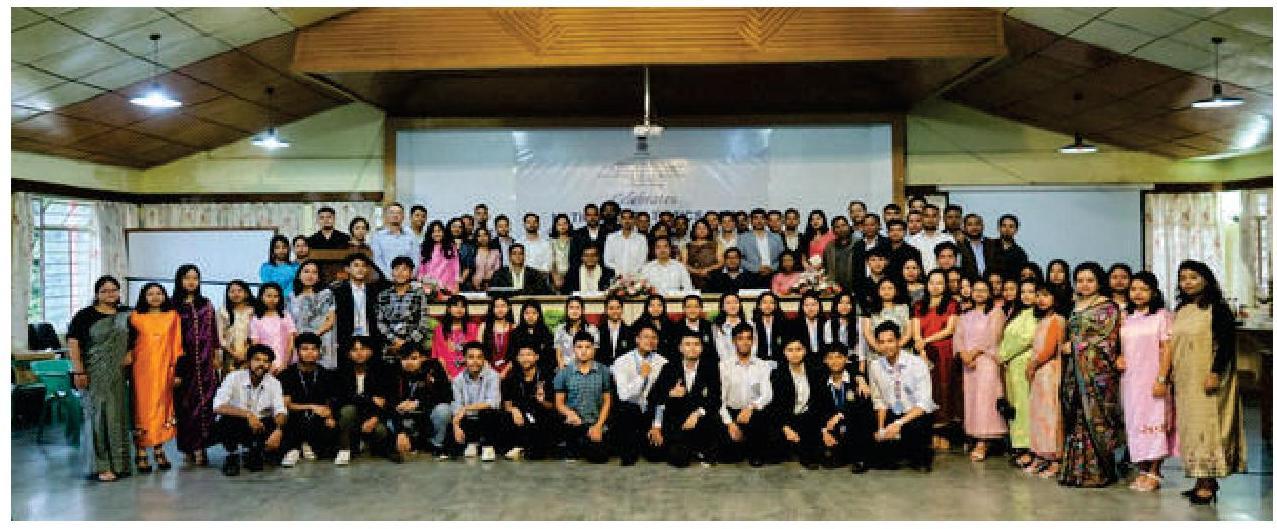
Celebration of Statistics Day in field offices of FOD
rooms of Zonal Office, Nagpur, electrical works for renovation of training hall of Zonal Office, Kolkata at Mahalanobis Bhawan. Apart from this, installation of solar rooftop of 40 KW capacity at Zonal Office, Jaipur is completed.
Celebraing 75 Years of NSS
3.46 The National Sample Survey (NSS), established by Government of India in 1950 has played a crucial role in assessing the socio-economic conditions in India through large-scale sample surveys. Field operations began on 1st October, 1950, and the first round of surveys was completed in March 1951. Since its inception, the results of the National Sample Surveys, MoSPI have provided invaluable insights into various aspects of the economy and have helped shape economic policies, programmes and plans over time.
3.47 In the sequence of celebration of 75 years of NSS, the logo of the National Sample Survey has been launched in December, 2024 encapsulating the essence of the NSS and symbolizing its unwavering commitment to the principle of “Data for Development”.
3.48 The 75th Anniversary celebrations include various nationwide initiatives aimed at raising awareness about the NSS importance and engaging the public in recognizing the value of data for nation-building. The NSS plans to organize extensive publicity and outreach campaigns including social media campaigns, webinars, quiz, essay competitions, local cultural activities, nukkad natak, hackathons, regional workshops, exhibitions, data user conferences, etc to engage with citizens, students, policymakers, academicians and stakeholders. These initiatives will provide platforms for dialogue and knowledge exchange to highlight NSSs’ contributions and the importance of statistical data.

Strengthening of Capacity development facilities
3.49 Capacity development and knowledge up-dation of the technical manpower of FOD is a continuous process. Regular in-service training module are organized for FOD’s staff through Zonal Training Centers (ZTCs) in all six Zonal Offices and Agricultural Statistics Wing, Faridabad. During 2024-25, officers/officials were trained on various technical schemes like Socio-Economic Survey, ASI/ASI Web Portal, Agriculture Statistics, UFS, PLFS, etc. and general administrative matters and Right to Information Act, 2005. Besides this, during 2024-25, FOD organized all India workshop of trainers before commencement/launch of Pilot study on Annual Survey of Service Sector Enterprises (ASSSE) Phase-II, Forward-Looking Survey on Private Corporate Sector Capex Investment Intentions and NSS 80th round in December, 2024 followed by Regional training Camps (RTC) for all the field staff at RO level.
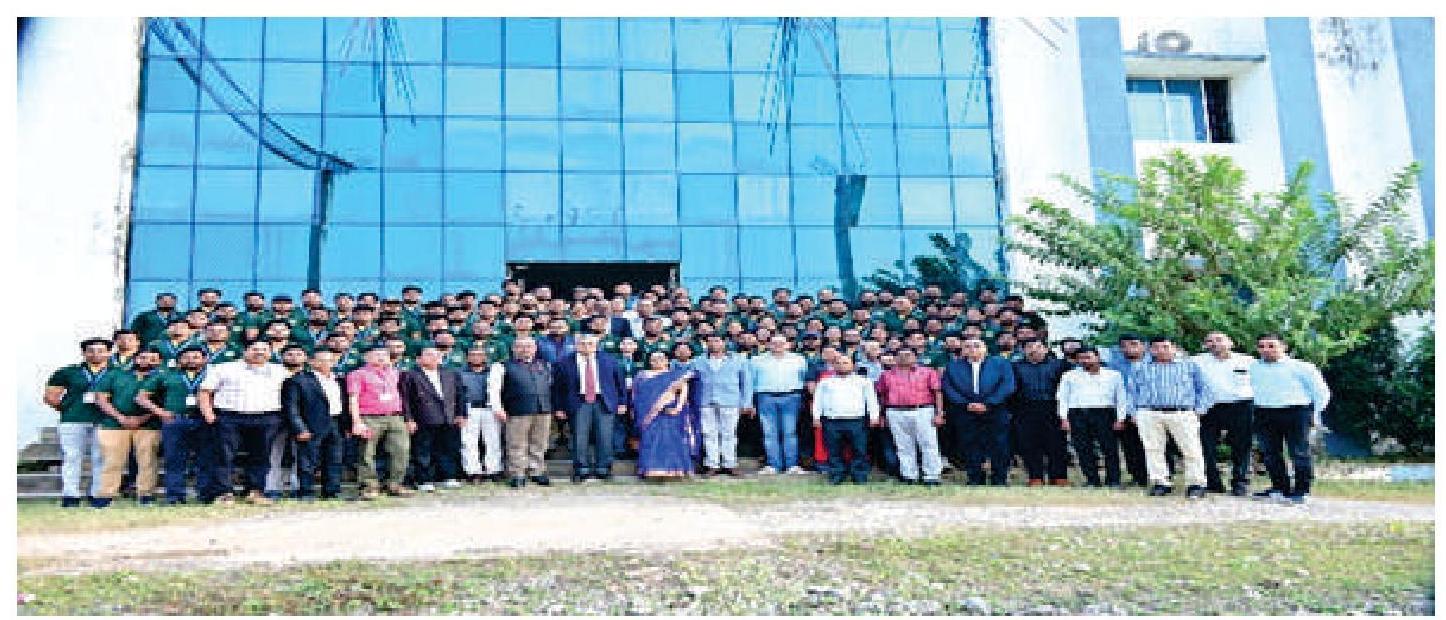
Secretary, MoSPI during valedictory session of one month training programme of RO Bhubaneshwar for contractual Staff
3.50 Regional Offices of FOD organized one-month training for contractual staff in November and December 2024, covering broad areas such as MoSPI activities, FOD surveys, NSS concepts, and skills in communication, team building, leadership, and software proficiency.
Scheme
3.51 NSS is responsible for implementing one of the sub-components of Ministry’s Scheme ‘Capacity Development’, namely, ‘Strengthening of Survey Capabilities of NSSO’. Under this component, C\&QCD releases funds as Grants-in-Aid to five NE State namely, Arunachal Pradesh, Manipur, Mizoram, Tripura and Sikkim in lieu of field work conducted by the Directorates of Economics \& Statistics for the Central Samples along with State Samples for the Socio-Economic surveys of NSS.
Sarvekshana
3.52 Sarvekshana, a biannual technical Journal of National Sample Survey (NSS) has been an important platform for encouraging research and analysis among academia, researchers and officials in the Government, on various socio-economic aspects especially based on the NSS surveys. The combined issue (115-116th) of ‘Sarvekshana’ was published in May, 2024. The journal carried three research papers on various aspects of Official Statistics. Currently, the work involving the publication of the 117th issue of ‘Sarvekshana’ is going on and the same will be published by NSS(C\&QCD).
3.53 A rigorous process of review of papers by the Editorial Advisory Board (EAB) and approval by EAB is followed for admitting papers for publication. Various issues of ‘Sarvekshana’ are available on the website of the Ministry.
Use of Modern Technology/New Initiatives
3.54 The field work of on-going UFS phase (2022-2027) is being undertaken in digital mode through mobile/web applications developed by National Remote Sensing Centre (NRSC), Hyderabad. Boundaries of blocks/wards/Investigator units/ towns are being drawn on satellite imagery obtained from ‘Bhuvan’ portal using Quantum Geographic Information System (QGIS) software. Various attributes of structures are captured through the mobile application and embedded on satellite imagery. The digital mode envisages saving of the UFS maps along with associated attributes on Bhuvan portal for ultimate use as sampling frame for conduct of socio-economic surveys. NSSO (FOD) has also entered into a Memorandum of Understanding (MoU) with the National Remote Sensing Centre (NRSC) under the Indian Space Research Organization (ISRO) to facilitate UFS in a digital mode using the state-of-the-art Geo ICT tools and techniques using Bhuvan Platform.
3.55 The NSO (FOD) has made transition from the system of paper-based schedule to e-schedule for data collection on sample check on Crop Cutting Experiments (CCEs) (Sch. AS 2.0). To start with, an in-house data entry software was developed for AS 2.0 with technical expertise available at NSO that had been rolled out from April 2018. On the similar lines, an Android based software namely ‘AGRISOFT’ for bringing sample check on Area Enumeration work (AS 1.0) to digital mode has been developed by using in-house expertise and the technical testing for the sample check on area enumeration was carried out during the summer season of Agriculture Year 2023-24. It is in the process of improvement on the basis of feedback received from field offices and expected to be launched from Rabi Season of Agricultural Year (2024-25). With regard to further digital transitions, the crop cutting supervision module for NSO (FOD) has been integrated with Digital General Crop Estimation Survey (DGCES) app developed by Ministry of Agriculture \& Farmers Welfare which will enable recording of Crop Cutting Experiment (CCE) results directly from the field. With innovative features such as GPS-enabled photo capture and automated plot selection, this technological advancement significantly enhances transparency and accuracy within the system. To bring this technological advancement into practice, AS Wing has teamed up with the Department of Agriculture \& Farmers Welfare to integrate the crop cutting supervision module on the DGCES app of their Ministry. Trainings on supervision module of DGCES app are being provided to field officials of NSO and State governments by expert officials of AS Wing Faridabad in collaboration with Ministry of Agriculture \& Farmers Welfare.
3.56 In respect of systemic improvement and technological advancements along with timely publication of data, modern IT tools are being adopted for improved data capturing and processing. As a part of this, all the ongoing NSS surveys are being conducted in digital platform using Computer Assisted Personal Interview (CAPI) with in-built validation mechanism to ensure consistency at the stage of data collection. It enhances the efficiency of data collection by enabling real-time data entry and validation through handheld devices, significantly reducing manual errors. Moreover, it facilitates the real-time submission of survey data by field officials, ensuring timely and accurate data transmission. This facilitates simultaneous data processing and has resulted into a drastic reduction in the time lag in releasing the reports. The Quarterly Bulletins of PLFS are being released within 45 days of completion of field work and the Annual Report 2023-24 has been released within 90 days of completion of field work.
Timely release of NSS reports:
3.57 In addition to this, the reports of NSS surveys are being released as per the timetable prescribed in the Advance Release Calendar (ARC) as available on the website of MoSPI.
Stakeholder engagement and feedback mechanism:
3.58 As part of the initiative towards strengthening the continuous engagement and regular feedback from the data users and stakeholders, in order to improve data quality, NSS organised a series of Data User Conferences with data users and stakeholders to take feedback from them and improve the statistical processes and products and promote effective utilization of official statistics and data for policymaking.
i. Household Consumption Expenditure Survey (HCES) 2022-23 in June, 2024
ii. Annual Survey on Unincorporated Sector Enterprises (ASUSE) 2022-23 in August, 2024
iii. Periodic Labour Force Survey (PLFS) 2023-24 in September, 2024
iv. Annual Survey of Industries (ASI) 2022-23 in December, 2024
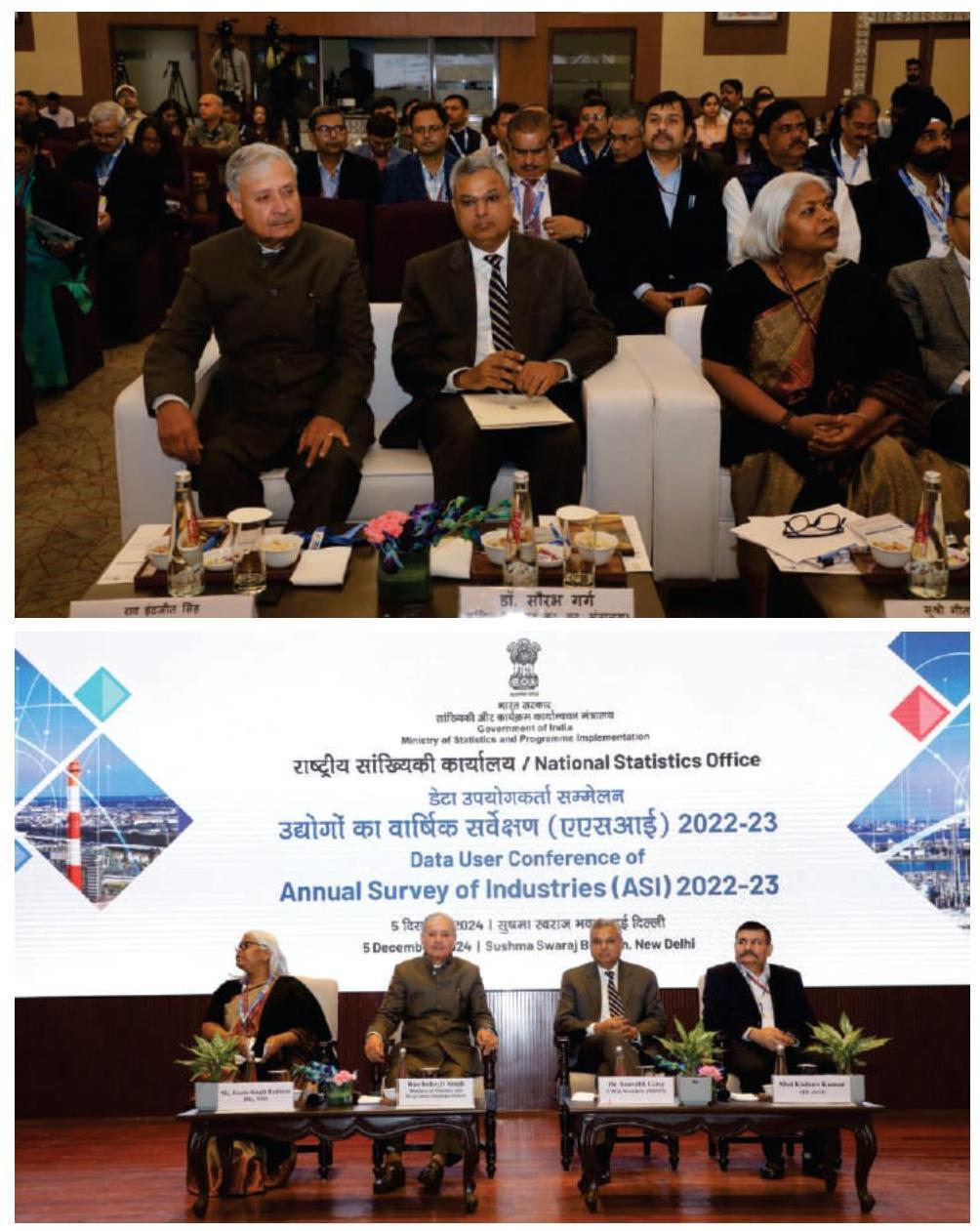
3.59 Following Workshops/conferences/brainstorming sessions with stakeholders have also been organised by NSS:
(i) To raise awareness about the upcoming enterprise surveys of MoSPI namely, Annual Survey of Industries (ASI), Annual Survey of Unincorporated Sector Enterprises (ASUSE), Annual Survey of Service Sector Enterprises (ASSSE), CAPEX and Economic Census (EC), a Conference with Business Associations to engage with various trade groups, associations, and business organizations was conducted in September, 2024.
(ii) To address the issue of non-response in surveys, a Brainstorming session on the issue of nonresponse to surveys particularly by high income groups/gated societies/ high-rise housing facilities was organised in Sep., 2024. Discussions were held on various facets of issue of non-response in high income groups to develop strategies that encourage the aforementioned target population to contribute valuable data and build trust among them by educating on the importance of data and privacy policies.
(iii) All India Workshop of Trainers for Forward looking survey on private corporate sector Capex investment intentions was organised in Pune in Sep., 2024 to facilitate the conduct of survey.
(iv) All India Workshop of Trainers (AIWOT) for the NSS 80th Round of its Socio-Economic Survey during 10-11th December, 2024 to facilitate the conduct of surveys to be done during the round. The subjects under coverage in this Round are Survey on Household Social Consumption: Health and Comprehensive Modular Survey on Telecom (CMS-T).
Chapter 4
Training and Capacity Building
4.1 MoSPI’s National Statistical Systems Training Academy (NSSTA) is a premier institute which has been created for fostering human resource development in Official Statistics at national as well as state level. The Academy is actively engaged in building capacities in the area of Official Statistics and related disciplines at the National, State/UTs and also international level. While addressing the challenge of keeping the statistical workforce abreast and updated on the
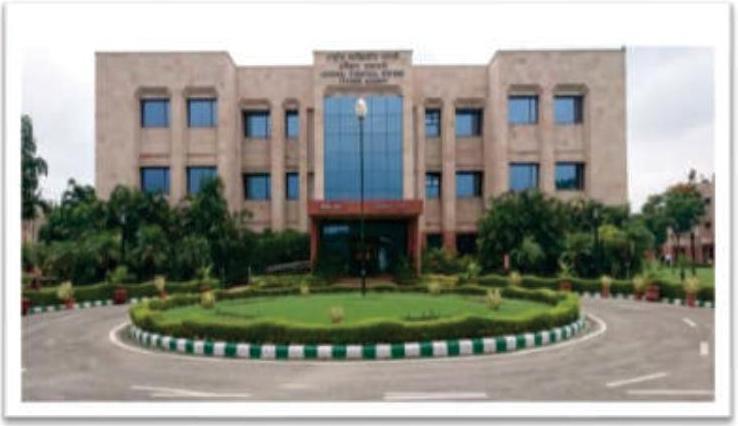
dynamics of the socio-economic environment and technological and methodological advances, the academy has been continuously striving to develop updated and revise course material/curriculum and implement effective delivery mechanisms by focusing on pedagogy, all encompassed in its focused training strategy directed at both newly inducted as well as in-service statistical personnel of Central and State/UT Governments.
Aims and objectives
4.2 The main aims and objectives of the Academy are as under:
a) To create a pool of trained manpower in theoretical and applied statistics to effectively manage both the current and emerging challenges of data collection, collation, analysis and dissemination for better formulation of policies and plans for the country;
b) To train statistical as well as non-statistical manpower in undertaking monitoring and evaluation of large-scale programmes/ projects, through specialized short/medium term training programmes; and
c) To create a pool of trainers and develop training material in consultation and collaboration with academicians, researchers and professionals from universities, external professional institutions and UN/bilateral agencies.
4.3 The training strategy adopted entails conducting both induction and refresher training programmes at the NSSTA and outsourcing some training programmes to other reputed and specialized institutions. The programmes provide need-based training of the statistical personnel working in the Central and State/UT Government, in the identified subject areas. NSSTA also regularly provides technical support in terms of capacity development of the statistical personnel of the neighboring Asian countries and also African countries and also conducts request based training programmes for them.
4.4 NSSTA has also been making special efforts to sensitize the potential human resources through awareness programmes in official statistics, both at its campus and at various universities across the country. These programmes include training of faculty and students from various universities at NSSTA as well as organizing awareness programmes at select Universities by the officers of the Academy and NSSO.
NSSTA organizes this activity every year and it has been found very useful by the community of users of official statistics.
Amenities in the academy
4.5 NSSTA is equipped with modern facilities for training as well as boarding and lodging facilities for the trainees. The complex of the Academy comprises three building blocks, namely, the Academic and Administrative Block, Hostel Block and the Residential Block. The Academic and Administrative Block has a Conference Hall with a seating capacity of around 60 persons; a centrally air-conditioned ‘Mahalanobis Auditorium’ with a seating capacity of around 150 persons; four lecture halls fitted with the latest computerized teaching aids; ‘Sukhatme Library’; a computer laboratory equipped with infrastructure to conduct hands-on training for about 30 trainees at any point of time and lodging facilities for 100 trainees. The recreational facilities available in the campus include indoor and outdoor games including billiards, table tennis, volleyball, badminton and basketball.
Training Programme Approval Committee (TPAC)
4.6 A high-level ‘Training Programme Approval Committee’ (TPAC) has been constituted comprising senior officers of the Government of India and a few subject experts from reputed Institutes as members, for guiding NSSTA in organizing its various training activities. The Committee assesses and approves the need-based training calendar on an annual basis, besides reviewing the syllabi, duration and training methodology for all the modules. Some of these courses are conducted at NSSTA and some specialized courses are conducted at institutes/ organizations of repute. The training programme are organized in the areas of Official Statistical Systems, Theoretical \& Applied Statistics, Large Scale Sample Surveys, System of National Accounts (SNA), Data Management Techniques, Information Technology, Management, Financial Management, Micro and Macro Economics, Econometrics, Topics of Emerging Technologies, etc.
Training Programmes organized at NSSTA and other initiatives
4.7 The training programmes conducted by NSSTA include the following:
a. Two-year Probationary Training Programme for the officers of the Indian Statistical Service (ISS)
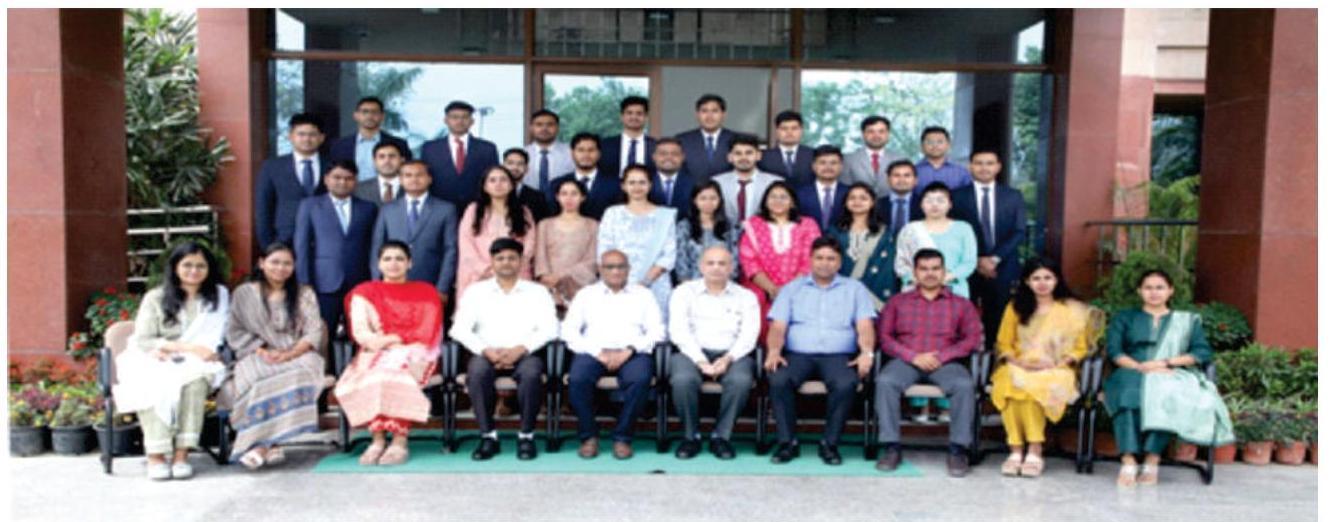
ISS Probationers of $2024^{6}$ batch
b. Refresher Training Courses – Mid-Career Training Programme (MCTP) and Domain Specific Training Programme (DSTP), Seminars/Workshops for the in-service ISS Officers and senior Officers of Central Ministries/Departments, State/ UT-Directorates of Economics \& Statistics and other Line Departments
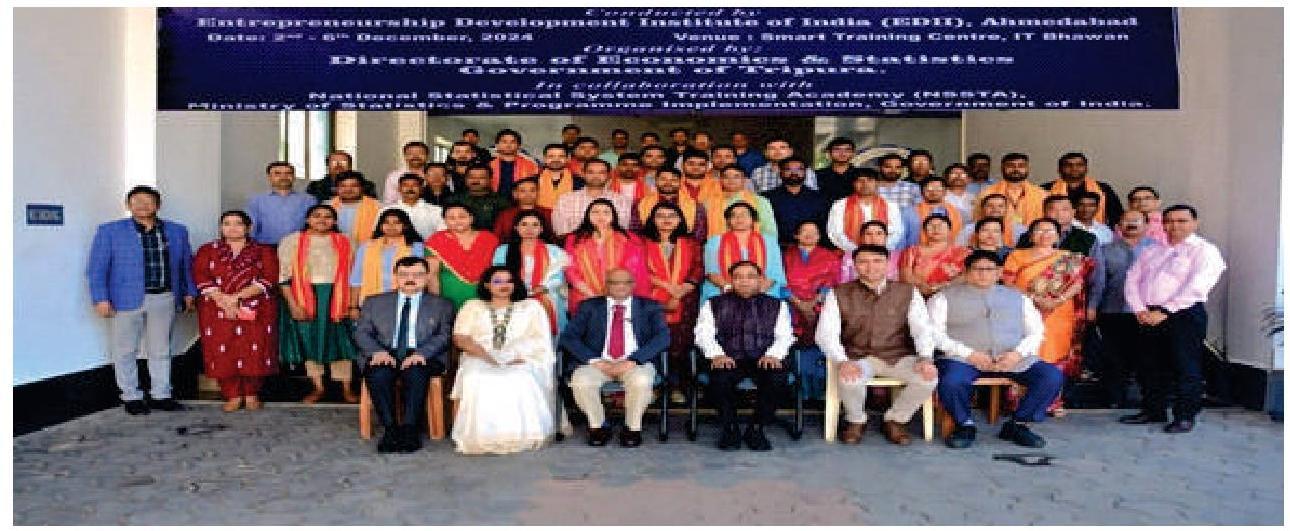
c. Three weeks Induction Training Programme for the newly recruited Junior Statistical Officers of the Subordinate Statistical Service (SSS)
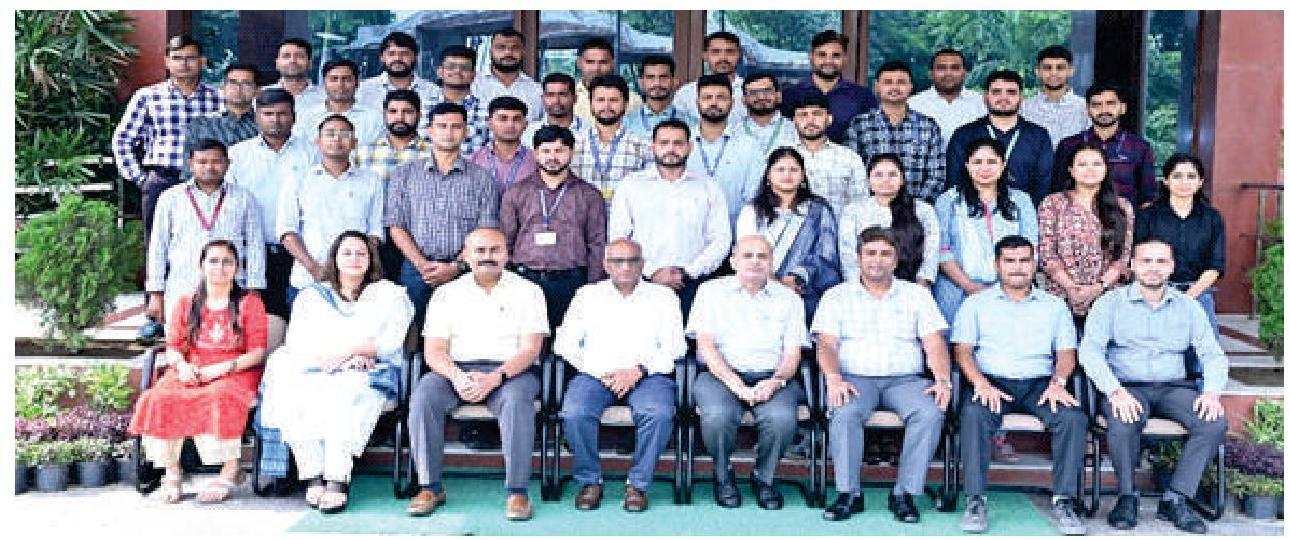
d. Refresher training courses for in-service SSS Officers
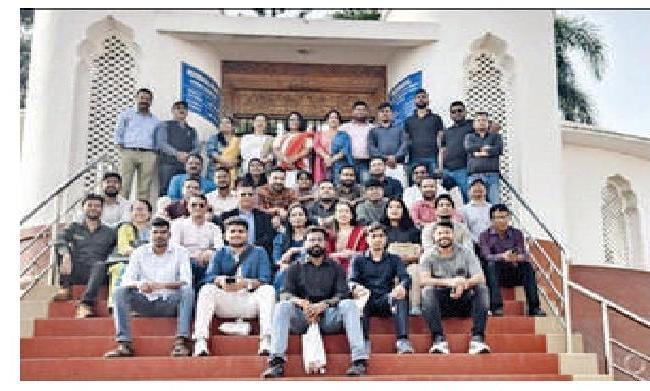
Training Programme on ‘Soft Skills, Personality Development, and Professional Excellence’ held from Dec. 2-6, 2024 at Agartala, for Junior Statistical Officers of the in-service SSS
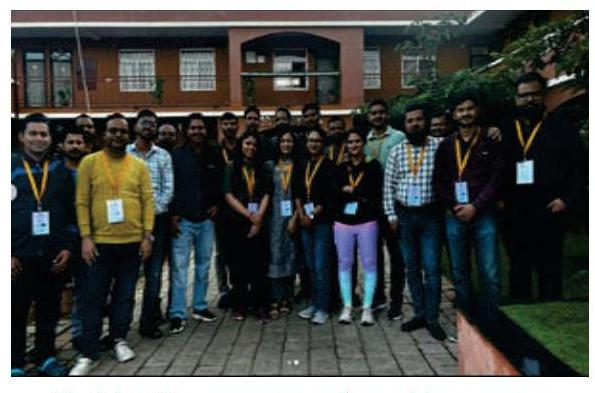
Training Programme on Stress Management through Blissful Living at the Art of Living International Centre, Bengaluru, for in-service SSS officers from 16-20th December, 2024
e. Demand-based Training Programmes for officers of Directorates of Economics \& Statistics (DES)/ Planning Divisions/Ministries/ Departments, etc. and tailor-made training courses, based on specific requests received from the States and UTs
f. Support for exposure programme on Official Statistical System to the M. Stat. Students from the Indian Statistical Institute (ISI), Kolkata and other centres
g. Awareness programmes in official statistics for students and faculty members of universities.
h. Training Conducted for State DES of A \& N on during 9-13th Dec., 2024 at Shri Vijayapuram and attended by $50+$ Officers and two days training programme organized for the Officer Trainees (OTs) of Indian Civil Accounts Services (ICAS) during 3rd – 4th Oct., 2024, on Official Statistics and related disciplines.
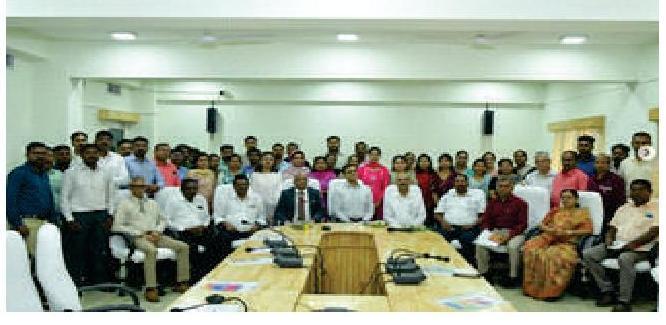
i. A 7-day Orientation Training Programme about MoSPI and its activities for lateral recruits of MoSPI was organised.
j. Training Programme on Data Visualization was organised during 25-26th November, 2024 for inservice ISS officers.
k. Two 03-day training programmes organized on DFPR, General Financial Rules (GFR) and roles,
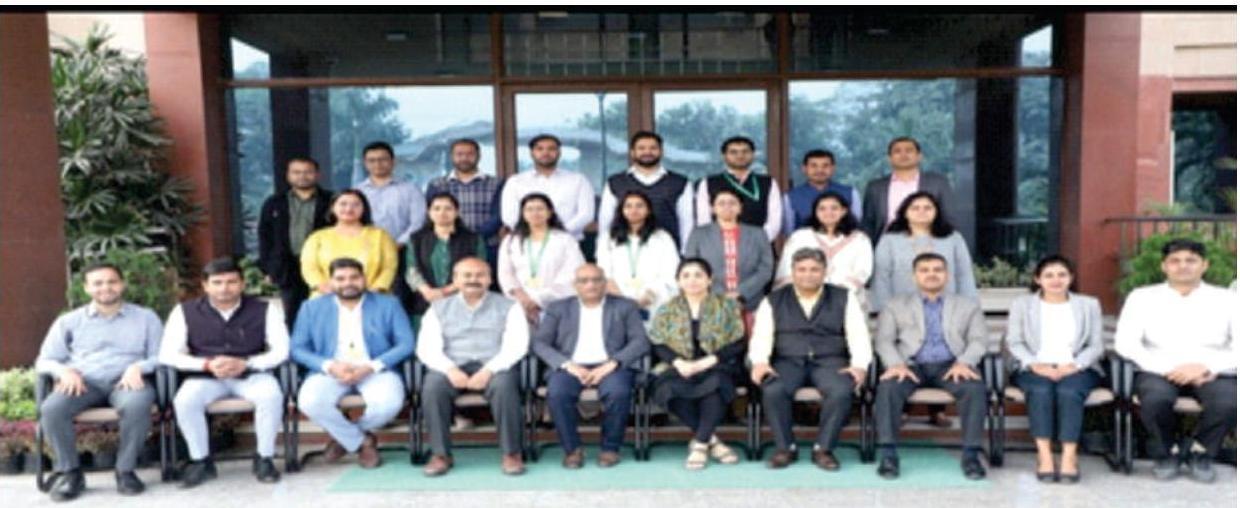
responsibilities and financial powers of HoD , for regional heads \& HoDs of regional offices of NSO, MoSPI.
- Training programme on Handling of unit level data has been scheduled to be organised during 3rd 7th March, 2025
m . For the purpose of specialized training programme, NSSTA collaborates with various reputed/specialized Institutes viz. IIMs; IITs; IIRS, Dehradun; ASCI, Hyderabad; Labour Bureau, Chandigarh; IIPA, Delhi; IIPS, Mumbai; ISTM, Delhi; IGIDR, Mumbai; IASRI, Delhi; ISEC, Bengaluru; etc.
n. Training of State Statistical Personnel: Regular as well as demand-based Training Programmes are also conducted from time to time for State Governments /UTs in certain specified subjects and areas of their interest. Besides these, tailor-made training courses, based on specific requests received from the States and UTs, are also conducted at the NSSTA.
o. Hon’ble President and Vice President of India met with ISS(P) of 2024 batch
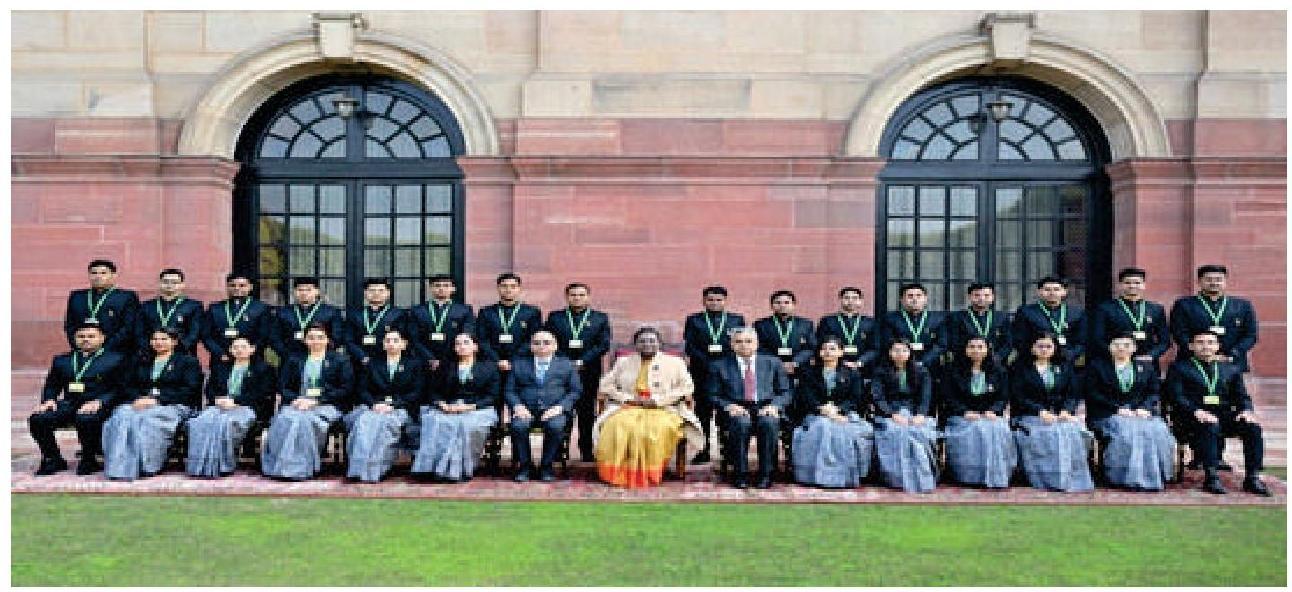
President Meet ISS(P), 2024th batch on 14th January, 2025
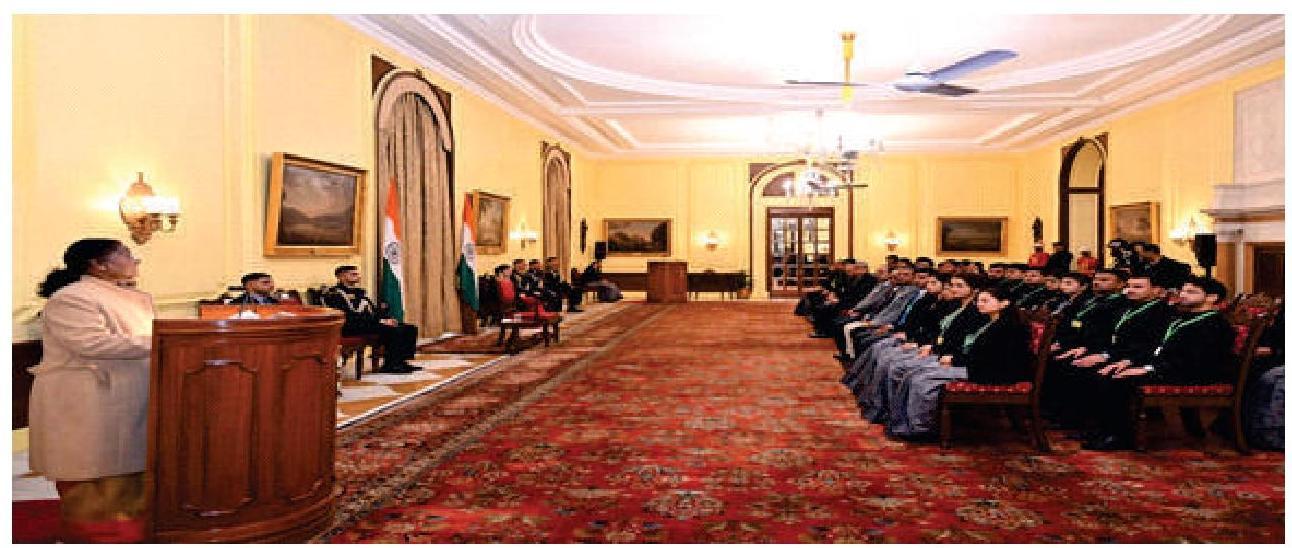
Hon’ble President addressing ISS(P) 2024th Batch along with the dignitaries of MoSPI
p. Foundation Course of ISS(P) of 2024 Batch was organized at MCRHRDIT, Hyderabad during September to December, 2024
q. NSSTA has recently been collaborated with DES of State Governments of Tripura, Odisha and Kerala to organize the refresher training programmes for in-service SSS Officers
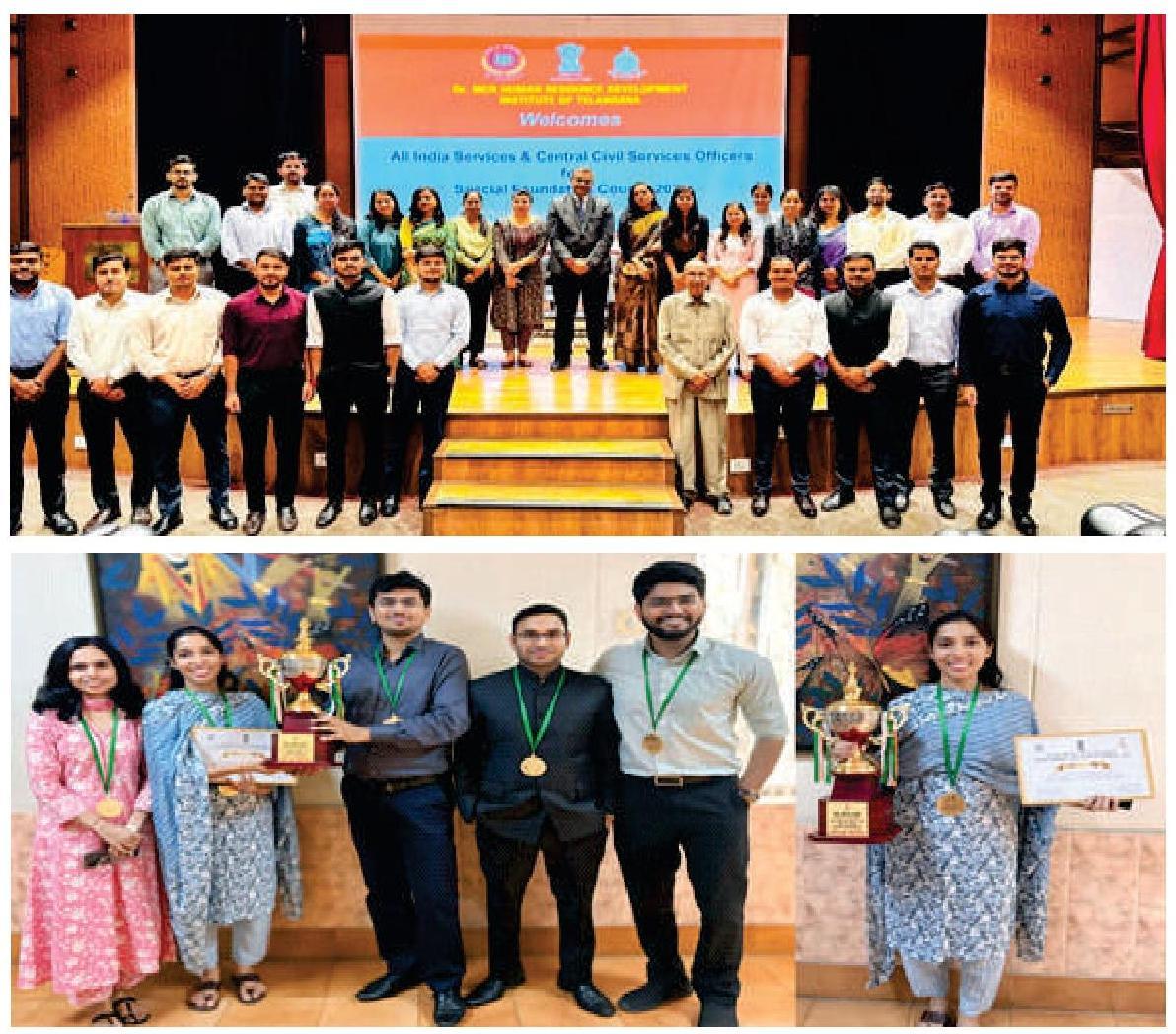
r. NSSTA has highlighted the utility of STAT (Statistical Training need Assessment Tool) to States/UT Governments during the recently concluded 28th Conference of Central and State Statistical Organizations (COCSSO) in New Delhi. Further, a National workshop on STAT is being organized, in collaboration with UN SIAP, for the participants of Centre and State Governments in collaboration with UN-SIAP
s. NSSTA has also developed and launched the Statistical Training needs Assessment Survey on 28th November, 2024. This survey consists of two comprehensive questionnaires: to identify, prioritize and meet learning needs of Individuals and Institutional/Supervisors.

t. ISS(P) Training Model Revised: Classroom (16 Months) + Field (6 Months) + Classroom (2 Months) to give impetus on project-based approach in trainings. Probationers will undertake project work during field posting and this model is also useful to align with acquired competency and work requirement.
u. A system of organizing online webinars has been institutionalized for Officers/Staff of MoSPI in collaboration with CBC, World Bank and other institutes of repute. The speakers like Prof. Indermit Gill, Prof. Karthik Muralidharan, Prof. Amit Kapoor, Dr. Deepak Mishra, Prof. Sonalde Desai and Prof. Pravin Krishna etc. have been invited for the webinars.
v. iGOT related initiatives –
(i) Induction and Refresher Training Programmes have been made phygital by introducing/linkage of related online training programmes available on iGOT. It has been made mandatory for the participants to complete the iGOT courses and submit the certificates before coming to the physical training.
(ii) About 1500 more courses on emerging technologies, AI, ML, etc. completed.
(iii) One hour per week has been introduced to be dedicated for e-learning via iGOT in all offices of MoSPI.
(iv) More than 10,000 training courses in the areas of Behavioural, Functional and Domain competencies have been completed by officers and staff of MoSPI across the country during 2024-25.
(v) Karmayogi Saptah – National Learning Week observed during 19 – 27th October, 2024, across the nation. All the divisions of MoSPI actively participated. Here are a few of the highlights of learning progress made by MoSPI during this week.
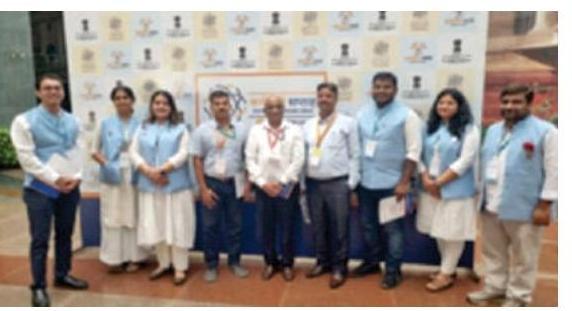
(vi) Field Operations Division along with NSSTA as a Nodal of iGOT has demonstrated exemplary performance during National Learning Week (NLW) with a significant percentage of users completing the target of $4+$ learning hours and honoured with a certificate by Hon’ble Minister Dr. Jitendra Singh during the Valediction ceremony on 14th Nov., 2024 at Vigyan
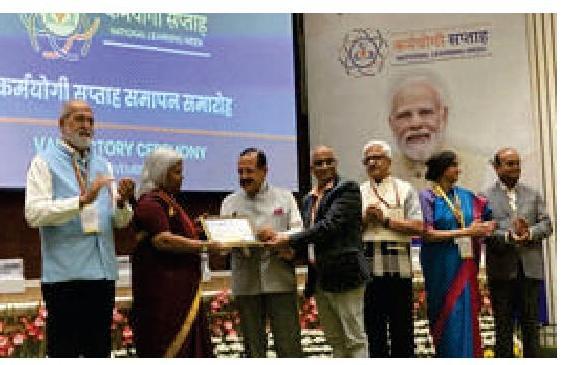
Bhawan.
(vii) Here are a few of the highlights of learning progress made during NLW:
i. 3,546 new users (approx. $45 \%$ ) were on boarded, raising the total number of registered users to 7,861 (more than $90 \%$ of total)
ii. 5,233 new course enrollments recorded, the total enrollments now stand at 41,506
iii. 3,807 courses were completed in November, 2024 accounting for $13 \%$ of the total course completions, bringing the overall total to 30,369 .
w. NSSTA is also expanding its collaboration with institutes of repute and accordingly, signing the formal MoUs with institutes like ISTM, GIMS, CDTI, AJ-NIFM, etc.
x. Emphasizing the importance of research, a presentation on research papers and an overview of JSTOR (Archives of Journals) were organized on 18th October, 2024. In addition, access to JSTOR was also provided. Furthermore, papers and articles written by officers being made available on the MoSPI website for wider dissemination.
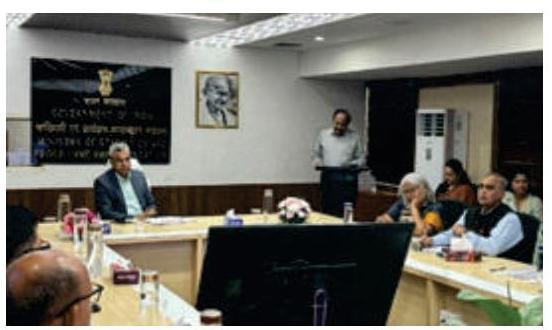
International Training Programmes
a. NSSTA in collaboration with the United Nations Statistical Institute for Asia and the Pacific (UNSIAP) is organsing following National Workshop:
i. 13-17th Jan., 2025: Statistical Training needs Assessment Tool (STAT): Centre and State Government Participants
ii. 17th -21st Feb., 2025: Natural Resource Accounting: Centre and State Government Participants
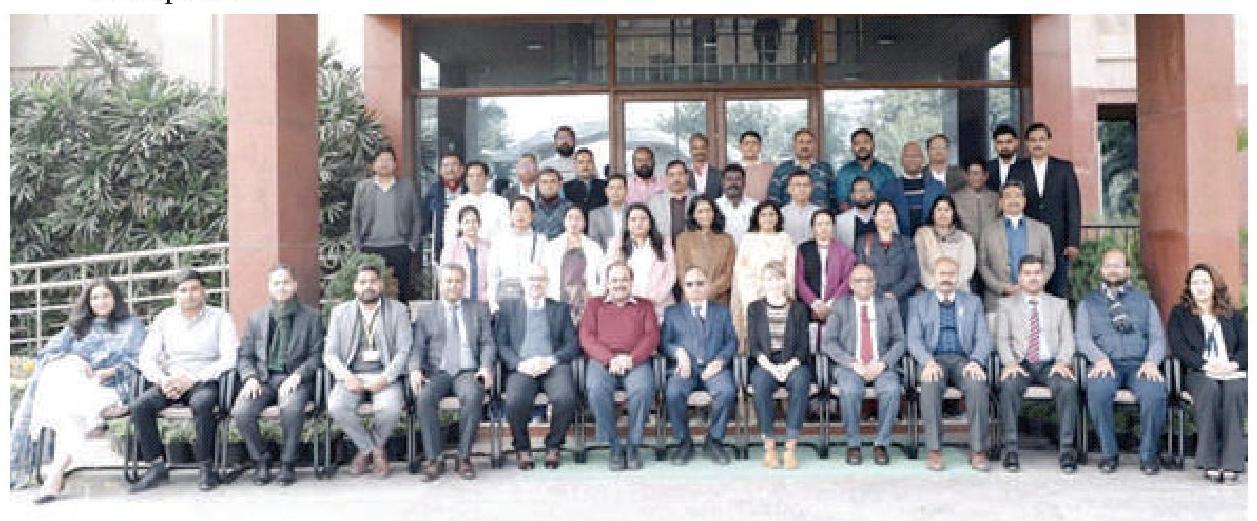
b. NSSTA in collaboration with International Statistical Education Centre (ISEC), Kolkata, under the aegis of Indian Statistical Institute (ISI), Kolkata conducts training programme for the international participants of regular diploma course in Statistical Theory and Applications.
c. NSSTA is also contributing actively via sharing its faculty as resource person to other institutes.
Participation in the Foreign Training Programmes /Meetings /Workshops /Seminars/ Conferences
4.8 The Screening Committee of MoSPI under the chairmanship of the Chief Statistician and Secretary (S\&PI) of India, is constituted to consider nominations for participation in international meetings, conferences, seminars, workshops and trainings.
4.9 During 1st January, 2024 to 31st December, 2024, 61 Officers of this Ministry have participated in 47 International Meetings/Conferences/Seminars in physical mode.
Scheme of Internship for Post-graduate/Research Students
4.10 MoSPI is implementing a scheme for internship for post-graduate students/research scholars of recognized universities/ institutes with the objective to create awareness amongst the students about statistical system of India. Under the scheme, internship of two months is offered during May to July and a stipend of $₹ 10,000 /-$ is paid to students after completion of the internship. For 2024-25 internship schemes, total 282 interns successfully completed their internship. The internship scheme has been revamped in the year 2025 with a set of revised guidelines wherein graduate/post-graduate students would be able to participate in the internship program on flexible period/timelines (ranging from 2 to 6 months).
Grant-in-Aid to institutions for promoting research studies and for organization of Seminars/ Conferences/Workshops, etc.
4.11 MoSPI is also implementing Grant-in- Aid scheme to promote research studies and seminars in the area of Official Statistics by way of providing financial assistance. Under the Scheme, funds are provided to the eligible institutions/organizations for conducting research study/ organizing seminar/conferences/workshops etc. on topics relevant to official statistics. Financial assistance is also provided to present the papers in international conferences/workshops. Financial assistance is provided to research institutions/ organizations/ NGOs for conducting surveys / undertaking studies in Official Statistics as per guidelines laid down for the purpose. During the year 2024-25, a total of 23 proposals were received, with 14 coming from Government Institutions and 9 from Private Institutions. Out of these, only 2 proposals were as per scheme guidelines and the same were approved by MoSPI. Additionally, the Scheme Guidelines have been revised in 2024.
International/National Awards in Statistics
4.12 Ministry has also instituted one international award in statistics namely, Prof. P.C. Mahalanobis International Award in Statistics in the memory of eminent Indian Statistician Prof. P.C. Mahalanobis. Presently, the award carries a cash prize of USD 10,000/-, a Citation, a Memento and round-trip economy class airfare and per diem as per UN rates to cover the expenses to participate in the felicitation function. The award is given on a biennial basis. The award is conferred to a selected Statistician of a developing country for lifetime contribution in Statistics. The 11th Prof. P.C. Mahalanobis International Award in Statistics-2023 was conferred upon Prof. Arup Bose, Indian Statistical Institute (ISI), Kolkata and was given during 64th World Statistics Congress from 16-20th July, 2023 in Shaw Conference Centre in the heart of Ottawa, Canada. ISI, Netherlands has announced a Call for Nomination for the year 2025 with the submission deadline set for 31st December, 2024. Besides, 2 national awards viz Prof. C. R. Rao award and Prof. P. V. Sukhatme award are also instituted by MoSPI on an alternate year basis (one award in a year). This year, the national award has been on boarded on the national award portal of Government of India. Nominations are being sought for Prof. C. R. Rao National Award through the national award portal from 1st January, 2025, with last date of nomination as 28th February, 2025.
On the Spot Essay Writing Competition
4.13 Since 2005, every year, the Ministry organizes an All India on the Spot Essay Writing Competition on subjects relevant to Statistics/Official Statistics for the post graduate student of statistics studying in the recognized universities/ colleges/institutions to commemorate the birth anniversary of eminent statistician Prof P. C. Mahalanobis. The competition is generally held at various offices of MoSPI such as the sub regional/regional/zonal offices of NSSO (FOD), etc. The winners of the competition are felicitated on Statistics Day Celebration held every year on 29th June. One 1st Prize of ₹5,000/-, two 2nd Prizes of ₹12,000/-, three 3rd Prizes of ₹10,000/- and five Consolation Prizes of ₹5,000/- are given under the competition. The “On the Spot Essay Writing Competition 2024” was officially announced on 2nd February, 2024, with the deadline for application submissions set for 17th March, 2024. Total 248 applications were received and total 222 candidates were found to be eligible to participate in the aforementioned competition, which was held on 7th April, 2024, across 45 Regional Offices/Sub-Regional Offices of NSO (FoD) nationwide. The Essay Writing Competition was successfully concluded, with 11 winners being awarded during the Statistics Day Function.
Chapter 5
Data Informatics \& Innovation
5.1 The Data Informatics \& Innovation Division (DIID) under MoSPI, formerly known as the Computer Centre, was established in 1967 under the Department of Statistics in the Cabinet Secretariat. Initially focused on catering to the data processing needs of the Department of Statistics and other Union Government Ministries, it evolved with advancements in ICT. Renamed as the Data Informatics and Innovation Division (DIID), its responsibilities expanded to encompass digital transformation, modernization of IT architecture, and innovative data dissemination practices and experimentation with emerging technology for MoSPI.
Roles and Responsibilities:
- Formulating a Digital Transformation Framework: Develop a comprehensive strategy for MoSPI’s digital transformation, including detailed plans for modernizing IT architecture to align with emerging technologies and future needs.
- Technical Advisory: Provide technical recommendations on hardware, software, and technology stack specifications while assisting divisions in conceptualizing and planning projects that leverage innovative IT solutions.
- Coordination of Digital Initiatives: Act as a nodal agency for coordinating cross-divisional digital initiatives, ensuring seamless integration and efficient implementation.
- Cybersecurity Policies: Implement guidelines and policies addressing cybersecurity threats, ensuring data protection and compliance with regulatory standards.
- Website Management, Development and Maintenance: Oversee the design, development, and continuous maintenance of MoSPI’s website and associated portals, ensuring user-centric updates and accessibility.
- Data Dissemination: Maintenance and Updation of e-Sankhyiki Portal \& Micro Data portal to facilitate the release of data from surveys and censuses through standardized formats to improve accessibility and usability.
- Implementation of the Data Innovation Lab: Operationalize the DI Lab under the Capacity Development Scheme, fostering experimentation and innovation in official statistics.
- Publication of Data Compendiums: Compile and publish datasets and registries from various ministries, detailing methodologies, collection practices, and dissemination formats.
- Hosting and Cloud Services: Utilize NIC Cloud Services to host and maintain Ministry applications and portals, ensuring cost-effective and secure operations.
- Additional Responsibilities: Take on additional duties as assigned to address emerging priorities and challenges.
Initiatives of MoSPI under Data Informatics \& Innovation in 2024-25
Data Dissemination
eSankhyiki Portal
Background: Launched on Statistics Day 2024, the eSankhyiki portal is designed to improve data accessibility and user interaction through cutting edged technology. This portal is having time series data of important macro indicators and a catalogue of major data assets of the Ministry.
5.2 The eSankhyiki portal has two sections:
i. Data Catalogue: The Data Catalogue has a repository of 2706 datasets along with metadata and visualization for datasets of Consumer Price Index (CPI), Index of Industrial Production (IIP), National Accounts Statistics (NAS), Periodic Labour Force Survey (PLFS), Annual Survey of Industries (ASI), Multiple Indicator Survey (MIS) (NSS 78th Round), Household Consumption Expenditure Survey (HCES-2022-23), Annual Survey of Unincorporated Sector Enterprises (ASUSE-2022-23) and Comprehensive Annual Modular Survey (CAMS 2022-23).
ii. Macro Indicators: This module offers time-series data for over 4.4 million records with options for filtering, visualizing, and downloading datasets enabling ease of access \& management of data having datasets including CPI, IIP, NAS, ASI, PLFS, data of NSS 78th round on Multiple Indicator Survey (NSS) and Wholesale Price Index (WPI) of DPIIT.
Salient features
- The time series data for NAS is available for the last 75 years.
- The time series data of CPI and PLFS is available since inception.
- The time series data of ASI and IIP is available for more than 30 years.
- Wholesale Price Index data (2012-2024) marked the onboarding of the first dataset from a nonMoSPI source using API.
- The portal currently has more than 4.4 million records.
- Dissemination of microdata pertaining to previous Economic Censuses (4th to 6th) is also being undertaken through the portal.
Outcome: The portal has emerged as a centralized platform for data dissemination, enabling stakeholders to analyze and visualize datasets effectively, fostering data-driven decision-making.
Micro Data Portal
Background: Ensuring the accessibility of statistical data in standardized formats is a key objective of Ministry. Accordingly, Ministry undertakes the following activities:
i. Conversion of MoSPI surveys unit level data in standard format accepted globally i.e. International Household Survey Network (IHSN) for dissemination to the various stakeholders.
ii. Released anonymized unit-level data from NSS surveys and other MoSPI products for public use.
iii. Provided seamless online access to microdata and metadata through the National Data Archive portal (NADA).
5.3 Unit level anonymized data sets released in the current fiscal have all been placed on the website for online dissemination as detailed below:
- Periodic Labour Force Survey (PLFS), July 2023-June 2024
- AYUSH of NSS 79th round: 2022-23
- Comprehensive Annual Modular Survey (CAMS), NSS 79th round
- Household Consumption Expenditure Survey: 2022-23
- Annual Survey of Industries 2022-23
- INDIA – PLFS, Calendar Year 2023 (Jan 23- Dec 23)
- Annual Survey of Unincorporated Sector Enterprises (ASUSE) of 2021-2022
- ASUSE 2022-2023
5.4 MoSPI has also undertaken revamp of its micro data portal in collaboration with the World Bank
Outcome: The initiatives improved data accessibility for researchers and policymakers, contributing to a more informed statistical ecosystem. On the average more than 10 lakh hits were recorded on the micro data portal.
Month-wise hits recorded on the Microdata Portal

Statistical Data and Metadata exchange (SDMX)
Background: Statistical Data and Metadata exchange (SDMX) is a globally accepted data exchange protocol for macro indicators for improving interoperability.
- Quarterly Estimates of GDP from 2011(Q1) are being released in SDMX format along with CPI data and made available through the website.
Outcome: It improves the interoperability of data leading to increase in the value of data provided by the ministry.
Implementation of Data Innovation Lab (DI-Lab)
Background: The DI Lab, operationalized in July 2024, aims to foster innovation in official statistics by creating an ecosystem for experimentation and collaboration.
i. As a part of the DI Lab scheme, all documentations like RFPs/ MoUs/ Contract needed for operationalizing the scheme have been finalized, approved and vetted by competent authority.
ii. Nine problem statements consolidated from MoSPI and other M/Ds identified for innovation, out of which RFP for 2 problem statements were placed in the public domain
iii. As a part of strengthening of the Innovation ecosystem, 130 academic institutions like IITS/ IIMs and top 50 institutes of NIRF ranking were approached for signing of MoU. Four institutions namely, IIT Madras, IIT Gandhinagar, IIM Nagpur and IIIT Vadodara have signed the MoU.
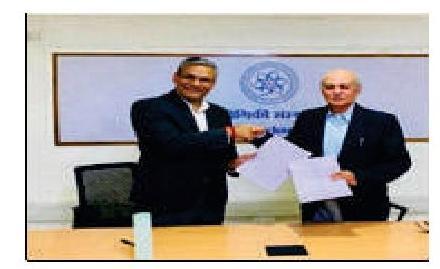
iv. In addition to this, 12 Mentors, considered as experts in their respective fields have been nominated from various public and private institutions.
v. As part of outreach programme, various organizations like Sarvam AI, Idinsight, Gartner, Gatishakti, NeGD, Samagra, GDi, Wadhwani Foundation, etc. along with multilateral organisations like World Bank have also been consulted for these initiatives.
vi. Two in-house PoCs have been conducted for finalizing the benchmark of the projects. as detailed below:
- AI based Chat bot for intelligent document Search
- AI based tool for rejuvenating legacy data
vii. Working papers and self-assessment tools were finalized and uploaded on the following as part of Competencies and Capacity Development: - Institutional Readiness for Adoption of Emerging Technologies such as AI, ML and Big Data in Official Statistics
- Assessment of Websites for Effective Dissemination of Data
- Assessment of Portals for Digital Dissemination of Data
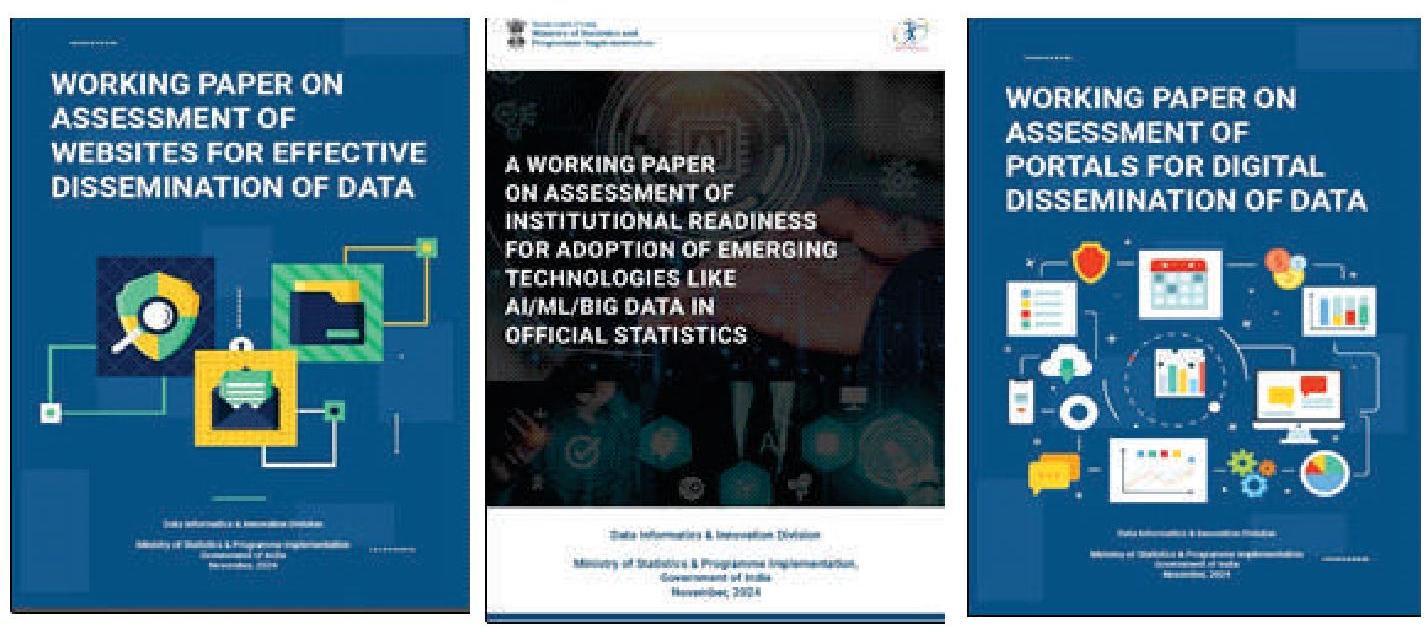
Working Papers: A DI Lab Research Initiative
Outcome: This initiative has established itself as a cornerstone for driving innovation in the Indian statistical system, building partnerships, and addressing critical challenges.
Website Management, Development and Maintenance of the Ministry
Background: The MoSPI website (https://www.mospi.gov.in) serves as an integrated digital platform for statistical publications, reports, and visualization dashboards. It aims to provide seamless access to vital data resources for stakeholders.
5.5 MoSPI has introduced a number of novelties in the Ministry’s website this fiscal. In order to address the need for providing greater insights from data to various stakeholders, a pool of more than 1700 data visualizations pertaining to key products of the Ministry e.g. National Accounts Statistics, Consumer Price Index, Index of Industrial Production and NSS surveys have been created and made available to users through its website. A separate category on User Suggested Visualizations
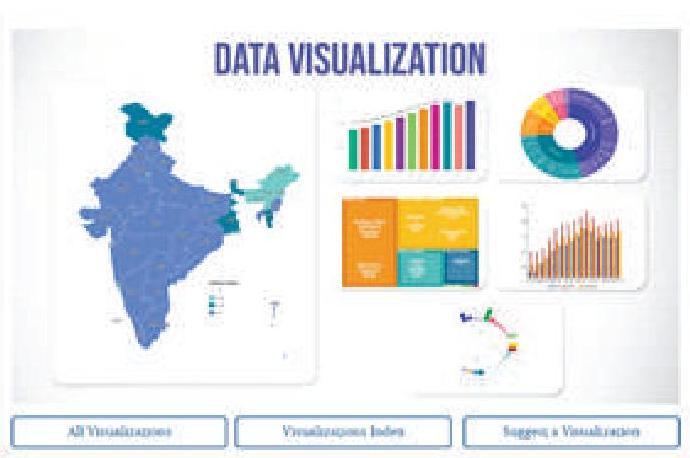
has also been incorporated in the DataViz section in an attempt to strengthen the statistical system through an institutionalized feedback mechanism. These visualizations can be downloaded along with data adding value to the datasets of the ministry by way of facilitating its reuse. In its endeavour to enhance the user experience and responsiveness, various new sections like User Feedback, Blogs, etc. have been developed. The revamp of the website has also been initiated to make it at par with the best in the world.
Outcome: The enhanced functionalities, improved user engagement and accessibility, making the website a more valuable tool for stakeholders. As a result, on an average, more than 6 lakh hits were recorded per month on the website.
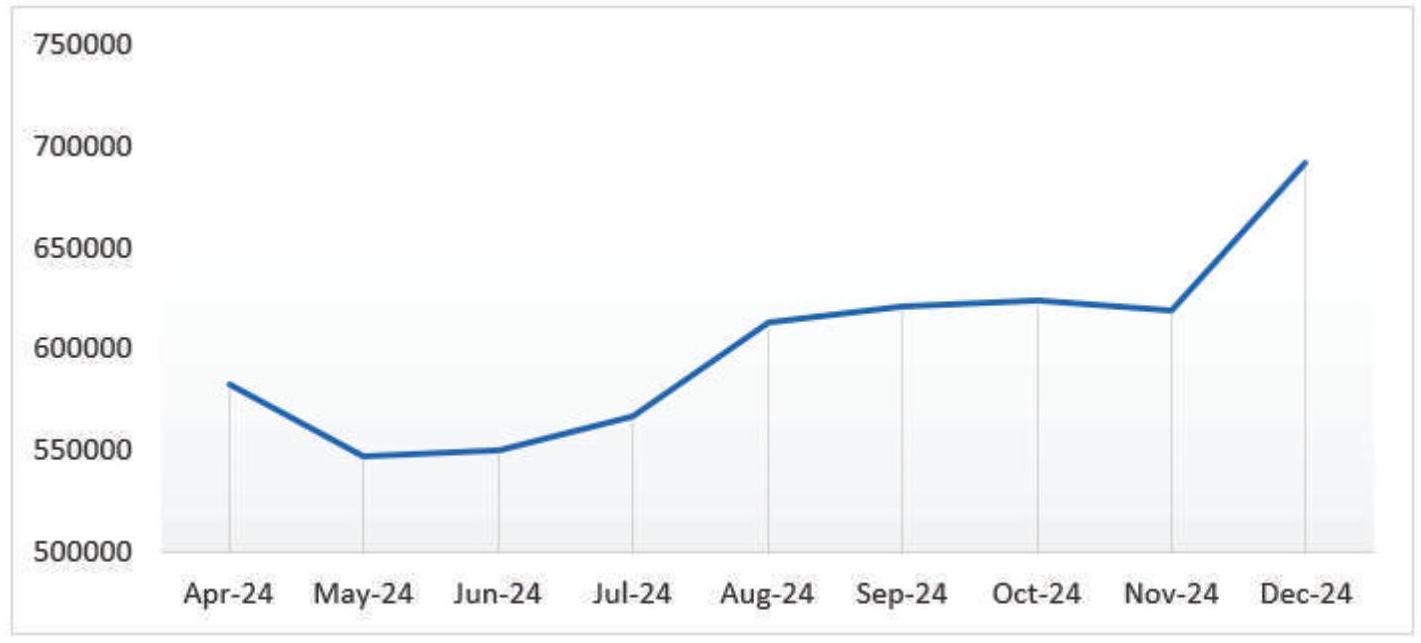
Month-wise hits recorded on the website of MoSPI
Compendium of Datasets
Background: The compendium serves as a comprehensive resource, consolidating metadata from various government departments.
Compiled 257 datasets from 40 ministries, including details on data collection methods, dissemination policies, and levels of disaggregation.
Outcome: The compendium enhanced accessibility and understanding of government datasets, serving as a vital resource for stakeholders
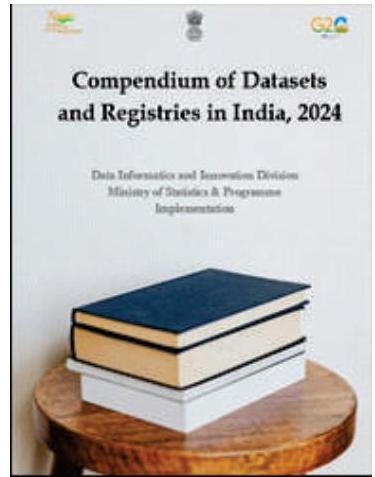
Compendium of Datasets and Registries in India 2024
Competency Development and Outreach Activities
Background: To sensitize various stakeholders of recent developments and initiatives of the Division and enhancing stakeholder engagement for improving accessibility, transparency, and effectiveness of data dissemination and other initiatives along with for adoption of the best practices, officers of Ministry have actively participated in the various fora.
Ministry conducted a session on Data Dissemination Practices across Government of India during the 28th Conference of Central and State Statistical Organizations, 2024, held in August 2024, with the main objective of apprising various participating state governments of the initiatives within the Govt of India to provide access to open, easily understandable and machine-readable data through its various platforms. Also, another presentation was made on Data Innovation Lab during the conference of Secretaries of the State Government. Ministry also made presentations on various digital initiatives during the two sensitization workshops cum review meetings with Statistical Advisors of Ministries/ Departments held in the months of August and December, 2024.
Officer(s) from Ministry attended International Mobile Data Workshop organized by World Bank Group during 7th -10th October, 2024, Washington DC, USA as well as Seventh Highlevel Forum on United Nations Global Geospatial Information Management coorganised and hosted by the National Institute of Statistics and Geography (INEGI) of the Government of Mexico with the theme “Accelerating Implementation: Achieving Resilience” in México City from $8^{\text {th }}-10^{\text {th }}$ October, 2024 and attended SDMX Regional Training Workshop in Turkey from 4th – 6th December, 2024.
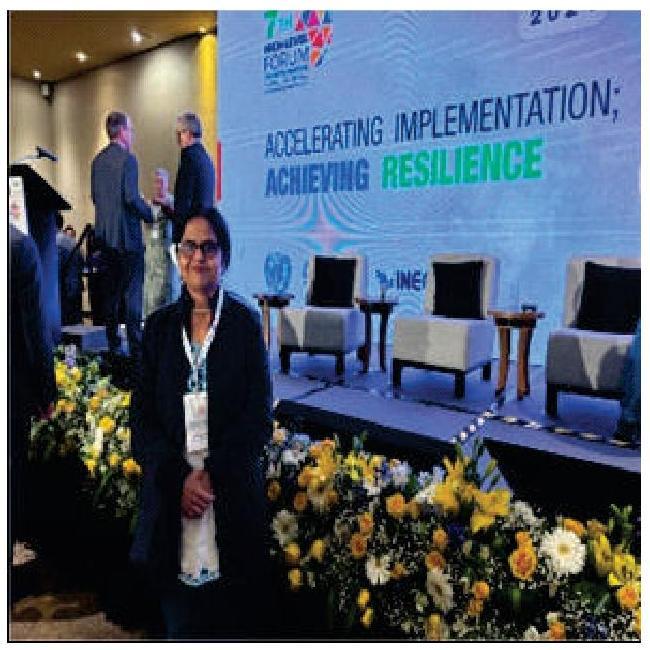
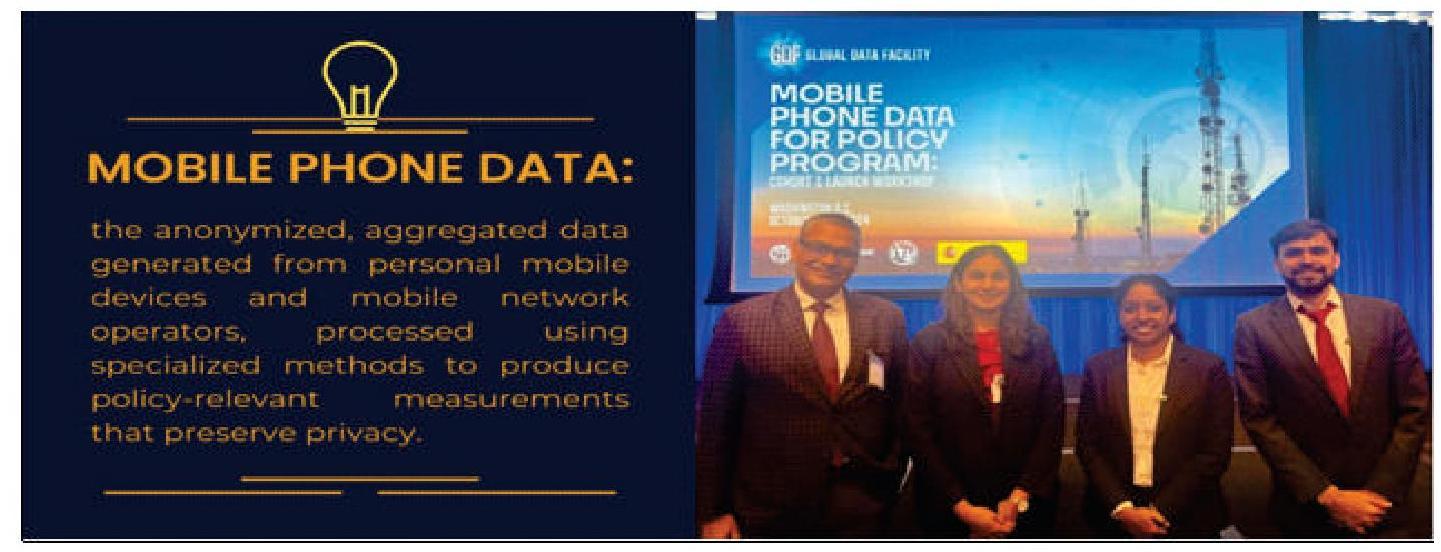
Participation in International Mobile Data Workshop organized by World Bank
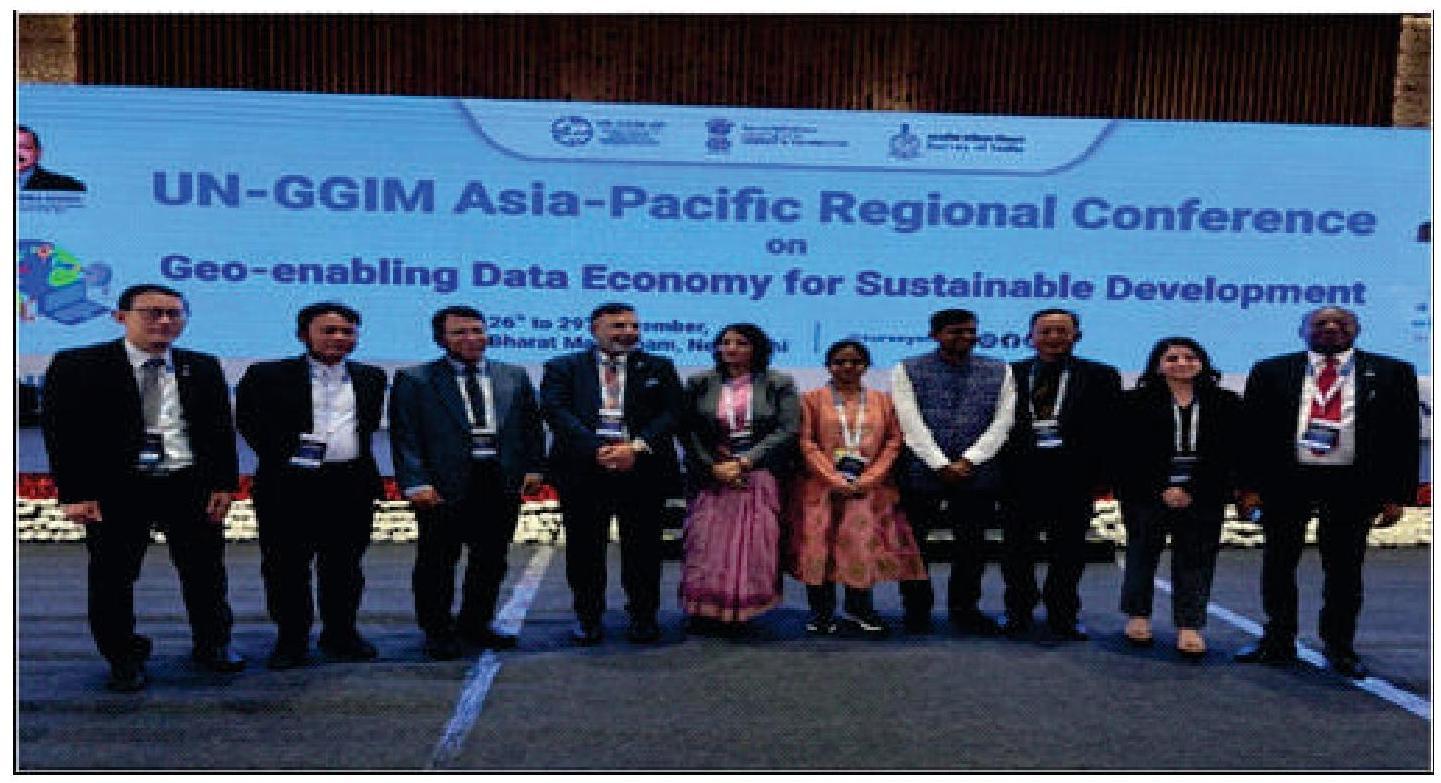
Participation in United Nations Committee of Experts on Global Geospatial Information Management (UN-GGIM) – Asia Pacific
Officers from Ministry actively participated in the various workshops domestically like Data for Development Capacity Building Initiative (D4D-CBI) organized by National Institute of Labour Economics Research and Development (NILERD) on 23rd October, 2024 at Delhi; Data Forum organized jointly by the World Bank and NITI Aayog, held on 21st November, 2024 at Odisha; and the thirteenth plenary session of United Nations Committee of Experts on Global Geospatial Information Management (UNGGIM) – Asia Pacific hosted by India in Bharat Mandapam from 26-29th November, 2024.
MoSPI also showcased recent IT initiatives undertaken such as eSankhyiki Portal, DataViz and Data Innovation Lab at the MoSPI stall set up during the India International Trade Fair (IITF) 2024 held during 14 – 27th November, 2024.
In addition, a training programme on data visualization was conducted in collaboration with NSSTA. The course was designed and conducted by DIID. A workshop on the cyber hygiene was conducted in collaboration with NIC. Officers of Ministry also imparted training on various programme conducted by NSSTA and also gave a lecture to probationers of various All India and Central Services at MCRHRDI. A detailed presentation to senior officers was made wherein the possible use cases of Scanner Data and Satellite imagery had been presented.
India has also become a member of UN Expert Committee on Big Data and Data Science and is a participant in the upcoming International Symposium on AI and Data Science for Economic Statistics and the third sprint of Data Science Leader’s Network (DSLN), for creating a playbook on use of Data Science in Official Statistics.
Outcome: Sensitized the stakeholders about the various digital initiatives of MoSPI and created opportunities for collaboration between various stakeholders, both within the government and outside.
Modernization Initiatives
Background: To stay at the forefront of statistical innovation, MoSPI prioritized modernization efforts and accordingly one of the goals regarding creating of a data sharing platform and experimentation was assigned to DIID
Accordingly, the following initiatives have been undertaken by DIID:
- Launched the eSankhyiki portal to improve data dissemination.
- Institutionalized the DI Lab to explore advanced methodologies.
- Prepared a roadmap for IT modernization, identifying infrastructure gaps and recommending solutions.
- Feasibility studies for alternative data sources and India Stat Stack planned.
- Release of working papers
Outcome: The initiatives enhanced the reliability and accessibility of MoSPI’s statistical data, reinforcing its leadership in data innovation.
Cloud Computing
Background: Cloud infrastructure has become a vital component for cost-efficient and secure data hosting.
DIID utilized NIC Cloud Services to host applications of the ministry, including the Website and eSankhyiki.
Outcome: The cloud-based infrastructure reduced costs, enhanced security, and ensured scalability, supporting MoSPI’s operational efficiency.
IT Asset Management and Cybersecurity
Background: Maintaining a robust and secure IT infrastructure is critical for MoSPI’s operational integrity.
Accordingly, the following activities have been undertaken:
i. Operated the Mini Data Centre on a 24×7 basis, ensuring continuous availability.
ii. Complied with MeitY guidelines by implementing SSL certifications, conducting vulnerability assessments, and restricting external USB use.
iii. Updation/creation of email accounts of the Ministry done on regular basis.
iv. RFP issued for appointment of dedicated Cyber Security agency.
Outcome: The measures ensured secure and uninterrupted IT operations, safeguarding MoSPI’s digital assets.
Technical Advisory
Background: DIID of MoSPI has been nominated as the Nodal Division for IT related matters for the entire ministry. Accordingly, DIID was entrusted with creating an IT modernization plan for the ministry and also to provide advisory services to different verticals for their automation.
The following initiatives have been undertaken:
i. Digital Road map was prepared and presented. Based on the same various division started their automation activities.
ii. Provided technical support to NAD, PSD, ESD, SSD, IPMD, Capacity Development Division by way of facilitating technical knowhow in terms of solution architecture, evaluation of technical proposal, supervision of development, etc.
iii. The websites of NSSTA and NSC had been developed in-house resulting in fulfillment of long pending requirement.
iv. A prototype of Meta data portal was also developed, as required by ASPD.
v. DIID has also been performing the role of the nodal division for the budget announcement 2024-25 related to ministry.
Outcome: The process automation of various divisions started which will lead to better statistical production process ultimately.
Gatividhi Dashboard
Background: Monitoring MoSPI’s activities required an efficient and centralized tracking system.
Activity: Developed the Gatividhi Dashboard to track progress across various projects and activities.
Outcome: The dashboard improved efficiency and transparency, ensuring timely completion of projects.
Consumer Price Index (CPI) Portal
Background: The CPI portal facilitates the retrieval and analysis of comprehensive CPI data.
Developed the CPI Archival Web Portal to provide access to indices, inflation rates, and visualizations. Data was also formatted in SDMX to improve interoperability.
Outcome: The portal streamlined access to CPI data, enhancing transparency and usability for stakeholders.
Promoting Official Language Usage
Background: MoSPI emphasizes the progressive use of Hindi to foster inclusivity and compliance with linguistic policies.
Activity:
i. Organized Hindi Pakhwara in September 2024, including competitions and incentives.
ii. Integrated bilingual features into the Ministry’s website.
iii. Conducted Quarterly Workshop to promote the use of Hindi in DIID.
Outcome: The initiatives strengthened the use of the official language, promoting inclusivity and accessibility.
Conclusion
The MoSPI’s initiatives during 2024-25 demonstrate a commitment to innovation, modernization, and enhanced data dissemination. These efforts have positioned MoSPI as a leader in leveraging ICT for statistical advancements.
Chapter 6
Administrative Statistics
6.1 The Administrative Statistics \& Policy Division (ASPD) was established in the National Statistics Office (NSO) on 18th January, 2021. Initially named the Policy Implementation and Monitoring Division (PIMD), it is headed by an officer at the Additional Director General level. The division operates under the overall supervision and guidance of the Director General (Data Governance).
6.2 ASPD has been set up in NSO with the following broad mandate:
i. To put in place a governance structure, i.e. policies, directives, guidelines, practices and tools that will support acquisition, management and efficient use of administrative data.
ii. To coordinate with other Departments/Ministries (through the Statistical Advisors) in examining the statistical potential of the administrative records held by those organizations to help in building statistical requirements into administrative system; then creation or redeveloping their administrative records system
iii. To facilitate creation of repository of information including metadata about administrative datasets available with all the Ministries/Departments.
Activities undertaken
i. The Division prepared and published a paper on “Administrative Data: Issues, Concerns and Prospects”. The paper highlights the issues, concerns and prospects of using administrative data as a part of Official Statistical System.
ii. The Division also prepared a document, “Data Dissemination: National Meta Data Structure (NMDS) for Statistical Products”. It is a set of guidelines for data producer to adhere to a basic minimum quality standard in order to establish and maintain the quality of data and enhance ease in sharing data. NMDS has been circulated among Ministries/Departments of Government of India and State/UT Governments for adoption.
iii. One of the recommendations of the reforms agenda MoSPI is working on, provide for setting out guidelines on documentation, metadata, and the improvement of overall transparency of statistical communication. In order to facilitate the Ministry/Departments to follow a uniform reporting structure on referential metadata, MoSPI has developed a revised National Metadata Structure (NMDS 2.0) for compliance by the Ministries/Departments regarding datasets generated through various sources such as census, surveys, administrative, and alternative interventions.
iv. Additionally, the agenda provide for continuance with adherence to global practices like System of National Accounts (SNA), Special Data Dissemination Standard (SDDS), Classification of Individual Consumption according to Purpose (COICOP) etc. In order to facilitate the Ministries/Departments to follow appropriate international statistical standards in their datasets, MoSPI has compiled the lists of 68 major global standards/classifications and 9 national standards/classifications.
v. ASPD acts as a Nodal Division in MoSPI for supplying the necessary inputs and co-ordinate the activities related to the compilation of Data Governance Quality Index (DGQI) by National Institution for Transforming India (NITI) Aayog. The DGQI score for the Ministry has improved from 2.51 during 2020-21 to 4.59 during 2023-24.
Score of MoSPI in DGQI of NITI Aayog
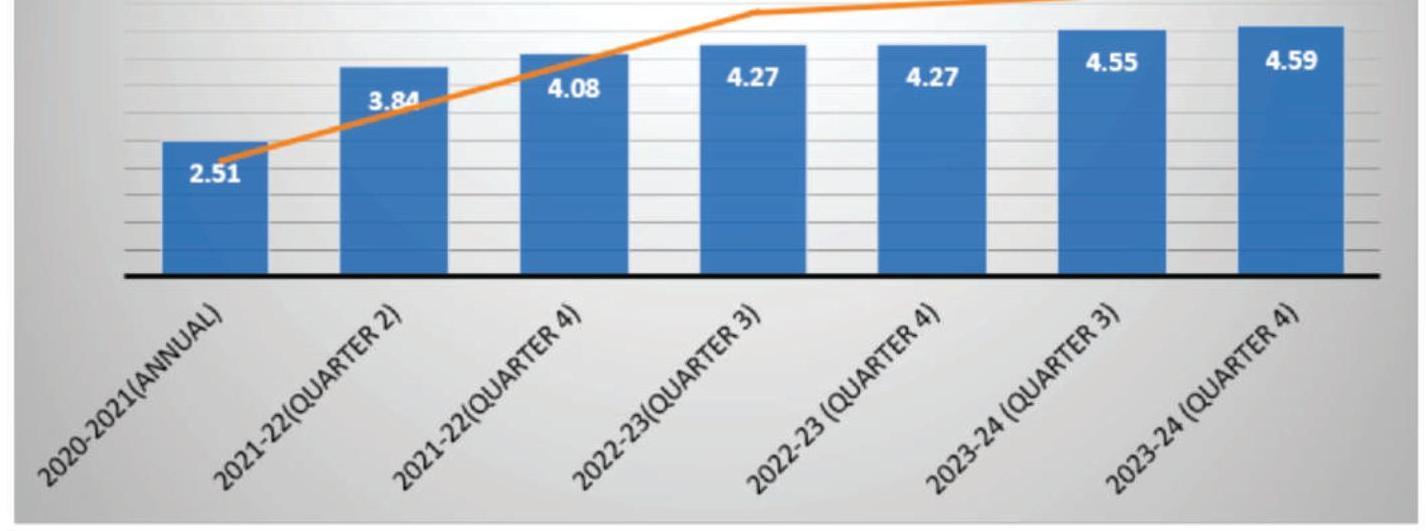
Chapter 7
India in United Nations
7.1 India’s expertise in the field of statistics, diversity and demography has earned it a seat on the United Nations Statistical Commission (UNSC). The United Nations Statistical Commission, established in 1946, is the highest body of the global statistical system bringing together the Chief Statisticians from member states from around the world. It is the highest decision-making body for international statistical activities, responsible for setting of statistical standards and the development of concepts methods, including their implementation at the national and international level.
7.2 Joint efforts were made by MoSPI and Permanent Mission of India to the United Nations (PMI- UN) to drum up support for India’s candidature for membership to the UNSC for the term 2024-2027. The concerted efforts of PMI-UN and MoSPI led to India’ selection as a member of the UNSC for the term 20242027. India has been elected as a member to UNSC after almost 2 decades, a feat for the Indian Statistical System.
55th Session of the United Nations Statistical Commission
7.3 The 55th session of the United Nations Statistical Commission was held from 27th February, 2024 to 1st March, 2024 in New York. The delegation of MoSPI led by Secretary, MoSPI participated in the session.
7.4 India delivered official oral statements on various agenda items including Fundamental Principles of Official Statistics, national accounts, climate change statistics, working methods of the statistical commission, Environmental-economic accounting and Data and indicators for the 2030 Agenda for Sustainable Development.
Vice-Chair of the Bureau of United Nations Economic and Social Commission for Asia and the Pacific (UN-ESCAP) Committee on Statistics (CST)
7.5 The Economic and Social Commission for Asia and the Pacific (ESCAP) is the most inclusive intergovernmental platform in the Asia-Pacific region. The Commission promotes cooperation among its 53-member States and 9 associate members in pursuit of solutions to sustainable development challenges. ESCAP is one of the five regional commissions of the United Nations.
7.6 The ESCAP Committee on Statistics is the highest-level intergovernmental forum for decision making on statistics in the Asian and Pacific region. ESCAP member States are represented at the Committee by leaders of national statistical systems, i.e. heads of national statistical offices, or their representatives.
7.7 India was elected as one of the three Vice Chairs of the Bureau of UN ESCAP Committee on Statistics (CST) for a second consecutive term for the period from 2022 to 2024 during the 8th session of the CST held in August 2022.
Member of the Governing Council (GC) of Statistical Institute for Asia and the Pacific (SIAP)
7.8 The United Nations Statistical Institute for Asia and the Pacific (SIAP) is a professional statistics training centre for government officials and others working on official statistics. SIAP offers short and longterm specialized trainings to strengthen knowledge and build skills of national governments’ employees to produce, use, and share reliable statistics, including for the monitoring of the Sustainable Development Goals and the development of fact-based policy. SIAP is a regional training arm of the Economic and Social Commission for Asia and the Pacific (ESCAP).
7.9 In accordance with its Statute, the Institute has a Governing Council consisting of a representative designated by the Government of Japan and eight representatives nominated by other members and associate members of ESCAP elected by the Commission.
7.10 India was re-elected to the Governing Council (GC) of SIAP for the period from 2022 to 2024 during the seventy-eight session of the UN ESCAP held in May, 2022.
7.11 Dr. Saurabh Garg, Secretary of MoSPI, chaired the 20th session of the Governing Council of the UN-SIAP, during 09-10th December, 2024 in Bangkok.
Chapter 8
Research and Analysis
8.1 The Research and Analysis Unit (RAU) was established in the Ministry on 07.02.2024 with an objective to create in-house capacity for research and data analytics. The mandates of RAU inter-alia include following functions:
i. Analyse various statistical products of MoSPI and suggest improvements as research and policy inputs.
ii. Study various survey data for assessment of quality of the surveys and suggest possible improvements
iii. Analyse publicly available datasets and share the findings of the analysis with government stakeholders as research and policy inputs
iv. Encourage various reputed Institutes /organizations for various research work utilizing official statistics or for development of official statistics
8.2 Following the mandate, following major activities have been undertaken by Ministry under research and analysis in FY 2024-25 (upto January 2025):
i. International best practices on Press releases of different statistical products were studied and model press releases on GDP, IIP, CPI, PLFS, etc. were prepared and shared with Subject Matter Division.
ii. Working Papers/Note based on research and analysis of publicly available data have been prepared and shared with stakeholder Ministries/Departments in the Government as policy inputs:
a. How to Enhance Labour Force Participation Rate of Women in India – Evidence-based Policy Suggestions
b. Consumption of food by Indian households and ICMR-recommended quantity – An analysis based on HCES 2022-23 data
c. Pattern of Seasonal Price Volatility of Essential Vegetables in India: A Study on Tomato, Onion and Potato
d. Note on Observations on methodology of estimation of ‘Prevalence of undernourishment’ (PoU) by Food and Agriculture Organisation (FAO) of UN in respect of India.
e. An assessment of skill gap of the workforce in India based on analysis of Periodic Labour Force Survey 2023-24
f. Some of the focus areas for enhancing domestic manufacturing and reducing reliance on imports: An analysis based on data from Annual Survey of Industries, etc.
iii. Based on inputs received from different Divisions of the Ministry a consolidated list of research
topics has been prepared and placed on the website of the Ministry inviting research proposals from eligible institutions under the grant in aid component of the Capacity Development scheme of the Ministry.
iv. Encouraged various institutions to take up research work in development of official statistics. Through this collaboration approach, one MoU has been signed between IIT Kanpur and this Ministry on research project “X-13 ARIMA SEATS for seasonal adjustment: Understanding the model and providing an R software paccatered to the needs of MoSPI”. Further eight more research proposals have been received in the Ministry from various reputed research institutions.
v. Following the objective of creating the RAU in MoSPI, i.e. “to create in-house capacity for Research and Data Analytics” in the Ministry, one DDG level ISS officer of MoSPI has been facilitated by RAU to undertake a project to develop an integrated Artificial Intelligence (AI) tool that enhances document retrieval, automates data extraction from PDF/image/excel tables, and improves the efficiency and accuracy of National Industrial Classification (NIC) code selection for business entities in the National Sample Surveys (NSS) as part of her M.Tech course in BITS Pilani.
Chapter 9
Support for Statistical Strengthening
9.1 The ‘Support for Statistical Strengthening’ (SSS) is an on-going central sector sub-scheme which aims to improve the statistical capacity and operations of State Statistical Systems for collecting, compiling and disseminating reliable official statistics. The sub-scheme is implemented through the State Directorates / Bureaus of Economics \& Statistics (DESs), as per the approved activities/targets/outputs detailed out in the State’s specific MoUs signed between the Government of India and respective States/UTs.
9.2 The SSS sub-scheme was approved by the Cabinet Committee on Economic Affairs (CCEA) in March 2010, as the “India Statistical Strengthening Project” then a Centrally Sponsored Scheme for improving the statistical capacity and operations of State Statistical System. The project was later renamed as “Support for Statistical Strengthening” (SSS). Post budget of 2014-15, SSS Scheme was made a Central Sector Sub-Scheme with $100 \%$ funding from the Centre under the Umbrella Scheme ‘Capacity Development’ of the Ministry.
Scheme Implementation
9.3 As on 31st December 2024, 29 States/UTs have been on boarded under the sub scheme out of which implementation has been completed in 11 States/UTs. SSS sub – scheme has contributed in enhancing the efficiency of Directorates / Bureaus of Economics and Statistics in several States / UTs and their line departments in improvements in the following domains:
i. IT strengthening and Development / Creation of webbased software portals / applications for online collection and dissemination of data/ information;
ii. Compilation and release of key economic indicators such as State Domestic Product (SDP), District Domestic Product (DDP), Consumer Price Index (CP), Wholesale Price Index (WPI), Index of Industrial Production (IIP), etc. for policy planning in States and sub-States levels;

DESM\&E Headquarter building, Sikkim

State Academy of Statistical Administration (SASA) building, Kerala
v. Creation of physical infrastructure like buildings of State Directorates/Bureau of Economics and Statistics (DESs) and Training Facilities in Andhra Pradesh (Regional Training Centre at Tirupati), Gujarat (DES HQ building, Centre for Participatory Learning), Jharkhand (DES HQ building), Karnataka (District Statistical Office buildings at Bangalore, Hassan, Chikmagaluru, Raichur), Kerala (State Academy of Statistical Administration), Manipur (Administrative Block, Auditorium of DES), Mizoram (DES HQ building), Odisha (Block Statistical offices at 314 blocks), Rajasthan (17 District Statistical offices, Training Hall in DES), Sikkim (DES HQ building , 2 District Statistical Office buildings at Mangan \& Gyalshing), Uttar Pradesh (Division Office Building at Kanpur and Basti), Tamil Nadu (DES HQ building), Telangana (Telangana State Statistical training and Research Institute) and West Bengal (District Statistical Offices at 11 Districts).
9.4 Major activities/significant developments under the scheme during 2024-25
(1st April, 2024 to 31st December, 2024) are as follows:
(a) A booklet on major achievements under SSS sub-scheme was published in August, 2024 highlighting the achievements up to December, 2023. The booklet was also circulated to States/UTs.
(b) During the period 1st April, 2024 to 31st December, 2024, 6 Joint Review Meetings (JRMs) [in-person and online] with States / UTs of Arunachal Pradesh, Chhattisgarh, Jammu \& Kashmir, Puducherry, Meghalaya, Uttarakhand under the chairpersonship of ADG(CICD)/ DDG (State Unit) to review the status of implementation of SSS sub-scheme in these States/UTs and to discuss \& address the implementation issues faced by DESs were held.
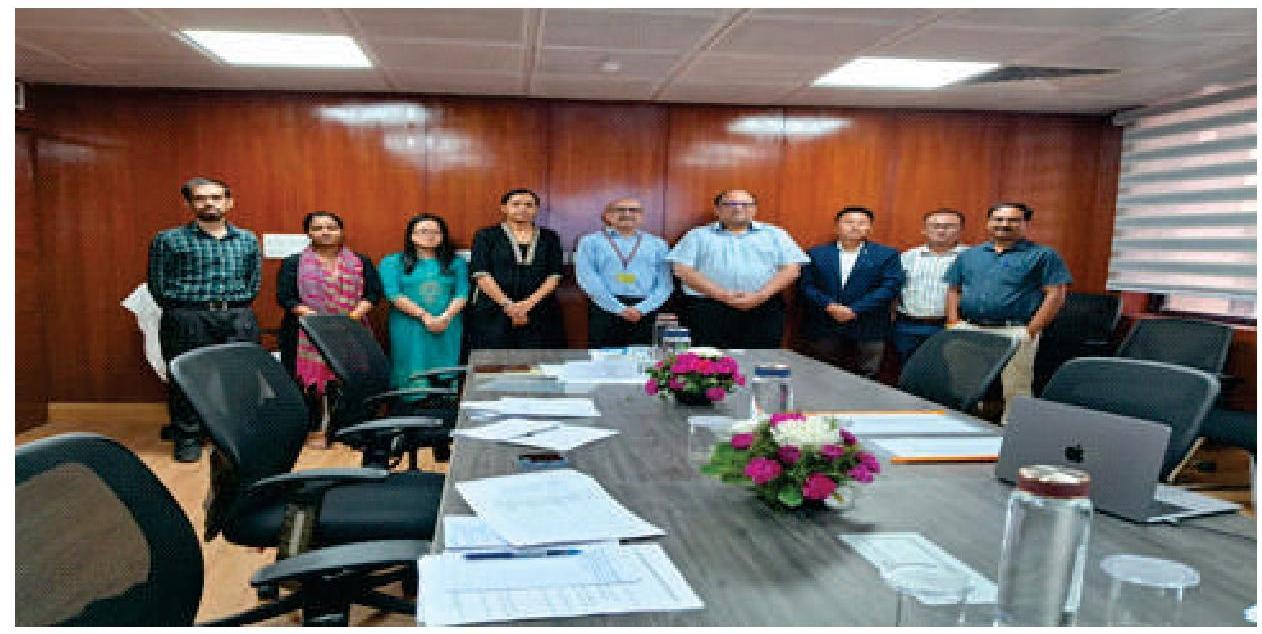
JRM with DES, Arunachal Pradesh held on 16th October,2024
(c) Guidelines of the SSS sub-scheme was revised to facilitate optimum fund availability and utilization by all States/UTs. As per revised guidelines, the implemented States/UTs will be allowed to seek further funds (upto $50 \%$ of their original allocation). With the approval of Hon’ble Minister of State (I/C), MoSPI, the revised guidelines were issued to States/UTs in October, 2024.
(d) A Meeting of State Secretaries (Planning \& Statistics) was held on 14th November, 2024 in Vigyan Bhawan, New Delhi in which a series of technical sessions were held briefing a wide range of initiatives that MoSPI intends to start aiming the strengthening of the National Statistical System. The revised operational guidelines of SSS scheme and the proposed revamping of SSS scheme was one among the key topics.
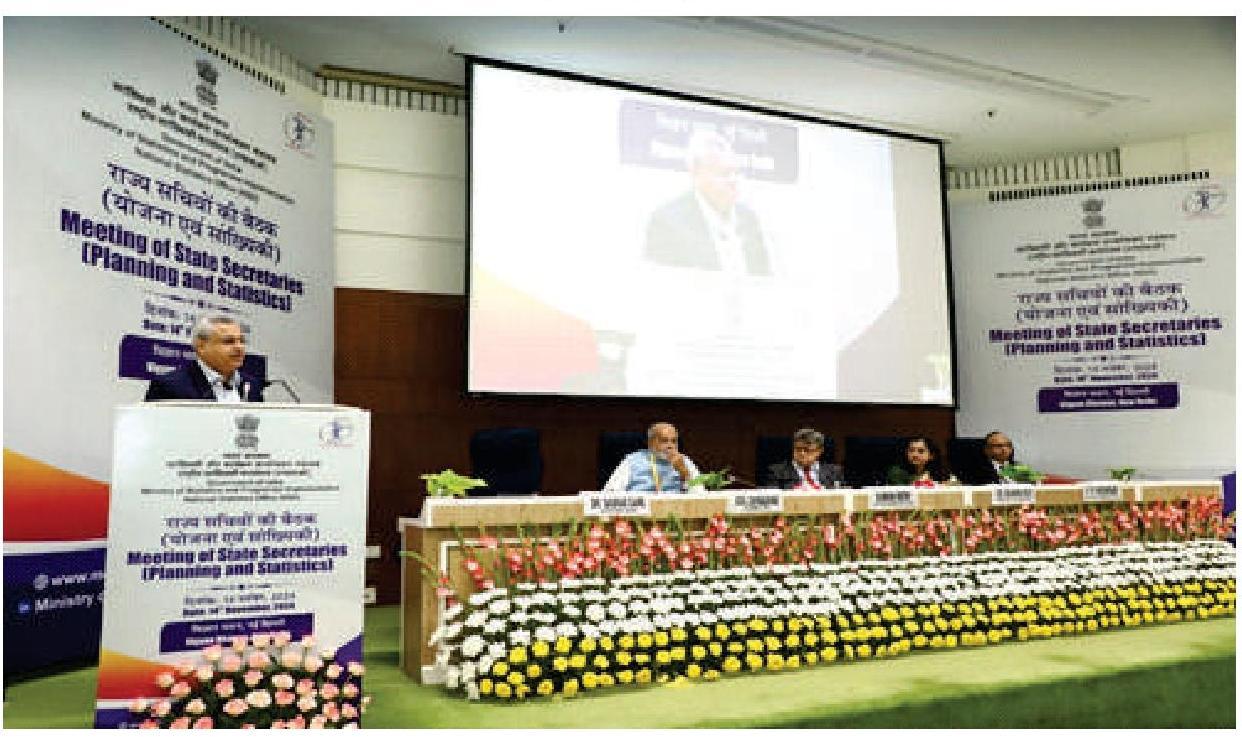
The meeting was graced by Shri Suman Bery, Vice Chairman, NITI Aayog, Dr. Saurabh Garg, Secretary, MoSPI, Shri Adil Zainulbhai, Chairman, Capacity Building Commission and Dr. Shamika Ravi, Member of the Economic Advisory Council to the Prime Minister.
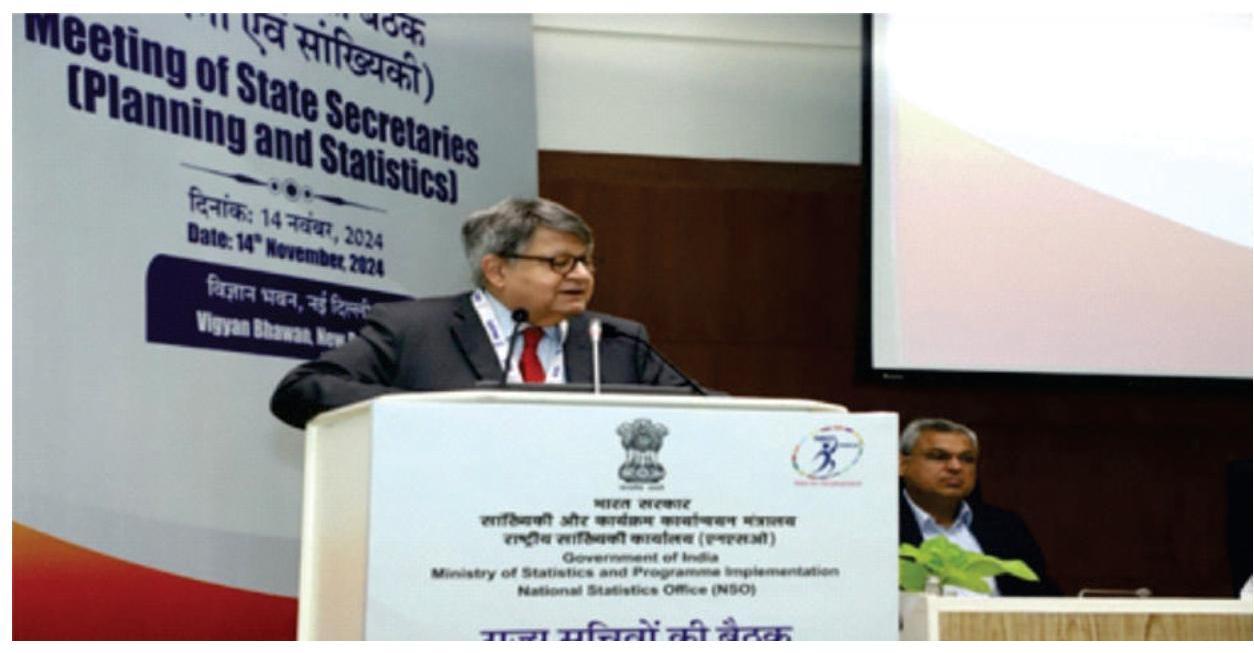
The meeting was attended by the State Secretaries (Planning \& Statistics) of States, Officers from MoSPI including senior officers from State Capital ROs of NSS, NITI Aayog, other representatives from State / UT Governments and representative from the World bank, etc
Chapter 10
Media and Publicity
Media and Publicity Unit (MPU) has been set up in the Ministry to create awareness about the various statistical products being generated by the Ministry and the various initiatives being undertaken by the Ministry through effective communication strategies.
Key Functions and Activities undertaken by MPU in FY 2024-25:
10.1 Advertisements published in the newspaper for enhancing awareness about the statistical products of the Ministry
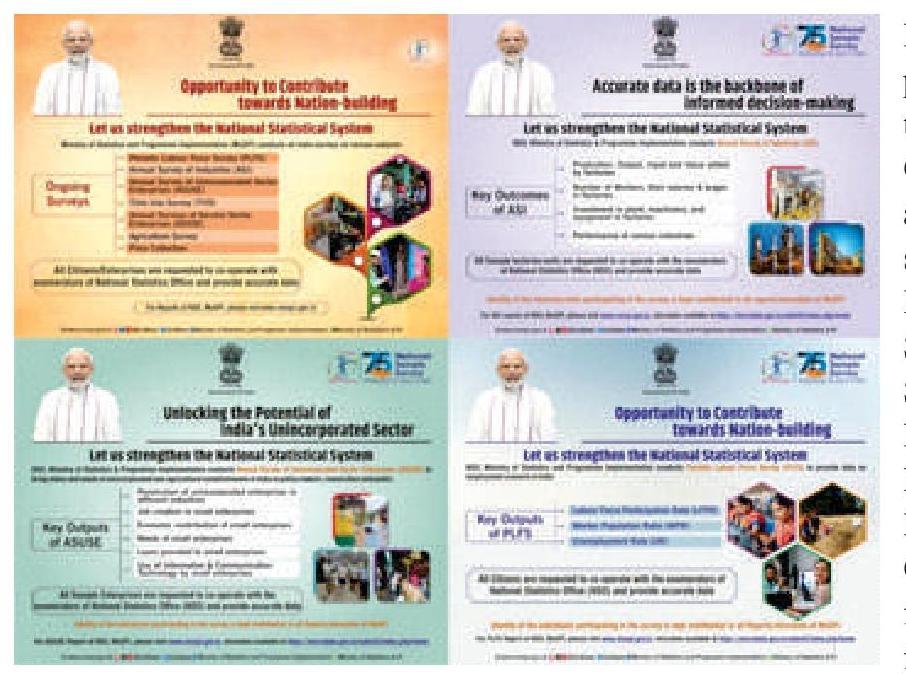
Four advertisements have been published in various newspapers through Central Bureau of Communications (CBC) to raise awareness about the various ongoing surveys of MoSPI like, the Periodic Labour Force Survey (PLFS), Annual Survey of Industries (ASI), Annual Survey of Unincorporated Sector Enterprises (ASUSE), etc. in English, Hindi, and other major regional languages. The advertisement on the Consumer Price Index (CPI) is planned for release in the newspaper in this financial year.
10.2 Enhanced Presence in the Social Media
Informative, analytical posts about various statistical products by the Ministry like Gross Domestic Product (GDP), Index of Industrial Production (IIP), Consumer Price Index (CPI), etc. and survey reports etc. are being disseminated through various social media handles of the Ministry by this unit regularly. Information about different announcements like internships, awards, jobs etc. of the Ministry are disseminated through the social media channels of the Ministry. The data-users’ conferences and other important events of the Ministry have been livestreamed from the social media handles of the Ministry.
Snapshots of MoSPI’s social media posts
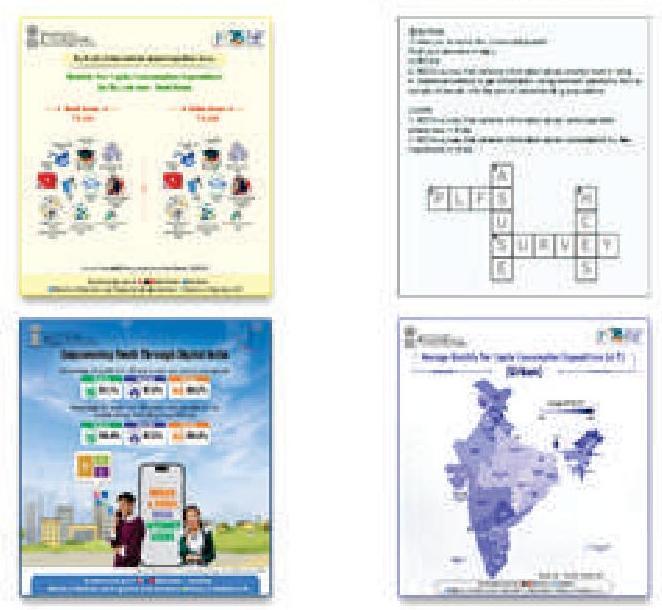
10.3 Production of Radio Jingles for dissemination
To create awareness about the ongoing PLFS and ASUSE surveys of the Ministry, 2 radio jingles in Hindi, English \& 11 other major regional languages have been created by MPU through the empaneled agency of CBC. The radio jingles are planned for release in the financial year.
10.4 Preparation of Advance Release Calendar of various statistical products of the Ministry
Based on inputs obtained from various Divisions of the Ministry, MPU has prepared and released the advance release calendar (ARC) for FY 2024-25 of various statistical products of the Ministry and disseminated it on the website. The ARC of FY 2025-26 is prepared and is planned to be released in FY 2024-25 only.
10.5 Showcasing the work of the Ministry at the India International Trade Fair (IITF) 2024
The Unit executed the conceptualization and fabrication of MoSPI’s first-ever stall at the India International Trade Fair (IITF) 2024. Designing of the all display materials (which included pamphlets, videos etc.) for the panels and screens showcased at the stall was undertaken by the Unit. To engage visitors, the stall featured fun and interactive activities such as the MoSPI quiz, Spin the Wheel, etc.
10.6 Hackathon
A Hackathon on Data Visualization with the title “Innovate with GoIStats” has been planned and scheduled to be organized in this financial year in collaboration with MyGov by this unit. The event aims to create awareness about the data being generated by the Ministry amongst students and researchers of the colleges/universities et. In the country and encourage them to utilize the data for analysis.
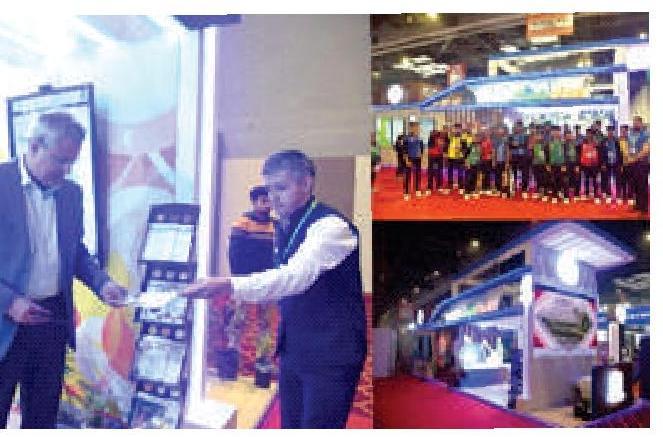
10.7 Coordination with Press Information Bureau (PIB)
The unit works closely with the Press Information Bureau (PIB) to ensure extensive media coverage for the Ministry’s major events and conferences, data releases, etc.
Chapter 11
Members of Parliament Local Area Development Scheme (MPLADS)
11.1 The MPLAD Scheme is a Central Sector Scheme, fully funded by the Government of India. The Scheme was announced on 23rd December, 1993 by the then Prime Minister of India in the Parliament. The main objective of the Scheme is to enable each Member of Parliament to recommend works of developmental nature with emphasis on the creation of durable community assets based on the locally felt needs of the people. Initially, the administration of MPLADS was with the Ministry of Rural Development. However, since October 1994, the administration of the Scheme has been vested with the Ministry of Statistics and Programme Implementation. The scheme is governed by a set of Guidelines, which have been comprehensively revised from time to time. The present Guidelines were released on 22nd February, 2023, which came into effect on 1st April, 2023.
11.2 Salient features of the MPLAD Scheme
i. MPLADS is a Central Sector Scheme fully funded by the Government of India under which Hon’ble Members of Parliament are allocated annual authorization limit at the beginning of each financial year subject to certain conditions.
ii. The basic principle to be followed by the Member of Parliament, the Nodal District Authorities, the Implementing District Authorities and the Implementing Agencies, while recommending and sanctioning the works under the scheme is that it leads to creation of durable public assets for public good of the society at large and does not have any restriction in its access and its usage to any section of the society.
iii. MPLADS funds can be used for creation of immovable public assets on Government owned land, and movable public assets for Government owned and Government controlled institutions only, i.e. the Central, State/UT and local Governments, including Government aided institutions.
iv. MPLADS Guidelines, 2023 provides an indicative list of works that can be taken up under the scheme. However, this list is not exhaustive and new works can be added to the list on the recommendations of a Member of Parliament, if the same complies with overall principles and objectives of the scheme.
v. Any unspent balance out of the annual allocation of a particular Member of Parliament shall be carried forward and added to the annual allocation for that Member of Parliament for the subsequent Financial Year and the drawing limits of his account with Nodal District Authority shall be fixed accordingly.
vi. Under MPLADS, the role of the Members of Parliament is limited to recommending the works. Thereafter, it is the responsibility of the District Authority to sanction, execute and complete the works recommended by Members of Parliament within the stipulated time period.
vii. The elected Lok Sabha Members can recommend works in their respective constituencies. The elected members of the Rajya Sabha can recommend works anywhere in the State from which they are elected. Nominated Members of the Lok Sabha and Rajya Sabha can recommend works, anywhere in the country.
viii. A Member of Parliament can recommend funds only up to ₹ 50 lakhs per year to all Societies/Trusts put together, provided that such Member of Parliament cannot recommend work of more than ₹ 1 crore for any particular Society/Trust during his/her entire term. The limit of ₹ 1 crore will start again on start of a fresh term of the individual concerned as Member of Parliament after their reelection/ nomination.
ix. Any Member of Parliament from anywhere in the country can consent their MPLADS funds up to $\square 1$ Crore per annum for rehabilitation and reconstruction works in areas affected by natural “Calamity of Severe Nature” declared by the Government of India in any part of the country, subject to other provisions of MPLADS Guidelines.
x. When a “Calamity of Severe Nature” has been declared by a State Government through a notification in the official gazette and not by the Government of India, Lok Sabha Members of Parliament from any constituency in that State and any Rajya Sabha Members of Parliament of that State can consent up to a maximum of ₹ 25 lakh per annum in the affected area(s) of the State.
xi. In order to give due attention to the development of infrastructure in the areas inhabited by Scheduled Castes and Scheduled Tribes, Members of Parliament are to recommend every year, works costing at least 15 per cent of the total MPLADS entitlement for the year for areas inhabited by Scheduled Caste population and at least 7.5 per cent of the total MPLADS entitlement for the year for areas inhabited by Scheduled Tribe population.
xii. An elected Member of Parliament can also recommend works anywhere in the country outside the usual region in which he/she can recommend work as mentioned in Para 3.1.2.1 of the MPLADS guidelines subject to the ceiling of ₹ 50 lakh in a financial year per Member of Parliament for all such recommendations, except in case of calamity.
xiii. The guidelines have a provision to provide assistance to individual differently abled persons by providing them prosthetics, wheelchairs, tricycles (manual or motorized), electric scooties, hearing aids and other such devices.
xiv. The MPLADS funds, including those for the works to be executed for Trust, Societies and Cooperative Societies, can be pooled with individual/stand-alone projects of other Central and State Government schemes, as well as with that of local bodies, provided such works are otherwise eligible under MPLADS Guidelines.
xv. The Project Management Unit under MPLADS Division (PMU-MPLADS) of Ministry of Statistics and Programme Implementation has been designated as Central Nodal Agency for implementation of the Scheme. The actual fund shall only be with Central Nodal Account and fund will be directly credited to vendor’s account as and when the demands are raised electronically.
xvi. The roles of Central Government, State Government, District Authorities and Implementing Agencies have been clearly defined in the MPLADS Guidelines, 2023 for implementation of MPLAD Scheme. The MPLADS Guidelines are available at Ministry’s website: mplads.gov.in
xvii. Trust, Society, Cooperative Society, Bar Association, Gram Panchayat, ULB, etc as selected by the Implementing District Authority are eligible to directly execute the recommended and sanctioned work of MPLADS and is referred to as Sub-Agency.
xviii. The fund flow procedure under the MPLAD Scheme has been revised w.e.f. 1st April 2023, wherein virtual drawing limits are allocated for incurring expenditure. Now, the fund will directly flow from the Central Nodal Agency Account to the vendor on real time basis only at the time of payment based on the principle of ‘Just in time release’, thereby resolving the issue of parking of funds.
xix. A new Web-Solution has been launched to implement the revised fund flow procedure. The entire process of fund flow now operates on an IT platform through the Web-Solution, which allows all the stakeholders to monitor in real time, the status of funds and works.
Scheme Performance
Physical Performance
11.3 Since inception, the Scheme has benefited the local community by meeting various developmental needs such as drinking water facility, education, electricity, health and family welfare, irrigation, nonconventional energy, community centers, public libraries, bus stands/stops, roads, pathways and bridges, sports, etc. These works are sanctioned, executed and monitored as per the provisions of the MPLADS Guidelines.
Since the inception of the scheme and as per information provided by the District Authorities through MPLADS (old) portal as on 31st December, 2024,
- 26,03,283 works have been recommended by MPs
- 22,99,962 works have been sanctioned out of these recommended and taken up for implementation
- 20,90,818 works have been completed and assets made available for utilization by the local communities.
After the implementation of revised fund flow system through eSAKSHI Portal during 1st April, 2024 to 31st December, 2024.
- Authorization Limit of ₹ 4063.00 Crore (including admin funds) under MPLAD Scheme.
- 24997 works costing ₹ $1695,26,22,472.36$ recommended by Hon’ble MPs
- 33873 works costing ₹ 1909,43,17,450.51 have been sanctioned by the District Authorities; and
- 12853 works costing ₹2237,69,00,780.08 have been completed by the Executing Agencies.
Financial performance
11.4 Since the inception of the scheme, an amount of ₹59505.73 crore has been released to Members of Parliament before the launch of eSAKSHI portal (Refer Graph for year-wise release of funds).
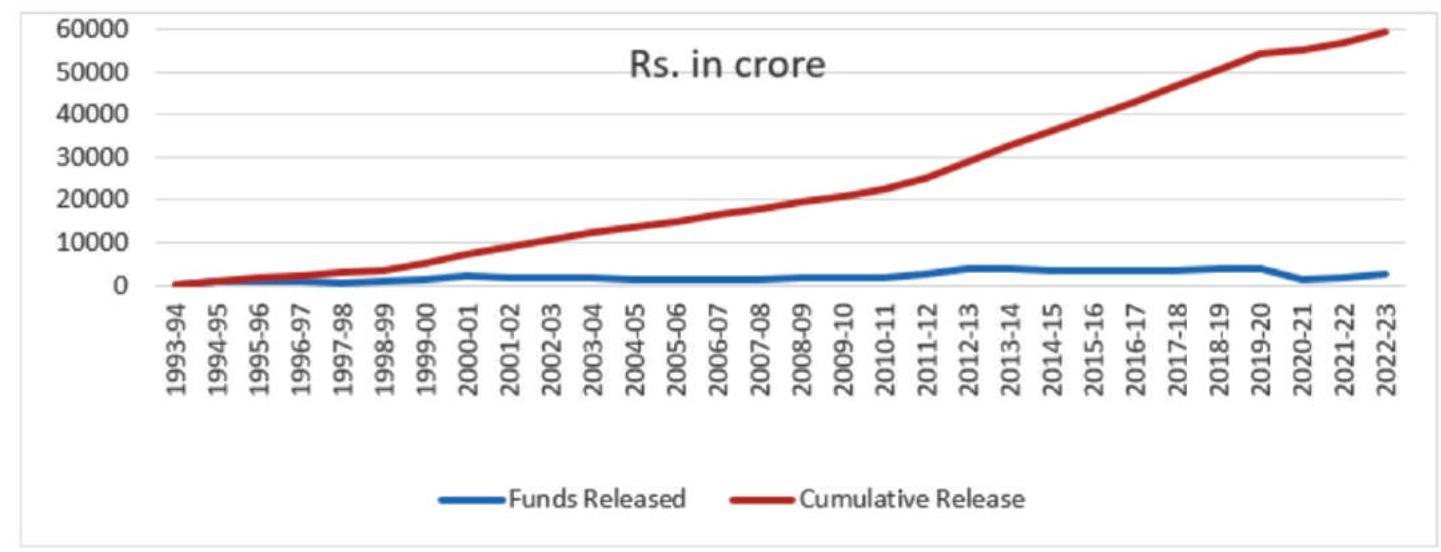
11.5 Since the inception of the Scheme, funds amounting to ₹ 59,505.74 crore have been released by the Ministry till 31st March, 2023 and an expenditure of ₹ 59,250.75 crore has been incurred. 99.57 per cent of the amount released has since been spent under the scheme since inception.
11.6 The expenditure of ₹ $3484,39,13,384.63$ was done till 19th January, 2025 and ₹3317,76,92,934.52 expenditure was done till 31st December, 2024 since the launch of eSAKSHI portal and implementation of revised fund flow system.
Revised MPLADS Guidelines and New Fund Flow Procedure
11.7 With the objective of making the scheme more flexible, efficient and effective and to bring it in line with the changing development needs of the community, a revised set of Guidelines have been released on 22nd February, 2023, which came into effect from 1st April, 2023. eSAKSHI portal has been developed by the Ministry in collaboration with State Bank of India to implement revised fund flow procedure under MPLADS with effect from 1st April, 2023 in line with the directions of the Ministry of Finance.
11.8 Under the Revised Fund Flow Procedure, Members of Parliament will not be required to wait for the actual fund to be released by the Ministry before recommending new projects as they will be allocated annual drawing limits at the beginning of each financial year subject to certain conditions. The entire process of fund flow would operate on an IT platform viz. eSAKSHI which allows all the stakeholders, including Members of Parliament, the Central and State Government agencies, the district authorities, etc. to monitor the status of funds and works on real time basis, which would facilitate effective implementation of projects under MPLADS and also bring in greater transparency and accountability in the system.
11.9 As per the information received from the Districts, an expenditure of ₹ 60610.69 crore has been incurred under the scheme up to 31st March, 2024, of which ₹ 1089.94 crore have been spent through the eSAKSHI portal during 2023-24.
Launch of eSAKSHI Mobile App
11.10 The Ministry launched the e-SAKSHI mobile application on 16th January, 2024, which offers accessibility and convenience to the Hon’ble MPs to propose, track and oversee the projects in real-time, enhances decision-making processes, enabling swift responses to emerging needs or issues. The mobile app would provide the Hon’ble MPs with instant updates on the status and progress of their proposed projects
and will also streamline communication between MPs and relevant authorities, facilitating a more efficient exchange of information.

11.11 This transparency not only fosters accountability but also instills public trust in the allocation and utilization of MPLADS funds. The mobile application also has the features for budget management facilitating monitoring of expenditure by MPs. The overall improvement in the implementation of MPLAD Scheme is attributed to the synergy attained by the cooperation of different stakeholders and operational experience gained over years, active participation and monitoring. The entire process of recommendation under the revised guidelines will operate through the web portal as well as mobile application. This innovative technology solution aims to enhance transparency, accessibility, and efficiency in the execution of MPLAD scheme.
11.12 The MPLADS Division has also signed an MoU from 1st April, 2024 to 31st March, 2025 with banking partner SBI after approval of DoE on 16th November, 2023 that MoSPI may continue implementing MPLAD Scheme as per Model-2 of DoE’s guideline till 31st March, 2025.
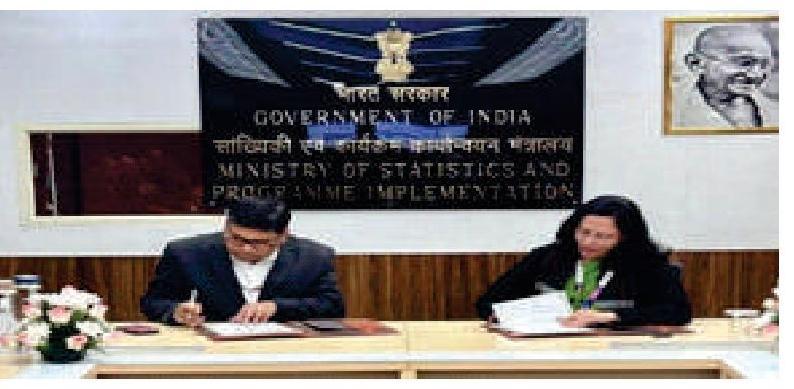
Monitoring and Training
11.13 Since the launch of eSAKSHI portal and implementation of revised fund flow system, the Ministry has conducted 50 Workshops/trainings, 39 Physical Workshops and 11 Online Webinars for the stakeholders of the MPLAD Scheme, including Hon’ble MPs, District Authorities, Implementing Agencies, State Nodal Department and representatives of the Hon’ble MPs in States/UTs for the smooth functioning of the entire ecosystem of the Scheme. A number of changes/enhancements in the functionalities of the portal have also been done based on the feedback and user experiences shared by various stakeholders. A dedicated helpdesk number for Hon’ble MPs and customer care number are also available for all stakeholders to raise their issues, which are resolved promptly. Additionally, this Ministry has also been setting up a help desk during Parliament Session to facilitate necessary information to Hon’ble MPs and their PAs regarding New MPLADS Guidelines and fund flow system through web-application and to resolve their queries instantly.
11.14 In addition, a dedicated $24 \times 7$ helpdesk, (1800113702) has been set up for addressing/resolving issues related to e-Sakshi Portal. Additionally, Kiosks/booths has been set up during all Parliament Sessions since Monsoon Session of 2023 and to facilitate necessary information to Hon’ble MPs and their PAs regarding New MPLADS Guidelines and fund flow system through web-application and to resolve their queries instantly relating to portal overview, funds release, login issues and IDA related issues, etc.
11.15 The MPLADS Division has also conducted Workshop/Hands-on training on 20th June, 2024 and 21st June, 2024 for master trainer for different States/UTs to develop the capacity of the officers/officials/DEOs of State/UTs for efficient implementation of the scheme through CNA.

11.16 The MPLADS Division of this Ministry has also set up Kiosk soon after announcement of General Election for 18th Lok Sabha to familiarize newly elected MPs about the MPLAD Scheme and eSAKSHI portal and opening their account in the portal.
11.17 The MPLADS Division along with the Secretary and Additional Secretary of MoS\&PI has also attended the orientation programme organized by Lok Sabha Secretariat held on 10th August, 2024. A brief information related to MPLAD Scheme, its Guidelines and eSAKSHI portal through PPT was provided to the newly elected Members of 18th Lok Sabha. Moreover, all queries were also resolved and clarification provided.
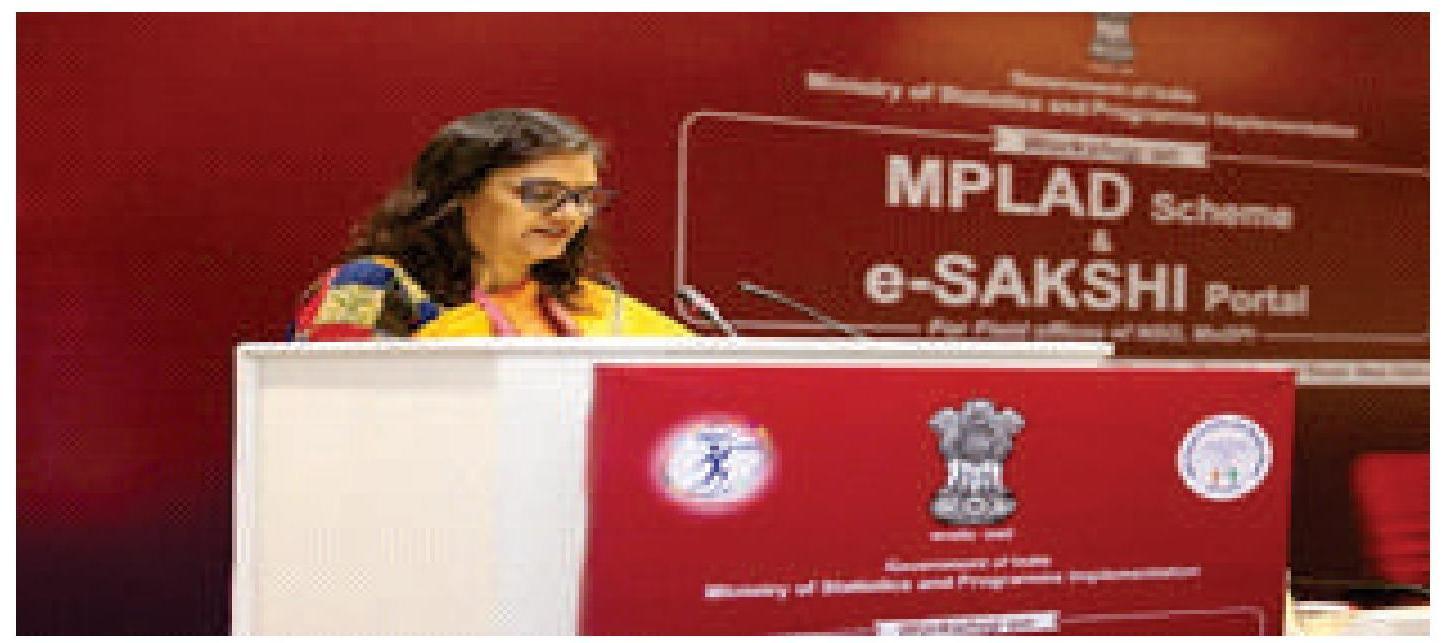
11.18 The MPLADS Division has also conducted a workshop in New Delhi on 13th November, 2024 for the State Capital Regional Offices and Zonal Offices of the NSO Field Operation Division. The objective of the workshop was to enhance understanding and establish a roadmap for coordination and monitoring with the State Nodal Authority and District Authority under the MPLADS Scheme, as well as to introduce the new fund flow system on the e-SAKSHI portal.

11.19 The MPLADS Division has hired Agencies for Third Party Physical Evaluation and Monitoring of MPLADS works executed from MPLADS Funds for the Period from 2019 to 2024 and also impact evaluation of the Scheme from 2009 to 2024. The Monitoring work and impact evaluation is to be carried out in 504 Nodal Districts in all the 4 Zones i.e. North, North-East \& East, West and South zones all across the country.
Chapter 12
Infrastructure and Project Monitoring
12.1 The Infrastructure Projects Monitoring Division (IPMD) of MoSPI undertakes the monitoring of projects above ₹ 150 crore. As per Government of India (Allocation of Business) Rules, 1961, this division of Programme Implementation (PI) wing of MoSPI is mandated to fulfill the following:
- Project Monitoring – Monitoring of projects of ₹ 150 crores and above
- Performance Monitoring – Monitoring of the performance of Infrastructure Sectors
Project Monitoring
12.2 IPMD performs the implementation status of Projects above ₹ 150 crore through the project related data of Ministries/Departments/PSUs captured through the Online Computerized Monitoring System (OCMS) of MoSPI. A range of parameters are captured through OCMS in respect of the progress of the projects, financial parameters (cost and expenditure related), reasons/ issues accounting for slippages in the projects with respect to the planned schedule and original cost. Based on the aforementioned project data, MoSPI analyses the time and cost overrun of the projects and releases a monthly Flash Report (FR) and a Quarterly Project Implementation Status Report (QPISR).
12.3 Through constant persuasion with the line ministries on the matter of project reporting of projects by the implementing agencies on the OCMS portal, a significant increase in the reporting of Central Sector Projects on the portal has been achieved. Presently, the reporting percentage stands at over 90 per cent.
12.4 One of the significant contributions of the IPMD has been implementing systemic improvements periodically to expedite the project implementation. The IPMD serves as a crucial facilitator in identifying projects falling behind schedule or experiencing cost overruns during the regular project review meetings with the respective Administrative Ministries. This process assists Administrative Ministries in pinpointing project constraints and implementing corrective measures to address bottlenecks effectively.
12.5 As of 1st December, 2024, 1742 projects, costing approximately ₹31.03 lakh crore are on the monitor of MoSPI. While 882 projects are experiencing delays, project implementing agencies have reported a total cost overrun of ₹ 5.01 lakh crore in 435 projects. The cumulative expenditure for the 1742 ongoing projects up to November, 2024 was ₹ 16.52 lakh crore, of which ₹ 2.16 lakh crore was spent during the current year 2023-24. During the period January 2024-November 2024, a total of 295 projects have been reported completion at a cost of ₹ 1.92 lakh crore.
12.6 Additionally, the data collected through the OCMS portal is utilized to generate inputs for several high-level meetings, including the PRAGATI monthly review, the Prime Minister’s State visits, for addressing Parliamentary Questions and requests under the Right to Information (RTI), Act.
No of Projects and Expenditure
12.7 The graph illustrates the number of projects and expenditure incurred till the end of the respective month
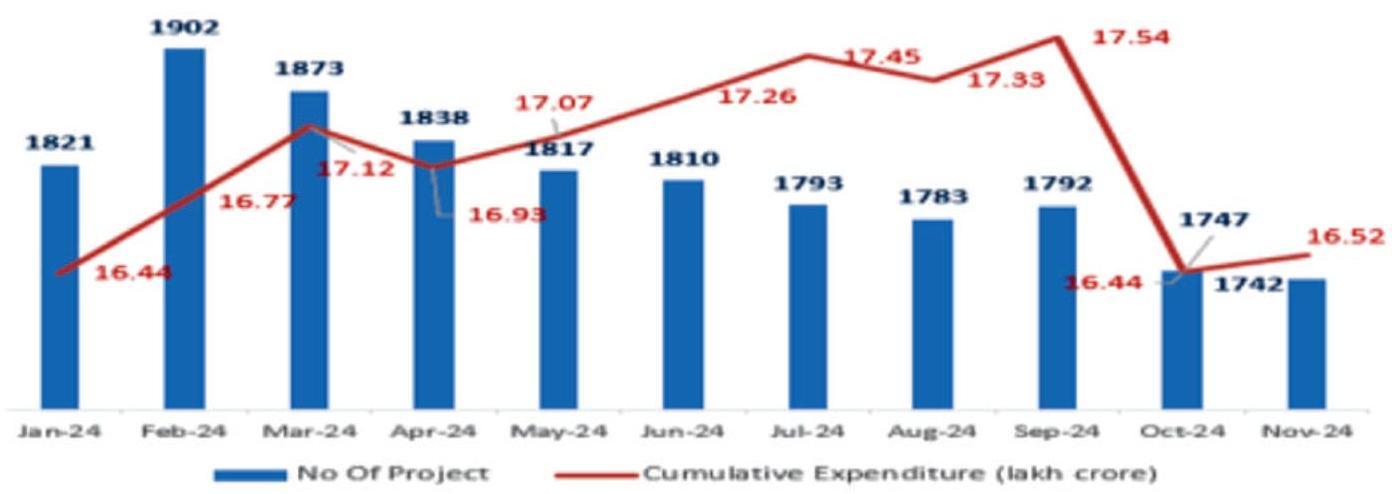
12.8 The graph below illustrates the number of projects completed and added during January, 2024November, 2024.
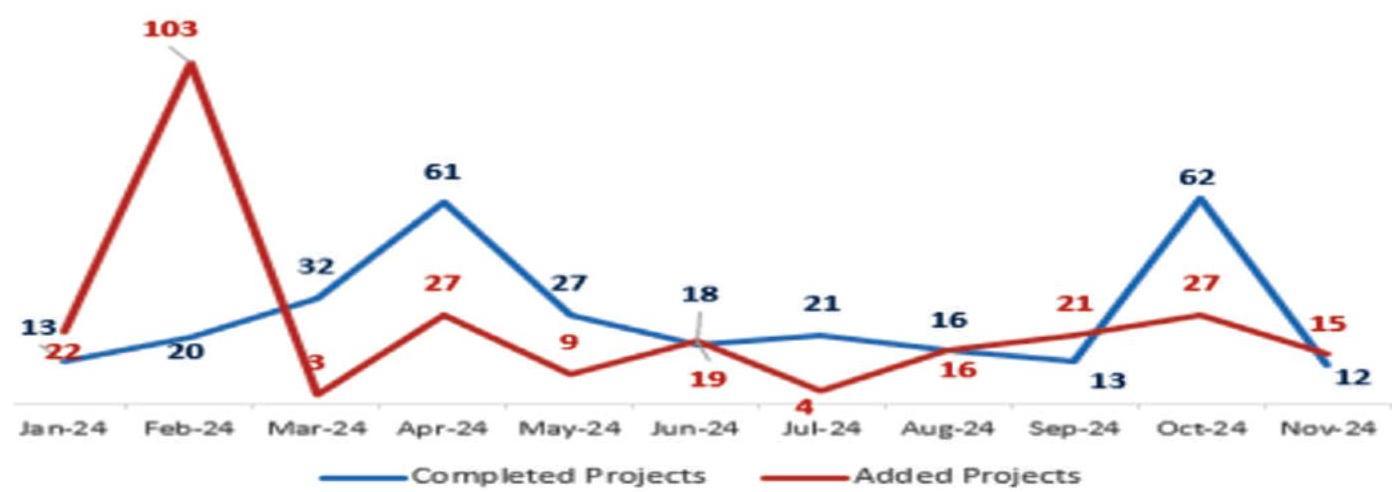
12.9 This Ministry has formulated a comprehensive note for streamlining the Project Monitoring mechanism by introducing uniformity in the concepts/definitions of key monitoring metrics across all the line ministries/ Project Implementing Agencies/ Project Monitoring entities. This has been achieved by introducing ‘Project Start date’ \& ‘Tender award date’ in addition to the previously existed Project Sanction Date which would facilitate the unambiguous cross-sector comparison. In addition, the concept of Milestone level monitoring is introduced in the Pre-construction stage to identify any slippage before costs or timelines exceed approved limit.
12.10 Project and Performance Monitoring Unit (PPMU) comprising personnel of domain expertise has been established from January, 2025 onwards for introducing the Cluster-based (group of sectors) Project \& Performance Monitoring. This is of the view to strengthen the Infrastructure excellence across four pillars namely Project Appraisal, Project Monitoring, Performance Monitoring, and Capacity Building of Stakeholders.
Performance Monitoring – Monitoring of the performance of Infrastructure Sectors
12.11 The IPMD also reviews the performance of 11 key infrastructure sectors including Power, Cement, Coal, Steel, Railways, Shipping and Ports, Fertilizers, Petroleum and Natural Gas, Civil Aviation, Roads and Telecommunication with reference to their pre-set targets for the period and achievement there against. An analysis of the information received from these Ministries/ Departments is fed in an intranet-based application for generating monthly Infrastructure Performance Review Report. The reports prepared are published on MoSPI website.
12.12 During FY 2024-25, the percentage of achievement relative to target values across various sectors is illustrated below:
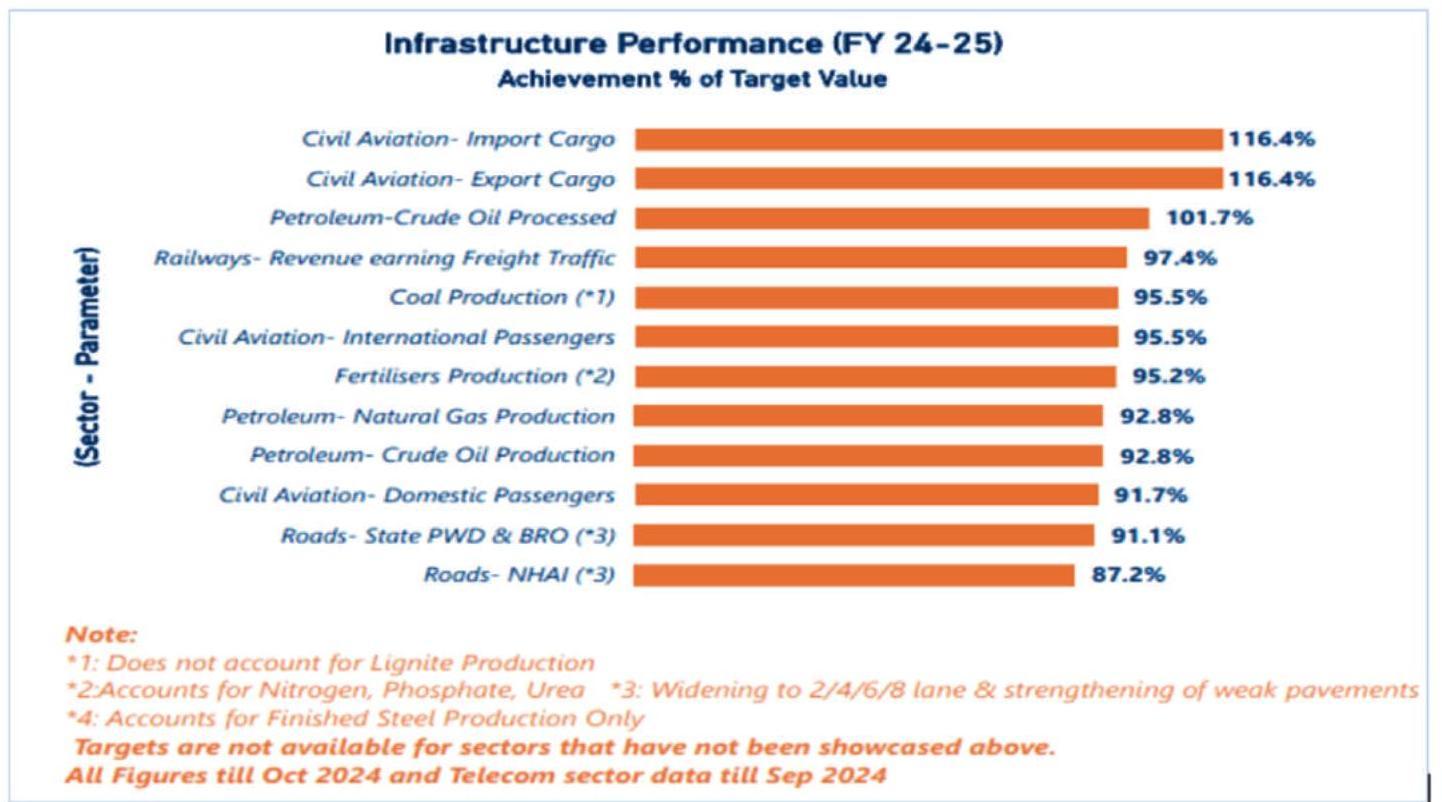
Appraisal \& Approval (A\&A) of Projects
12.13 IPMD also provides inputs for the appraisal of projects undertaken by the Public Investment Board (PIB), Delegated Investment Board (DIB), Cabinet Committee on Infrastructure for Appraisal \& Approval (A\&A), Expanded Board for Railways (EBR), and for EFC and SFC appraisals.
Trainings in Project Monitoring
12.14 IPMD organizes training programmes on ‘Project Planning and Management’ for capacity building of various stakeholders (Line Ministries/Departments/CPSEs Implementing agencies of projects) in collaboration with institutes of repute. One Strategic-level training was successfully conducted from 18th 22nd November, 2024 at IIM, Kozhikhode, covering varied topics related to Project Management in practice, planning, scheduling, resource allocation \& costing, monitoring \& control, risk management, project management simulation, project auditing, project communication, reporting, etc. The training programmes attended by 28 Director/DS/US level officers or equivalents from 11 Ministries/ Departments and 8 PSU/CPSEs.
Projection of next three months (January, 2025-March, 2025)
| Action items | January, 2025 | February, 2025 | March, 2025 |
|---|---|---|---|
| Monthly Flash Report (FR) on Central Sector Infrastructure Projects | December, 2024 | January, 2025 | February, 2025 |
| Quarterly Project Implementation Status Report (QPISR) |
3rd QPISR (Oct-Dec 2024) | – | – |
| Monthly Performance Review Report |
November, 2024 | December, 2024 | January, 2025 |
| Trainings on Project Planning and Management | Strategic-level training planned to be convened during 20th – 24th January at IIM Kozhikhode | 2 Operational- level training programmes are planned to be convened. | |
| 12-week study on Performance Monitoring and strengthening measure of Infrastructure Statistics | NIPFP, Delhi has taken up the study for detailed roadmap formulation on the subject w.e.f 06th January, 2025 in consultation with MoSPI and other stakeholders | Likely to be completed by the end of March, 2025 | |
| Launch of New OCMS Portal – strengthening of Infrastructure Project Monitoring | Launch of the Phase-I of the new OCMS-API cloud-based application by end of January, 2025 | – | – |
Chapter 13
National Statistical Commission
13.1 Followed by the decision of the Cabinet on the recommendations of the Rangarajan Commission, which reviewed the Indian Statistical System in 2001, Government of India through a Resolution dated 1st June, 2005 decided to set up the National Statistical Commission (NSC) and the NSC was constituted on 12th July, 2006 with a mandate to evolve policies, priorities and standards on statistical matters. The resolution has undergone several revisions, which are summarized in the resolution dated 5th Nov., 2019. NSC has a part-time Chairperson and four part-time Members, each having specialization and experience in specified statistical and allied fields. Besides, Chief Executive Officer of the NITI Aayog is the ex-officio member of the NSC. The tenure of a part-time Chairperson/Member is three years. The Chief Statistician of India is the Secretary to the NSC.
13.2 The names of the part-time Chairperson and part-time Members of the NSC as on 31st March, 2024 are as follows:
| S.No. | Name \& Designation | Tenure up to |
|---|---|---|
| 1 | Prof. Rajeeva Laxman Karandikar, Chairperson | 8th Dec., 2022 – 7th Dec., 2025 |
| 2 | Prof. Mukesh Mohania, Member | 1st Dec., 2022 – 30th Nov., 2025 |
| 3 | Shri Asit Kumar Sadhu, Member | 5th Dec., 2022 – 4th Dec., 2025 |
| 4 | Prof. A. Ganesh Kumar, Member | 18th Mar., 2024 – 17th Mar., 2027 |
| 5 | Prof. Debasis Kundu, Member | 19th Mar., 2024 – till attaining age of 65 years |
13.3 The functions of the NSC are laid down in the Government of India Resolution dated 5th November, 2019.
13.4 The 133rd Meeting of National Statistical Commission was conducted on 28th August, 2024. This was chaired by Chairman, NSC – Prof. R. L. Karandikar. Other Members of NSC namely, Professor A. Ganesh Kumar, Professor Debasis Kundu, Shri Asit Sadhu and Professor Mukesh Mohania were also present. Secretary, MoSPI as Secretary to the Commission placed the following agenda for discussion and deliberations:
i. Confirmation of the Minutes of the 132nd Meeting of the NSC.
ii. Action Taken Report (ATR) on Minutes of the 132nd Meeting.
iii. Placing of the minutes of the Steering Committee.
iv. Review of status of implementation of recommendations made by the Rangarajan Commission.
v. Report of the Committee for determination of sample size for sub-State level Estimates.
vi. Report of the Committee for Evolving a Good Calibration Technique for NSS estimates.
vii. Concept note on examining the issue of Replacing UFS Blocks with the blocks formed by other govt. departments.
13.5 The 134th Meeting of the National Statistical Commission was conducted on 8th November, 2024. This was chaired by Chairman, NSC – Prof. R. L. Karandikar. Other members of NSC namely, Professor A. Ganesh Kumar, Professor Debasis Kundu and Shri Asit Sadhu were also present. Dr. B. V. R. Subrahmanyam, CEO, NITI Aayog, Dr. O. P. Mall, Advisor, Reserve Bank of India and representative

from the Office of Chief Economic Advisor participated in the NSC meeting. Secretary, MoSPI as Secretary to the Commission placed the following agenda for discussion and deliberations:
i. Confirmation of the Minutes of the previous meeting.
ii. Action taken on decisions of the last meeting.
iii. Status updates on the Base Year Revision of National Accounts Statistics, Consumer Price Index and the Index of Industrial Production.
iv. Status of the 8th Economic Census.
v. Briefing on the proposal of the Data Innovation Lab.
vi. Brief and takeaways/future roadmap from Conference of Central and State Statistical Organizations (CoCSSO).
vii. Brief on suggestions/recommendations provided by various stakeholders in the Data User Conferences.
viii. IIStatus on restructuring of Survey Verticals in MoSPI and the roles of restructured Divisions.
ix. Brief status on revision of ‘Data Dissemination Guidelines’.
x. Presentation on the Panchayat Development Index (PDI) by Ministry of Panchayati Raj.
13.6 In addition, the Minutes of the Third and Fourth Steering Committee Meetings were also placed before the Commission for appraisal.
13.7 The 135th Meeting of the National Statistical Commission chaired by Chairman, NSC – Professor R.L. Karandikar was held on 12th December, 2024. Members of the Commission Shri Asit Sadhu, Professor A. Ganesh Kumar and Professor Mukesh Mohania and Dr. Saurabh Garg, Secretary, MoSPI were present. Representatives from Niti Ayog, RBI and Office of Chief Economic Advisor also participated in the meeting. The issues discussed during the meeting included initiatives undertaken by Research and Analysis Unit of MoSPI, Quality Assessment Framework for statistical products and the reform initiatives of the National Statistical System.

Chapter 14
Indian Statistical Institute
14.1 In the early thirties, realizing the necessity for advancement of theoretical and applied statistics in India, the Indian Statistical Institute came into being following the pioneering initiative and efforts of Professor P.C. Mahalanobis. The Indian Statistical Institute was registered on 28th April, 1932 as a nonprofit distributing learned society under the West Bengal Societies Registration Act, XXI of 1860. From the beginning, the Institute started showing its excellence in its own way. As the Institute expanded its research, teaching, training and project activities, it started earning national/international recognitions. The outstanding contributions made by the Institute in theoretical and applied statistical work culminated in the recognition of the Institute as an “Institution of National Importance” by an Act of the Parliament, known as “Indian Statistical Institute Act No. 057 of 1959”, which conferred on the Institute the right to hold examinations and award degrees/diplomas in Statistics. Significantly, Pandit Jawaharlal Nehru, the then Prime Minister of India, himself piloted the bill in the Parliament in 1959. As a result, degree courses leading to Bachelor of Statistics (B. Stat.) and Master of Statistics (M. Stat.) and Post Graduate Diplomas in SQC \& OR and Computer Science were started from June 1960. The Institute was also empowered to award the Ph.D./ D.Sc. Degree from the same year. Subsequently, Master of Technology (M. Tech.) courses in Computer Science (CS) and in Quality, Reliability \& Operations Research (QROR) were also introduced.
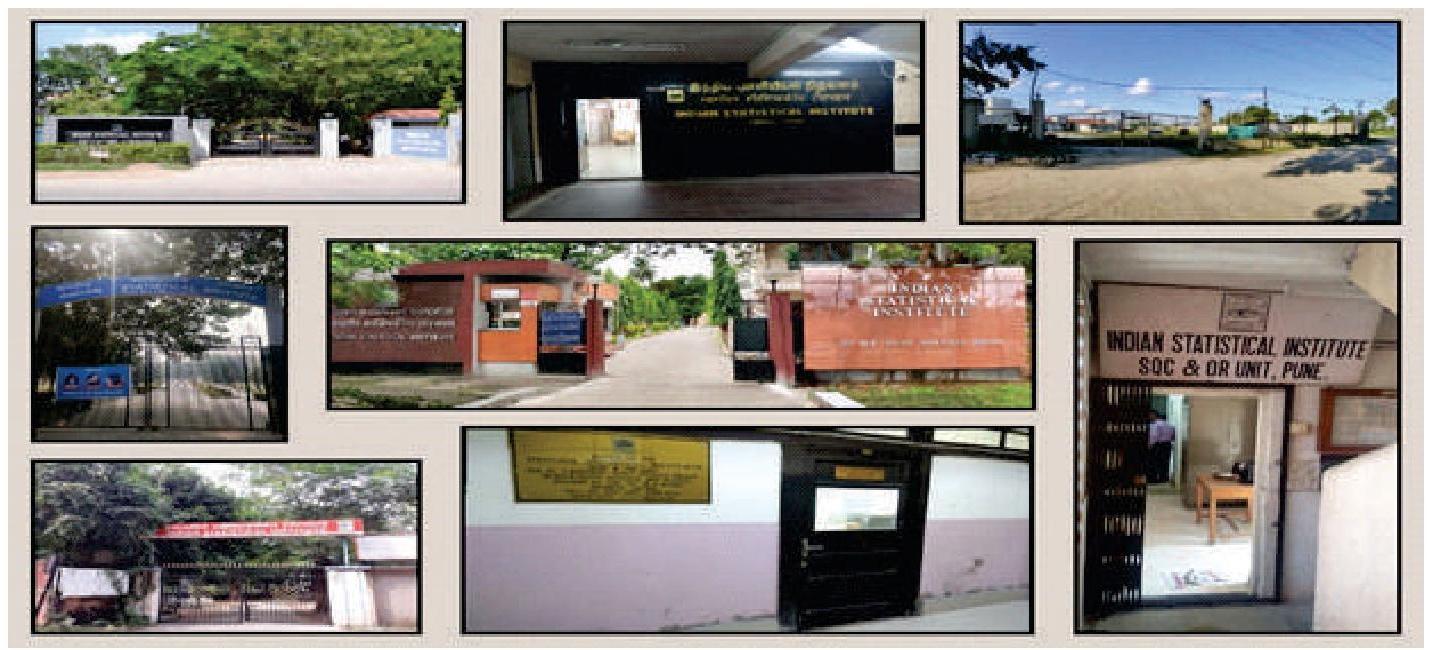
Various offices of ISI across the country
14.2 Scope was further enlarged as the Institute was empowered to award/degrees/diplomas not only in Statistics but also in Mathematics, Quantitative Economics, Computer Science and such other subjects related to Statistics by virtue of “Indian Statistical Institute (Amendment) Act, 1995, No. 38 of 1995” by the Parliament, which gave greater encouragement to research activities not only in Statistics and Mathematics but also in various branches of Computer and Communication Sciences, Natural and Social Sciences, Physics and Earth Sciences, Biological Sciences, Statistical Quality Control \& Operations Research, Library and Information Sciences in a broader way. Over the years, the Institute has been playing a key role in the development of statistical theory and methods by promoting research and practical applications in
different areas of natural and social sciences. “Sankhya – The Indian Journal of Statistics”, being published by the Institute since 1933, is still considered as one of the leading statistical journals of the world. Pioneering research activities were carried out in many areas of statistical theory, especially in the core areas of multivariate analysis, sample surveys and design of experiments. Such activities were strengthened and new directions were opened up by Professor C.R. Rao and many others who joined the Institute in nineteen forties and the tradition continues. Research in economics was greatly stimulated when the then Prime Minister of India, Pandit Jawaharlal Nehru entrusted the preparation of the draft Second Five-YearPlan of the country to Professor Mahalanobis and the Institute in the year 1954. The “Draft” submitted by the Institute under the leadership of Professor Mahalanobis with the planning models have since been regarded as major contributions to economic planning in India
14.3 In the field of Computer Science, the Institute has a rich tradition. In 1953, a small analog computer was designed and built in the Institute. In 1956, the Institute acquired a HEC-2M machine from the U.K., which was the first digital computer in India. In early sixties, the Institute, in collaboration with the Jadavpur University, undertook the design, development and fabrication of a fully transistorized digital computer, called ISIJU-1, which was commissioned in 1966 by Shri M. C. Chagla, the then Minister of Education, Government of India. High quality research, publication and development in the different branches of computer sciences had been carried out by the internationally acclaimed computer scientists of the Institute over the last six decades and their concerted efforts have placed the Institute in the forefront in national and international scenario.
14.4 The ISI also played a pioneering role in starting the Statistical Quality Control (SQC) movement in India by organizing a visit of Professor W. A. Shewhart, the father of SQC, to India in November, 1947 and later by inviting other experts like Dr. W. E. Deming, Dr. Ellis R. Ott, Dr. H. C. Tippet and Dr. Genichi Taguchi for the same purpose. SQC promotional work of the Institute then gradually spread all over the industrial hubs in India under a comprehensive programme covering education and training, applied research and consultancy services. The Institute also became a permanent member of “Quality Council” of India.
14.5 From the early days, the Institute has been interacting with many internationally reputed scientists in different disciplines from the world over. Some of these scientists have worked in the Institute for several months or even longer. Sir Ronald A. Fisher, a pioneer of modern statistics, was a regular visitor and lent considerable support to the Institute. Professor J. B. S. Haldane, a geneticist of international repute, was a member
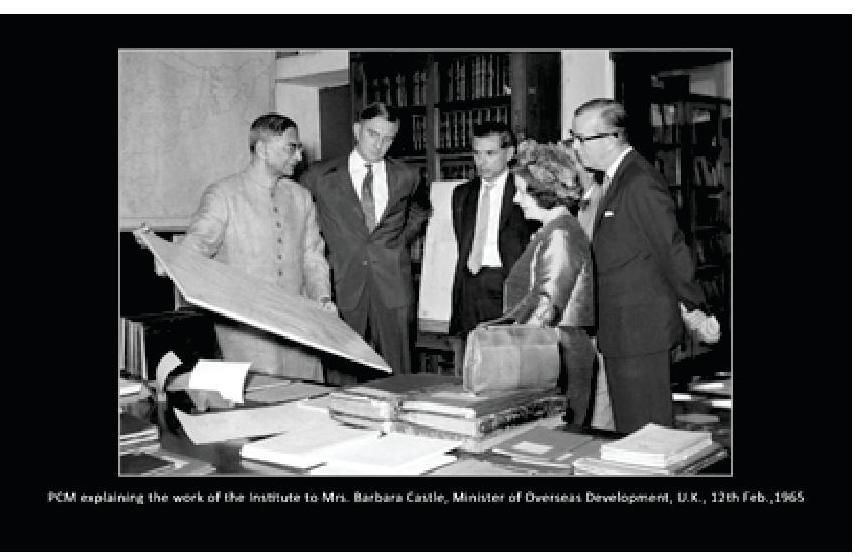
of the faculty for several years beginning 1957. The celebrated mathematician, Norbert Wiener visited the Institute twice in 1954 and again in 1955-56. The other academic personalities whose longer visits influenced the development of the Institute include the Statisticians like Harold Hotelling, Frank Yates, Herman Wold, Edwin Harper (Jr.), H. Cramer and Peter J. Bickel, David Cox; the Mathematicians like A. N. Kolmogorov,
Yu, V. Linnik, J. L. Doob and thereafter Vaughan F. R. Jones, Lotfi A. Zadeh; Statistical Quality Control experts like Walter Shewhart and G. Taguchi; Economists like Simon Kuznets, Paul A. Baran, Joan Robinson, Jan Tinbergen, Nicholas Kaldor, R. M. Goodwin, Ruth Glass and J. K. Galbraith and more recently, Amartya K. Sen, Robert Aumann, Joseph E. Stieglitz, James A. Mirrlees, Eric Stark Maskin, Eiichi Negishi, Ada Yonath, David Jonathan Gross, Joachim Frank, Sir David John Spiegelhalter, Trevor John Hastie; Geologist like Pamela Robinson; Biochemists like N. W. Pirie and Linguists like D. Kostic. All along the Institute has tried to live up to Ronald Fisher’s dictum that Statistics is a “Key Technology” in view of its intimate relevance to all scientific endeavours, which involve experimentation, measurement and inference from sample to aggregate.
Various activities organized in ISI during the year:
(i) Vigilance Awareness Week 2024.
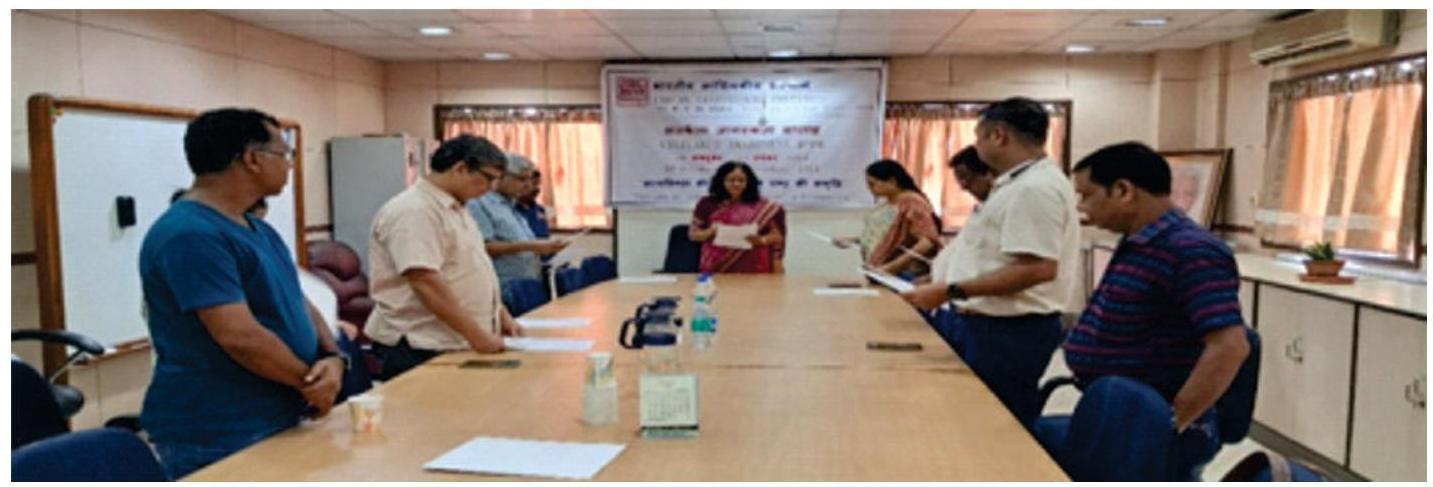
Observance of Vigilance Awareness Week 2024, during 28th October to 3rd November, 2024 at ISI, Kolkata
(ii) Swachhata Pakhwada

Swachhata Pakhwada conducted at Indian Statistical Institute, Giridih
(iii) Hindi Pakhwada Inauguration – 2024

Prof. Sanghamitra Bandyopadhyay, Director ISI and Shri Ravinder Kumar Chief Executive (Administration \& Finance) and other Guest Speakers present on the stage during Hindi Pakhwada Inauguration – 2024, on 14th September 2024
(iv) National Statistics Day’ \& Workers’ Day’
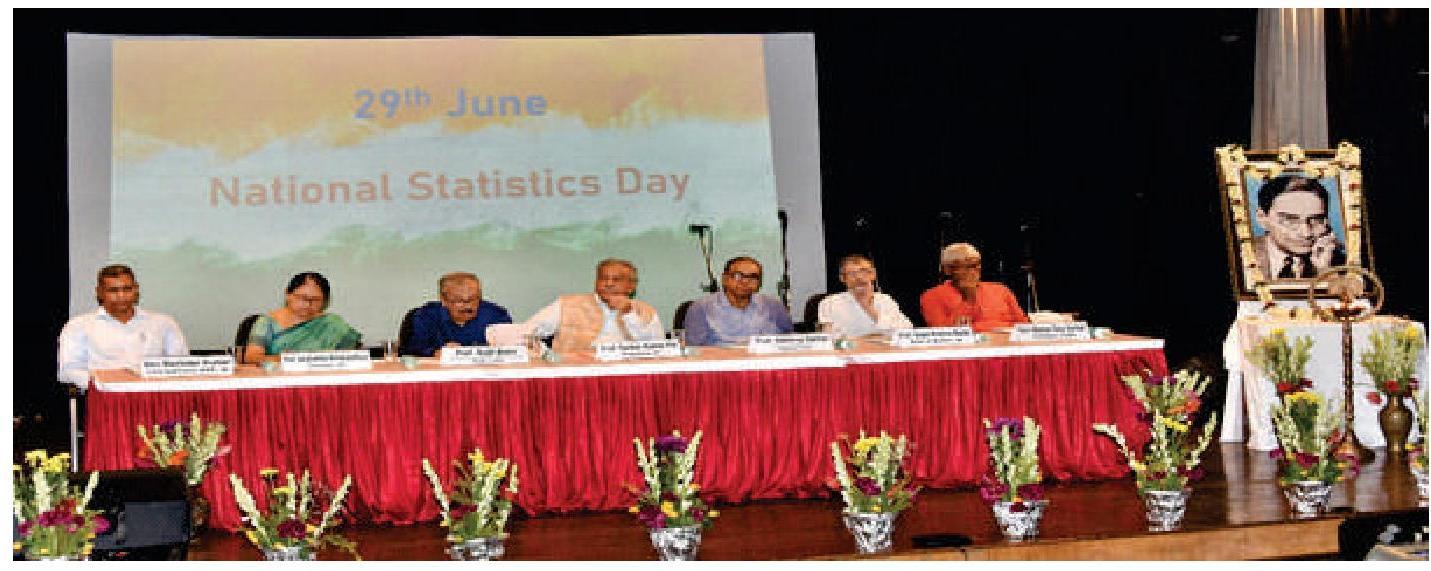
Celebration of ‘National Statistics Day’ \& Workers’ Day’ On the occasion of the 131st Birth Anniversary of Professor Prasanta Chandra Mahalanobis at the Headquarter of the Institute
(v) Independence Day
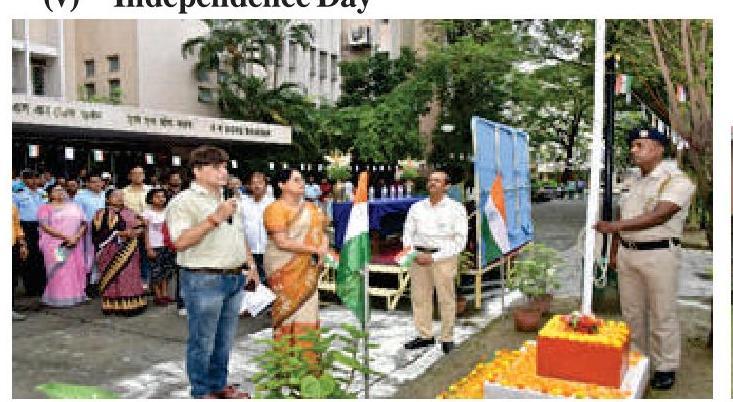
Celebration of 78th Independence Day at ISI, Kolkata
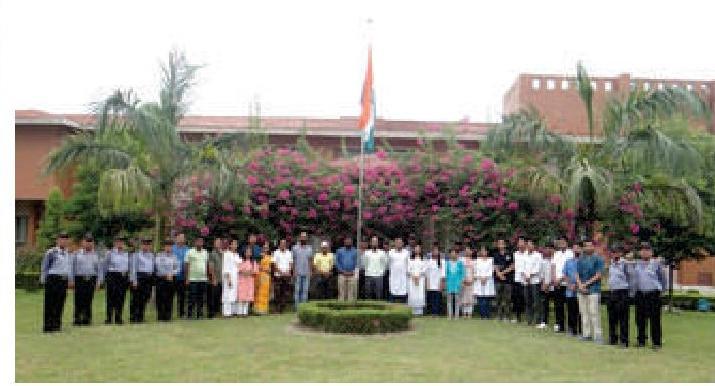
78th Independence Day Celebration at ISI Tezpur
Teaching and Training Division
14.6 During the academic session 2024-2025, a total of 17846 (excluding M. Tech in CS GATE candidates) candidates applied for admission and were called for written selection tests for the fourteen (14) non-JRF and ten (10) JRF programmes offered by the Institute, viz., B. Stat. (Hons.), B. Math. (Hons.), Bachelor of Statistical Data Science (Hons.), M. Stat., M. Math., Master of Science (M.S.) in Quantitative Economics, Master of Science (M.S.) in Quality Management Science, Master of Science (M.S.) in Library and Information Science, M. Tech. in Computer Science, M. Tech. in Cryptology and Security, M. Tech. in Quality, Reliability \& Operations Research, Post Graduate Diploma in Statistical Methods and Analytics, Post Graduate Diploma in Agricultural and Rural Management with Statistical Methods and Analytics, Post Graduate Diploma in Applied Statistics (On-line programme), Research Fellowships in Statistics, Mathematics, Quantitative Economics, Computer Science, Quality, Reliability and Operations Research, Physics and Applied Mathematics, Geology, Biological Science (Agricultural and Ecological Research), Biological Science (Human Genetics), Linguistics. Admission tests for all degrees, diplomas and research courses were held on 12th May, 2024 at 50 test centres spread over 23 states of India. A total of 12054 (including M. Tech in CS GATE candidates) candidates had appeared for admission tests. Based on the performance in the written tests, interview and the academic records, 496 candidates (including spot admission) were admitted to various research and non-research courses during the academic session under review. Besides this, 7 sponsored candidates from Government sector also took admission in M. Tech. (CrS) and M. Tech. (QR\&OR) programmes.
14.7 Post Graduate Diploma in Applied Statistics (PGDAS) Programme is a one-year on-line diploma programme offered by ISI with the support of Coursera. There are two channels of selection of candidates for this programme. Admission through the regular channel includes a review of academic transcripts submitted by the applicants. Applicants who qualify for the next stage are required to take a quiz for final selection. Admission through the tuition waived channel consists of an annually conducted written test, a review of academic transcripts, and a personal interview. Sixty two (62) candidates have registered for the regular channel and Twenty seven (27) candidates have registered through tuition waived channel in the academic session 2024-25. A few numbers of students for Cohort 6 (i.e. Spring 2025) will be registered in the month of February, 2025 in the academic session 2024-25.
14.8 Post Graduate Diploma in Business Analytics (PGDBA) is a two-year full time diploma programme jointly offered by ISI, IIT Kharagpur and IIM Calcutta. The number of seats in PGDBA programme (202426) is 65 . The number of application for PGDBA admission 2024 was 2973. Out of 2973 candidates, 1646 candidates had appeared for the written test. The number of candidates shortlisted for personal interview was 378 . Sixty one (61) students have enrolled (including one deferment joining) in the programme.
14.9 During 1st April, 2024 to 31st December, 2024, 47 trainees from various Universities/Institutions have received four weeks/six weeks/two months/three months/four months and six months Project training in different Units of the Institute, viz., Advanced Computing and Microelectronics Unit, Agricultural \& Ecological Research Unit, Computer Vision and Pattern Recognition Unit, Electronics and Communication Sciences Unit, Geological Studies Unit, Human Genetics Unit, Machine
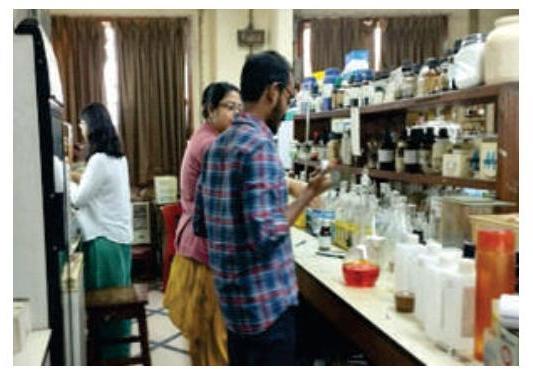
Intelligence Unit, Physics and Applied Mathematics Unit, Theoretical Statistics and Mathematics Unit and Statistical Quality Control \& Operations Research Unit under the guidance of different faculty members of the Institute.
International Statistical Education Centre (ISEC)
14.10 The International Statistical Education Centre (ISEC), founded in 1950 at the initiative of Professor P. C. Mahalanobis at Kolkata through an agreement between the International Statistical Institute and the Indian Statistical Institute (ISI), is an Associate Institution of ISI as per Regulation no. 14 of the Institute. It functions under a Board of Directors, which has members from ISI, MoSPI and the Ministry of External Affairs (MEA), and whose current Chairman is Professor S.P. Mukherjee. The centre aims to provide training in theoretical and applied statistics at various levels to selected participants from countries of the Middle East, the Far East, South and South-East Asia, as well as the Commonwealth countries of Africa. The primary training programme is an annual 10 -month course in Statistics (titled Statistical Theory and Applications) leading to a Diploma, which is funded by the Indian Technical and Economic Cooperation (ITEC) Programme of the Ministry of External Affairs (MEA), Government of India, and is conducted with the support provided by ISI. The Ministry of Statistics \& Programme Implementation supports the programmes by organizing courses on Official Statistics. In addition, special courses on different topics of varying duration are also organized for international participants.
14.11 In the current financial year (2024-25), two short-duration (2-week) courses funded by ITEC have been conducted for international participants, with two more approved courses scheduled to take place later in the year. The first course, titled “Workshop on Industrial Experimentation,” was held from 28th August, 2024, to 17th September, 2024, with 13 participants. The second course, “Six Sigma Green Belt,” was conducted from 23rd October, 2024, to 5th November, 2024 with 12 participants. Additionally, in the current academic year (2024-25), the 76th term of the regular 10-month course on Statistical Theory and Applications is in progress with 18 participants. This course began on 1st August, 2024, and will conclude on 31st May, 2025.
14.12 The Convocation of the 75th Term of International Statistical Education Centre (ISEC) of Indian Statistical Institute (ISI) held on 27th June, 2024 at the Platinum Jubilee Auditorium in the Institute to award Diplomas to the international trainees.
14.13 On this occasion, fourteen (14) trainees were awarded with the 10-month Diploma Course on Statistical Theory and Application course. The trainees are from Burundi, Bangladesh, Botswana, Congo, Ethiopia, Fiji, Gambia, Ivory Coast, Kenya, Madagascar and Malawi.

The Convocation of the $75^{\text {th }}$ Term of International Statistical Education Centre (ISEC) of Indian Statistical Institute (ISI) held on $27^{\text {th }}$ June, 2024
Research Work
14.14 The research, development and consultancy activities of the Institute were grouped in the following Academic Divisions:
Theoretical Statistics and Mathematics; Statistical Sciences; Computer and Communication Sciences; Physics and Earth Sciences; Biological Sciences; Social Sciences and Statistical Quality Control \& Operations Research.
14.15 In addition to above Library, Documentation \& Information Sciences Division and Computer \& Statistical Services Centre provide services to the Institute.
14.16 There are two national facilities centres i.e. Centre for Soft Computing Research: A National Facility and R.C. Bose Centre for Cryptology and Security. The “Centre for Soft Computing Research: A National Facility” is functioning in the Institute with its outstanding contribution and achievements in the area of soft computing and machine intelligence. The Centre is aimed at conducting research both theoretical and applied, of international standard, in the fields of soft computing. R.C. Bose Centre for Cryptology and Security promote the interdisciplinary research in Mathematics, Computer Science and Statistics towards furtherance of teaching, research as well as training and development in Cryptology and Cyber Security. It acts as a national hub for cryptographic requirements, cutting-edge research activities and indigenous capacity building in all relevant fields of study.
14.17 There are also three research centres in the Institute besides the above and those are Centres for research on the Economics of Climate, Food, Energy and Environment (CECFEE) at Delhi Centre \& Centre for Artificial Intelligence and Machine Learning (CAIML) at Headquarters, Kolkata and a Technology Innovation Hub (TIH) at Headquarters, Kolkata. CECFEE is engaged with the Climate Change Finance Unit in the Department of Economic Affairs, Ministry of Finance during the G20 presidency, CECFEE contributed to the carbon pricing and climate finance report. The researchers of the Centre explore diverse themes like health, gender, food, agriculture, waste, and policy design. Whereas, the Centre for Artificial Intelligence and Machine Learning (CAIML) will strive for becoming the AI hub in India. It will work on development of theories and methodologies of AI with a view to reaching out the benefits of AI to the most. The centre will play a key role in helping our nation as well as the United Nations (UN) to achieve some of their major goals. Institute of Data Engineering, Analytics and Science Foundation is the Technology Innovation Hub (IDEAS-TIH) set up at ISI Kolkata under the aegis of National Mission on Interdisciplinary Cyber-Physical Systems (NM-ICPS) to focus on Technology Development and Translation, HRD, Technology Business Incubator (TBI) \& Start-up Development and International Collaborative Research in the area of Data Science, Big Data Analytics and Data Curation. IDEAS TIH came into existence in March 2021, in ISI. IDEAS TIH successfully concluded a three-month online Data Science Internship program designed for undergraduate students from diverse colleges and institutions. The program attracted 175 registered participants and provided comprehensive training in Data Science using Python. In addition to online training sessions, the program included campus immersion opportunities and hands-on experience with over 50 ongoing projects executed by IDEAS TIH and its technology partners. On 19th November, 2024, the British Deputy High Commission Kolkata, in collaboration with IDEAS ISI, hosted a visit by a UK Tech Trade Mission to the Indian Statistical Institute (ISI).
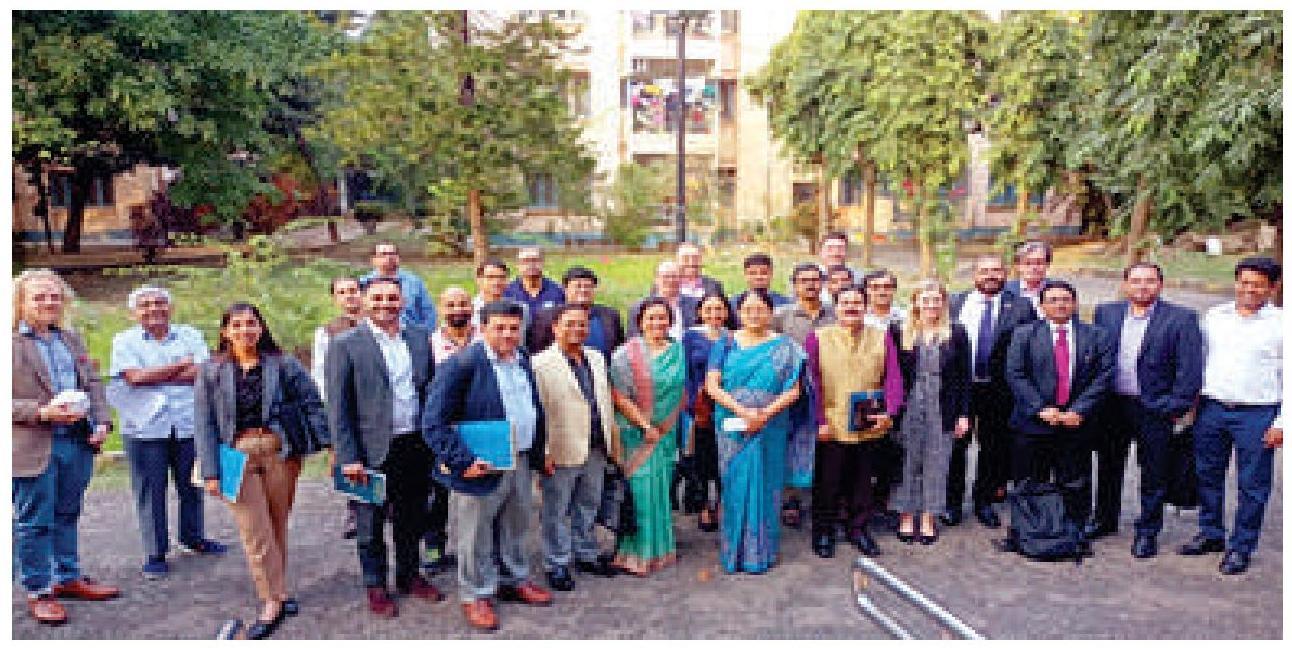
Visit by UK Tech Trade Mission on Artificial Intelligence and Semiconductor at Indian Statistical Institute, Kolkata on 19th November, 2024
14.18 The Computer and Statistical Service Centre (CSSC) situated at the Headquarters is responsible for management, maintenance and support of its entire IT infrastructures and related issues of its users comprising students of its various curriculum, faculty, scientists and administrative staff. The IT infrastructures of this Institute include (i) computer labs, (ii) networking facility based on both wired and wireless network architecture, (iii) computational servers supported by several high performance devices, (iv) virtualization of servers, (v) support for super high performance computation based on GPU facilitating machine learning based research studies, (vi) internet facility and its security through firewall, (vii) email server and Spam filter, (viii) design, updates and regular maintenance of the website, (ix) various operating systems including Microsoft Windows, Linux, (x) compilers of various computer languages including C/C ++ , JAVA, R, Python, FORTRAN etc., (xi) various software packages which includes R, Matlab and its various Tool Boxes, Mathematica, SPSS, etc., (xii) various database packages like MYSQL, PostgreSQL, (xiii) IDRISI (Geological Information System), (xiv) online meeting support through Zoom online video conferencing tool, (xv) SyMeC High Performance Computer (HPC) system.
Externally Funded Projects
14.19 Apart from theoretical and experimental plan research, the Institute also undertook a variety of about Ninety-five externally funded projects from different Government and non-Government organizations like CSIRO, Australia; IFCPAR, CEFIPRA; IBM, USA; CEFIPRA; Reckitt Global Hygiene Institute under the RGHI Innovation Grants 2024 (PI) with Bansi Malde (City University London); Indo-US Virtual Networked Center; Asian Development Bank; MATRICS, Science and Engineering Research Board (SERB), DST, Govt. of India; Department of Science and Technology, Govt. of India; MeitY, Govt. of India; ANRF, SERB, India; Indian Council of Social Science Research (ICSSR), New Delhi, Ministry of Education (MoE), Govt. of India; Naval Armament Inspectorate, Cossipore, Kolkata, MoD, GoI; Department of Biotechnology (DBT), govt. of India; ISRO; DRDO; Ministry Of Earth Sciences; NBHM, DAE, Govt. of India; Indian Council of Social Science Research (ICSSR), Govt of India; NSSTA, M.O.S.\&P.I., Govt. of India; Data Science Research of Interdisciplinary Cyber Physical
Systems (ICPS), Department of Science and Technology, Govt. of India; Cognitive Science Research Initiative, Department of Science and Technology, Govt. of India; Director General Resettlement, Ministry of Defence; DIAT, Pune of Ministry of Defence; Reserve Bank of India; Defense Institute of Quality Assurance (DIQA), Bangalore; IGSTC; Airports Authority of India (AAI); Canara Bank; Indian Council of Medical Research; DES, Govt. of Tripura; Tripura, TIFT; BEML Ltd.; Recipharm Pharma Services; String Bio; Bharat Electronics; Kirloskar Toyota Textile Machineries; TKAP, Bangalore; Banas Dairy, Gujarat; Hindustan Zinc Ltd, Udaipur; Century Rayon Aditya Birla, Mumbai; Balasore Alloys Limited, Orissa; Hil Ltd, Hydrabad; Greencell Express Private Ltd.; Delhi International Airport Ltd.; IIM Shilong Students; KPMG Global Services Private Limited; Grid India; Deepak Fertilizer \& Petrochemicals Ltd.; MRF, Trichy; Apollo Tyres; Saint Gobain; Thales India Pvt. Ltd.,Bangalore; Ericsson Research; Semiconductor Research Corporation (SRC) India, IIM Shilong; KPMG Global Services Private Limited; GRId Controller Of India Ltd.; Probo India Ltd.; GIA, Mumbai; Aditya Birla Group; Reliance, Vadodara; Forbes Marshal; Kirloskar.
Seminars, Workshops, Conferences, Symposiums, etc. organised
14.20 During the year, the Institute organized several seminars, workshops, conferences, symposiums with the participation of leading academicians/scientist from India and abroad.
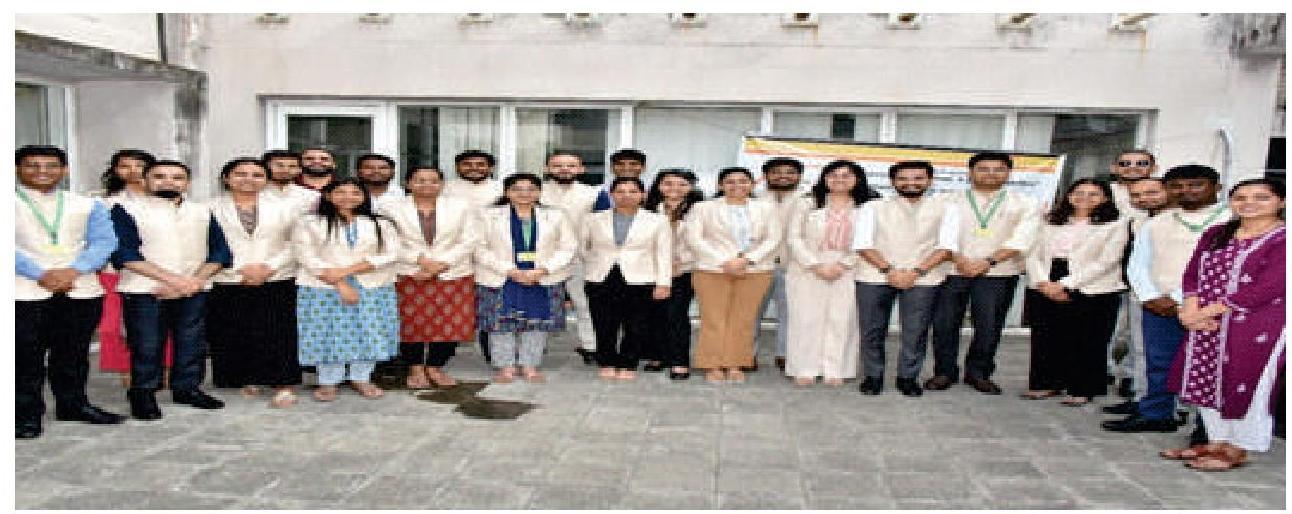
Seminar for ISS Probationers (45th Batch) on “Survey Methodology and Data Analytics”, Sampling and Official Statistics Unit, Kolkata, in collaboration with NSSTA, During 04 March 2024 to 26 April 2024
Publication of the Institute
14.21 The internationally renowned journal Sankhyā, an official publication of the Indian Statistical Institute, was founded by Professor P.C. Mahalanobis in 1932 and began publication under his editorship. It is devoted to original research articles in Probability, Mathematical Statistics and Applied Statistics. Reviews and discussion articles on current research activity in the above areas are also published. A rigorous peer review process is followed for all articles submitted to Sankhyā for publication. Many seminal articles in Probability, Theoretical Statistics and Applied Statistics have appeared in Sankhyā. The journal is
published in two separate series – Series A and Series B. Series A with two issues per year, one in February and the other in August, covers Probability and Theoretical Statistics, while Series B with two issues per year, one in May and the other in November, covers Applied and Interdisciplinary Statistics. Beginning 2010, the Institute has been collaborating with Springer for printing and marketing the international edition of Sankhyā, in both prints and electronic editions. The editorial system is now electronic, that is, the entire process starting from submission of articles to editorial processing ending in final editorial decision for articles is now done online. The access to the articles of every edition of Sankhyā Series A and B are available through the following websites:
Series A: https://link.springer.com/journal/13171
Series B: https://link.springer.com/journal/13571
14.22 A special issue of Series A (Volume 86, Supplementary Issue 1) titled D. Basu Centennial Volume: Contributions to Mathematical Statistics and Probability was published in November 2024. This special issue was edited by Prof. Subhashis Ghosal and Prof. Tapas Samanta. Additionally, two regular issues of Series A (Volume 86, Issues 1 and 2) were published in February 2024 and August 2024, respectively. Two regular issues of Series B (Volume 86, Issues 1 and 2) were published in May 2024 and November 2024, respectively. The next issues of Series A and Series B will be published in February 2025 and May 2025 in the normal course.
Scientific Papers and Publication
14.23 During the year, about Three hundred thirty-eight papers were published in different national and international journals.
Scientific Assignments Abroad
14.24 Seventy scientists of the Institute visited in a number of international events in different foreign countries either on invitation or under cultural exchange programme to attend international seminars and conferences. Most of them presented scientific papers and delivered lectures in those seminars and conferences. Representative countries are Austria, China, France, Greece, Germany, Italy, Jordan, Nepal, Poland, South Korea, UAE, UK and USA.

IOP Library Advisory Board Meeting, Kathmandu, Nepal, during 30 September – 1 October 2024
Visiting Scientists
14.25 Fifty-five scientists from Canada, Denmark, France, Germany, Hungary, Italy, Israel, Poland, Japan, Norway, South Korea; Sweden, Turkey, Taiwan, UK, USA and also within India participated in various Workshops, Conferences, Seminars etc. organized by the Institute. Some of them also participated in collaborative research, teaching and other scientific activities of the Institute.
Recognition to ISI Scientists
14.26 In appreciation and recognition to the high standard of research and scientific excellence maintained by the researchers of the Institute, several faculty members received laurels in the forms of awards, fellowship from organizations of national and international importance like American Geophysical Union (AGU); American Mathematical Society; International Artificial Intelligence Industry Alliance (FAIIA); Indian National Science Academy (INSA) etc. Besides, many faculty members were invited by national and international Institutes/bodies to act as chairman, members, chief editor, editor, reviewer in their several committees/editorial boards etc.
Chapter 15
Statistical Services
Indian Statistical Service
15.1 The Indian Statistical Service (ISS) was constituted on 1st November, 1961 as a cadre of qualified professionals with core discipline of Statistics to control, coordinate, monitor and steer the diversified statistical system to render the crucial statistical needs of planning, policy formulation and decision making by the Government and to consolidate and disseminate these statistics at National and International level.
15.2 The posts of ISS at various Grades are distributed among various Ministries, Departments and Organisation with the aim to have an appropriate statistical set-up in the Ministries/Departments to provide a real time objective data and to analyze it for: (a) policy formulation, implementation and monitoring (including concurrent monitoring and evaluation and outcome/end line assessment) and (b) decision making.
15.3 Ministry of Statistics \& Programme Implementation (MoSPI) act as the Cadre Controlling Authority of Indian Statistical Service. The Ministry is concerned with all matters pertaining to the service including recruitment, promotion, training, career and manpower planning, etc. However, day-to-day administrative matters of ISS officers are looked after by the Ministries/Departments in which the officers are posted.
15.4 Recruitment to the service is made through Indian Statistical Service Examination conducted by UPSC annually, promotion from the feeder grade i.e. Subordinate Statistical Service (SSS) and through absorption of Statistical Officers working in other Ministries/Departments. The service has grown over the years in terms of relevancy and number of posts. The allocation of posts in various grades, at present is given as under:
| Grade | Sanctioned Strength |
On Cadre Strength as on $\mathbf{3 1 . 1 2 . 2 0 2 4}$ |
Projections for $\mathbf{0 1 . 0 1 . 2 0 2 5}$ to 31.03 .2025 |
||
|---|---|---|---|---|---|
| In-position | Vacancy | In-position | Vacancy | ||
| Higher Administrative Grade plus (HAG+) |
05 | 05 | 00 | 05 | 00 |
| Higher Administrative Grade (HAG) |
18 | 18 | 00 | 17 | 01 |
| Senior Administrative Grade (SAG) |
136 | 133 | 03 | 133 | 03 |
| Junior Administrative Grade (JAG) \& NFSG |
176 # | 173 | 03 | 172 | 04 |
| Senior Time Scale (STS) | 179 | 153 | 26 | 149 | 30 |
| Junior Time Scale (JTS) | $300^{*}$ | 245 | 55 | 238 | 62 |
| Total | 814 | 727 | 87 | 714 | 100 |
# Out of these, $30 \%$ of senior duty posts are operated in NFSG *Sanctioned posts included 50 reserve posts.
15.5 The first examination for the direct recruitment to the service was held in 1967 and the first batch was appointed in 1968. As on date, 46 batches of direct recruits have joined the service.
15.6 The ISS Rules, 2016 provide for 50 per cent of the posts in JTS to be filled up by direct recruitment and 50 percent by promotion from Subordinate Statistical Service (SSS) cadre. There is no direct recruitment at any level, except in JTS of the service. All the vacancies in other grades are filled up by promotion.
Subordinate Statistical Service
15.7 The Subordinate Statistical Service (SSS) was constituted on 12th February, 2002 as a cadre of qualified personnel with core discipline of Statistics to assist in building crucial statistical database covering various aspects of Indian Economy for planning, policy formulation and decision making by the Government.
15.8 The SSS is a Group B Central Civil Service of statistical function posts which constitutes feeder cadre for Indian Statistical Service (ISS). It comprises of Senior Statistical Officer (SSO) (Group-B Gazetted) and Junior Statistical Officer (JSO) (Group-B Non-Gazetted). As per 7th CPC, the Pay Scale of SSO corresponds to Level 7 and that of JSO to Level 6 in the Pay Matrix. The officers of the SSS cadre are posted in various Ministries/ Departments/ Organisations of the Government of India across the country.
15.9 MoSPI is the Cadre Appointing \& Controlling Authority (CCA) of SSS. The SSS Cadre deals with all matters pertaining to the service including recruitment, promotion, training, career and manpower planning, etc. However, day-to-day administrative matters of SSS officers are taken care by the respective Ministries/ Departments/ Organizations where these officers are posted.
15.10 The SSS Rules, 2013 provides for 90 per cent of the posts of JSO to be filled up by direct recruitment through open competitive examination, viz., Combined Graduate Level Examination (CGLE) conducted by the Staff Selection Commission (SSC) while 10 per cent of total posts are to be filled by promotion from the feeder posts (Statistical function posts existed at level 4 and level 5 of pay matrix). The promotions to Senior Statistical Officer (SSO) of the Service shall be on the basis of selection on the recommendations of the Departmental Promotion Committee. As per Recruitment Rules of SSS, there is no direct recruitment at the level of SSO of the service.
15.11 The present strength of SSS officers (in position) as on 1st January, 2025 is as follows:
| S. No. | Name of the Post | Present Strength | In-Position |
|---|---|---|---|
| 1. | Senior Statistical Officer | 1983 | 1942 |
| 2. | Junior Statistical Officer | 2402 | 1400 |
| Total Strength | 4385 | 3342 |
15.12 During 2024-25, i.e. from January, 2024 to December, 2024, the following activities have been undertaken:
- Recruitment Rules and Cadre review proposal of SSS are under process.
- Consequent upon acceptance of the recommendations of the Departmental Promotion Committee (DPC), 227 Junior Statistical Officers (JSO) have been promoted to the post of Senior Statistical
Officers (SSO) against the vacancy calendar year 2024.
- During the year, around 117 officers of SSS have been granted 2nd and 3rd financial upgradation under MACP Scheme in the corresponding Level 8 and 9 respectively as per their eligibility.
- On completion of probation period, the services of 140 Junior Statistical Officers have been confirmed.
- Induction Training Program (ITP) for newly recruited 201 JSOs of SSS Cadre has been conducted through National Statistical Systems Training Academy (NSSTA), Greater Noida.
- Process for online reporting of APAR for SSS officers on Smart Performance Appraisal Report Recording Online Window (SPARROW) has been implemented.
- Four meetings have been conducted during the period and total 110 cases have been reviewed. 01 officer has been prematurely retired from service under 56(j).
- Total 14 Grievances/appeals have been received in SSS Division through CPGRAMS Grievance Portal during the period and 07 was carry forward from previous year. All the grievances/appeals were timely disposed of. Average time of disposal was 13 days.
- Transfers \& postings of newly recruited JSOs as well as in-service SSS Cadre officers have been issued as and when required.
- All the Court cases pertaining to SSS Division are being sincerely defended and para-wise replies and other steps have been taken in a time bound manner. Out of 44 court cases [Supreme Court Cases: 02, High Court Cases:05 and CAT including contempt Petition Cases: 37] which were pending at the beginning of the period, 13 cases [High Court Cases :01 and CAT including contempt Petition Cases : 12] have reached their conclusion and rigorous efforts are being made so that remaining cases also reach conclusion expeditiously.
- Issuance of Charge-Sheet and further proceedings have been completed as per guidelines. Out of 10 disciplinary cases, charge sheets have been quashed in 02 cases vide order dated 14th November, 2024 of Hon’ble CAT, Kolkata. Moreover, 03 officers were terminated under Temporary Service Rules, 1965 during the year.
- All the suspension orders and review of suspension have been issued within prescribed time limits.
15.13 Projections for the period from January, 2025 to March, 2025:
- In the coming months, around 24 officers of SSS may be granted 2nd and 3rd financial upgradation under MACP Scheme in the corresponding Level 8 and 9 respectively as per their eligibility.
- Necessary steps are being taken to ensure effective hearing in the cases where pleadings are complete. Cases are being reviewed on fortnightly basis and earnest steps are being taken to process the cases/ file replies wherever pleadings are not complete.
- The timelines for conducting DPC as per Model Calendar prescribed by DoP\&T could not be adhered to due to various reasons such as delay in finalization of DPC formalities for JTS level post, administrative reasons, etc. However, for the clear vacancies of SSOs, as on date, DPC meeting for the vacancy year 2025 may be convened in the first quarter.
Chapter 16
Progressive Use of Official Language (Rajbhasha)
16.1 In accordance with the Official Language Policy of the Union and in pursuance of the Annual Programme issued by the Department of Official Language, the Ministry of Statistics \& Programme Implementation (MoSPI) has been making continuous and concerted efforts for propagation and promotion of Hindi as Official Language in the Ministry and in its Attached \& Subordinate Offices. Official Language Section of the Ministry is responsible for monitoring and overseeing the implementation of various statutory provisions and policies as laid down in the Official Languages Act, 1963 and the Official Languages Rules, 1976. Various check points have been developed in the Ministry to ensure section 3(3) of the Official Language Act, 1963.
Official Language Implementation Committee (OLIC)
16.2 An Official Language Implementation Committee under the Chairmanship of Joint Secretary (Admin.), MoSPI undertakes quarterly review of the progressive use of Hindi as well as compliance of provisions of the Official Languages Act, 1963 \& Official Languages Rules, 1976 in the Ministry and in its Attached/Subordinate Offices. Quarterly Progressive Reports and Annual Performance Reports regarding progressive use of Official Language in the Ministry are forwarded to the Department of Official Language, Ministry of Home Affairs. Meetings of Official Language Implementation Committee were organized regularly.
Official Language Inspections
16.3 The officers of the Official Language Division conduct inspections of the Attached/Subordinate offices of the Ministry to assess the position of progressive use of Hindi and give necessary instructions for taking remedial measures to bring improvements in the same. Inspections of all Section/Division including FOD Headquarter, SCD, NSSTA of the Ministry have been carried out during the year. In addition, inspections of Subordinate Offices of the Ministry have been carried out during the year including ZOGuwahati, SRO Shilchar, RO Shillong, SRO Tura, RO Coimbatore, SRO Amritsar, SRO Alwar, SRO Mangalore.
Awards and Incentives
16.4 Hindi Pakhwada was observed from 14th – 28th September, 2024 to encourage the officials and employees of the Ministry for using Hindi in official work. The messages of Hon’ble Home Minister were circulated and displayed on e-office portal. An appeal was issued by Secretary, MoSPI. Banners depicting various phrases of Hindi language were also displayed in various buildings of the Ministry. During Pakhwada, various competitions were organized by Hindi Section of the Ministry and a number of officers and officials took active part in these competitions. A total of 24 participants of the Ministry were awarded cash prizes by Secretary, MoSPI in Hindi Pakhwada Samaroh 2024.
Parliamentary Committee on Official Language
16.5 The Official Language inspection of various Subordinate and attached offices of Ministry was done by the 3rd Sub Committee of Parliament on Official Language during the year. Shri Tanweer Qamar
Mohammad, Joint Secretary (Admin.), MoSPI, attended the meetings along with Shri Mukesh Kumar, Deputy Director (OL) and Shri Rakesh, Senior Translation Officer. The Official Language inspection of RO Goa, RO Delhi and ISI, Delhi Centre was done by the 3rd Sub-Committee of Parliament on Official Language.
Central Secretariat Official Language Implementation Committee (COLIC)
16.6 The Ministry also represented the Central Secretariat Official Language Implementation Committee meeting conducted by Department of Official Language, Ministry of Home Affairs under the Chairmanship of Secretary on 23rd October, 2024 Ashish Kumar Gupta, Director (Genl. Admn.) attended the meeting. All the shortcomings as pointed out by the Committee, were noted down.
Chapter 17
Other Activities
17.1 The Chief Vigilance Officer (CVO) heads the Vigilance Division in the Ministry and acts as an Advisor to the Secretary, MoSPI in the following matters pertaining to Vigilance:
- Processing of complaints and disciplinary cases related to misconduct involving vigilance angle and the court cases pertaining thereto.
- Complaints received from individuals and organizations like CBI/CVC/ PMO/Cabinet Secretariat/UPSC etc. are examined on the basis of factual report obtained from concerned administrative divisions, Attached \& Subordinate Offices. Preliminary inquiries are made to look into the merit of the complaint and if the complaints have any substance then a regular departmental inquiry is initiated to bring the matter to a logical end.
- Furnishing information related to vigilance work/ court matter which includes monthly \& quarterly reports on various portals managed by Department of Personnel \& Training (DoPT), Central Vigilance Commission (CVC) and Department of Legal Affairs (DoLA).
17.2 Vigilance Division also handles the following activities - Preventive measures to curb misconduct involving vigilance angle in the Ministry along with all the Attached \& Subordinate Offices which involves reviewing and streamlining of existing procedures which appear to afford scope for such misconduct.
- Processing Vigilance Clearance of all the officials of this Ministry including those posted across the Ministries/ Departments for various purposes like promotion, deputation, grant of MACP, grant of NFSG/NFU/NFS, ex-India leave, confirmation in service, transfer, review of service under Rule 56 (j), NOC/IC for passport, retirement including superannuation and VRS, resignation including technical resignation, NOC for recruitment processes, etc. This includes collection and collation of data from various regional offices of this Ministry as well as various Ministries/ Departments of Government of India where these officials are posted.
17.3 During the year 2024-25, more than 60 (approx.) complaints (which includes complaints carried over from the previous year) were closed after due examination in the light of extant rules \& guidelines on the subject.
17.4 During the said period, Major Penalty was imposed in respect of two disciplinary cases and there was no case in which minor penalty was imposed.
17.5 During the year 2024-25, more than 2200 (approx.) vigilance clearances were timely processed/ issued, which eventually culminated into the timely promotion/NFU/Confirmation/ deputation/ JS Empanelment of ISS Officers etc. Besides, various RTI Applications/ First Appeals under the RTI Act, 2005 were received and disposed of within the stipulated time.
17.6 Vigilance Awareness Week (VAW) with theme “Culture of Integrity for Nation’s Prosperity” was observed during 28th October to 3rd November, 2024 to create awareness, sensitization and training of
employees of the Ministry on rules and regulations related to vigilance matters. During VAW, four training Programmes for Group A \& B Officers of the Ministry were organised through guest faculty.
17.7 The Part Time Vigilance Officer has been appointed in NSO (FoD), HQ with the approval of the Competent Authority.
Redressal of Public Grievances
17.8 A Grievance Redressal Machinery is functioning in this Ministry under the supervision of Nodal Officer (Public Grievances). The grievances are normally received through CPGRAMS portal or through various Nodal Agencies such as Prime Minister’s Office (PMO), President’s Secretariat, Department of Administrative Reforms and Public Grievances (DARPG), Department of Pension \& Pensioners’ Welfare (DOPPW), etc.
17.9 The number of Grievances and appeals received during the period of 12 months starting from 1st January, 2024 upto 31st December, 2024 are given as under:
| Sl. No. |
Matter | Pending as on 1st January, 2024 |
Received during the period |
Disposed of during the period |
Pending as on 31st Dec., 2024 |
|---|---|---|---|---|---|
| 1 | Grievances | 26 | 400 | 406 | 20 |
| 2 | Appeal | 5 | 33 | 37 | 1 |
17.10 All the Public Grievances cases are being monitored and followed up on priority basis by regularly reminding the concerned subordinate offices/divisions of the Ministry for early disposal.
RTI Matters
17.11 RTI applications/appeals are normally received in PIGR Section through RTI-MIS Portal or through offline mode and then forwarded to concerned Central Public Information Officers (CPIOs)/ First Appellate Authorities (FAAs) for their disposal. Ministry has designated 38 FAAs and one RTI Nodal Officer of the level of Deputy Secretary/ Director under the RTI Act. The Ministry has also designated 87 CPIOs for various Divisions/ Sections of the Ministry and its Attached/Subordinate offices. Besides, one FAA and one CPIO have also been designated for Indian Statistical Institute (ISI), an Autonomous Body of this Ministry.
17.12 The number of requests and appeals received during the period of 12 months starting from 1st January, 2024 upto 31st December, 2024 under RTI Act, 2005 are given as under:
| Sl. No. |
Matter | Pending as on 1st January, 2024 |
Received during the period |
Disposed of during the period |
Pending as on 31st Dec., 2024 |
|---|---|---|---|---|---|
| 1 | RTI application | 133 | 2368 | 2379 | 122 |
| 2 | RTI appeal | 16 | 187 | 191 | 12 |
Social Justice and Empowerment
17.13 Social justice and empowerment are key focus areas of Ministry of Statistics and Programme Implementation, with the aim of creating a more equitable society where every individual has access to basic rights, opportunities, and resources. This ministry is committed with ensuring the welfare, development, and empowerment of socially and economically marginalized communities, including Scheduled Castes (SCs), Scheduled Tribes (STs) and Person with Benchmark Disabilities (PwBDs). Therefore, an officer of the rank of Director has also been appointed as Liaison Officer for SCs, STs \& PwBDs, for ensuring no partiality and maintaining healthy and inclusive work environment.
17.14 The Ministry also has a Grievance Redressal Cell, which take up the Grievances/ Complaints at high level, related to SCs/ STs and PWDs on priority basis and committed to provide immediate response. Overall, social justice and empowerment are seen as critical components of India’s development agenda, with a range of ministries working to create a more inclusive and equitable society. The information relating to representation of SC/ST and PwBD is given in Annexure VI (A) and VI (B).
General Section:
17.15 E-Procurement: The E-Procurement and E-publishing mode of tender have been fully functional in the Ministry. All procurement (approx. 99\%) of product/services are being done through GeM and CPP Portal, if not available on GeM.
17.16 E-office project: – Currently, the Ministry is working $100 \%$ on e-office platform/environment and all the running files are e-files. Further, the digitization of old files have been completed and converted into electronic files. The e-Office project is one of the Mission Mode Project under the National E-Governance Plan to improve efficiency in Government process and service delivery mechanism.
17.17 Online Stationery Management System: The Stationery is being issued to all employees through Online Stationery Management System to keep track of usage, records and future requirement.
17.18 PFMS: All the payments are being released through Public Finance Management System in electronic Form and no cash payments is being done to any Vendor or employee.
17.19 E-billing: All the bills for payment are being processed through e-bill mode of Public Finance Management System.
17.20 National Sports Day: To commemorate the birth anniversary of Hockey Legend Major Dhyan Chand as a befitting tribute to our sport icon for their contribution to bringing laurels to the country on the international stage, a National Sport Day was organized in the campus of Khurshid Lal Bhavan, MoSPI from 26th to 31st August, 2024. During the event various competitions like tug of war, lemon spoon race, badminton, and chess was successfully conducted and the winners were felicitated.

17.21 Swachata Hi Sewa 2024 Campaign: In compliance to the SHS 2024 campaign conducted during 14th September to 1st October with the theme of “Swabhav Swachhata – Sanskaar Swachhat”, MoSPI conducted various activities in order to make the clean and conducive environment to the officers/officials and other staff of the Ministry. Accordingly, the following activities were carried out during the SHS 2024 campaign:
i. During the SHS 2024, significant efforts were made to enhance the overall environment and facilities of the KL Bhawan campus. The renovation and cleanliness of the park transformed it into a more inviting space for relaxation and recreation. Upgrading the parking area improved accessibility and organization, ensuring a smoother experience for visitors. Additionally, beautification projects for the exteriors added aesthetic appeal, creating a more welcoming atmosphere. These initiatives not only fostered a cleaner, more attractive campus but also reflected a commitment to maintaining a vibrant space for all.
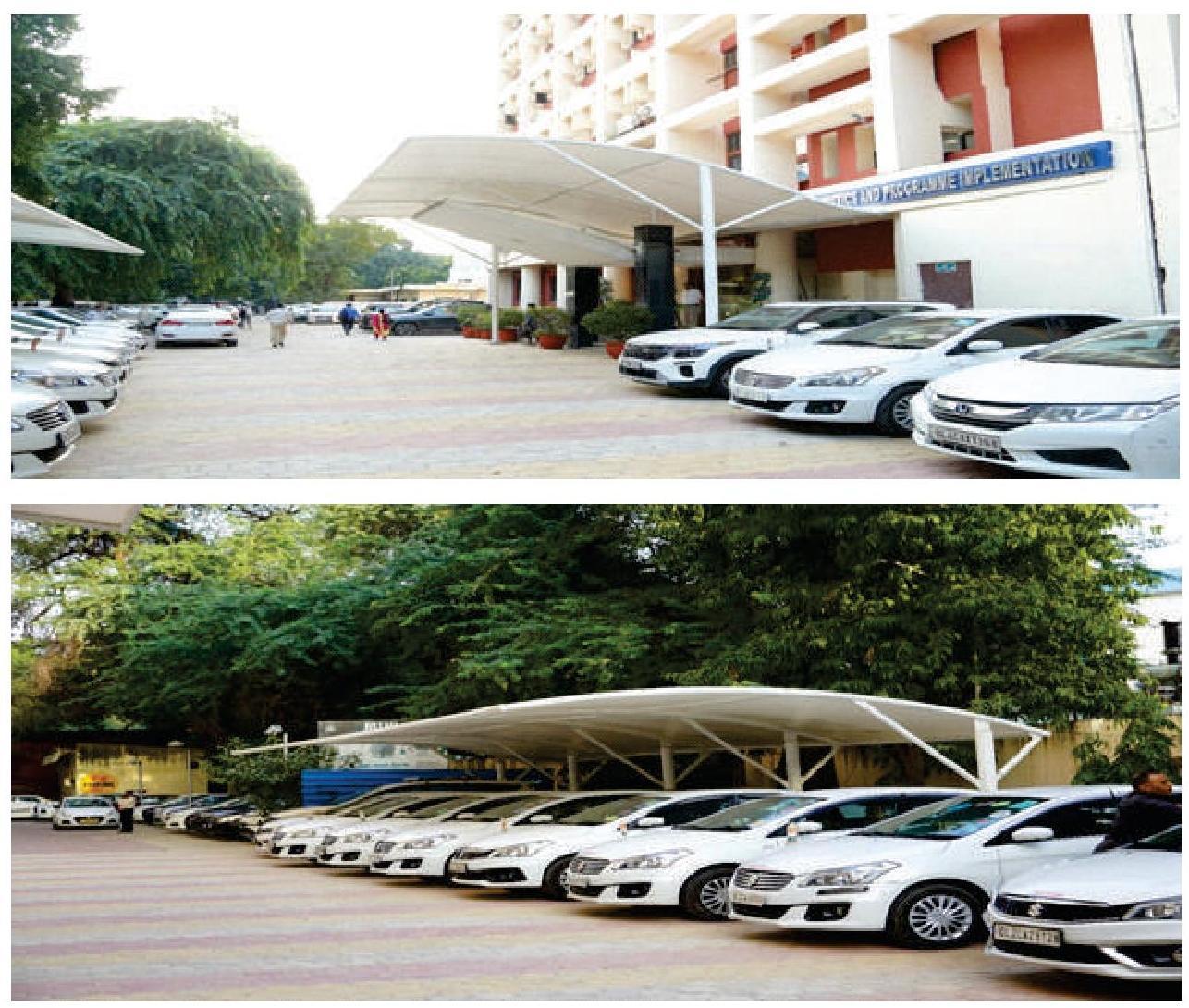
Upgradation of Parking Area
ii. During the event, PPE kits were distributed to Safai Karamcharis, celebrating their essential roles in maintaining a clean environment on 17th September, 2024. The event was also attended by senior officers of the Ministry.
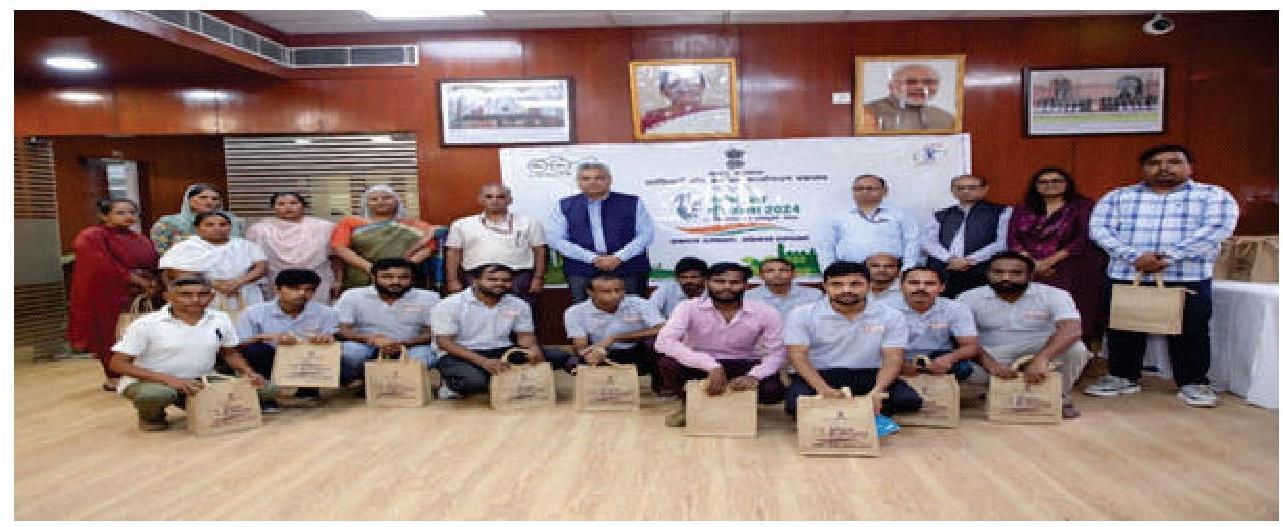
Felicitation of Safai Karamcharis to recognized their roles in maintaining clean environment.
iii. एक पेड़ माँ के नाम: Under Swachhta Hi Sewa 2024 initiative MoSPI conducted Ek Ped Maa ke Naam event. The tree plantation drive was taken place. Led by Secretary (S\&PI) along with other officials including Ms. Geeta Singh Rathore (DG-NSS),
Sh. P.R. Meshram (DG-DG), Sh. Narender Kumar Santoshi (DG-CS) and Ms. Puja Singh Mandol, AS (MoSPI) planted saplings in support of the initiative. The event was attended by large number of officials/staff of the MoSPI.

Renovation and Cleanliness of Park
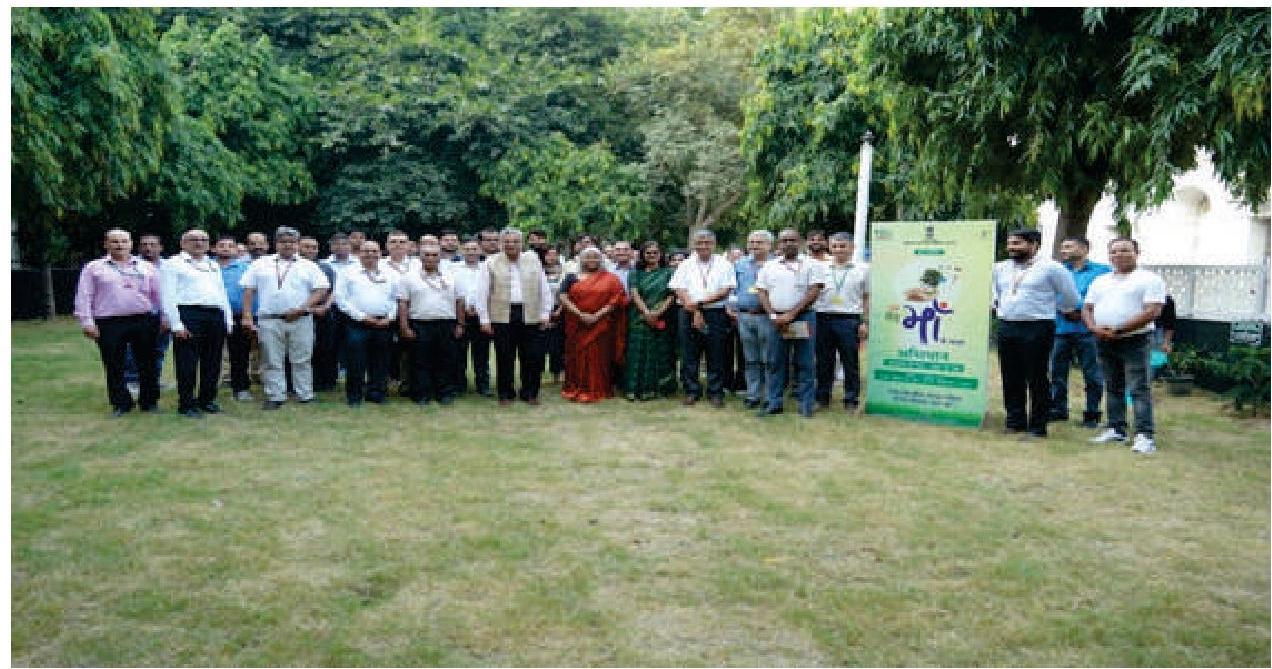
During inauguration and plantation of saplings at Park of KL Bhawan
iv. Suraksha Shivir Medical Camp: During the campaign MoSPI organized a Suraksha Shivir medical camp for its employees on 1st October at Khurshid Lal Bhawan, Janpath, in collaboration with St. John Ambulance Brigade. Health officials conducted assessments on various health parameters, including blood pressure, eyesight, and diabetes.
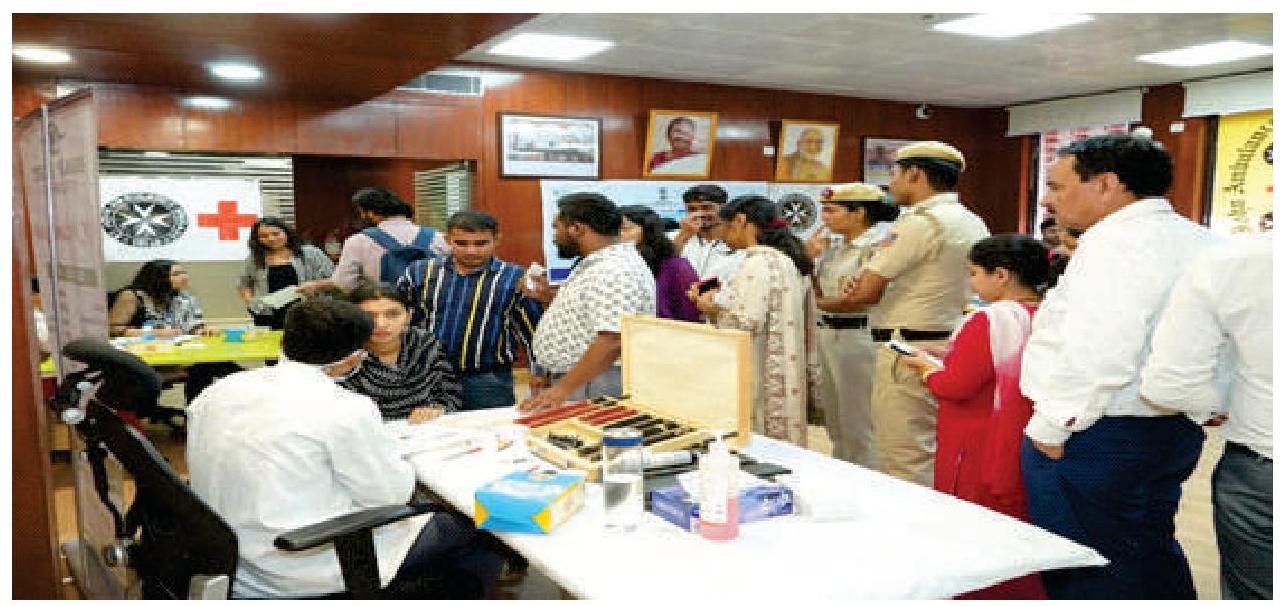
Suraksha Shivir Medical Camp at KL Bhawan, MoSPI
17.22 To widespread awareness among masses about key functions of MoSPI a stall at India International Trade Fair at Bharat Mandapam, New Delhi was set up during 14th – 27th November, 2024.
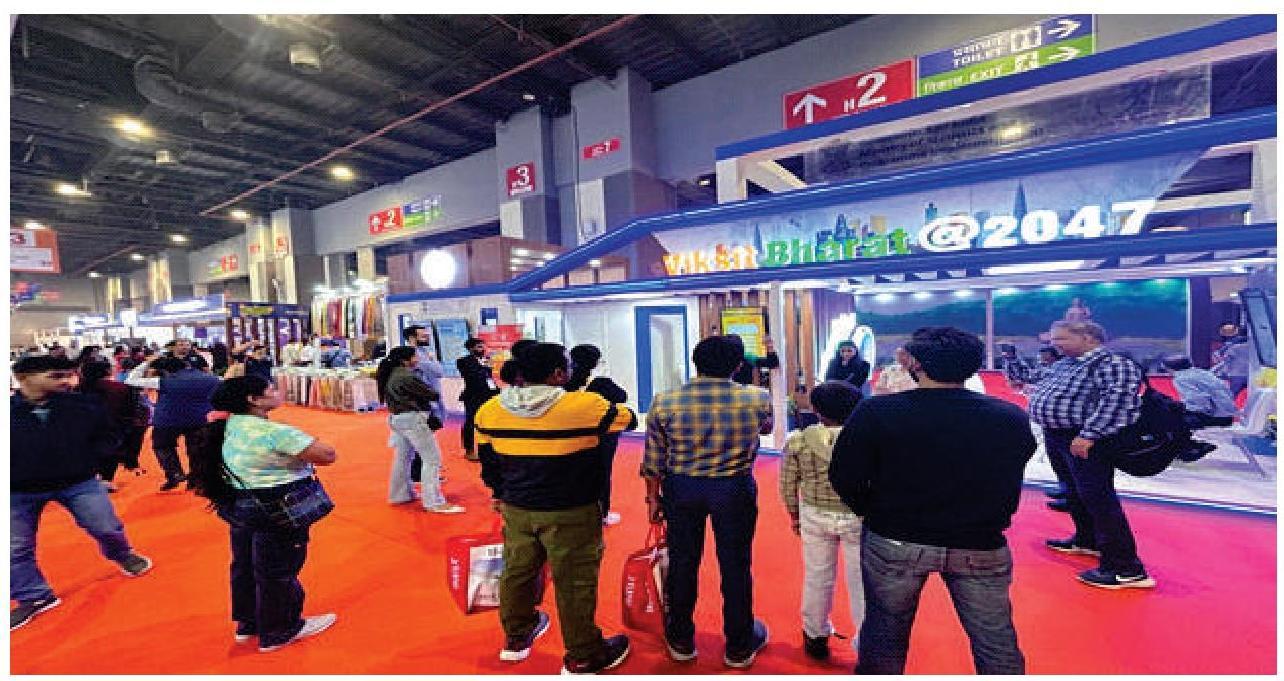
MoSPI stall during IITF at Bharat Mandapam, New Delhi
17.23 Special Campaign 4.0: Ministry, including its Autonomous Body under its administrative control organized Special Campaign 4.0 for improving Swachhata and disposal of pending references from 2nd 31st October, 2024, on the lines of the Special Campaigns held in the preceding 3 years.
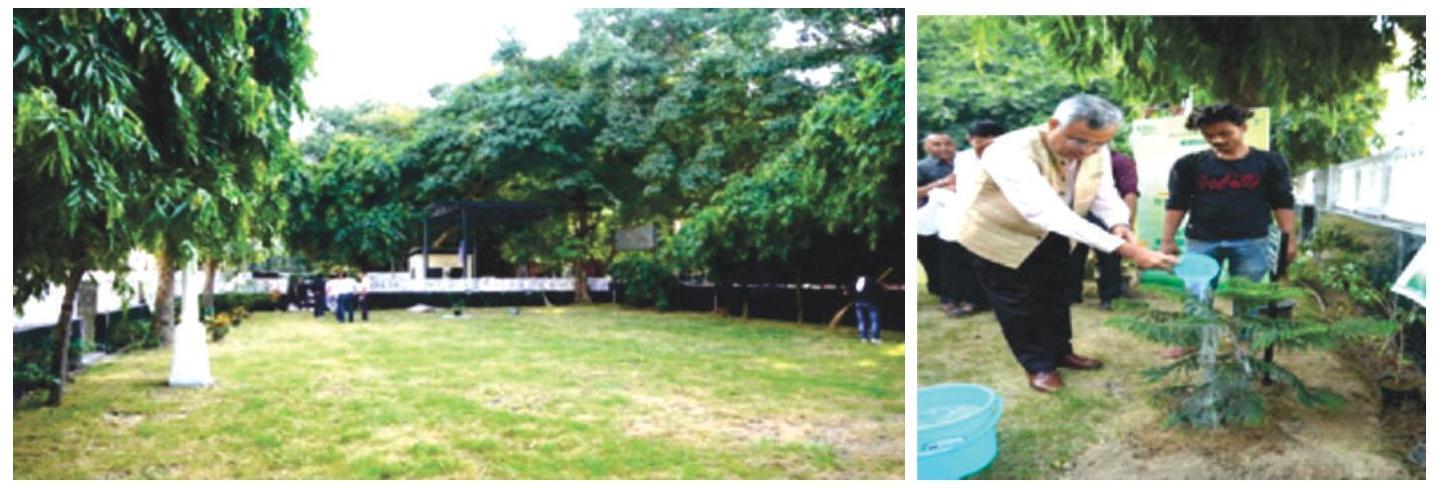
17.24 Swachhata Pakhwada, 2024: As per the schedule fixed by Department of Drinking Water and Sanitation (DDWS), Swachhata Pakhwada, 2024 was celebrated in this Ministry from 16th to 30th June, 2024. Coordination Section had meticulously planned and executed this campaign, with enthusiastic participation from all offices. It was a resounding success.
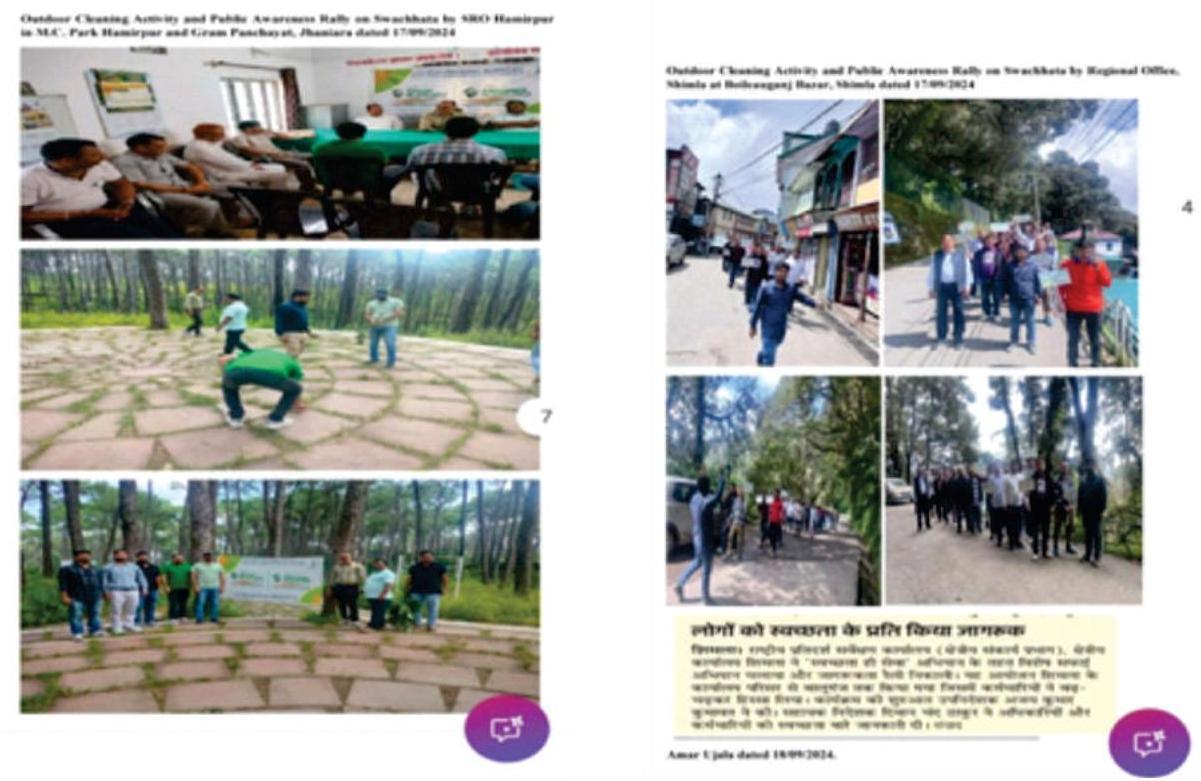
17.25 During Swachhata Pakhwada, all offices within the Ministry displayed commendable commitment by engaging in a range of activities. Notably, AS HQ, Faridabad; FOD HQ, Delhi ; DIID; HSD, EnSD ; ISI and others conducted activities throughout the Campaign. The remaining offices also took up planned/designated activities with great zeal, contributing significantly to the success of the Swachh Bharat campaign. Throughout the fortnight activities such as cleaning of workstations, cleaning of public places
like hospitals, parks, rivers, ponds, beaches have been done, Swachhata rallies organized, plantation have been done, painting completions organized, quiz conducted, wall beautified with paintings, etc. activities have been carried out as well as the cleaning of offices area.
17.26 Swachhata Hi Seva 2024: SHS, 2024 was organized to honour the milestone of the 10th anniversary of the launch of swachh bharat mission. The campaign was observed from 14th September, 2024 to 1st October, 2024 with the theme of ‘Swabhav Swachhata – Sanskaar Swachhata’.
17.27 The Ministry went the extra mile to ensure maximum outreach and public engagement. Through effective use of social media platforms such as Twitter, Instagram, and Facebook, the campaign garnered widespread attention and appreciation from the public.
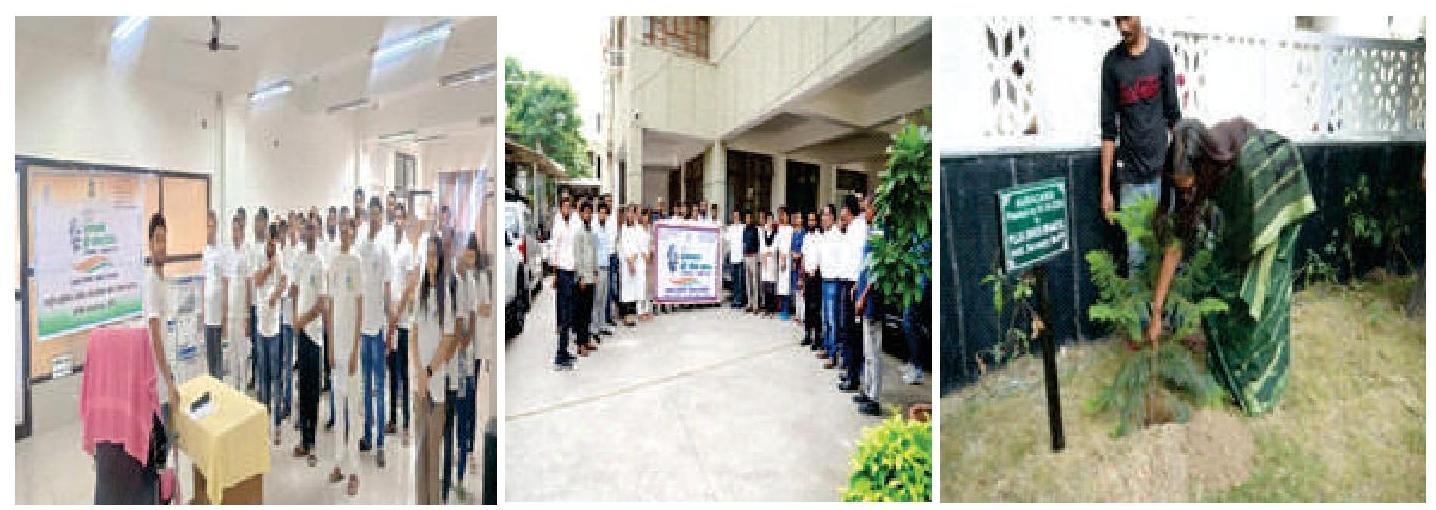
Allocation of Business to the Ministry of Statistics and Programme Implementation
I. STATISTICS WING
- Acts as the nodal agency for planning integrated development of the statistical system in the country.
- Coordination of statistical work with a view to identify gaps in data availability or duplication of statistical work in respect of Departments of the Government of India and the State Statistical Bureaus (SSBs) and to suggest necessary remedial measures.
- Laying down and maintenance of norms and standards in the field of statistics, evolving concepts, definitions and methodology of data collection, processing of data and dissemination of results.
- Advising the Departments of the Government of India on statistical methodology and on statistical analysis of data.
- Preparation of National Accounts as well as publication of Annual Estimates of National Income, Gross/ Net Domestic Product, Government and private final consumption expenditure, capital formation, savings, capital stock and consumption fixed capital, quarterly estimates of Gross Domestic Product, preparation of National Input-Output Transactions Table, State level estimates of Domestic Product and fixed capital formation of supra-regional sectors, preparation of comparable estimates of State Domestic Product (SDP) at current prices.
- Compilation and release of the Index of Industrial Production (IIP) every month in the form of Quick Estimates, conducting Annual Survey of Industries (ASI) and providing statistical information, to assess and evaluate the changes in the growth, composition and structure of the organised manufacturing (factories) sector.
- Development of Environment Statistics, development of methodology, concepts and preparation of National Resource Accounts for India.
- Organisation and conduct of periodic All India Economic Census and follow-up sample surveys.
- Conducting nation-wide sample surveys on various socio-economic aspects, such as, employment, consumer expenditure, housing conditions, debt and investment, land and livestock holdings, literacy, education, health, family welfare, un- organised manufacturing and services etc, to provide the database needed for development, research, policy formulation and economic planning.
- Conducting quality checks and auditing of statistical surveys and data sets through technical scrutiny and sample checks and generate correction factors and alternative estimates, if required.
- Undertaking the processing of survey data collected through various socio- economic surveys and follow up surveys of Economic Census and Annual Survey of Industries by the National Sample Survey Organisation and the Central Statistical Organisation.
- Dissemination of statistical information through a number of regular or adhoc publications to Government, semi-Government or private data users/agencies and dissemination of data, on request, to United Nations Agencies like United Nations Statistics Division, Economic and Social Commission for Asia and the Pacific, International Labour Organisation and other relevant international agencies.
- Giving grants-in-aid to registered non-governmental organisations and research institutions of repute for undertaking special studies or surveys, printing of statistical reports and finance seminars, workshops or conferences relating to different subject areas of official statistics.
- Functioning as the Cadre Controlling Authority and dealing with all aspects of managing the Indian Statistical Service including all matters pertaining to training, career planning and manpower planning.
- The Indian Statistical Institute and ensuring its functioning in accordance with the provisions of the Indian Statistical Institute Act, 1959 (57 of 1959).
- Compilation and release of monthly Consumer Price Index Numbers for Urban Non- Manual Employees.
- Undertaking methodological studies and pilot surveys for evolving better sampling techniques and estimation procedures including small area estimates.
II. PROGRAMME IMPLEMENTATION WING
- Monitoring the performance of the country’s eleven key infrastructure sectors, viz., Power, Coal, Steel, Railways, Telecommunications, Ports, Fertilizers, Cement, Petroleum \& Natural Gas, Roads and Civil Aviation;
- Monitoring of all Central Sector Projects costing ₹150 crore and above; and
- Monitoring implementation of Members of Parliament Local Area Development Scheme (MPLADS).
Annexure IIA
Organisation Chart of MoSPI
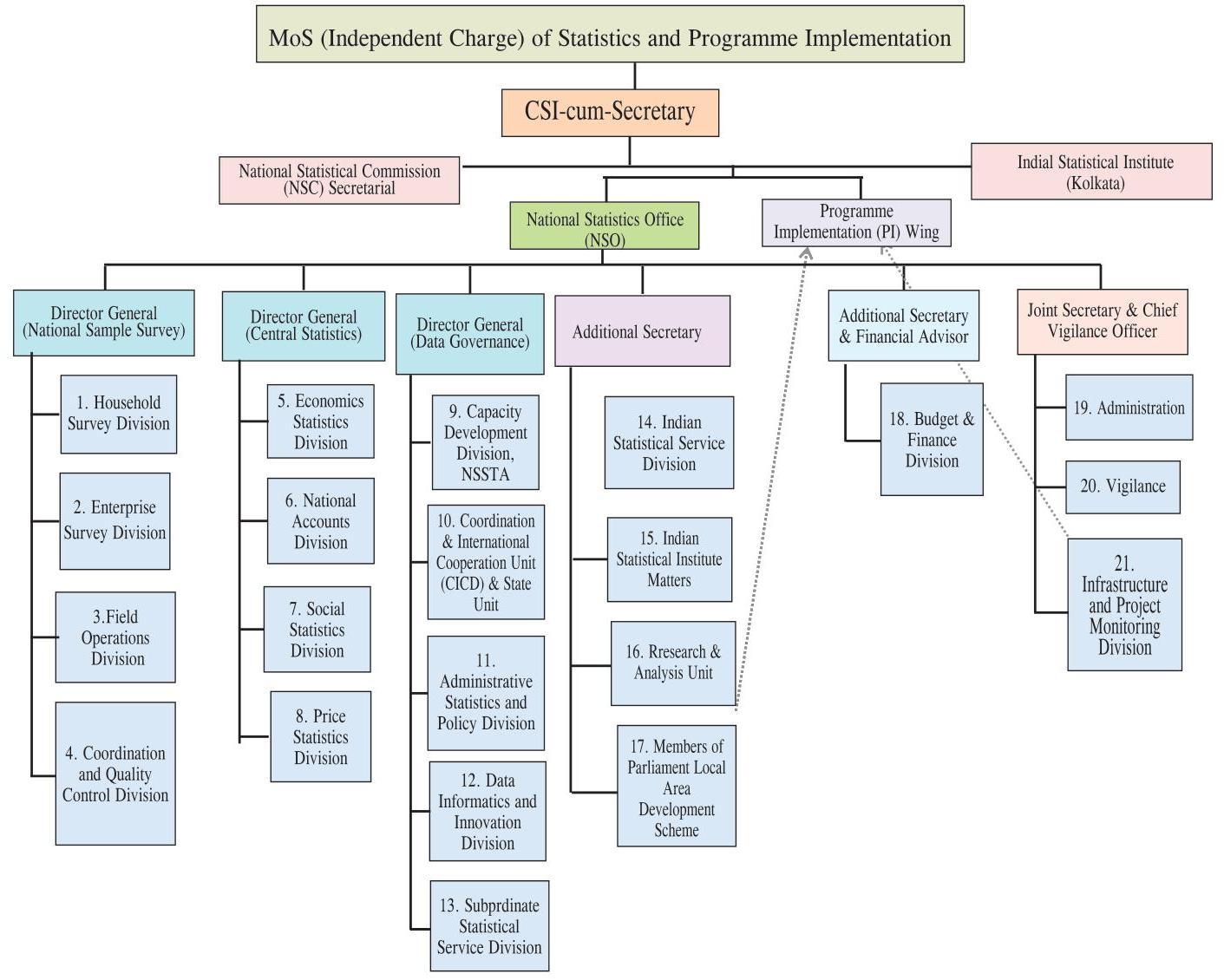
Annexure IIB
ORGANISATION CHART
MINISTRY OF STATISTICS \& PROGRAMME IMPLEMENTATION NATIONAL STATISTICAL COMMISSION
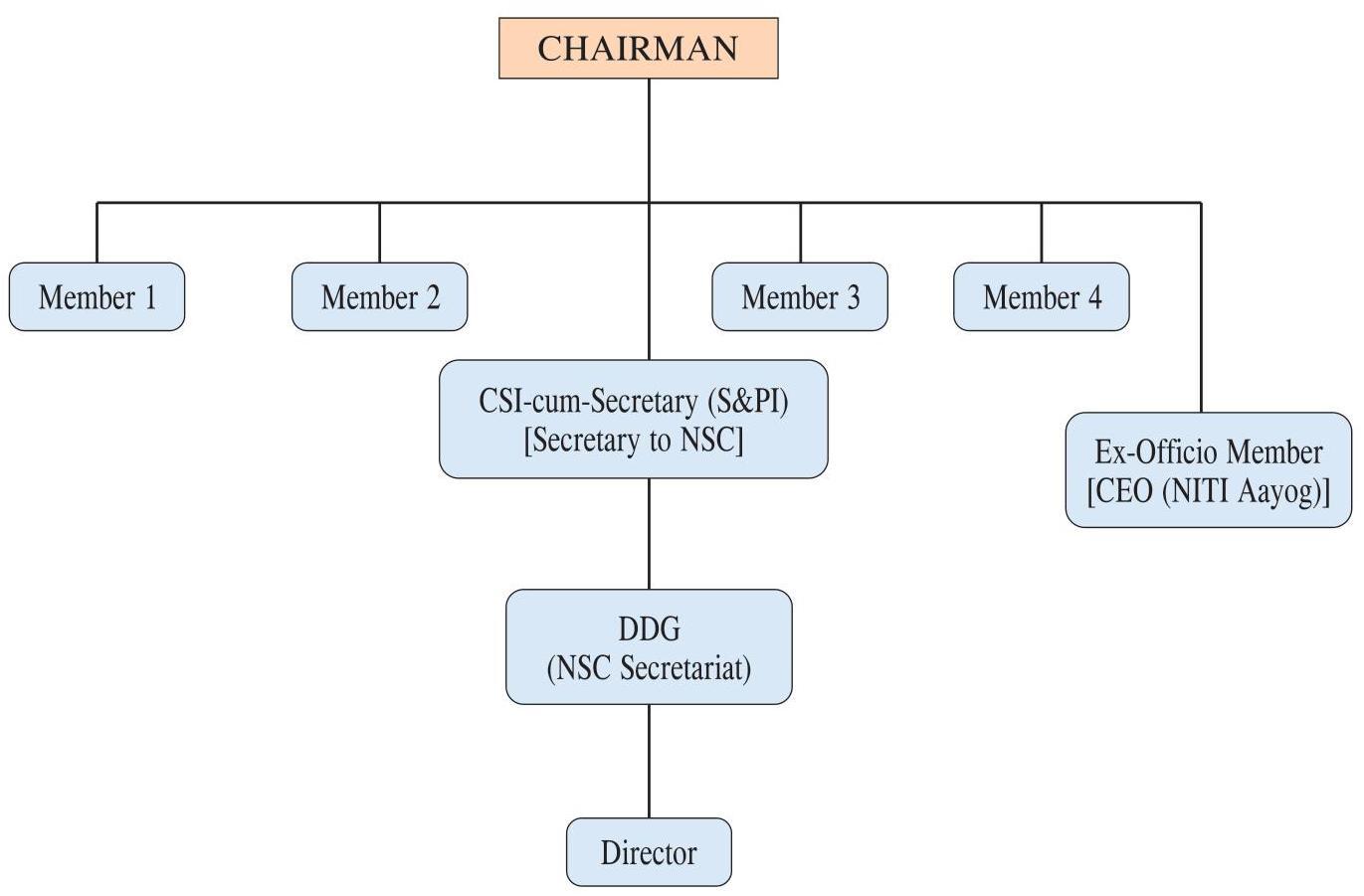
NSC: National Statistical Commission
CSI: Chief Statistician of India
| AS \& FA | Additional Secretary \& Financial Adviser |
|---|---|
| ASI | Annual Survey of Industries |
| ASTT. DIR | Assistant Director |
| CDD | Capacity Development Division |
| CSI | Chief Statistician of India |
| CSO | Central Statistics Office |
| C\&QCD | Coordination \& Quality Control Division |
| C\&A | Coordination \& Administration |
| CORD. | Coordination |
| DG \& CEO | Director General \& Chief Executive Officer |
| DIR | Director |
| DDG | Deputy Director General |
| DO | Desk Officer |
| DPD | Data Processing Division |
| DS | Deputy Secretary |
| DY. SECY. | Deputy Secretary |
| DY. ADV | Deputy Adviser |
| DY.C.A. | Deputy Controller of Accounts |
| DY. DIR | Deputy Director |
| DY. F.A. | Deputy Financial Adviser |
| EnSD | Enterprise Survey Division |
| ESD | Economics Statistics Division |
| FOD | Field Operations Division |
| HOD | Head of Department |
| HSD | Household Survey Division |
| HOO | Head of Office |
| JT. ADV | Joint Adviser |
| JT. DIR | Joint Director |
| JCM | Joint Consultative Machinery |
| JD | Joint Director |
|---|---|
| ICT | International Coordination \& Training |
| IPMD | Infrastructure and Project Monitoring Division |
| ISD | Industrial Statistics Division |
| ISI | Indian Statistical Institute |
| ISS | Indian Statistical Service |
| IS WING | Industrial Statistics Wing |
| IWSU | Internal Work Study Unit |
| MDG | Millennium Development Goals |
| MPLADS | Members of Parliament Local Area Development Scheme |
| NAD | National Accounts Division |
| NCMP | National Commission Minimum Programme |
| NSC | National Statistical Commission |
| NSO | National Statistics Office |
| NSSO | National Sample Survey Office |
| OL | Official Language |
| O\&M | Organisation \& Method |
| PAO | Pay \& Accounts Office |
| PCL | Price \& Cost of Living |
| PG | Public Grievances |
| PIMD | Policy Implementation \& Monitoring Division |
| RTI | Right To Information |
| SCD | Survey Coordination Division |
| SC/ST | Scheduled Caste/Tribe |
| SDRD | Survey Design and Research Division |
| SSD | Social Statistics Division |
| SSS | Subordinate Statistical Service |
| SDG | Sustainable Development Goals |
| TAG | Technical Advisory Group |
| TRG | Training |
| US | Under Secretary |
Annexure -III A
Statement of Budget Estimate (SBE) -Annual Plan 2024-25 Ministry/Department: Ministry of Statistics and Programme Implementation
| S. No. |
Scheme | Annual Plan 2024-25 (B.E.) | OutlayEarmarkedf or North East 2024-25 (BE) | ||
|---|---|---|---|---|---|
| GBS | IEBR | Total | |||
| 1 | 2 | 3 | 4 | 5 | 6 |
| (A) Central Sector Schemes (CS) | |||||
| 1 | Capacity Development | 543.87 | 0.00 | 543.87 | 19.00 |
| Total (A) | 543.87 | 0.00 | 543.87 | 19.00 | |
| (B) Block Grants | |||||
| 1 | Members of Parliament Local Area Development Scheme (MPLAD) | 3955.00 | 0.00 | 3955.00 | 0.00 |
| Total (A+B) | 4498.87 | 0.00 | 4498.87 | 19.00 |
Annexure -III B
Total Plan Gross Budgetary Support (GBS) for 2023-24 (BE and RE) for North-Eastern Region
($ in Lakh)
| Name of Plan Scheme | Provision for NE During 2023-24 | NE States | Actual Expenditure State-wise (upto 31.03.2024) | Remarks | ||
|---|---|---|---|---|---|---|
| BE | RE | Actual Expenditure | ||||
| 1 | 2 | 3 | 4 | 5 | 6 | 7 |
| 1. Capacity Development (Total) | 1819.00 | 1819.00 | 1705.40 | |||
| (a) $\quad$ Capacity Development (Capacity Development of NSSO – Grant-in aid to the states for carrying out central NSS sample work in NER region) |
1534.00 | 1534.00 | 1533.96 | Arunachal Pradesh | $401.26$ | Expenditure was made for price collection work done in the State of Mizoram by DES, Mizoram during the FY 2022-23 from the budgetary provision of FY 2023-24. |
| Manipur | 540.28 | |||||
| Mizoram | 194.27 | |||||
| Sikkim | 74.55 | |||||
| Tripura | 323.60 | |||||
| Nagaland | 92.75 | |||||
| Arunachal Pradesh | 35.00 | |||||
| Assam | 43.69 | |||||
| (b) Support for Statistical Strengthening | 285.00 | 285.00 | 171.44 | Nagaland | 92.75 | |
| Arunachal Pradesh | 35.00 | |||||
| Assam | 43.69 | |||||
| 2. MPLADS | 28700.00 | Arunachal Pradesh | 2750.00 | Authorization released by the MPLADS Division into the eSAKSHI Account of entitled Hon’ble MPs | ||
| Assam | 15000.00 | |||||
| Manipur | 2500.00 | |||||
| Meghalaya | 2250.00 | |||||
| Mizoram | 1250.00 | |||||
| Nagaland | 1000.00 | |||||
| Sikkim | 1750.00 | |||||
| Tripura | 2200.00 | |||||
| GRAND TOTAL | 1819.00 | 1819.00 | 30405.40 |
*There is no separate provision for NE under MPLAD Scheme.
Annexure-III C
Total Plan Gross Budgetary Support (GBS) for 2024-25 (BE and RE) for North-Eastern Region
( $\boldsymbol{\square}$ in Lakh)
| Name of Plan Scheme | Provision for NE during 2024-25 | NE States | Actual Expenditure State-wise | Remarks | ||
|---|---|---|---|---|---|---|
| BE | RE | Actual Expenditure (upto 30.11.2024) | ||||
| 1 | 2 | 3 | 4 | 5 | 6 | 7 |
| 1. Capacity Development (Total) | 1900.00 | 1694.00 | 325.83 | |||
| (a) Capacity Development (Capacity Development of NSSO Grant-in-aid to the states for carrying out central NSS sample work in NER region) | 1532.00 | 1540.00 | 172.52 | Arunachal Pradesh | 90.59 | |
| Manipur | – | |||||
| Mizoram | – | |||||
| Sikkim | – | |||||
| Tripura | 81.93 | |||||
| (b) Support for Statistical Strengthening | 368.00 | 154.00 | 153.31 | Assam | 70.12 | |
| Meghalaya | 25.00 | |||||
| Nagaland | 23.19 | |||||
| Tripura | 35.00 | |||||
| (c) Economic Census | ||||||
| 2. MPLADS | 20250.00 | Arunachal Pradesh | 1500.00 | Authorization released by the MPLADS Division into the eSAKSHI Account of entitled Hon’ble MPs. | ||
| Assam | 11000.00 | |||||
| Manipur | 1500.00 | |||||
| Meghalaya | 1500.00 | |||||
| Mizoram | 1500.00 | |||||
| Nagaland | 1000.00 | |||||
| Sikkim | 1000.00 | |||||
| Tripura | 1250.00 | |||||
| GRAND TOTAL | 1900.00 | 1694.00 | 20575.83 |
A. National Sample Survey
| 1. | PLFS Quarterly Bulletin for the quarter October-December,2023 released in February, 2024 |
|---|---|
| 2. | Factsheet of HCES 2022-23 released in February, 2024 |
| 3. | Annual Survey of Industries (ASI) 2020-21 released in February 2024 |
| 4. | Annual Survey of Industries (ASI) 2021-22 released in February 2024 |
| 5. | Key employment unemployment indicators for January-December, 2023 released in March, 2024 |
| 6. | PLFS Quarterly Bulletin for the quarter January-March, 2024 released in May, 2024. |
| 7. | Survey on AYUSH: 2022-23 Factsheet released in June, 2024 |
| 8. | Household Consumption Expenditure Surveys, 2022-23 released in June, 2024 |
| 9. | Factsheets of Annual Survey of Unincorporated Sector Enterprises (ASUSE) 2021-22 and 2022-23 were released in June 2024 |
| 10. | ASUSE reports namely, Operational and Economic Characteristics; for the years 2021-22 and 2022-23 were released in July 2024 |
| 11. | PLFS Quarterly Bulletin for the quarter April-June,2024 released in August, 2024 |
| 12. | PLFS Annual Report July, 2023 – June, 2024 released in September, 2024 |
| 13. | Annual Survey of Industries (ASI) 2022-23 released in September, 2024 |
| 14. | Comprehensive Annual Modular Survey, 2022-23 releases in October,2024 |
| 15. | PLFS Quarterly Bulletin for the quarter July-September, 2024 released in November, 2024 |
| 16. | Factsheet of Annual Survey of Unincorporated Sector Enterprises (ASUSE) 2023-24 released in December 2024 |
| 17. | Factsheet of HCES 2023-24 released in December 2024 |
B. Publications brought out during 2024-25 by Social Statistics Division:
| Sl. No. | Name of Publication | Period-icity | Month of Release | Content |
|---|---|---|---|---|
| 1 | EnviStats India 2024: Environment Statistics | Annual | June, 2024 | Continuing its effort to collate and release statistical information on all the aspects of environment, the division released “EnviStats India 2024: Environment Statistics” on 05th June, 2024. The publication is based on Framework on Development of Environment Statistics (FDES 2013) prescribed by UNSD for compilation of environment statistics and provides information on the six fundamental components namely (i) Environmental Conditions and Quality; (ii) Environmental Resources and their use; (iii) Residuals (iv) Extreme Events and Disasters; (v) |
| 2 | EnviStats India 2024; Vol. II: Environment Accounts | Annual | September, $2024$ | With a view to improve the understanding of the relationship between environment and the economy, the division has released the 7th consecutive issue of the annual publication on Environment Accounts, “EnviStats India 2024 Vol. II: Environment Accounts” in September 2024 following the System of Environmental and Economic Accounts Framework (SEEA). The current publication includes several new subjects such as Ocean Accounts |
| 3 | EnviStats India: Frequently Asked Questions | Annual | January, 2024 | The FAQ provides all the important queries related to Environment Accounting with an aim to help users of EnviStats India to have better understanding of the various concepts of environment accounting and help building awareness for the same. |
| 4 | EnviStats India: Glossary | Annual | March, 2024 | The Glossary provides definition of the technical terms used in the Environment Accounts. |
| 5 | Sustainable Development Goals National Indicator Framework Progress Report, 2024 |
Annual | June, 2024 |
“Sustainable Development Goals – National Indicator Framework Progress Report 2023″, the latest progress report of India on SDGs-NIF (covering all 17 SDGs) with the time series data was released on 29th June, 2023. This report contains four parts – Overview \& Executive Summary, Data Snapshot, Metadata and Data Tables. |
|---|---|---|---|---|
| 6 | Sustainable Development Goals – National Indicator Framework, 2024 |
Annual | June, 2024 |
This publication on National Indicator Framework (NIF), 2023 contains list of 17 SDGs, associated 169 Targets and 290 National Indicators. |
| 7 | Data Snapshot on Sustainable Development Goals National Indicator Framework Progress Report 2024 |
Annual | June, 2024 |
This snapshot is based on national level values of National Indicators, with due mention of the data sources. |
| 8 | Women and Men in India 2023 |
Annual | August, 2024 |
Gender disaggregated data on various socio- economic aspects including health, education, participation in economy, decision making, impediments in women empowerment etc. |
| 9 | EnviStats India: Frequently Asked Questions |
Annual | 26th January, 2025 |
The FAQ provides all the important queries related to Environment Accounting with an aim to help users of EnviStats India to have better understanding of the various concepts of environment accounting and help building awareness for the same. |
| 10 | EnviStats India: Glossary | Annual | Schedule to release in March, 2025 |
The Glossary provides definition of the technical terms used in the Environment Accounts. |
| 11 | Women and Men in India 2024 |
Annual | Schedule to release in March, 2025 |
Gender disaggregated data on various socio- economic aspects including health, education, participation in economy, decision making, impediments in women empowerment etc |
C. National Account Division
| S. No. | Description of the publication/ data release/ report | Manner of release |
|---|---|---|
| 1. | First Advance Estimates (FAE) of National Income for the financial year 2023-24 |
Press Note |
| 2. | Second Advance Estimates (SAE) of National Income, 2023-24; Quarterly Estimates of Gross Domestic Product (GDP) for October- December quarter (Q3) of 2023-24 along with its expenditure components and First Revised Estimates of National Income, Consumption Expenditure, Saving and Capital Formation, 2022-23 |
Press Note |
| 3. | National Accounts Statistics – 2024 | e-Publication |
| 4. | Provisional Estimates of Annual National Income 2023-24 and Quarterly Estimates of Gross Domestic Product (GDP) for the Fourth Quarter (Q4) of 2023-24 |
Press Note |
| 5. | State-wise and Item-wise Value of Output from Agriculture, Forestry and Fishing (2011-12 to 2022-23) |
e-Publication |
| 6. | Estimates of Gross Domestic Product for the First Quarter (April-June) of 2024-25 |
Press Note |
| 7. | Estimates of Gross Domestic Product for the Second Quarter (July- September) of 2024-25 |
Press Note |
| 8. | Payroll Reporting in India: An Employment Perspective (Monthly Press Note) |
Press Note |
Annexure -V
POSITION OF ACTION TAKEN NOTE (ATN) FOR THE YEAR 2024-25
| S. No. |
Year | No. of Paras/PA reports on which ATNs have been submitted to PAC after vetting by Audit | Details of the Paras/PA reports on which ATN are pending | ||
|---|---|---|---|---|---|
| No. of ATNs not sent by the Ministry even for the first time | No. of ATNs sent but returned with observations and Audit is awaiting their submission by the Ministry | No. of ATNs which have been finally vetted by audit but have not been submitted by the Ministry to PAC | |||
| 1 | Report of the CAG for the FY 2021-22 | 3 | NIL | NIL | NIL |
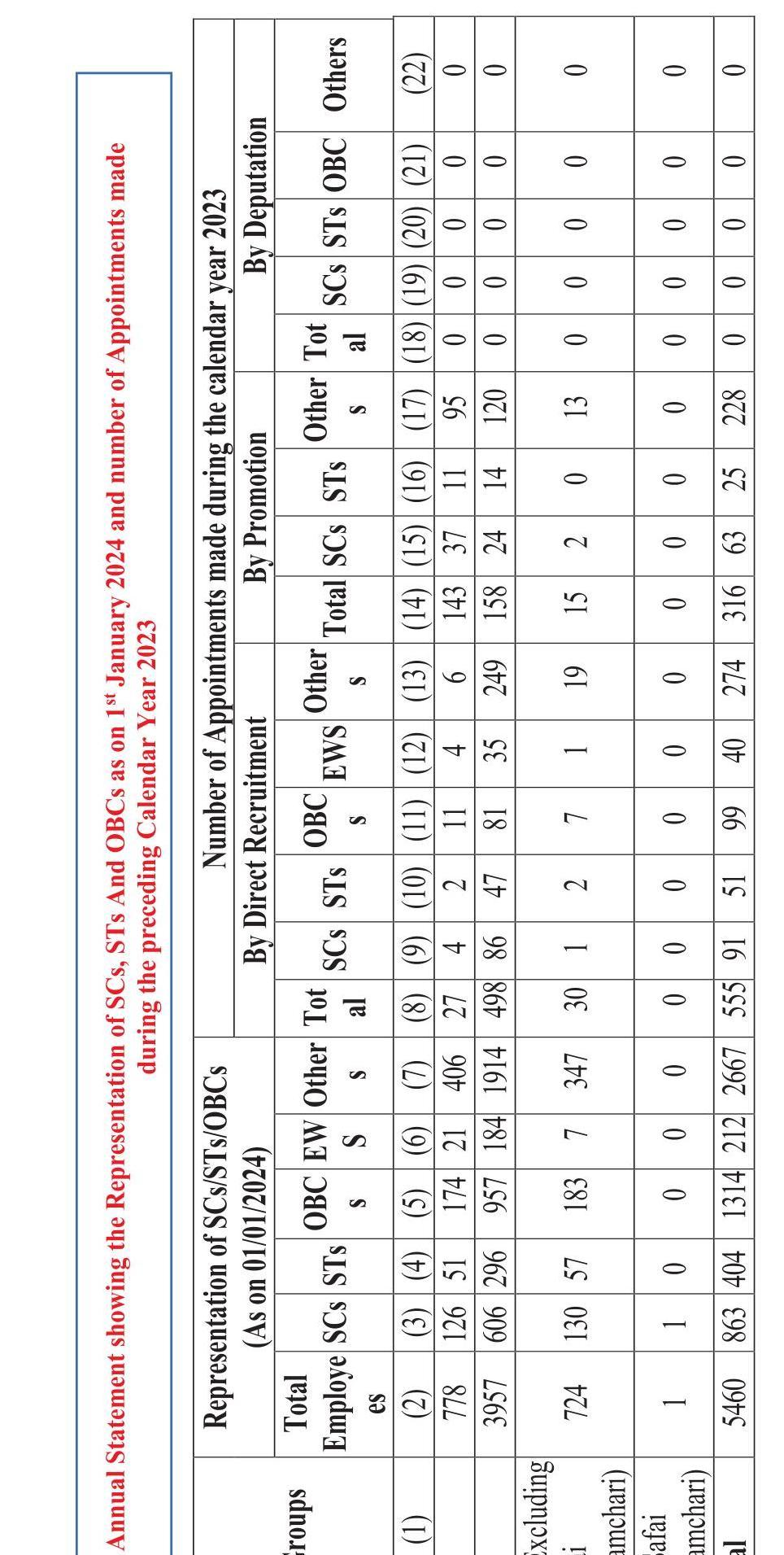



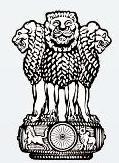
Ministry of Statistics and Programme Implementation Khurshid Lal Bhawan, Janpath Road, New Delhi-110001
Website: www.mospi.gov.in